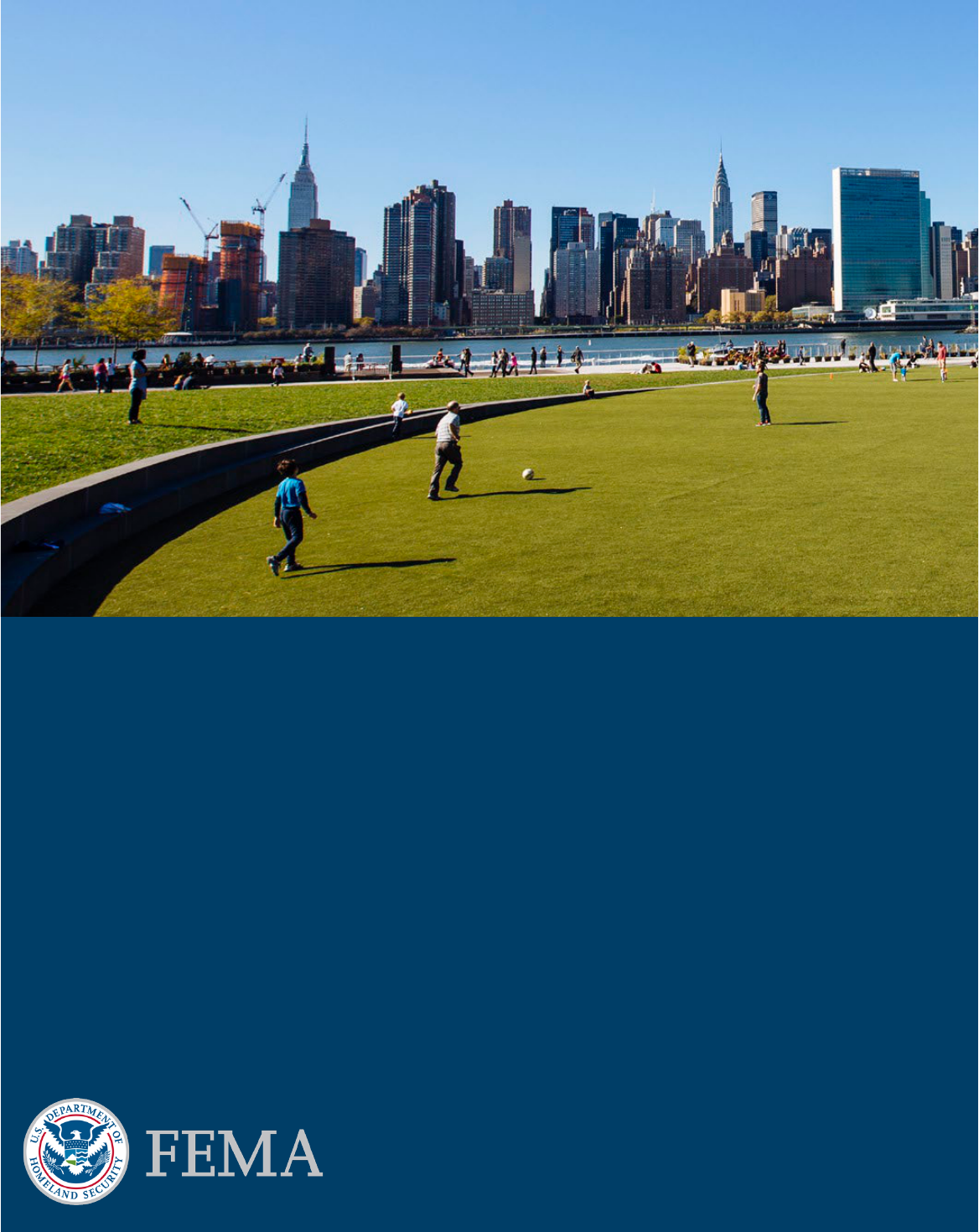
FEMA Ecosystem
Service Value Updates
June 2022

FEMA Ecosystem Service Value Updates
This page intentionally left blank

FEMA Ecosystem Service Value Updates
i
Table of Contents
1. Background and Purpose of this Report ................................................................................... 1
2. Classifying Ecosystem Services ................................................................................................. 5
3. Methods for Valuing Ecosystem Services ................................................................................. 9
4. Ecosystem Service Value Updates ......................................................................................... 11
4.1. Summary of Proposed Land Cover Categories and Ecosystem Service Values ....... 11
4.2. Summary of Changes to FEMA’s 2016 Land Cover Categories and Ecosystem
Service Values .............................................................................................................. 12
5. Using Ecosystem Service Values in the FEMA BCA Toolkit .................................................... 17
5.1. Identify each Land Cover Category Associated with the Mitigation Action ............... 17
5.2. Ensure Each Land Cover Category Meets Feasibility & Effectiveness Criteria ......... 22
5.3. Select an Appropriate Project Useful Life ................................................................... 23
5.4. Conceptual Examples ................................................................................................... 26
5.5. “Real World” Examples ................................................................................................ 29
Appendix A. Forest .......................................................................................................................... 37
Land Cover Definition ................................................................................................................ 37
Feasibility & Effectiveness Criteria ........................................................................................... 37
Mitigation Project Use Cases .................................................................................................... 38
Project Useful Life Considerations ........................................................................................... 39
Summary of Value Updates ...................................................................................................... 39
Ecosystem Service Values ........................................................................................................ 40
Appendix B. Coastal Wetland ......................................................................................................... 53
Land Cover Definition ................................................................................................................ 53
Feasibility & Effectiveness Criteria ........................................................................................... 53
Mitigation Project Use Cases .................................................................................................... 55
Project Useful Life Considerations ........................................................................................... 55
Summary of Value Updates ...................................................................................................... 56
Ecosystem Service Values ........................................................................................................ 57
Appendix C. Inland Wetland ........................................................................................................... 71
Land Cover Definition ................................................................................................................ 71

FEMA Ecosystem Service Value Updates
ii
Feasibility & Effectiveness Criteria ........................................................................................... 71
Mitigation Project Use Cases .................................................................................................... 73
Project Useful Life Considerations ........................................................................................... 73
Summary of Values Updates .................................................................................................... 73
Ecosystem Service Value .......................................................................................................... 74
Appendix D. Urban Green Open Space .......................................................................................... 85
Land Cover Definition ................................................................................................................ 85
Feasibility & Effectiveness Criteria ........................................................................................... 85
Mitigation Project Use Cases .................................................................................................... 86
Project Useful Life Considerations ........................................................................................... 87
Summary of Value Updates ...................................................................................................... 88
Ecosystem Service Values ........................................................................................................ 88
Appendix E. Rural Green Open Space ............................................................................................ 99
Land Cover Definition ................................................................................................................ 99
Feasibility & Effectiveness Criteria ........................................................................................... 99
Mitigation Project Use Cases .................................................................................................. 100
Project Useful Life Considerations ......................................................................................... 101
Summary of Value Updates .................................................................................................... 101
Ecosystem Service Values ...................................................................................................... 102
Appendix F. Riparian ..................................................................................................................... 111
Land Cover Definition .............................................................................................................. 111
Feasibility & Effectiveness Criteria ......................................................................................... 112
Mitigation Project Use Cases .................................................................................................. 113
Project Useful Life Considerations ......................................................................................... 114
Summary of Value Updates .................................................................................................... 114
Ecosystem Service Values ...................................................................................................... 115
Appendix G. Coral Reefs ............................................................................................................... 131
Land Cover Definition .............................................................................................................. 131
Feasibility & Effectiveness Criteria ......................................................................................... 131
Mitigation Project Use Cases .................................................................................................. 132

FEMA Ecosystem Service Value Updates
iii
Project Useful Life Considerations ......................................................................................... 133
Summary of Value Updates .................................................................................................... 133
Ecosystem Service Values ...................................................................................................... 134
Appendix H. Beaches and Dunes ................................................................................................. 143
Land Cover Definition .............................................................................................................. 143
Feasibility & Effectiveness Criteria ......................................................................................... 143
Mitigation Project Use Cases .................................................................................................. 144
Summary of Value Updates .................................................................................................... 144
Ecosystem Service Values ...................................................................................................... 145
Appendix I. Shellfish Reefs ........................................................................................................... 151
Land Cover Definition .............................................................................................................. 151
Feasibility & Effectiveness Criteria ......................................................................................... 151
Mitigation Project Use Cases .................................................................................................. 152
Project Useful Life Considerations ......................................................................................... 152
Summary of Value Updates .................................................................................................... 153
Ecosystem Service Values ...................................................................................................... 154
Appendix J. Detailed Change Log: Added and Removed Studies and Values since 2016 update
....................................................................................................................................... 159
Values Added ........................................................................................................................... 159
Values Removed ...................................................................................................................... 165
References .................................................................................................................................... 171

FEMA Ecosystem Service Value Updates
iv
This page intentionally left blank

FEMA Ecosystem Service Value Updates
1
1. Background and Purpose of this Report
Natural disasters are increasing in frequency and severity in the United States (U.S.) and around the
globe. Climate change and other factors—including land use planning decisions that have allowed
people to live in hazard-prone areas—are effectuating the increase. Since 1980, the U.S. has
experienced 323 weather and climate disasters that reached or exceeded $1 billion in damages (as
of April 2022), with the total cost exceeding $2.195 trillion.
1
The impacts of these natural disasters
are compounded by the effects of COVID-19 and tend to disproportionately impact low-income
communities and communities of color, further exacerbating inequity.
The Federal Emergency Management Agency (FEMA) provides billions of dollars each year to
communities through its Hazard Mitigation Assistance (HMA) programs to reduce or eliminate long-
term risk from natural disasters. FEMA defines hazard mitigation as “Any sustained action taken to
reduce or eliminate long-term risk to people and property from natural hazards and their effects.”
HMA programs include the Hazard Mitigation Grant Program (HMGP), Building Resilient
Infrastructure and Communities (BRIC) and Flood Mitigation Assistance (FMA). FEMA also provides
hazard mitigation funding through the Public Assistance (PA) program, sometimes referred to as 406
Hazard Mitigation.
FEMA requires that hazard mitigation projects be cost-effective to the federal government; therefore,
the project must demonstrate a Benefit-Cost Analysis (BCA) that compares the net present value of a
project’s future benefits and costs. A Benefit-Cost Ratio (BCR) of 1.0 or greater indicates that the risk
reduction benefits of a project outweigh the costs, thereby deeming the project “cost-effective” and a
worthwhile and eligible investment for the federal government. A BCA is required for the vast majority
of FEMA-funded hazard mitigation activities, with few exceptions (e.g., 5% Initiative projects). For this
reason, FEMA developed a BCA Toolkit to assist subapplicants in conducting BCAs for a range of
mitigation actions.
In recent years, FEMA began to recognize and emphasize the value of investing in Nature-Based
Solutions (NBS) for mitigating the impacts of floods, wildfires, droughts and other natural hazards.
FEMA defines NBS as
“Sustainable planning, design, environmental management, and engineering
practices that weave natural features or processes into the built environment to build more resilient
communities.”
2
NBS can include the use of natural features such as wetlands, open space and
urban green infrastructure to help buffer communities from damages caused by natural hazards,
thereby reducing costs to taxpayers and harm to vulnerable communities. For example, coastal
wetlands can reduce coastal storm damage, riverfront trail systems can capture and store water
during floods, forested areas managed for vegetation can serve as wildfire buffers, and urban trees
can mitigate the impacts of dangerous heatwaves. Economic studies have shown that NBS can often
be more cost-effective than traditional, man-made solutions, such as levees or seawalls, while
providing multiple community and environmental benefits. Ecosystem services are an important
benefit of hazard mitigation projects that incorporate NBS, and they also establish hazard mitigation
approaches that are not considered NBS, per se (e.g., acquisition and relocation can improve
floodplain health in the footprint of the removed structures).

FEMA Ecosystem Service Value Updates
2
FEMA’s new emphasis on NBS has been reflected through several important policy advances and
updates to the BCA Toolkit that have made it easier for subapplicants to calculate the benefits of
NBS in a BCA. A key foundation for these advances has been the adoption of monetary values for
“ecosystem services” into the BCA Toolkit. Ecosystem services are defined by FEMA as “direct or
indirect contributions that ecosystems make to the environment and human populations.” Pre-
calculated ecosystem service values are embedded into FEMA’s BCA Toolkit, calculated as “dollar
per acre per year” ($/acre/year) values according to land cover type, creating a relatively simple
framework for subapplicants who would like to value the ecosystem services associated with their
mitigation project.
FEMA’s notable policy updates related to ecosystem services
i
have included:
2013: Creation of first ecosystem services policy. FEMA issued its first ecosystem services policy
in 2013,
3
incorporating dollar values for ecosystem services into the BCA Toolkit for the
“riparian” and “green open space” land cover categories. Earth Economics developed the
framework and values for these land cover categories and associated ecosystem services, under
subcontract to Ideation, Inc. Note that this policy has now been superseded by the 2016 and
2020 policies below.
2016: Update and expansion of ecosystem services policy. FEMA issued another ecosystem
services policy in 2016,
4
which introduced ecosystem service values for new land cover
categories (“wetlands,” “forest,” and “marine and estuary”). The policy also introduced new
eligible activities, including floodplain and stream restoration, green infrastructure,
ii
post-wildfire
mitigation and aquifer storage and recovery. Earth Economics developed the values for these
new land cover categories, and updated values for existing land cover categories, under
subcontract to—and with significant input and guidance from—CDM Federal Programs
Corporation, which were summarized for FEMA in the 2015 report Update to FEMA Ecosystem
Services Values.
5
i
Note that ecosystem services were referred to as “environmental benefits” in both the 2013 and 2016 policies but will be
referred to in this report only as “ecosystem services” to avoid confusion.
ii
In the supporting materials for FEMA’s 2016 environmental benefits policies, the agency had not yet adopted the term
“Nature-Based Solutions.” Instead, it used the term “green infrastructure,” which it defined as “A sustainable approach to
natural landscape preservation and storm water management that can be used for hazard mitigation activities as well as
provide additional ecosystem benefits.” However, since then, it appears that FEMA has moved towards the term “Nature-
Based Solutions” to refer to a similar set of concepts, as seen in the definition above. In the 2020 guide Building
Community Resilience with Nature-Based Solutions, FEMA notes that the term “nature-based solutions” is largely
interchangeable with terms used by other agencies and organizations such as “green infrastructure,” “natural
infrastructure,” or “Engineering with Nature”® (a U.S. Army Corps of Engineers program). For consistency with FEMA’s
approach, this report uses the term “Nature-Based Solutions” to encompass all these related terms, though it is recognized
that other agencies and experts use the terms in different ways (e.g., EPA uses Green Infrastructure to refer to specific
kinds of stormwater practices).

FEMA Ecosystem Service Value Updates
3
2020: Removal of limitations on use of ecosystem services in BCA. One limitation of the 2013
and 2016 policies was that projects were required to achieve a benefit-cost ratio of 0.75 using
“traditional” risk reduction benefits, such as reduced damage to structures, before the
ecosystem service values could be included in a BCA. However, in September 2020, FEMA
released a significant policy update, building directly on the 2013 and 2016 policies. FEMA
Policy FP-108-024-02, titled “Ecosystem Service Benefits in Benefit-Cost Analysis for FEMA’s
Mitigation Programs Policy,”
6
recognized that the natural environment is an important
component of a community’s resilience strategy, and removed the 0.75 benefit-cost ratio
threshold requirement. In other words, nature-based hazard mitigation projects could now be
considered cost-effective based on the value of their ecosystem services alone. The policy is still
relatively new at the time of writing this report, but it seems likely that this policy will reduce the
technical and monetary burden on subapplicants that would like to advance nature-based
solutions, by eliminating the need for complex modeling in many cases, and open FEMA’s hazard
mitigation funding programs to a larger pool of nature-based project types and subapplicants.
The purpose of this report is to provide details and guidance on a proposed, updated set of land
cover categories and ecosystem service values for FEMA’s BCA Toolkit. Key changes to the FEMA’s
2016 ecosystem service values, referenced above, include an expansion in the number of land cover
categories (from the existing 5 to 10), incorporation of many additional source studies for values
associated with the new and existing land cover categories and removal of some source studies. This
report also includes more detailed guidance on how to interpret and use the land cover categories in
the context of a mitigation project BCA, including hypothetical project examples.
This report is structured as follows:
Classifying Ecosystem Services: This section describes the framework used for classifying and
defining ecosystem services.
Methods for Valuing Ecosystem Services. This section summarizes the valuation methods used
by the source studies that are the basis for the proposed ecosystem service value updates.
Proposed Updates to FEMA’s Ecosystem Service Values: This section summarizes the land cover
categories and associated ecosystem service values proposed in this update, summarizes
changes to FEMA’s 2016 ecosystem service values, provides definitions for each land cover
category, and summarizes project useful life (PUL) considerations for each land cover category.
Using Ecosystem Service Values in the FEMA BCA Toolkit: This section provides conceptual and
real examples of how the land cover categories and ecosystem service values can be used in the
context of a BCA for a mitigation project.
Appendices A–I: Each of these Appendices contains detailed information for one of the 10 land
cover categories, including the proposed ecosystem service values associated with the category,
PUL considerations for that land cover category, Feasibility & Effectiveness criteria for that land
cover category and mitigation project use cases that might involve that land cover category

FEMA Ecosystem Service Value Updates
4
(including both conceptual and real examples). Finally, under each ecosystem service value
associated with a given land cover category, there is a description of the source study/studies
that were used to develop the value, the methods for deriving the value and discussion.
Appendix J: This appendix provides more details on source studies and values that have been
added or removed in comparison with FEMA’s 2016 ecosystem service values.

FEMA Ecosystem Service Value Updates
5
2. Classifying Ecosystem Services
Nature contributes substantial value to the economy, providing essential goods and services that
communities, governments and businesses depend on. These goods and services are collectively
known as “ecosystem services,” and are often defined as the benefits that people receive from
nature. Ecosystem services are essential to human survival and economic prosperity, and include
clean air, drinkable water, nourishing food, hazard risk reduction, habitat for fish and wildlife and a
stable climate.
In 2001, an international coalition of over 1,360 scientists and experts from the United Nations
Environmental Program, the World Bank and the World Resources Institute initiated an assessment
of the effects of ecosystem change on human well-being. A key goal of the assessment was to
develop a better understanding of the interactions between ecological and social systems, and in
turn develop a knowledge base of concepts and methods that would improve our ability to “…assess
options that can enhance the contribution of ecosystems to human well-being.”
7
This study
produced the landmark Millennium Ecosystem Assessment, which classified ecosystem services into
four broad categories according to how they benefit people:
Provisioning Services provide the physical materials that economies and communities use.
Community gardens grow food. Rivers provide drinking water, as well as fish for food.
Regulating Services are benefits obtained from ecosystem processes. Intact ecosystems provide
regulation of climate, water quality/supply and soil erosion control. They also keep disease
organisms in check.
Supporting Services refer to the habitats which support food webs and all life on the planet.
Information Services allow humans to interact meaningfully with nature. These services include
providing spiritually significant species and natural areas, natural places for recreation and
opportunities for scientific research and education.
Table 1: Categories of Ecosystem Services
Ecosystem Service Definition Economic
Value Assigned
Provisioning
Energy and Raw
Materials
Providing fuel, fiber, fertilizer, minerals, and energy -
Food Provisioning Producing crops, fish, game, and fruits X
Medicinal
Resources
Providing traditional medicines, pharmaceuticals, and
assay organisms
-

FEMA Ecosystem Service Value Updates
6
Ecosystem Service Definition Economic
Value Assigned
Ornamental
Resources
Providing resources for clothing, jewelry, handicraft,
worship, and decoration
-
Water Storage Providing long-term reserves of usable water via storage
in lakes, ponds, aquifers, and soil moisture
-
Regulating
Air Quality Providing clean, breathable air X
Biological Control Providing pest, weed, and disease control X
Climate Regulation Supporting a stable climate at global and local levels
through carbon sequestration and other processes
X
Hazard Risk
Reduction
Preventing and mitigating natural hazards such as floods,
hurricanes, fires, and droughts
X
Pollination Pollinating wild and domestic plant species via wind,
insects, birds, or other animals
X
Soil Formation Accumulating soils (e.g., via plant matter decomposition or
sediment deposition in riparian/coastal systems) for
agricultural and ecosystem integrity
-
Soil Quality Maintaining soil fertility and capacity to process waste
inputs (bioremediation)
-
Erosion Control Retaining arable land, slope stability, and coastal integrity X
Water Filtration Removing water pollutants via soil filtration and
transformation by vegetation and microbial communities
X
Water Supply
Regulating the rate of water flow through an environment
and ensuring adequate water availability for all water users
X
Supporting
Habitat Providing shelter, promoting growth of species, and
maintaining biological diversity
X
Pollination Pollinating wild and domestic plant species via wind,
insects, birds, or other animals
X
Nutrient Cycling Transfer of nutrients from one place to another;
transformation of critical nutrients and unusable to usable
forms
-

FEMA Ecosystem Service Value Updates
7
Ecosystem Service Definition Economic
Value Assigned
Information
Aesthetic Value Enjoying and appreciating the scenery, sounds, and smells
of nature
X
Existence Value Well-being gained by the knowledge that an environmental
resource exists, even without on-site use of that resource
X
Cultural Value Providing opportunities for communities to use lands with
spiritual, religious and historic importance
-
Research and
Education
Using natural systems for education and scientific research X
Recreation/Tourism Experiencing the natural world and enjoying outdoor
activities
X

FEMA Ecosystem Service Value Updates
8
This page intentionally left blank

FEMA Ecosystem Service Value Updates
9
3. Methods for Valuing Ecosystem Services
While nature is priceless in one sense, it also generates tremendous economic value, which can be
measured using a variety of established methods. Furthermore, most planning and infrastructure
decisions are considered in economic terms, using tools such as BCA. When nature-based solutions
are not valued in these same terms, they are effectively given a default value of zero, putting them at
a big disadvantage compared with traditional, engineered approaches. With recent advances in the
economic literature, the economic value of nature-based solutions to communities, governments and
businesses can now be estimated in dollars, and the ecosystem services framework provides a
comprehensive approach for capturing these benefits.
Though ecosystem services provide real and quantifiable economic value, they are generally not
bought or sold on a market (i.e., they are non-market benefits), and therefore their value must be
estimated by means other than market prices. Over the past several decades, the fields of
environmental and natural resource economics have developed and refined several methods for
estimating the value of ecosystem services. These valuation methods fall into three broad
categories: (1) direct market valuation, (2) revealed preferences and (3) stated preference.
Table 2
describes the most common valuation techniques within each of these categories
Table 2: Ecosystem Service Valuation Methods
Method Description Example
Direct Market Valuation
Market Price Valuations are directly obtained from
the prices paid for the good or service
in markets
The price of wheat sold on open
markets
Replacement Cost
Cost of replacing the ecosystem
service with engineered systems
The cost of replacing a watershed’s
natural filtration capacity with a
water filtration plant
Avoided Cost Costs that are incurred when the
ecosystem service is lost
Wetlands absorb and retain water,
reducing flooding to downstream
infrastructure. Flooding increases
when the wetlands are lost or
degraded.
Production
Approaches
Value created from an ecosystem
service through increases to
dependent economic outputs
Better grazing land health may
increase stocking rates for
livestock
Revealed Preference Approaches
Travel Cost Costs incurred to consume or enjoy
ecosystem services reflects a
minimum implicit value of the service
Tourists who travel to visit a locale
must value that resource at least
as much as the cost of traveling
there.

FEMA Ecosystem Service Value Updates
10
Method Description Example
Hedonic Pricing Value implied by the additional price
consumers are willing to pay for the
service in related markets.
Property values near lakes and
parks tend to exceed similar
properties without such nearby
amenities.
Stated Preference Approaches
Contingent
Valuation
Value elicited by posing hypothetical,
valuation scenarios
What people are willing to pay to
protect an endangered species
The approaches described above are primary methods, meaning they rely on new data generated by
the authors of the study. There are also approaches to ecosystem service valuation that are
secondary methods, meaning they rely on values, data and/or models that already exist from
previously conducted primary studies. This approach is often referred to as benefit transfer or value
transfer, which can be broadly defined as the process of estimating the value of an ecosystem
service at the site of interest by using an existing valuation estimate(s) that has been developed at
another site. Benefit transfer is often used to estimate the value of ecosystem services, as it can
generate defensible estimates quickly and at a fraction of the cost of conducting local, primary
studies, which typically require much more time and funding.
The United Nations Environmental Program, in its Guidance Manual on Value Transfer Methods for
Ecosystem Services
8
defines three main types of value transfer (direct quote):
Unit value transfer uses values for ecosystem services at a study site, expressed as a value per
unit, combined with information on the quantity of units at the policy site to estimate policy site
values. Unit values can be adjusted to reflect differences between the study and policy sites
(e.g., income and price levels).
Value function transfer uses a value function estimated for an individual study site in conjunction
with information on policy site characteristics to calculate the unit value of an ecosystem service
at the policy site. A value function is an equation that relates the value of an ecosystem service
to the characteristics of the ecosystem and the beneficiaries of the ecosystem service.
Meta-analytic function transfer (or simply “meta-analysis”) uses a value function estimated from
the results of multiple primary studies representing multiple study sites in conjunction with
information on policy site characteristics to calculate the unit value of an ecosystem service at
the policy site. Since the value function is estimated from the results of multiple studies it can
represent and control for greater variation in the characteristics of ecosystems, beneficiaries and
other contextual characteristics.

FEMA Ecosystem Service Value Updates
11
4. Ecosystem Service Value Updates
4.1. Summary of Proposed Land Cover Categories and Ecosystem Service
Values
Table 3 summarizes the differences in the land cover categories, as well as total value by land cover
category, between the 2016 adopted ecosystem services and the values proposed in this update.
Table 3. Summary of Changes to Land Cover Categories and Ecosystem Service Values
2016 Adopted Values 2022 Proposed Values
Land Cover Category
Value
(2014
USD/acre/year) Land Cover Category
Value
(2021
USD/acre/year)
Forest
554
Forest
12,589
Green Open Space
8,308
Urban Green Open Space
15,541
Rural Green Open Space
10,632
Riparian
39,545
Riparian
37,199
Wetland
6,010
Coastal Wetland
8,955
Inland Wetland
8,171
Marine and Estuary
1,799
n/a*
n/a
n/a
n/a
Coral Reefs
7,120
n/a
n/a
Shellfish Reefs
2,757
n/a
n/a
Beaches and Dunes
300,649
*The Marine and Estuary category (and most of its associated values) was merged with the Coastal Wetland
category
Table 3 summarizes the full proposed updated set of land cover categories and ecosystem service
values.

FEMA Ecosystem Service Value Updates
12
Table 4. Summary of Proposed Land Cover Categories and Ecosystem Service Values
Ecosystem
Service
Value by Land Cover Category (2021 USD/acre/year)
Urban
Green
Open Space
Rural Green
Open Space
Riparian
Forest
Coastal
Wetland
Inland
Wetland
Coral Reefs
Shellfish
Reefs
Beaches
and Dunes
Aesthetic Value
7,010 7,505 767 1,477 1,648 1,303 327 - 223,840
Air Quality
201 - 254 711 - - - - -
Biological
Control
- - 199 - - - - - -
Climate
Regulation
54 77 96 199 125 56 - - -
Erosion Control
78 78 13,823 1,672 - - - - -
Existence Value
- - - 7,531 - - - - -
Flood and
Storm Hazard
Reduction
316 - 6,052 368 1,035 1,264 3,269 - -
Food
Provisioning
- - 736 - - - 18 1,905 -
Habitat
5,890 2,021 2,547 - 2,420 1,416 2,222 - -
Pollination
350 350 - - - - - - -
Recreation/Tou
rism
1,642 601 6,215 94 1,624 1,906 1,261 253 76,809
Research and
Education
- - - - - - 23 - -
Water Filtration
- - 6,239 435 1,558 1,584 - 600 -
Water Supply
- - 272 103 544 643 - - -
Total Estimated
Benefits
15,541 10,632 37,199 12,589 8,955 8,171 7,120 2,757 300,649
4.2. Summary of Changes to FEMA’s 2016 Land Cover Categories and
Ecosystem Service Values
Key updates in the proposed ecosystem service value sets, in comparison with FEMA’s 2016 values,
include:

FEMA Ecosystem Service Value Updates
13
An increase in the number of land cover categories, from the current five to nine, including both
modification of existing land cover categories and addition of new land cover categories:
o The Wetlands category has been broken out into Inland Wetlands and Coastal Wetlands.
o Marine and Estuary was removed as a category, and many of the source studies and
associated values were incorporated into the
Coastal Wetlands category.
o The Green Open Space category has been broken out into Urban Green Open Space and
Rural Green Open Space.
o Coral Reefs, Shellfish Reefs, and Beaches and Dunes are new proposed land cover
categories.
o The Forest and Riparian categories remain unchanged.
An increase in the number of source studies and ecosystem service values. Publications on
ecosystem services have expanded rapidly in the past decade, with 30 percent of new studies
globally being published in the U.S.
9
In total, ~50 new source studies have been added
compared with the 2016 values, forming the basis for >50 new or updated value estimates.
Some source studies were also removed. Appendices A–I include more detailed information
about all ecosystem service values by land cover, including source studies, calculations, and
assumptions. Appendix J includes more information about specific source studies and values
that were added or removed.
A greater emphasis on values derived from meta-analyses. Meta-analyses, discussed above, are
increasingly used to synthesize environmental literature and are a powerful tool that can produce
customized value estimates where domestic valuation literature is scarce. For many combinations of
land cover category and ecosystem service (Appendices A–I contain details), meta-analyses exist
which can estimate multiple ecosystem services at once. In these cases, meta-analysis was relied
upon to provide generalized value estimates that could be representative of ecosystems throughout
the U.S. This approach results in a more defensible and broadly applicable value for the BCA Toolkit,
which uses the same set of ecosystem service values no matter where in the U.S. the mitigation
project is located.
All values have been adjusted for inflation to 2021 U.S. dollars, including values for which source
studies were not added or removed.
Table 5 summarizes the full set of proposed land cover category-ecosystem service combinations
and indicates which have been updated from FEMA’s 2016 values. Bold, underlined values
represent newly added values, or values for which source studies were added or removed, while the
remaining values were updated for inflation only (from 2014 to 2021 U.S. dollars).

FEMA Ecosystem Service Value Updates
14
Table 5. Summary of Changes to FEMA’s 2016 Ecosystem Service Values
Ecosystem
Service
Value by Land Cover Category (2021 USD/acre/year)
Urban Green
Open Space
Rural Green
Open Space
Riparian
Forest
Coastal
Wetland
Inland
Wetland
Coral Reefs
Shellfish
Reefs
Beaches
and Dunes
Aesthetic Value
7,010
7,505
767
1,477
1,648
1,303
327
-
223,840
Air Quality
201
- 254
711
- - - - -
Biological
Control
- - 199 - - - - - -
Climate
Regulation
54
77
96
199
125
56
- - -
Erosion Control
78 78 13,823
1,672
- - - - -
Existence Value
- - -
7,531
- - - - -
Flood and
Storm Hazard
Reduction
316
-
6,052
368
1,035
1,264
3,269
- -
Food
Provisioning
- - 736 - - -
18
1,905
-
Habitat
5,890
2,021
2,547
-
2,420
1,416
2,222
- -
Pollination
350 350 - - - - - - -
Recreation/Tou
rism
1,642
601
6,215
94
1,624
1,906
1,261
253
76,809
Research and
Education
- - - - - -
23
- -
Water Filtration
- - 6,239
435
1,558
1,584
-
600
-
Water Supply
- - 272 103
544
643
- - -
Total Estimated
Benefits
15,541
10,632
37,199
12,589
8,955
8,171
7,120
2,757
300,649
It should also be noted that, as in the 2016 update, in cases where more than one appropriate value
was available for a given land cover/ecosystem service combination, the average of those values
was taken. However, not every land cover/ecosystem service combination could be valued due to
lack of appropriate literature for a nation-wide estimate. That a specific combination of landcover
and ecosystem service value has not been included here does not necessarily mean such
ecosystems do not produce a given service—or that the service is not valuable—but rather reflects a
lack of an appropriate source study/studies relevant to that combination. For this reason, value

FEMA Ecosystem Service Value Updates
15
estimates may in some cases be underestimates, since not all ecosystem services could be valued.
Additionally, caution should be exercised when comparing total ecosystem service values across
landcover types, as differences in total value may reflect information gaps, rather than real
differences in ecosystem productivity or the value of such services. It should be noted that inclusion
of newer valuation studies or additional studies that bring more context to the values previously may
affect average values per service, leading to increases or decreases in value compared with the
2016 values.

FEMA Ecosystem Service Value Updates
16
This page intentionally left blank.

FEMA Ecosystem Service Value Updates
17
5. Using Ecosystem Service Values in the FEMA BCA
Toolkit
This section provides step-by-step guidance on how to apply the ecosystem service values in FEMA’s
BCA Toolkit for a mitigation action or project. Steps are described in the general order in which they
are likely to be followed, though subapplicants can follow the steps in a different order depending
upon their context and needs.
First, guidance is provided on how to define the land cover category (or categories) associated with
the mitigation project, including definitions for each category that has associated dollar values. Next,
general guidance is provided on Feasibility & Effectiveness criteria that the subapplicant must meet
for each land cover category used. General guidance is then provided on selecting an appropriate
PUL associated with the land cover category. Next, several conceptual examples describe how each
land cover category might be used in the context of a mitigation project. Finally, several “real world”
examples illustrate how these steps could be followed to generate values in a FEMA BCA.
Appendices A–I provide more detailed guidance associated with specific land cover categories;
references are made to these appendices as appropriate. It should be noted that, in addition to
following the criteria and guidance related to land cover categories discussed below and in
Appendices A–I, all mitigation projects must comprise eligible risk reduction activities and meet any
other relevant FEMA programmatic requirements (e.g., cost-effectiveness, Environmental and
Historic Preservation) to be eligible for FEMA funding.
5.1. Identify each Land Cover Category Associated with the Mitigation
Action
The subapplicant should first identify the land cover category (or categories) that will be restored,
created, enhanced or protected as a result of the project.
As described earlier, FEMA’s BCA Toolkit includes pre-calculated benefits for a range of land cover
categories. Each land cover category has a total “dollar per acre per year” ($/acre/year) value, based
on a set of ecosystem services that have been valued for that land cover. The BCA Toolkit will
automatically calculate the annual and net present value of ecosystem services according to the
area (i.e., acres or square feet) of each land cover category that is entered by the subapplicant.
It should be emphasized that, for any mitigation project, the area of each land cover category that is
counted in the BCA Toolkit must be part of the footprint of the project, where the land cover category
is being restored, created, enhanced or protected. The ecosystem service values associated with
each land cover category will capture and account for the broader “area of benefit” associated with
the project, which may extend beyond the project footprint. For example, for a 5-acre riparian
restoration project, the subapplicant should input 5 acres of “riparian” into the BCA Toolkit; the
ecosystem service benefits built into the per-acre value for riparian include climate regulation
(global), air quality (regional) and flood hazard reduction (downstream).

FEMA Ecosystem Service Value Updates
18
Table 6 provides definitions for each land cover category. Figure 1 and Figure 2 provide examples to
illustrate where each land cover category might be located in a landscape. More guidance on
interpreting the definitions, along with potential sources of geospatial data for identifying appropriate
land cover categories for a mitigation project BCA, can be found in Appendices A–I.
Note, the example maps display the land cover categories as they currently exist on the landscape. A
mitigation project may add new—or transform existing—areas of land cover through creation or
restoration of an ecosystem, per the “Feasibility & Effectiveness Considerations” in Appendices A–I,
and the specific land cover categories and boundaries will need to be identified and justified by the
subapplicants.
Table 6. Land Cover Category Definitions
Land Cover Category Definition
Urban Green Open Space Green open space areas are those in which vegetated pervious
surfaces account for at least 80% of total cover (impervious surfaces
account for less than 20% of total cover) and include a mixture of
some constructed materials. Green open space is considered “urban”
if it meets the criteria specified in the U.S. Census Bureau’s “2010
Census Urban and Rural Classification and Urban Area Criteria,” which
includes both Urbanized Areas (population of 50,000 or more) and
Urban Clusters (population between 2,500 and 50,000). Examples of
urban green open space include urban parks and recreational sites,
neighborhood green spaces, pocket parks, green corridors and lawns.
Rural Green Open Space
Areas where vegetation accounts for at least 80% of total cover
(impervious surfaces account for less than 20% of total cover) and
have a mixture of some constructed materials located in a rural
setting. A rural setting is any area outside the definitions for 2010
Census Urbanized Areas (population of 50,000 or more) or Urban
Clusters (population between 2,500 and 50,000). Examples include
rural parks and open space, open fields and rangelands.
Riparian Areas where plant communities are contiguous to and affected by
surface and subsurface hydrologic features of perennial or
intermittent lotic and lentic waterbodies (rivers, streams, lakes or
drainage ways). Riparian areas are usually transitional between
wetland and upland. Riparian areas have one or both of the following
characteristics: (1) distinctly different vegetative species than
adjacent areas, (2) species similar to adjacent areas but exhibiting
more vigorous or robust growth forms.
Subapplicants can also use one of the following methods as an
alternative to the definition above.
1. Meets the definition of “riparian” based on the professional
judgement of a recognized expert.
2. Meets the definition of “riparian” adopted by the jurisdiction
(e.g., state) in which the project is being proposed.

FEMA Ecosystem Service Value Updates
19
Land Cover Category Definition
Forest Areas dominated by trees (evergreen and/or deciduous) generally
greater than 5 meters tall that—on average—comprise greater than
20% of the total vegetation cover within the area or unit of analysis
(e.g., pixel, polygon, parcel). In other words, areas with a tree-crown
areal density of greater than 20%.
Coastal Wetland
Areas of tidal wetlands (herbaceous and/or woody vegetation) or
deepwater habitats in which plants grow and form a continuous cover
principally on or at the surface of the water (e.g., algal mats, kelp
beds, submerged aquatic vegetation); AND vegetation coverage is
greater than 20%; AND these waters are tidally influenced and have a
salinity greater than or equal to 0.5 parts per thousand.
Inland Wetland Areas dominated by perennial herbaceous vegetation, shrubland
vegetation or forest; AND the soil or substrate is at least periodically
saturated with or covered with water; AND these waters are not tidally
influenced and have a salinity of less than 0.5 parts per thousand.
Coral Reefs Areas of hardened, fixed substrate or structures created by deposition
of calcium carbonate by reef-building coral species. May include both
deep- and shallow-water coral species.
Shellfish Reefs Areas where many shell reefs exist and are surrounded and
intermixed with channels and unvegetated flats, typically occurring in
the intertidal zone.
Beaches and Dunes Gently sloping zone adjacent to the edge of a waterbody, such as an
ocean or lake, consisting of unconsolidated material such as sand,
pebbles, rocks or shell fragments. Beaches extend landward from the
low-water line to either a line of permanent vegetation or a definite
change in material or physiographic form, such as a cliff.
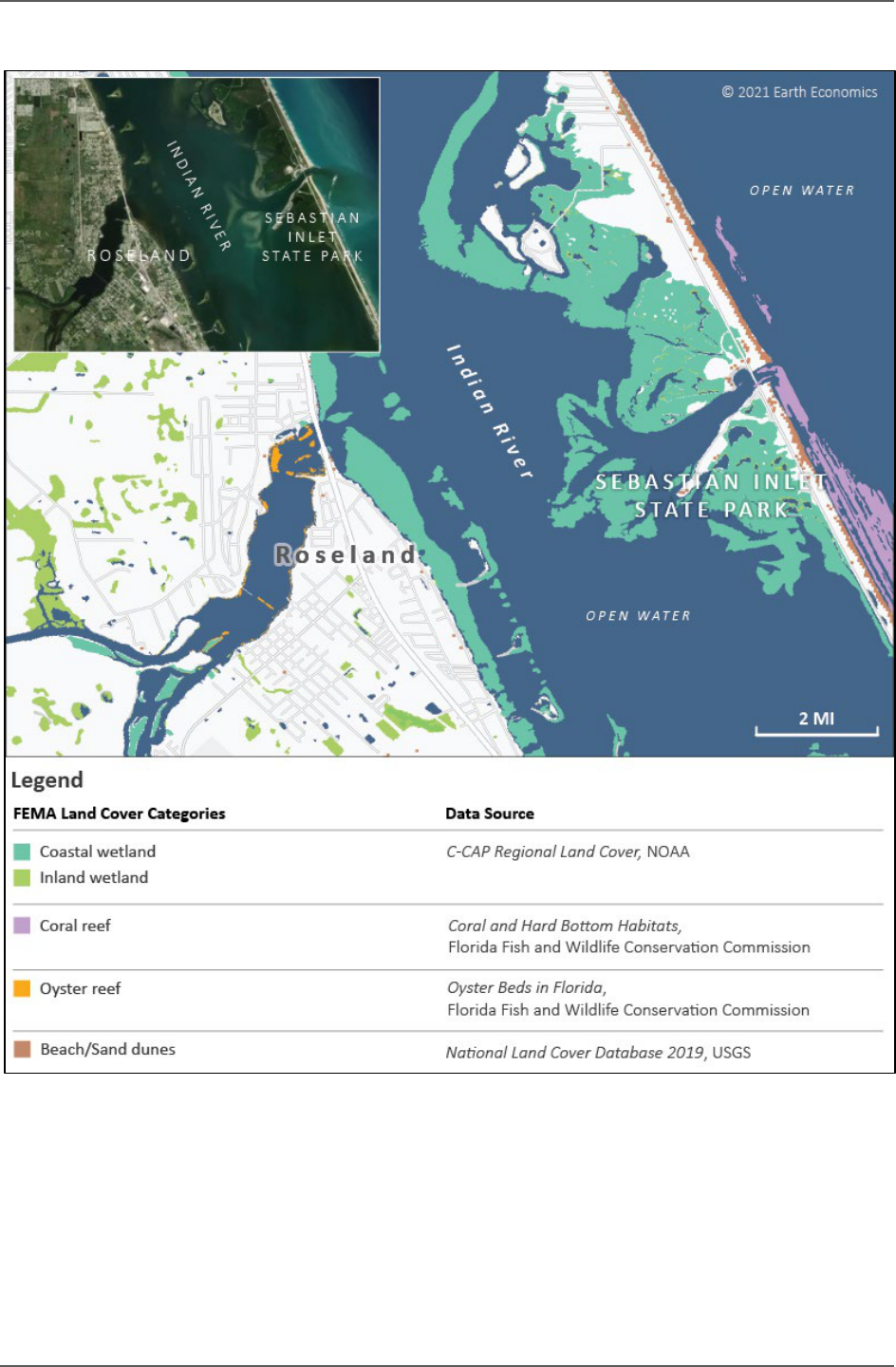
FEMA Ecosystem Service Value Updates
20
Figure 1. Land Cover Example (1/2)
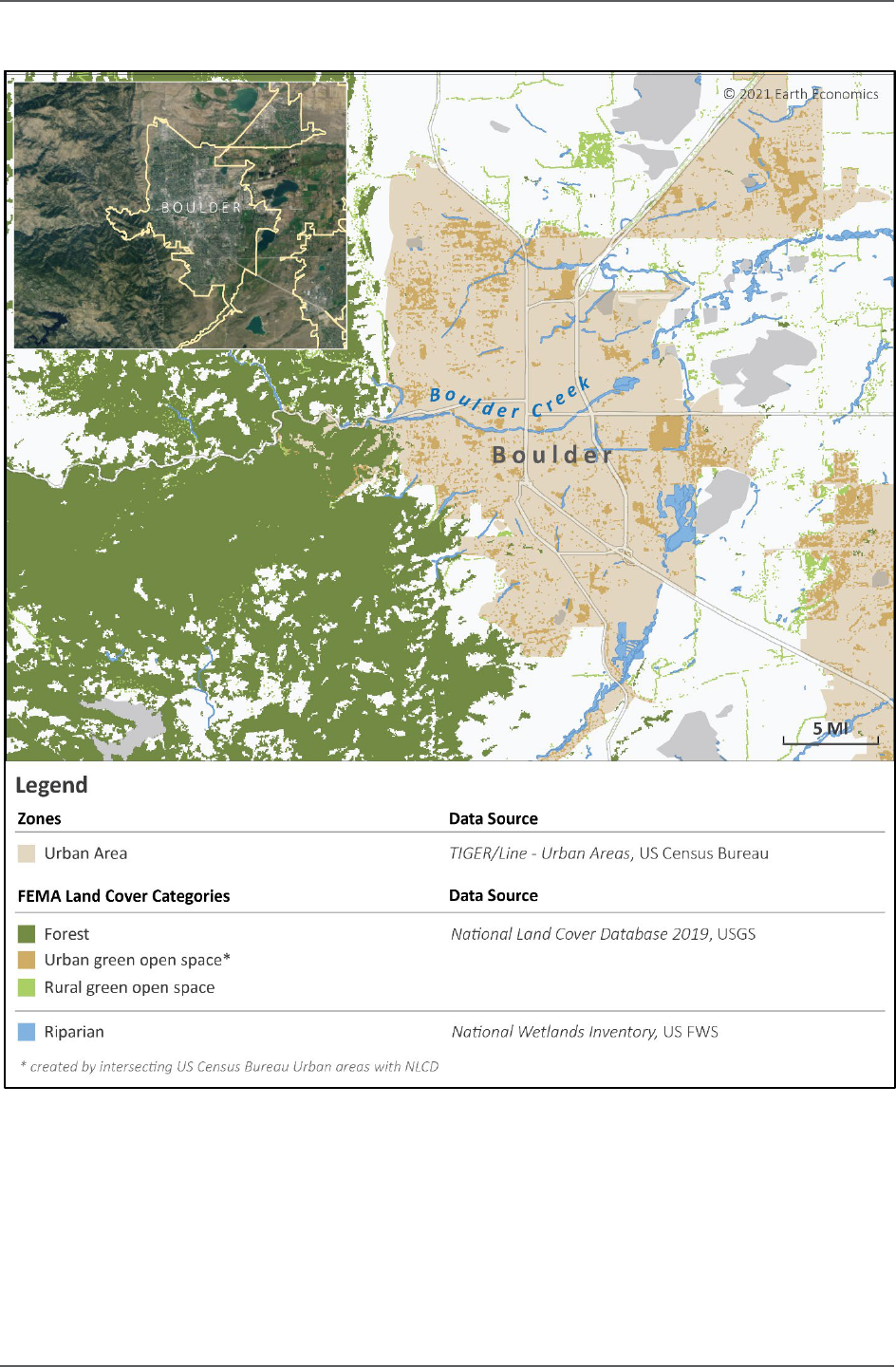
FEMA Ecosystem Service Value Updates
21
Figure 2. Land Cover Example (2/2)

FEMA Ecosystem Service Value Updates
22
5.2. Ensure Each Land Cover Category Meets Feasibility & Effectiveness
Criteria
Appendices A–I include Feasibility & Effectiveness criteria and resources specific to each land cover
category. However, in general, to use the ecosystem service values for a given land cover category in
a FEMA BCA, the project should meet the following criteria:
Final land cover associated with the mitigation project should be consistent with the definition of
the land cover category provided in this document (Table 5 in the previous section and
Appendices A–I).
Project must demonstrate a significant level of ecosystem restoration, creation, enhancement or
protection of the relevant land cover category (or categories).
o Society for Ecological Restoration (SER) International defines ecosystem (ecological)
restoration as “the process of assisting the recovery of an ecosystem that has been
degraded, damaged, or destroyed.”
10
According to the EPA,
iii
the concept of restoration can
also include restoration-related activities such as “creation” and “enhancement” of
ecosystems.
o In the context of a FEMA BCA, the ecosystem service values can be realized through an
increase in the health or functionality of an ecosystem in the “After-Mitigation” scenario
relative to the “Before-Mitigation” (No Action) scenario. Therefore, ecosystem service values
could be generated through restoration, creation, enhancement or protection (of areas at
risk of degradation in a No Action scenario).
‒ A common example would be a standard FEMA Acquisition and Relocation/Demolition
project that results in the restoration, creation, enhancement or protection of ecosystems
within the parcel.
‒ Another example would be the acquisition of a parcel that does not contain structures,
followed by restoration, creation or enhancement of ecosystems on that parcel for the
purpose of reducing the risk of a hazard such as flood or wildfire. It should be
emphasized that, per the 2015 FEMA HMA Guidance document, projects “with the sole
purpose of open space acquisition of unimproved land” are an ineligible activity,
However, if acquisition of an existing unimproved parcel is part of a broader, eligible
mitigation action, it may be eligible. For example, the subapplicant may be proposing a
Floodplain and Stream Restoration, Flood Diversion and Storage, or Hazardous Fuels
Reduction project that involves acquisition of an open space parcel containing a
degraded forested area. If the subapplicant could show that 1) Acquisition is required in
iii
Discussed in the context of wetland restoration but broadly applicable to other ecosystem types. See the following link for
more information: https://www.epa.gov/wetlands/wetlands-restoration-definitions-and-distinctions

FEMA Ecosystem Service Value Updates
23
order to make the project feasible and effective (i.e., other options such as easements or
landowner agreements have been considered but ruled out); AND 2) Restoration,
creation and/or enhancement
iv
of forested areas on that parcel would result in a
quantifiable risk reduction benefit (as demonstrated through modeling and/or the BCA
Toolkit), then such an action may be quantified and considered for ecosystem service
benefits in the BCA. Examples could include: 1) Acquisition and restoration of a forested
area to increase the floodwater storage potential on the land, thereby reducing flood risk
to downstream people and property; or 2) Acquisition and enhancement of a forested
area through hazardous fuels reduction activities, thereby reducing the potential risk and
severity of a wildfire to adjacent people and property. However, because such
approaches are relatively new from a FEMA HMA perspective, the subapplicant should
always seek guidance and clarification on this matter from their FEMA regional office and
State Hazard Mitigation Officer.
In general, restoration, creation, enhancement and protection should follow internally or
externally established principles, guidelines, policies and techniques associated with the specific
land cover category.
5.3. Select an Appropriate Project Useful Life
The term Project Useful Life (PUL) refers to the length of time the project will provide benefits.
FEMA’s BCA Toolkit provides a standard PUL for many eligible mitigation actions, or components of
mitigation actions, and in some cases allows the subapplicant to select from a range (depending
upon the nature of the project and available documentation). For example, Acquisition/Relocation
has a default PUL of 100 years, and both Floodplain and Stream Restoration and Flood Diversion
and Storage have a default PUL of 30 years, but the BCA Toolkit notes “Higher PUL values
acceptable with documentation” in the case of the latter.
In general, if subapplicants meet the Feasibility & Effectiveness criteria for a land cover category (see
Appendices A–I), and they—or other entity—continue to provide some minimum level of maintenance
and/or protection, most of the ecosystems represented by these land cover categories should be
largely self-maintaining and generate their respective ecosystem services in perpetuity. For this
reason, it is recommended that, in most cases, the PUL associated with each land cover category be
tied to the length of time subapplicants can demonstrate they will be providing maintenance and/or
protection, as evidenced through appropriate documentation, as described further below.
iv
“Protection” is not included here, because it is assumed that the FEMA-compliant deed restriction placed on the parcel
following acquisition already represents protection.

FEMA Ecosystem Service Value Updates
24
The following guidelines are recommended for determining an appropriate PUL for all land cover
categories, with the exception of Beaches and Dunes (
Table 7).
v
Subapplicant can use a standard value of 50 years without the need for justification or
documentation.
If the land cover restoration, creation, enhancement or protection is part of a larger mitigation
project, which includes other eligible mitigation actions, then the subapplicant can select a PUL
equal to that of the primary mitigation action (e.g., as reflected by total share of project budget).
For example, if riparian restoration, creation, enhancement or protection is part of a “major
infrastructure” project with a documented PUL of 75 years, then the subapplicant can select 75
years as the PUL of the riparian area. This approach assumes that the land cover will be
maintained at least as long as the primary infrastructure associated with the project.
If the subapplicant can provide documented assurances that the land cover will be maintained
beyond the standard PUL of 50 years, then the subapplicant can select a PUL of between 51 and
100 years (100 years representing “perpetuity”). Examples of assurances, in order of preference,
may include:
o Subapplicant owns or acquires the parcel(s) (i.e., transfers title) and places a FEMA-
compliant deed restriction on the parcel(s) (CFR, Title 44, Part 80), requiring the property be
maintained as open space in perpetuity. This example represents a typical FEMA acquisition
and demolition/relocation project. Ideally, the subapplicant can also show evidence of a
permanent endowment that will be set up to maintain the land in perpetuity, or a similar
assurance such as a documented agency commitment.
o Subapplicant acquires the parcel(s) (i.e., transfers title) and places a deed restriction on the
parcel(s), consistent with FEMA’s requirements, requiring the property be maintained as
open space for some other specified period into the future (i.e., 51–99 years). Ideally, the
subapplicant can also show evidence of a permanent endowment that will be set up to
maintain the land for the specified period, or a similar assurance such as an agency
commitment letter.
o Subapplicant does not acquire the land but purchases an easement on the land (e.g.,
purchase of development rights) that requires the land remain in uses consistent with open
space for a specified period into the future (i.e., 51–100 years, with 100 years representing
“perpetuity”).
o Subapplicant does not acquire the land but signs a maintenance agreement with the
property owner (private or government), requiring the property owner to continue to provide
v
All examples assume the subapplicant is meeting the Effectiveness & Feasibility criteria for the respective land cover
category

FEMA Ecosystem Service Value Updates
25
some minimum level of maintenance on the land—and/or allowing the subapplicant to
access the land and conduct ongoing maintenance—for a specified period into the future
(i.e., 51–100 years, with 100 years representing “perpetuity”).
Based on the guidelines above, FEMA could consider adding the following rows to the BCA Toolkit’s
PUL table:
Table 7. Project Useful Life Guidance
Project Type Project Useful Life (Years) Comment
Standard Value
Acceptable Limits
(Documentation
Required)
Elements of eligible
projects that involve
restoration, creation,
enhancement or protection
of:
Forest
Urban Green Open
Space
Rural Green Open
Space
Riparian
100 - Land is owned or acquired, and
FEMA-compliant deed restrictions
(CFR, Title 44, Part 80) or
equivalent perpetual easement
recorded on property.
Feasibility & Effectiveness criteria
must also be met for the land
cover category.
50 50–100 Land is not owned, acquired or
controlled.
Feasibility & Effectiveness criteria
must be met to use the standard
value of 50 years for the land
cover category. PUL can be
increased up to 100 years
(representing perpetuity)
depending upon how long the land
cover will be maintained/
protected, as evidenced through
documented assurances, such as
deed restriction, easement or
maintenance agreement with
landowner.

FEMA Ecosystem Service Value Updates
26
Project Type Project Useful Life (Years) Comment
Elements of eligible
projects that involve
restoration, creation,
enhancement or protection
of:
Coastal Wetland
Inland Wetland
Coral Reefs
Shellfish Reefs
50 50–100 Feasibility & Effectiveness criteria
must be met to use the standard
value of 50 years for the land
cover category. PUL can be
increased up to 100 years,
depending upon how long the land
cover will be maintained/
protected, as evidenced through
documented assurances,
including agency commitments,
formation of protected areas.
Final land cover is ideally owned
or controlled by a government or
non-profit organization.
Elements of eligible
projects that involve
restoration, creation,
enhancement or protection
of:
Beaches and Dunes
20 20-50 Dune restoration, creation,
enhancement or protection as a
mitigation action is only eligible
within the context of the PA 406
Hazard Mitigation. If the standard
value is not used, the PUL of
dunes should be based on the
average recurrence interval of a
storm event that would overtop or
breach the dunes (which assumes
the dune will need to be rebuilt
after that event).
Feasibility & Effectiveness criteria
must also be met for the land
cover category.
5.4. Conceptual Examples
Table 8 provides conceptual examples of how the individual land cover categories might be included
in a mitigation project. It should be reiterated that, in addition to following the criteria and guidance
related to land cover categories discussed above and in Appendices A–I, all mitigation projects must
be comprised of eligible risk reduction activities and meet any other relevant FEMA programmatic
requirements (e.g., cost-effectiveness, Environmental and Historic Preservation) to be eligible for
FEMA funding.

FEMA Ecosystem Service Value Updates
27
Table 8. Conceptual Examples of Mitigation Projects that Include Land Cover Categories
Land Cover
Category
Conceptual Example Link to Detailed
Guidance
Forest Restoration, creation, enhancement or protection of a
forested area as a component of a Flood Diversion and
Storage (FDS) or Floodplain and Stream Restoration
(FSR) project to increase flood storage capacity on the
land/floodplain, reduce runoff and decrease flood risk to
downstream, upstream or adjacent people and
structures. This example would apply to forested areas
within an FDS or FSR project that are not defined as
“riparian.”
Appendix A
Forest Hazardous fuels reduction and other ecosystem health
improvement actions in an existing forested area to
mitigate wildfire risk while generating additional
ecosystem services (e.g., erosion control, recreation)
Appendix A
Forest
Reforestation of urban areas (e.g., as a component of an
Acquisition and Relocation/Demolition project or other
eligible mitigation project) to mitigate natural hazards
such as heat and pluvial flooding, while generating other
ecosystem services (e.g., aesthetic value, air quality,
recreation).
Appendix A
Coastal Wetland Restoration, creation, enhancement or protection of
coastal wetland as part of a mitigation project to support
erosion reduction, sediment trapping and building, wave
attenuation, surge attenuation, and/or flood storage.
11
Appendix B
Inland Wetland Restoration, creation, enhancement or protection of an
existing inland wetland area or creation of a new inland
wetland area as a component of a Flood Diversion and
Storage (FDS) or Floodplain and Stream Restoration
(FSR) project to increase flood storage capacity on the
land/floodplain, reduce runoff and decrease flood risk to
downstream, upstream or adjacent people and
structures. This example would apply to forested areas
within an FDS or FSR project that are not defined as
“riparian.”
Appendix C
Urban Green Open
Space
Open space areas created because of Acquisition and
Relocation/Demolition projects, and restriction of the
parcel(s) as “open space” consistent with the “Allowable
Uses of Open Space” in Section A.6.1. of FEMA’s 2015
HMA Guidance Addendum. Open space areas must also
specifically meet the definition of “urban” and other
criteria.
Appendix D

FEMA Ecosystem Service Value Updates
28
Land Cover
Category
Conceptual Example Link to Detailed
Guidance
Urban Green Open
Space
Creation of an urban park to support hazard risk
reduction (e.g., pluvial flooding, heat) and other social
and environmental benefits.
Appendix D
Urban Green Open
Space
Areas associated with Floodplain and Stream Restoration
or Flood Diversion and Storage projects in areas that are
within the floodplain and meet the definition/criteria for
“urban green open space.”
Appendix D
Rural Green Open
Space
Open space areas created because of Acquisition and
Relocation/Demolition projects, and restriction of the
parcel(s) as “open space” consistent with the “Allowable
Uses of Open Space” in Section A.6.1. of FEMA’s 2015
HMA Guidance Addendum. Open space areas must also
meet the definition of “rural” and other criteria.
Appendix E
Rural Green Open
Space
Creation of a rural park to support hazard risk reduction
(e.g., pluvial/riverine flooding, wildfire) and other social
and environmental benefits.
Appendix E
Rural Green Open
Space
Areas associated with Floodplain and Stream Restoration
or Flood Diversion and Storage projects in areas that are
within the floodplain and meet the definition/criteria for
“rural green open space.”
Appendix E
Riparian Open space areas that meet the definition of “riparian,”
which are created because of Acquisition and
Relocation/Demolition projects, and restriction of the
parcel(s) as “open space” consistent with the “Allowable
Uses of Open Space” in Section A.6.1. of FEMA’s 2015
HMA Guidance Addendum.
Appendix F
Riparian Restoration, creation, enhancement or protection of a
riparian area as a component of a Floodplain Diversion
and Storage (FDS) or Floodplain and Stream Restoration
(FSR) project to increase flood storage capacity on the
land/floodplain, reduce runoff or streambank erosion and
decrease flood risk to downstream, upstream or adjacent
people and structures. Areas within an FDS or FSR project
that meet the definition of “riparian” can often be
adjacent to “forest” and/or “wetland” areas, as defined in
this guidance, and care should be taken to avoid double
counting the same area (e.g., a given acre) twice.
Appendix F

FEMA Ecosystem Service Value Updates
29
Land Cover
Category
Conceptual Example Link to Detailed
Guidance
Riparian
Restoration of urban riparian areas to mitigate natural
hazards such as heat and pluvial flooding, while
generating other ecosystem services (e.g., aesthetic
value, air quality, recreation). Like the example above,
restoration of riparian areas is likely to occur as part of a
broader restoration effort, possibly adjacent to “wetland”
and “forest” areas as defined in this guidance.
Appendix F
Riparian Hazardous fuels reduction and other ecosystem health
improvement actions in an existing riparian area to
mitigate wildfire risk while generating additional
ecosystem services (e.g., erosion control, recreation).
Appendix F
Coral reefs Restoration, creation, enhancement or protection of coral
reefs to support coastal storm/flood risk reduction.
Appendix G
Beaches and
Dunes
Restoration, creation, enhancement or protection of
dunes for coastal storm/flood risk reduction.
Appendix H
Shellfish reefs Restoration, creation, enhancement or protection of
shellfish reefs for coastal storm/flood risk reduction.
Appendix I
5.5. “Real World” Examples
The following examples demonstrate in more detail how a subapplicant could incorporate the land
cover categories provided earlier, and how that would be reflected in the BCA, along with PUL
considerations. Not all possible hazards, project types or land cover categories have been included.
5.5.1. Example 1: Urban Floodplain Acquisition and Restoration Project
Project Description
The City of Resilience is a medium-sized city on the West Coast. The City submitted an HMGP
subapplication to FEMA, requesting $3 million in federal cost share to implement a flood risk
reduction project in a neighborhood that experienced frequent flooding.
The scope of work included acquisition of private properties from willing sellers and
demolition/relocation of structures that were on those parcels; restoration of riparian habitat areas
along the river; reconnection of the floodplain to the river, including removal of existing roads and
bridges to allow flood water to access the restored floodplain; and creation of an urban park with
ADA-accessible trails, a parking lot and other basic amenities (including installation of thousands of
native trees, shrubs and grasses).
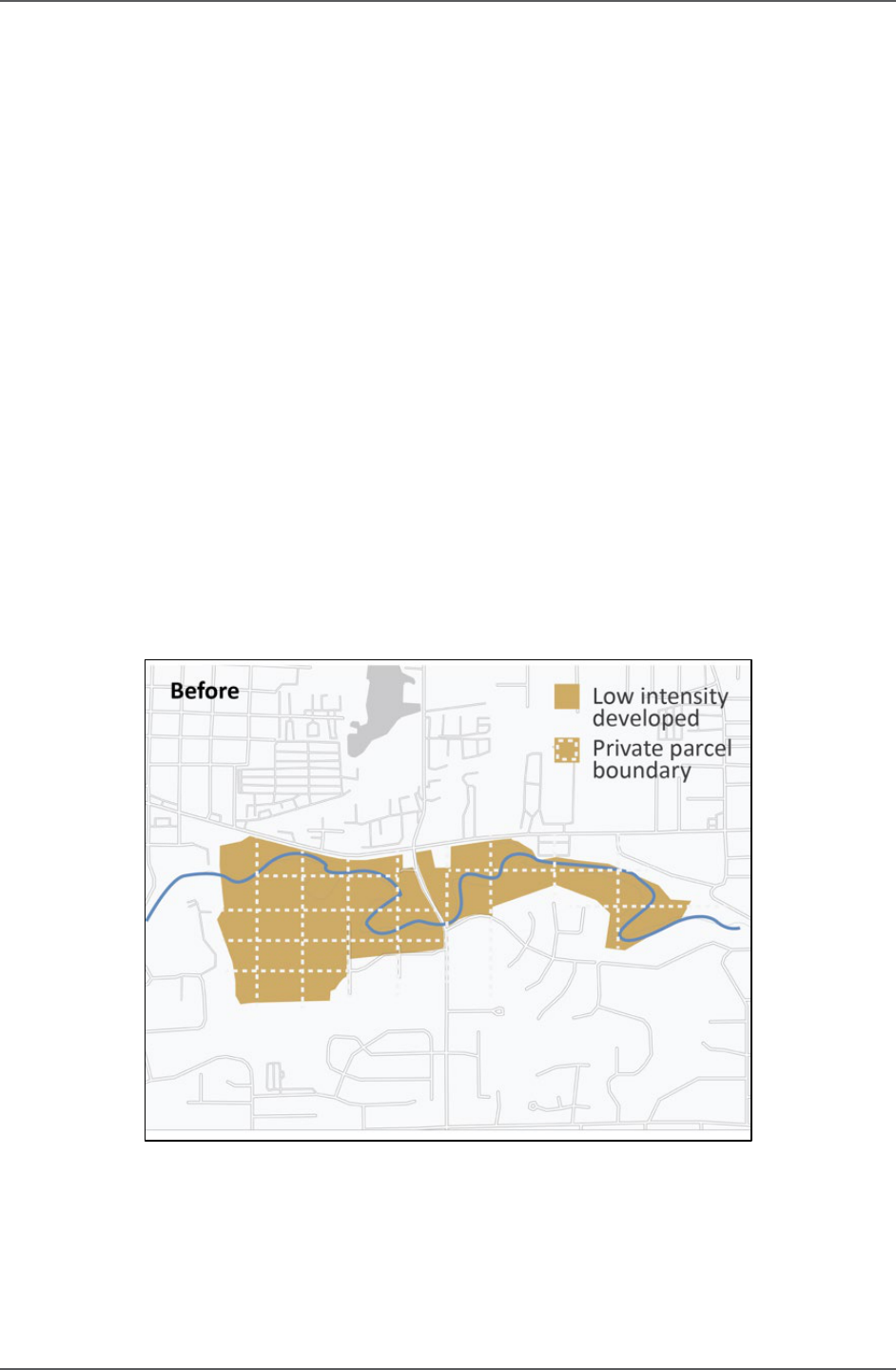
FEMA Ecosystem Service Value Updates
30
Benefits of the project include floodwater storage, reducing flood risk to downstream structures and
adjacent roads; habitat for fish and wildlife, including endangered salmon species; improved water
quality; and recreational opportunities.
Figure 3 provides a map of the project site before mitigation, while Figure 4 and Figure 5 provide a
map and satellite image of the project after mitigation, respectively.
Relevant Land Cover Categories
In total, the footprint of the project encompassed 65 acres, of which 15 acres met the definition of
“Riparian” and 50 acres met the definition of “Urban Green Open Space,” as well as relevant
Feasibility & Effectiveness considerations (Table 5 and Appendices D and F). Because the entire site
was restored and converted to a publicly accessible park, all 65 acres were counted in the BCA.
Project Useful Life Considerations
Following acquisition of the private parcels, the City recorded deed restrictions on the parcels,
consistent with the FEMA Model Deed Restriction, ensuring the property would be maintained in
perpetuity for uses that are compatible with open space. As a result, the City was able to use a
default value of 100 years for the PUL in the BCA.
Figures
Figure 3. Urban Floodplain Restoration – Before Mitigation
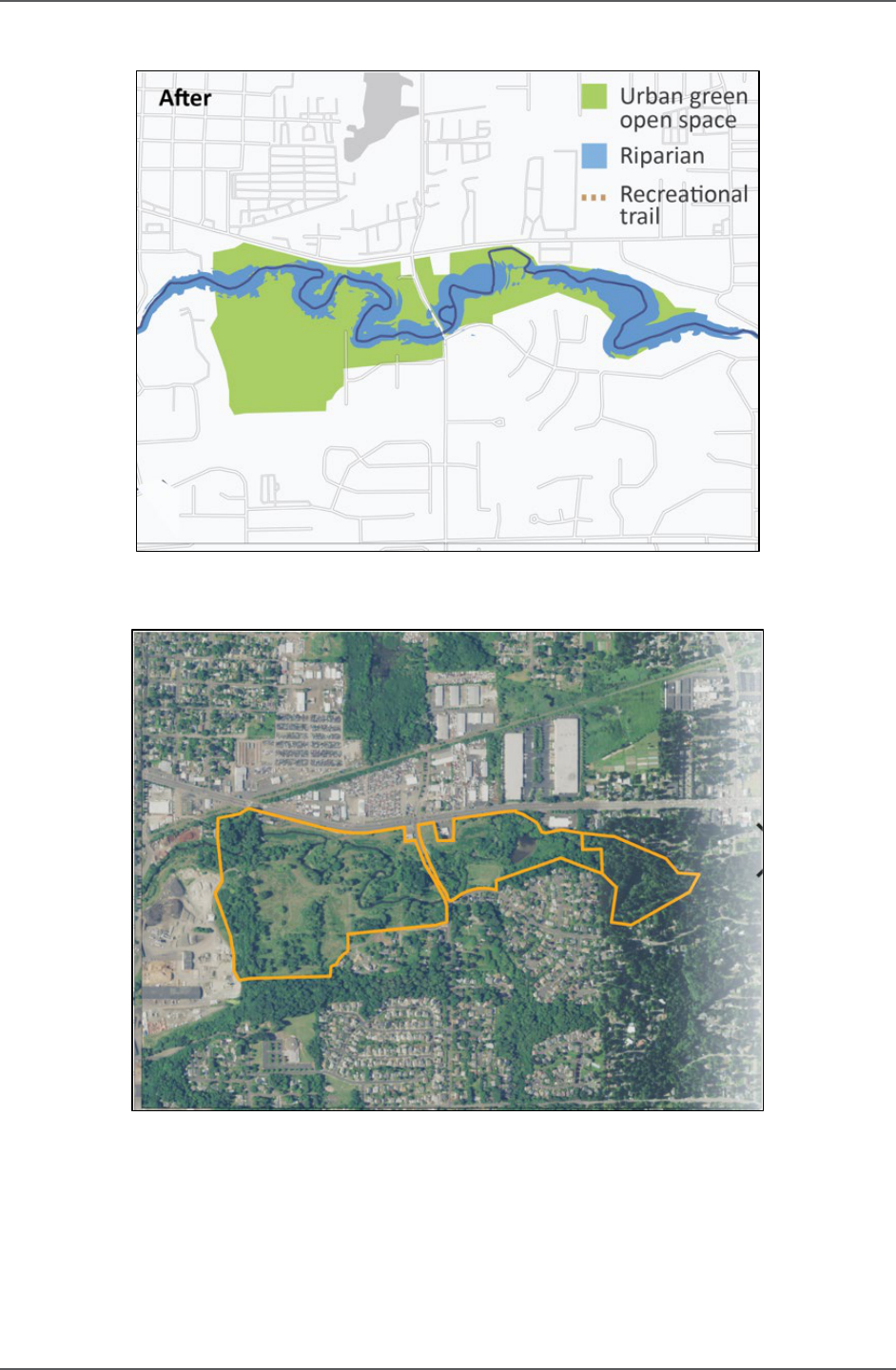
FEMA Ecosystem Service Value Updates
31
Figure 4. Urban Floodplain Restoration – After Mitigation
Figure 5. Urban Floodplain Restoration – After Mitigation (satellite image)

FEMA Ecosystem Service Value Updates
32
5.5.2. Example 2: Rural Park and Floodplain Storage Project
Project Description
Springfield is a town of 2,500 people on the Front Range in Colorado. The Town submitted an HMGP
subapplication to FEMA, requesting $2 million in federal cost share for a mitigation project.
The scope of work included conversion of a former industrial site, which was already owned by the
Town (and leased out until recently), into a riverside park that could hold floodwaters during flood
events and included trails, bathrooms, and a kiosk; restoration of riparian habitat areas along the
river; and restoration and hazardous fuels reduction in a privately held forested area to the south
west of the park to reduce wildfire risk.
Benefits of the project include floodwater storage, reducing flood risk to downstream structures;
habitat for fish and wildlife; wildfire risk reduction; and recreational opportunities.
Figure 6 provides a map of the project site before mitigation, while Figure 7 and Figure 8 provide a
map and satellite image of the project after mitigation, respectively.
Relevant Land Cover Categories
In total, the footprint of the project encompassed 50 acres, of which 10 acres met the definition of
“Riparian,” 20 acres met the definition of “Rural Green Open Space,” and 20 acres met the
definition of “Forest” (Table 5). All final land cover categories also met relevant Feasibility &
Effectiveness considerations (Appendices A, D and F).
Project Useful Life Considerations
The Town already owned the areas of “Riparian” (10 acres) and “Rural Green Open Space” (20
acres), but opted to record deed restrictions on the parcels, consistent with the FEMA Model Deed
Restriction, to ensure the property would be maintained in perpetuity for uses that are compatible
with open space. As a result, the Town was able to use a PUL of 100 years for those 30 acres in the
BCA.
The 20 acres of “Forest” to the southwest of the park remained in private ownership. However, the
Town signed a contract with the landowner allowing the Town to enter the property and conduct
ongoing, hazardous fuels reduction activities on the land for 50 years into the future. The Town
therefore used a PUL of 50 years for those 20 acres in the BCA.
Figures
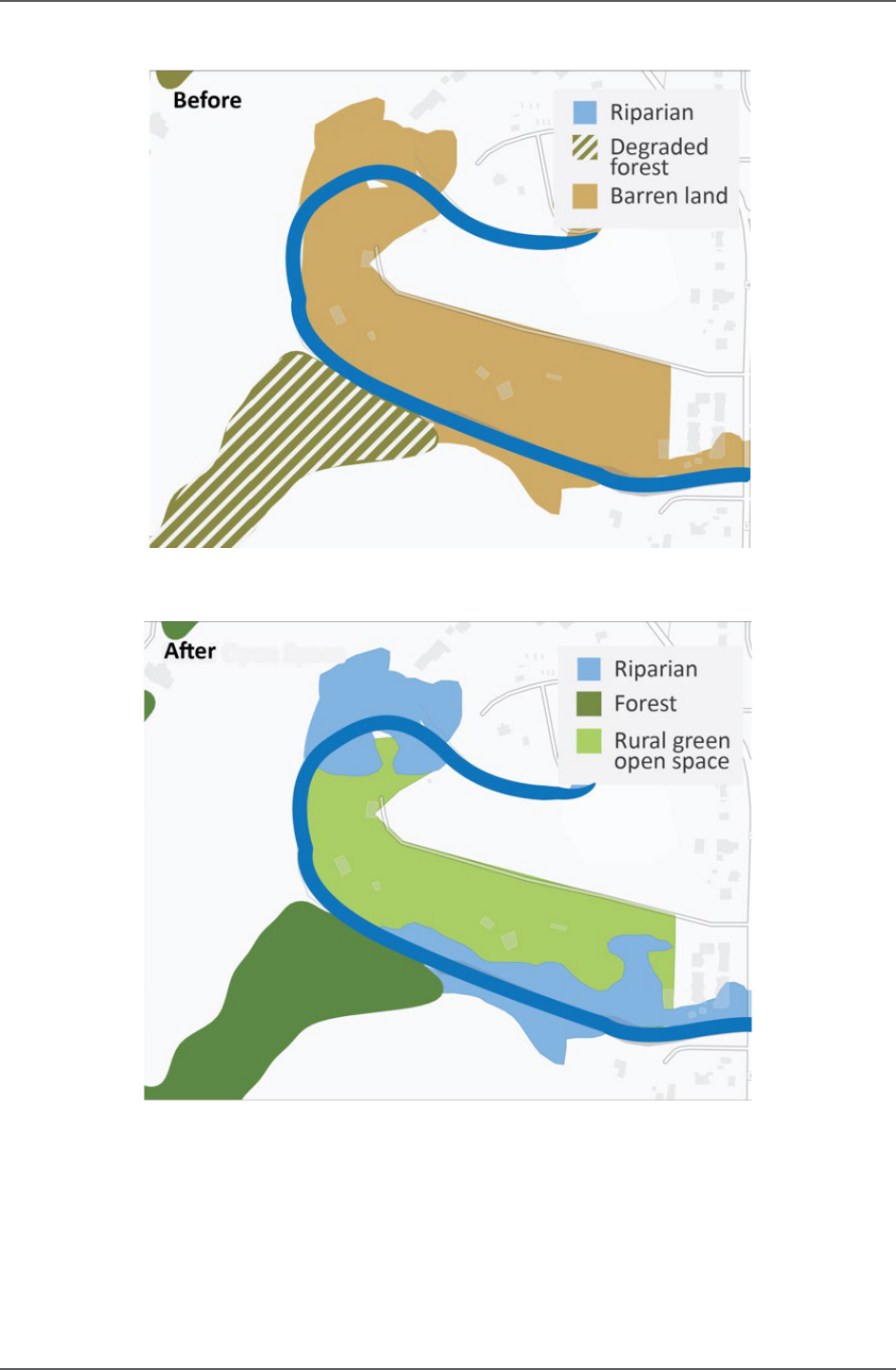
FEMA Ecosystem Service Value Updates
33
Figure 6. Rural Floodplain Restoration – Before Mitigation
Figure 7. Rural Floodplain Restoration – After Mitigation

FEMA Ecosystem Service Value Updates
34
Figure 8. Rural Floodplain Restoration – After Mitigation (satellite image)
5.5.3. Example 3: Coastal Wetland Restoration Project
Project Description
Beach Haven is a mid-sized city on the east coast of Florida. The City submitted an HMGP
subapplication to FEMA, requesting $4 million in federal cost share for a mitigation project.
The scope of work included restoration of 50 acres of coastal wetlands that had become degraded
by human impacts.
Benefits of the project include coastal flood risk reduction for residential structures, roads and
critical facilities; habitat for fish and wildlife; and water quality improvements for nearby beaches.
Figure 9 provides a map of the project site before mitigation, while Figure 10 and Figure 11 provide a
map and satellite image of the project after mitigation, respectively.
Relevant Land Cover Categories
In total, the footprint of the project encompassed 50 acres, all of which met the definition of “Coastal
Wetland” (Table 5) and the relevant Feasibility & Effectiveness considerations (Appendix B). All 50
acres were therefore included in the BCA.
To the west of the project, there were approximately 40 acres of existing Coastal Wetland and 30
acres of existing Inland Wetland—all healthy and not requiring any restoration. To the east of the
project was open water (not a FEMA land cover category) and 100 acres of seagrass beds (captured
as “Coastal Wetland” under FEMA’s definition). Since the footprint of the project did not include any
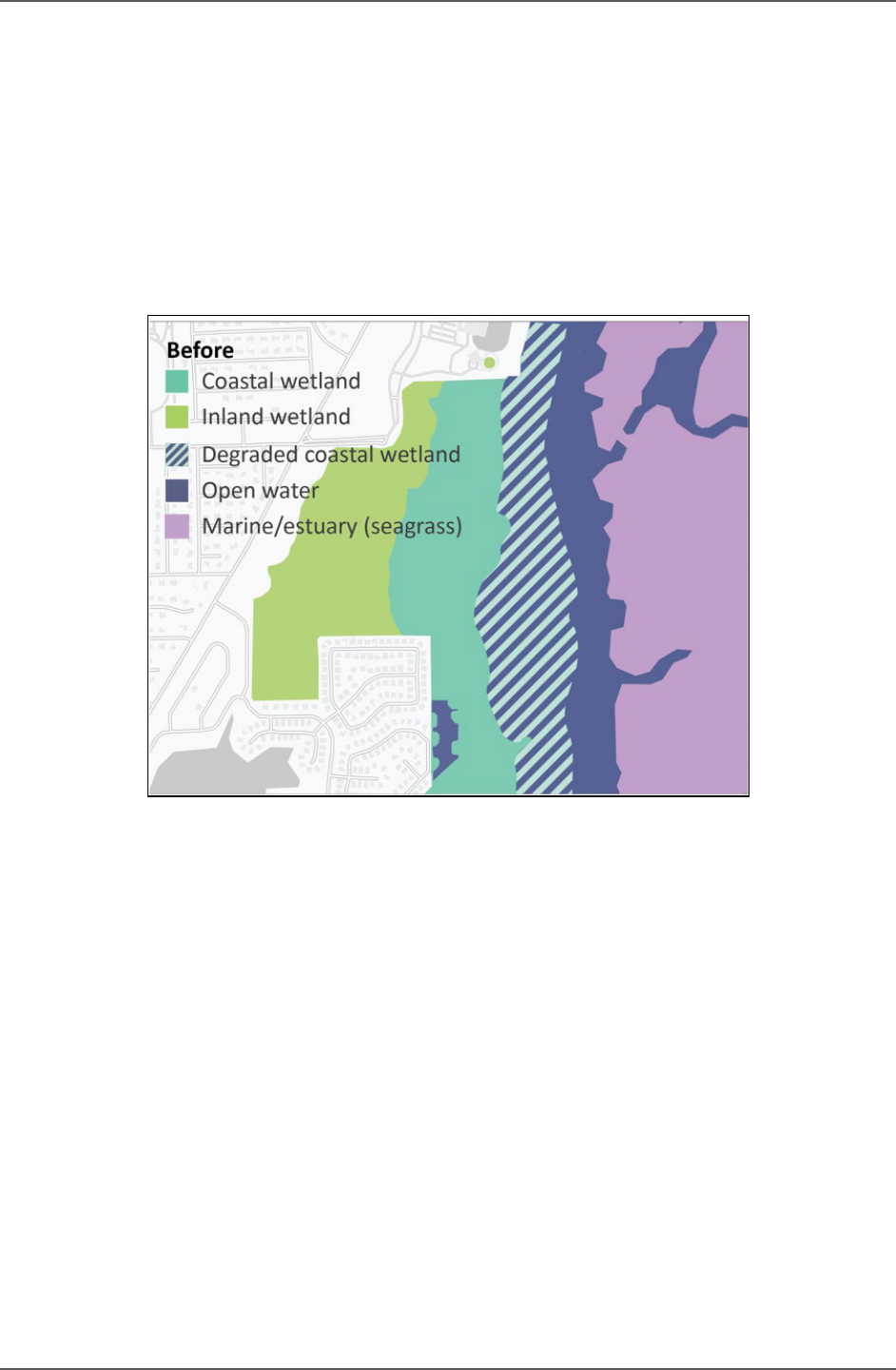
FEMA Ecosystem Service Value Updates
35
of these areas, and there was no change in the After Mitigation compared with Before Mitigation,
they were not included in the BCA.
Project Useful Life Considerations
The City intended to monitor and maintain the wetlands in perpetuity; however, it could not provide
documentation to show this, and therefore opted to use the standard PUL of 30 years in the BCA.
Figures
Figure 9. Coastal Wetland Restoration Project – Before Mitigation

FEMA Ecosystem Service Value Updates
36
Figure 10. Coastal Wetland Restoration Project – After Mitigation
Figure 11. Coastal Wetland Restoration Project – After Mitigation (satellite image)

FEMA Ecosystem Service Value Updates
37
Appendix A. Forest
Land Cover Definition
Forest is defined as:
Areas dominated by trees (evergreen and/or deciduous) generally greater than 5 meters tall that –
on average – comprise greater than 20% of the total vegetation cover within the area or unit of
analysis (e.g., pixel, polygon, parcel).
vi
This definition of forest is based on the 2019 National Land Cover Database (NLCD), a product that
is developed and regularly updated by the Multi-Resolution Land Characteristics (MRLC) consortium,
a “group of federal agencies who coordinate and generate consistent and relevant land cover
information at the national scale for a wide variety of environmental, land management, and
modeling applications.”
12
The NLCD, in turn, has been modified from the Anderson Land Cover
Classification System.
13
Feasibility & Effectiveness Criteria
In general, to include the ecosystem service values for forest in a FEMA BCA, the project should meet
the following criteria:
The final land cover associated with the mitigation project should be consistent with the
definition of “forest” (provided above).
The project must demonstrate some level of ecosystem restoration. The Society for Ecological
Restoration (SER) International defines ecosystem (ecological) restoration as “the process of
assisting the recovery of an ecosystem that has been degraded, damaged, or destroyed.”
14
This
definition has also been adopted by the U.S. Forest Service Restoration Framework Team.
15
According to the EPA,
vii
the concept of restoration can also include restoration-related activities
such as “creation” and “enhancement” of ecosystems.
In the context of a FEMA BCA, ecosystem service values can be realized through an increase in
the health or functionality of an ecosystem in the “After Mitigation” scenario relative to the
“Before Mitigation” (No Action) scenario. Therefore, ecosystem service values could be
generated through restoration, creation, enhancement or protection (of areas at risk of
degradation in a No Action scenario).
vi
In other words, areas with a tree-crown areal density of greater than 20%.
vii
Discussed in the context of wetland restoration but broadly applicable to other ecosystem types. See the following link for
more information: https://www.epa.gov/wetlands/wetlands-restoration-definitions-and-distinctions

FEMA Ecosystem Service Value Updates
38
In general, forest restoration, creation, enhancement or protection should follow internally or
externally established principles, guidelines, policies and techniques.
According to the SER International document referenced above,
16
plans for restoration projects
include, at a minimum, the following:
o Clear rationale as to why restoration is needed
o Ecological description of the site designated for restoration
o Statement of the goals and objectives of the restoration project
o Designation and description of the reference
o Explanation of how the proposed restoration will integrate with the landscape and its flows of
organisms and materials
o Explicit plans, schedules and budgets for site preparation, installation and post-installation
activities, including a strategy for making prompt mid-course corrections
o Well-developed and explicitly stated performance standards, with monitoring protocols by
which the project can be evaluated
o Strategies for long-term protection and maintenance of the restored ecosystem
Mitigation Project Use Cases
The following examples demonstrate how the “forest” land cover category might be used in a
mitigation project (and associated BCA):
Restoration, creation, enhancement or protection of a forested area as a component of a Flood
Diversion and Storage (FDS) or Floodplain and Stream Restoration (FSR) project to increase flood
storage capacity on the land/floodplain, reduce runoff and decrease flood risk to downstream,
upstream or adjacent people and structures. This example would apply to forested areas within
an FDS or FSR project that are not defined as “riparian.”
Hazardous fuels reduction and other ecosystem health improvement actions in an existing
forested area to mitigate wildfire risk while generating additional ecosystem services (e.g.,
erosion control, recreation).
Reforestation of urban areas (e.g., as a component of an Acquisition and Relocation/Demolition
project or other eligible mitigation project) to mitigate natural hazards such as heat and pluvial
flooding, while generating other ecosystem services (e.g., aesthetic value, air quality, recreation).

FEMA Ecosystem Service Value Updates
39
Project Useful Life Considerations
In general, provided that forested areas associated with the project meet the above definition and
Feasibility & Effectiveness criteria, a standard PUL of 50 years can be applied. A higher PUL may be
applied in the following cases:
If the forested area is owned or acquired, and a FEMA-compliant deed restriction (CFR, Title 44,
Part 80) or equivalent perpetual easement is recorded on the property, then a PUL of 100 years
can be used. A typical example would be a standard FEMA Acquisition and
Relocation/Demolition project that results in the restoration, creation, enhancement or
protection of the forested area.
If the land is not owned, acquired or controlled, but the subapplicant can demonstrate that the
land cover will be maintained/protected beyond 50 years (as evidenced through documented
assurances, such as deed restriction, easement or maintenance agreement with the landowner),
then a PUL of 51–100 years can be used (with 100 years representing perpetuity), depending
upon the nature of the assurances.
Please see the section in the main report body titled “Select an Appropriate Project Useful Life” for
more background and detail.
Summary of Value Updates
Ecosystem Service 2016 Policy This Update
Value (2014
USD/acre/year)
Source
Studies
Included
(#)
Value (2021
USD/acre/year)
Source
Studies
Added (#)
Source Studies
Removed (#)
Aesthetic Value — 0 1,477 3
Air Quality — 0 711 3
Biological Control
Climate Regulation 153 5 199 1 2
Erosion Control — 0 1,672 1
Existence Value — 0 7,531 1
Flood Hazard Risk
Reduction
321 4 368 0 0
Food Provisioning
Habitat
Pollination

FEMA Ecosystem Service Value Updates
40
Ecosystem Service 2016 Policy This Update
Value (2014
USD/acre/year)
Source
Studies
Included
(#)
Value (2021
USD/acre/year)
Source
Studies
Added (#)
Source Studies
Removed (#)
Recreation/Tourism — 0 94 1
Water Filtration — 0 435 1
Water Supply 80 1 103 1 0
Total Estimated
Benefits
554
12,589
Ecosystem Service Values
Aesthetic Value
Summary
Land Cover: Forest
Ecosystem Service: Aesthetic Value
FEMA Value: $1,477/acre/year
Currency Year: 2021 USD
Source Studies and Value Derivation
Valuation Methods: Revealed Preference, Hedonic Pricing
Geographic Area of Studies: Western and Central United States
Source Studies:
Reference 1: Kousky, C., Walls, M. 2013. Floodplain Conservation as a Flood Mitigation
Strategy: Estimating Costs and Benefits. Resources for the Future, Washington, DC.
Reference 2: McPherson, G., Simpson, J.R., Peper, P.J., Maco, S.E., Xiao, Q. 2005. “Municipal
forest benefits and costs in five U.S. cities.” Journal of Forestry 103(8): 411–416.
Methodology Description: Kousky & Walls (2013) estimated multiple benefits of floodplain
conservation based on a case study of the Meramac River greenway in St. Louis County, Missouri.
17
Aesthetic benefits were estimated through a hedonic model analyzing property values based on the
proximity to the greenway. Total values are estimated in 2012 USD/year, which we divided by the
total acres of the Meramac greenway and then converted to 2021 USD/acre/year listed in the table
below. McPherson et al. (2005) estimated multiple benefits of street and park trees in five U.S.
cities.
18
Aesthetic benefits were estimated based on a previous hedonic price study which was
applied through a biophysical model to tree and home distribution data for each city. Values are
estimated as a single citywide 2005 USD net present value per city. We adjusted these values by
dividing by total acres of citywide street and park trees and then divided that resulting value by the

FEMA Ecosystem Service Value Updates
41
average years of home ownership (13) to arrive at a final 2005 USD/acre/year value. We then
converted this to 2021 USD/acre/year values listed in the table below. Values were only taken from
three of the five cities, as information on canopy cover was not readily available for two of the cities.
Calculation:
Source Study Study Location Value
($/acre/year)*
Kousky & Walls (2013) St. Louis County, MO 1,004
McPherson et al. (2005) Fort Collins, CO 4,177
McPherson et al. (2005) Cheyenne, WY 197
McPherson et al. (2005) Berkeley, CA 530
Average
1,477
*All values are presented in 2021 USD
Discussion: The aesthetic value benefits of these studies are estimated in multiple cities throughout
the U.S. They cover cities of differing demographic and economic contexts influencing values
attributed to property sale prices. The values are all derived for more urban areas and thus may have
limited applicability to a rural context.
Air Quality
Summary
Land Cover: Forest
Ecosystem Service: Air Quality
FEMA Value: $711/acre/year
Currency Year: 2021 USD
Source Studies and Value Derivation
Valuation Method: Avoided Cost
Geographic Area of Studies: United States
Source Studies:
Reference 1: Nowak, D.J., Hirabayashi, S., Bodine, A., Greenfield, E. 2014. “Tree and forest
effects on air quality and human health in the United States.” Environmental Pollution 193:
119–129.
Reference 2: Nowak, D.J., Hirabayashi, S., Bodine, A., Hoehn, R. 2013. “Modeled PM
2.5
removal by trees in ten U.S. cities and associated health effects.” Environmental Pollution
178: 395–402.
Reference 3: Nowak, D.J., Crane, D.E., Stevens, J.C. 2006. “Air pollution removal by urban
trees and shrubs in the United States.” Urban Forestry & Urban Greening 4(3-4): 115–123.

FEMA Ecosystem Service Value Updates
42
Methodology Description: Nowak et al. (2013) estimated the total average effects of forests on
improving air quality (specifically fine particulate matter less than 2.5 microns) in 10 cities across
the U.S.
19
This benefit is valued based on the avoided costs of human mortality and morbidity
resulting from improved air quality. Values were estimated in 2010 USD/square meters/year of tree
cover, which we converted to 2021 USD/acre/year. These converted values can be found in the
table below. Nowak et al. (2006) estimated the total average effects of forests on improving air
quality via removal of five different pollutants: O
3
, PM
10
, NO
2
, SO
2
, and CO in 55 cities across the
U.S.
20
The change in pollutant levels is valued using monetized externality values, which represent
the estimated cost of pollution to society. Values were estimated in 1994 USD/square meters/year
of tree cover, which we converted to 2021 USD/acre/year listed in the table below. The average of
all converted values can also be found in the table below. Nowak et al. (2014) estimated urban and
rural forest effects on air pollution removal (NO
2
, O
3
, PM
2.5
, SO
2
) across the conterminous U.S.
21
This
benefit is valued based on the avoided costs of human mortality and morbidity resulting from
improved air quality. An average value in 2010 USD/hectare/year for the coterminous U.S. was
used, which we converted to 2021 USD/acre/year listed in the table below. In Nowak et al. (2013)
and (2014), dollar values for pollution reduction were produced by EPA and based on the agency’s
primary air quality standards.
Calculation:
Source Study Study Location Value
($/acre/year)*
Nowak et al. (2014) Conterminous U.S. 13
Nowak et al. (2013) Atlanta, GA 250
Nowak et al. (2013) Baltimore, MD 651
Nowak et al. (2013) Boston, MA 1,152
Nowak et al. (2013) Chicago, IL 1,202
Nowak et al. (2013) Los Angeles, CA 451
Nowak et al. (2013) Minneapolis, MN 250
Nowak et al. (2013) New York, NY 1,903
Nowak et al. (2013) Philadelphia, PA 701
Nowak et al. (2013) San Francisco, CA 1,252
Nowak et al. (2013) Syracuse, NY 301
Nowak et al. (2006) 55 U.S. cities 399
Average
711
*All values are presented in 2021 USD

FEMA Ecosystem Service Value Updates
43
Discussion: The benefits of improved air quality from these studies are estimated in multiple
contexts throughout the U.S. They cover cities at many different scales and population densities, as
well as rural areas.
Climate Regulation
Summary
Land Cover: Forest
Ecosystem Service: Climate Regulation
FEMA Value: $199/acre/year
Currency Year: 2021 USD
Source Studies and Value Derivation
Valuation Method: Avoided Cost
Geographic Area of Studies: National
Source Studies:
Reference 1: Interagency Working Group on Social Cost of Greenhouse Gases. 2021.
Technical Support Document: Social Cost of Carbon, Methane, and Nitrous Oxide Interim
Estimates under Executive Order 13990.
Reference 2: Hoover, C.M., Bagdon, B., Gagnon, A. 2021. Standard Estimates of Forest
Ecosystem Carbon for Forest Types of the United States. U.S. Department of Agriculture,
Forest Service, Northern Research Station, Madison, WI. Available online at:
https://www.fs.fed.us/nrs/pubs/gtr/gtr_nrs202.pdf
Reference 3: Goulden, M.L., Munger, J.W., Fan, S.M., Daube, B.C., Wofsy, S.C. 1996.
“Exchange of carbon dioxide by a deciduous forest: response to interannual climate
variability.” Science 271(5255): 1576–1578.
Reference 4: Hamilton, J.G., DeLucia, E.H., George, K., Naidu, S.L., Finzi, A.C., Schlesinger,
W.H. 2002. “Forest carbon balance under elevated CO
2
.” Oecologia 131: 250–260.
Reference 5: Black, T.A., Chen, W.J., Barr, A.G., Arain, M.A., Chen, Z., Nesic, Z., Hogg, E.H.,
Neumann, H.H., Yang, P.C. 2000. “Increased carbon sequestration by a boreal deciduous
forest in years with a warm spring.” Geophysical research letters 27(9):
1271–1274.
Methodology Description: Carbon sequestration of forests was calculated in two parts. First, a
database of over 6,000 carbon values
viii
was used to estimate the carbon sequestration in metric
tons of carbon per acre per year of forest types across the U.S. Four studies comprising 717
individual carbon sequestration values were selected from the database to construct an average
value estimate. Second, the social cost of carbon was used to calculate a dollar value of carbon
sequestration. The social cost of carbon (SCC) represents the average societal costs associated with
viii
Internal Earth Economics database

FEMA Ecosystem Service Value Updates
44
each additional ton of carbon emissions (measured in CO
2
e
ix
), such as losses to agriculture, impacts
to human health and increased disaster risk. In the context of actions that reduce carbon emissions
(e.g., energy efficiency) or actively sequester carbon (e.g., forest restoration), the SCC represents the
value of these actions in terms of avoided cost to society and is used by federal agencies in the U.S.
and updated on a regular basis by the Interagency Working Group on the Social Cost of Greenhouse
Gases (IWGSCGG). The value for carbon sequestration used was derived from the IWGSCGG—a result
of Executive Order 13990.
22
Specifically, the 2020 value was used: $51/metric ton CO
2
e, or
$195.81/metric ton C in 2021 USD.
Calculation:
Source Study Average C Sequestration
Rate (metric tons
C/acre/year)
Social Cost of
Carbon
($/metric ton C)
Value
($/acre/year)
Hoover et al. (2021)
23
0.74 195.81 145
Goulden et al. (1996)
24
0.85 195.81 166
Hamilton et al. (2002)
25
1.76 195.81 344
Black et al. (2000)
26
0.71 195.81 139
Average
199
* All values are presented in 2021 USD
Discussion: The above assessment combined 717 carbon values estimated across the U.S. to arrive
at a single dollar value for the value of climate regulation provided by forests. The values are
averaged across different stages of ecological health, species, stand age, and climate types of newly
established. The carbon value used was standardized by the latest data produced by the Interagency
Working Group on Social Cost of Greenhouse Gases, a group appointed by the White House. Two
studies were removed from the value sets that FEMA adopted for the 2016 environmental benefits
policy. Smith et al. (2006)
27
was replaced by Hoover et al. (2012), which represents an update of the
older report produced by the Forest Service. Heath et al. (2003)
28
was removed as it only
represented carbon sequestration in soils and undercounted the benefit, unlike the other studies
included, which included rates for the whole ecosystem (i.e., both above and below ground carbon).
Erosion Control
Summary
Land Cover: Forest
ix
Carbon Dioxide Equivalent (CO
2
e) represents the number of metric tons of CO
2
emissions with the same global warming
potential as one metric ton of another greenhouse gas.

FEMA Ecosystem Service Value Updates
45
Ecosystem Service: Erosion Control
FEMA Value: $1,672/acre/year
Currency Year: 2021 USD
Source Studies and Value Derivation
Valuation Methods: Meta-Analysis
Geographic Area of Study: Global
Source Studies:
Reference 1: Taye, F.A., Folkersen, M.V., Fleming, C.M., Buckwell, A., Mackey, B., Diwakar,
K.C., Le, D., Hasan, S., Ange, C.S. 2021. “The economic values of global forest ecosystem
services: A meta-analysis.” Ecological Economics 189 (107145): 1–14.
Methodology Description: Taye et al. (2021) estimated a meta-analysis of the economic value of
ecosystem services for forest ecosystem services.
29
The study included a dataset of 261 primary
studies published around the world, covering 624 values. The meta-regression reports were reported
in 2017 USD/hectare/year, which we converted to 2021 USD/acre/year. The estimate used for this
value was the global mean for the “mass flow regulation” ecosystem service from Table 3 in the
study.
Calculation:
Source Study Study Location Value
($/acre/year)*
Taye et al. (2014) Global 1,672
Average
1,672
* All values are presented in 2021 USD
Discussion: Meta-analyses produce value estimates from the results of typically dozens or hundreds
of studies at once, controlling for wide variations in ecosystem characteristics, human preferences,
and methodological aspects of valuation studies. They are increasingly used to synthesize
environmental literature and are a powerful tool that can produce customized value estimates where
domestic valuation literature is scarce.
Existence Value
Summary
Land Cover: Forest
Ecosystem Service: Existence Value
FEMA Value: $7,531/acre/year
Currency Year: 2021 USD

FEMA Ecosystem Service Value Updates
46
Source Studies and Value Derivation
Valuation Methods: Replacement Cost; Meta-Analysis
Geographic Area of Studies: U.S. Cities and Global
Source Studies:
Reference 1: Nowak, D.J., Crane, D.E., Dwyer, J.F. 2002. “Compensatory value of urban trees
in the United States.” Journal of Arboriculture 28(40): 194–199.
Methodology Description: Nowak et al. (2002) estimated the existence value of trees based on their
replacement costs in eight cities.
30
The study assessed trees as structural assets and used valuation
methods of the Council of Tree and Landscape Appraisers with field data from the cities to determine
compensatory values for tree populations. Values are estimated in 2001 USD/square meter/life
span of a tree, which we regularized to dollars per acre and then divided by the average life span of a
tree. These results were then converted to 2021 USD/acre/year values, as listed in the table below.
Calculation:
Source Study Study Location Value
($/acre/year)*
Nowak et al. (2002) Oakland, CA 5,868
Nowak et al. (2002) Jersey City, NJ 4,952
Nowak et al. (2002) Syracuse, NY 7,139
Nowak et al. (2002) Baltimore, MD 13,731
Nowak et al. (2002) Philadelphia, PA 7,038
Nowak et al. (2002) Atlanta, GA 6,374
Nowak et al. (2002) Boston, MA 8,466
Nowak et al. (2002) New York, NY 6,680
Average
7,531
* All values are presented in 2021 USD
Discussion: The studies above represent values from cities across the U.S. to estimate this value.
Recreation/Tourism
Summary
Land Cover: Forest
Ecosystem Service: Recreation/Tourism
FEMA Value: $94/acre/year
Currency Year: 2021 USD

FEMA Ecosystem Service Value Updates
47
Source Studies and Value Derivation
Valuation Method: Travel Cost
Geographic Area of Studies: United States
Source Studies:
Reference 1: Rosenberger, R.S., White, E.M., Kline, J.D., Cvitanovich, C. 2017. Recreation
economic values for estimating outdoor recreation economic benefits from the National
Forest System. U.S. Department of Agriculture, Forest Service, Pacific Northwest Research
Station, Portland, OR. Available online at:
https://www.fs.fed.us/pnw/pubs/pnw_gtr957.pdf
Reference 2: U.S. Forest Service. 2020. National Visitor Use Monitoring Survey Results:
National Summary Report. U.S. Department of Agriculture, Forest Service, Washington DC.
Available online at:
https://www.fs.usda.gov/sites/default/files/2020-National-Visitor-Use-
Monitoring-Summary-Report.pdf
Methodology Description: Rosenberger et al. (2017) conducted a meta-analysis of travel cost studies
measuring the consumer surplus value of recreation throughout the U.S. in dollars per trip.
31
We
used the U.S. Forest Service (USFS) National Visitor Use Monitoring (NVUM) Survey to find the total
number of recreational trips taken to National Forest lands in the U.S. annually, as well as the
average length of each trip in days.
32
Total annual trips was multiplied by days per trip and the dollar
per trip consumer surplus value, then divided by the total acreage of USFS lands to produce a dollar-
per-acre value.
Calculation:
Source Study Study Location Value
($/acre/year)*
Rosenberger et al. (2017)
& USFS (2020
United States 94
Average
94
* All values are presented in 2021 USD
Discussion: While this value estimate is specific to National Forests, the data represents forests from
a variety of contexts throughout the country and a variety of recreational activities that are tracked by
the USFS. It also incorporates standard values, methods, and data collected by other Federal
Agencies.
Flood Hazard Risk Reduction
Summary
Land Cover: Forest
Ecosystem Service: Flood Hazard Risk Reduction
FEMA Value: $368/acre/year
Currency Year: 2021 USD

FEMA Ecosystem Service Value Updates
48
Source Studies and Value Derivation
Valuation Methods: Avoided Cost, Alternative Cost
Geographic Area of Studies: Northern California, Southern California, Arizona, Southern Ontario,
Canada
Source Studies:
Reference 1: McPherson, G.E., Simpson, J.R., Peper, P.J., Xiao, Q. 1999. “Benefit-Cost
Analysis of Modesto’s Municipal Urban Forest.” Journal of Arboriculture 25: 235–248.
Reference 2: McPherson, G.E., Simpson, J.R. 2002. “A Comparison of Municipal Forest
Benefits and Costs in Modesto and Santa Monica, California, USA.” Urban Forestry 1: 61–74.
Reference 3: McPherson, G.E. 1992. “Accounting for benefits and costs of urban green
space.” Landscape and Urban Planning 22: 41–51.
Reference 4: Wilson, S.J. 2008. Ontario’s wealth: Canada’s future: Appreciating the value of
the Greenbelt’s eco-services. David Suzuki Foundation, Vancouver, BC.
Methodology Description: McPherson et al. (1999) assessed Modesto, California’s citywide
stormwater flood mitigation benefits from trees in parks and along street public rights-of-way.
33
Values are estimated citywide in 1998 USD/year, which we regularized by dividing by the total
acreage of street and park tree cover and then converted to 2021 USD/acre/year values, as listed in
the table below. McPherson and Simpson (2002) estimated the stormwater flood mitigation benefits
of urban trees in two cities in California.
34
Values are estimated citywide in 2001 USD/year, which
we regularized by dividing by citywide public tree cover acreage and then converted to 2021
USD/acre/year values, as listed in the table below. McPherson (1992) conducted a similar
assessment in a smaller-scale case study, calculating the stormwater mitigation benefits of small
forests in an urban context.
35
Values are estimated in 1991 USD/tree/year, which we regularized by
multiplying by the number of citywide trees and then divided by the acres of citywide tree cover. We
converted the resulting value into 2021 USD/acre/year, as listed in the table below. Wilson (2008)
used CITYgreen software to estimate the flood hazard reduction benefits of forests at a landscape
scale in terms of the alternative cost of built infrastructure that provides the same level of service.
36
The value is estimated in 2005 Canadian dollars/hectare/year, which we converted to 2021
USD/acre/year value and listed in the table below.
Calculation:
Source Study Study Location Value
($/acre/year)*
McPherson et al. (1999) Modesto, CA 832
McPherson et al. (1999) Modesto, CA 146
McPherson & Simpson
(2002)
Modesto, CA 103
McPherson & Simpson
(2002)
Santa Monica, CA 442
McPherson (1992) Tucson, AZ 10

FEMA Ecosystem Service Value Updates
49
Source Study Study Location Value
($/acre/year)*
Wilson (2008) Ontario, Canada 676
Average
368
* All values are presented in 2021 USD
Discussion: The flood hazard risk reduction benefits of forests estimated by these studies are from
various urban areas in the U.S. and Canada. The values are all derived from urban areas and thus
may have limited applicability in certain rural contexts. The studies included in the construction of
this value have not been modified from the values adopted in FEMA’s 2016 environmental benefits
policy other than to update them for inflation.
Water Filtration
Summary
Land Cover: Forest
Ecosystem Service: Water Filtration
FEMA Value: $435/acre/year
Currency Year: 2021 USD
Source Studies and Value Derivation
Valuation Method: Meta-Analysis
Geographic Area of Study: Global
Source Studies:
Reference 1: Taye, F.A., Folkersen, M.V., Fleming, C.M., Buckwell, A., Mackey, B., Diwakar,
K.C., Le, D., Hasan, S., Ange, C.S. 2021. “The economic values of global forest ecosystem
services: A meta-analysis.” Ecological Economics 189 (107145): 1–14.
Methodology Description: Taye et al. (2021) estimated a meta-analysis of the economic value of
ecosystem services for forest ecosystem services.
37
The study included a dataset of 261 primary
studies published around the world, covering 624 values. The meta-regression reports were reported
in 2017 USD/hectare/year, which we converted to 2021 USD/acre/year. The estimate used for this
value is the global mean for the “bioremediation” and “dilution, filtration, and sequestration”
ecosystem services from Table 3 in the study, which represented two ways that forests help to
provide clean water.
Calculation:
Source Study Study Location Type of Water
Filtration
Value
($/acre/year)*
Taye et al. (2021) Global Bioremediation 648

FEMA Ecosystem Service Value Updates
50
Source Study Study Location Type of Water
Filtration
Value
($/acre/year)*
Taye et al. (2021) Global Dilution, filtration,
and sequestration
222
Average
435
* All values are presented in 2021 USD
Discussion: Meta-analyses produce value estimates from the results of typically dozens or hundreds
of studies at once, controlling for wide variations in ecosystem characteristics, human preferences
and methodological aspects of valuation studies. They are increasingly used to synthesize
environmental literature and are a powerful tool that can produce customized value estimates where
domestic valuation literature is scarce.
Water Supply
Summary
Land Cover: Forest
Ecosystem Service: Water Supply
FEMA Value: $103/acre/year
Currency Year: 2021 USD
Source Studies and Value Derivation
Valuation Method: Avoided Cost, Meta-Analysis
Geographic Area of Study: National
Source Studies:
Reference 1: Hill, B.H., Kolka, R.K., McCormick, F.H., Starry, M.A. 2013. “A synoptic survey of
ecosystem services from headwater catchments in the United States.” Ecosystem Services 7:
106–115.
Reference 2: Taye, F.A., Folkersen, M.V., Fleming, C.M., Buckwell, A., Mackey, B., Diwakar,
K.C., Le, D., et al. 2021. “The economic values of global forest ecosystem services: A meta-
analysis.” Ecological Economics 189 (107145): 1–14.
Methodology Description: Hill et al. (2013) calculated the water supply of 568 upland headwaters
catchments in first- and second-order streams throughout the U.S.
38
The sampling design was
spatially balanced and employed an unequal probability survey with an unequal selection biased on
stream order. Hydrological features were collected from stream gauge data. Water supply was
calculated as a function of mean annual precipitation (1981–2010), mean annual discharge,
reported water runoff and evapotranspiration, all spatially explicit and derived using geographic
information system and other spatial interpolation models. The value of water supply was based on
an average cost of alternative water sources, including groundwater extraction, desalinization and
surface water collection and treatment. The economic outputs were reported as averages across
nine U.S. ecoregions. Taye et al. (2021) estimated a meta-analysis of the economic value of

FEMA Ecosystem Service Value Updates
51
ecosystem services for forest ecosystem services.
39
The study included a dataset of 261 primary
studies published around the world, covering 624 values. The meta-regression reports were reported
in 2017 USD/hectare/year, which we converted to 2021 USD/acre/year. The estimate used for this
value was the global mean for the “water supply” ecosystem service.
Calculation:
Source Study Study Location (ecoregion)
Value
($/acre/year)*
Hill et al. (2013) Northern Appalachian Mountain Catchments 186
Hill et al. (2013) Southern Appalachian Mountain Catchments 138
Hill et al. (2013) Coastal Plains Catchments 122
Hill et al. (2013) Xeric Catchments 42
Hill et al. (2013) Western Mountain Catchments 165
Hill et al. (2013) Northern Plains Catchments 18
Hill et al. (2013) Southern Plains Catchments 19
Hill et al. (2013) Temperate Plains Catchments 63
Hill et al. (2013) Upper Midwest Catchments 74
Taye et al. (2021) Global 114
Average
103
* All values are presented in 2021 USD
Discussion: Hill et al. conclude that the values do not represent an exhaustive sampling of forests in
the U.S., particularly in lowland areas. However, this survey of forest catchments likely provides the
best available national study for the U.S. Given that water storage capacity of upland forests often
supplies downstream water users, these values apply to most cases in the U.S. The authors
recognize these are conservative estimates and acknowledge that values can vary widely. Low-end
values ensure that at least a value greater than zero is given to the value of water supply provided by
forests. The addition of the meta-regression results support those produced by Hill et al., since it
covers a wide range of contexts around the world.

FEMA Ecosystem Service Value Updates
52
This page intentionally left blank.

FEMA Ecosystem Service Value Updates
53
Appendix B. Coastal Wetland
Land Cover Definition
Coastal wetland
x
is defined as:
Areas of tidal wetlands (herbaceous and/or woody vegetation) or deepwater habitats in which plants
grow and form a continuous cover principally on or at the surface of the water (e.g., algal mats, kelp
beds, and submerged aquatic vegetation); AND vegetation coverage is greater than 20%; AND these
waters are tidally influenced and have a salinity greater than or equal to 0.5 parts per thousand.
This definition of coastal wetland is a combination of several categories within the Coastal Change
Analysis Program (C-CAP) Regional Land Cover Classification Scheme for Estuarine Wetlands
developed by NOAA,
40
which is a nationally standardized inventory of land cover for the coastal areas
of the U.S. Specifically, the following categories have been captured: Estuarine Forested Wetland
(16); Estuarine Scrub/Shrub Wetland (17); Estuarine Emergent Wetland (18); and Estuarine Aquatic
Bed (23).
Subapplicants can use the U.S. Fish and Wildlife Service Wetlands Mapper
41
to determine whether
the wetlands in their proposed project are likely to meet the definition of “coastal,” based on the
project’s location. To do this, subapplicants should use the map to zoom to their project’s location
and compare the location with nearby comparable wetlands that already exist. If those wetlands are
designated as “Estuarine and Marine Wetland” according to the Wetland Mapper legend, then their
project’s wetlands are likely to be “Coastal”; if they are designated as “Freshwater Emergent
Wetland” or “Freshwater Forested/Shrub Wetland” then their project’s wetlands are likely to be
considered “Inland” and subapplicants should refer to the section in this document for “inland
wetland.” If the Wetlands Mapper cannot be used to make this determination, subapplicants should
seek an expert’s opinion on the likely classification of their wetlands (i.e., coastal or inland), based
on the definition provided above.
Feasibility & Effectiveness Criteria
In general, to include the ecosystem service values for coastal wetland in a FEMA BCA, the project
should meet the following criteria:
The final land cover associated with the mitigation project should be consistent with the
definition of “coastal wetland” above.
x
As noted in the introductory section of this report, a number of the source studies and values associated with the former
“Marine and Estuary” land cover category have now been incorporated into the Coastal Wetlands category. The land cover
definitions have also been partially combined.

FEMA Ecosystem Service Value Updates
54
The project must demonstrate some level of ecosystem restoration. The Society for Ecological
Restoration (SER) International defines ecosystem (ecological) restoration as “the process of
assisting the recovery of an ecosystem that has been degraded, damaged, or destroyed.”
42
This
definition has also been adopted by the Interagency Workgroup on Wetland Restoration, a team
comprised by the National Oceanic and Atmospheric Administration, the Environmental
Protection Agency, the U.S. Army Corps of Engineers, the Fish and Wildlife Service and the
Natural Resources Conservation Service.
43
According to the EPA,
xi
the concept of restoration can also include restoration-related activities
such as “creation” and “enhancement” of ecosystems.
In the context of a FEMA BCA, ecosystem service values can be realized through an increase in
the health or functionality of an ecosystem in the “After Mitigation” scenario relative to the
“Before Mitigation” (No Action) scenario. Therefore, ecosystem service values could be
generated through restoration, creation, enhancement or protection (of areas at risk of
degradation in a No Action scenario).
In general, wetland restoration should follow internally or externally established principles,
guidelines, policies and techniques. Examples include:
o One example of a guidance document is the International Guidelines on Natural and Nature-
Based Features for Flood Risk Management,
44
which was published in September 2021 by
the U.S. Army Corps of Engineers’ Engineering With Nature® (EWN) Initiative, in collaboration
with government agencies in The Netherlands and the United Kingdom. The document
includes detailed guidance on the use of wetlands and other features for flood risk
management.
o The SER International document, referenced above,
45
states that plans for restoration
projects include, at a minimum, the following:
‒ Clear rationale as to why restoration is needed
‒ Ecological description of the site designated for restoration
‒ Statement of the goals and objectives of the restoration project
‒ Designation and description of the reference
‒ Explanation of how the proposed restoration will integrate with the landscape and its
flows of organisms and materials
xi
Discussed in the context of wetland restoration but broadly applicable to other ecosystem types. See the following link for
more information: https://www.epa.gov/wetlands/wetlands-restoration-definitions-and-distinctions

FEMA Ecosystem Service Value Updates
55
‒ Explicit plans, schedules and budgets for site preparation, installation and post-
installation activities, including a strategy for making prompt mid-course corrections
‒ Well-developed and explicitly stated performance standards, with monitoring protocols by
which the project can be evaluated
‒ Strategies for long-term protection and maintenance of the restored ecosystem
Mitigation Project Use Cases
The following examples demonstrate how the “coastal wetland” land cover category might be used in
a mitigation project (and associated BCA):
Restoration, creation, enhancement or protection of coastal wetland as part of a mitigation
project to support coastal storm risk reduction and/or coastal flooding to people and structures.
Examples:
o Virginia Point Wetland Protection Project (Galveston County, TX).
46
This project restored
roughly 10,000 feet of the Virginia Point shoreline and 25 acres of marsh in Galveston Bay.
The marsh will act as an additional line of storm defense behind the existing levee,
protecting urban areas, Galveston Causeway and the Bayport Industrial Wastewater
Treatment Facility. Other benefits of the project include coastal erosion control, aesthetic
value and habitat for fish and wildlife.
o Cameron Meadows Marsh Creation and Terracing project (Cameron Parish, LA).
47
This $32
million project will include creation of 308 acres of additional marsh along the Louisiana
coastline, helping to provide hurricane protection for populated areas including Calcasieu
Parish. Other benefits of the project include reduced saltwater intrusion along the coast.
o The Sears Point Wetland Restoration (Sonoma County, CA). The Sonoma Land Trust
purchased a 2,327-acre property in the northern edge of San Pablo Bay with the goal of
restoring tidal marsh. The project allowed tidal flow to return to approximately 1,000 acres of
the property. Round marsh mounds were also built to attenuate wind wave energy and the
flow of water, allowing sediment accretion and helping to naturally build up the marsh
elevation. Benefits of the project include flood risk reduction, habitat for wildlife and
recreational opportunities.
Project Useful Life Considerations
In general, provided that coastal wetland areas associated with the project meet the above definition
and Feasibility & Effectiveness criteria, a standard Project Useful Life of 50 years can be applied.
If the subapplicant can demonstrate that the coastal wetland will continue to be maintained/
protected beyond 50 years, as evidenced through documented assurances such as agency
commitments or formation of protected areas, then a PUL of 51–100 years can be applied (with 100

FEMA Ecosystem Service Value Updates
56
years representing perpetuity), depending on the nature of the assurances. Also, the coastal wetland
should ideally be owned or controlled by a government or non-profit organization.
Please see the section in the main report body titled “Select an Appropriate Project Useful Life” for
more background and detail.
Summary of Value Updates
xii
Ecosystem Service 2016 Policy This Update
Value (2014
USD/acre/year)
Source
Studies
Included
(#)
Value (2021
USD/acre/year)
Source
Studies
Added (#)
Source Studies
Removed (#)
Aesthetic Value 3,640 2 1,648 1 2
Air Quality
Biological Control
Climate Regulation 136 4 125 4 1
Erosion Control
Existence Value
Flood and Storm
Hazard Risk
Reduction
-
0 1,035 5 0
Food Provisioning
Habitat - 0 2,420 6 0
Nutrient Cycling 536 1 - 0 1
Pollination
Recreation/Tourism - 0 1,624 6 0
Water Filtration 1,406 2 1,558 2 0
Water Supply 292 2 544 2 0
Total Estimated
Benefits
6,010
8,955
xii
The land cover category “wetlands” in the 2016 policy was broken into “coastal wetland” and “inland wetland” for this
proposed update. The values provided in the “2016 Policy” column represent those associated with the original “wetland”
land cover category.

FEMA Ecosystem Service Value Updates
57
Ecosystem Service Values
Aesthetic Value
Summary
Land Cover: Coastal Wetland
Ecosystem Service: Aesthetic Value
FEMA Value: $1,648/acre/year
Currency Year: 2021 USD
Source Studies and Value Derivation
Valuation Methods: Meta-Analysis
Geographic Area of Studies: Global
Source Studies:
Reference 1: Ghermandi, A., van den Bergh, J.C., Brander, L.M., De Groot, H.L., Nunes, P.A.
2010. “Values of natural and human‐made wetlands: A meta‐analysis.” Water Resources
Research 46(12): W12516.
Methodology Description: Ghermandi et al. (2010) created a meta-analysis describing the value of
wetlands from 170 studies around the world.
48
We performed a function transfer—a type of benefit
transfer method—to construct a United States–specific value from the global model. We used the
reduced model estimated in the study, which had 416 observations and an adjusted R^2 of 0.44.
Model variables were set as follows: 1) Non-coastal wetland variables were set to 0, and estuarine
and the marine wetland variables were averaged; 2) The “amenity and aesthetics” variable was set
to 1, all other ecosystem service variables were set to 0; 3) GDP per capita was calculated by
converting the current U.S. GDP per capita
49
to the units specified by the model; 4) Wetland size was
set to the average size of coastal wetlands in the U.S.
50
5) All other methodological variables were
set to their mean value. The dependent variable was reported as 2003 USD per hectare per year,
which we converted to 2021 USD per acre per year.
Calculation:
Source Study Study Location
(ecoregion)
Value
($/acre/year)*
Ghermandi et al. (2010) Global 1,648
Average
1,648
* All values are presented in 2021 USD
Discussion: Meta-analyses produce value estimates from the results of typically dozens or hundreds
of studies at once, controlling for wide variations in ecosystem characteristics, human preferences
and methodological aspects of valuation studies. They are increasingly used to synthesize
environmental literature and are a powerful tool that can produce customized value estimates where
domestic valuation literature is scarce. We removed the two relevant coastal wetlands studies used

FEMA Ecosystem Service Value Updates
58
in the 2016 policy and propose replacing them with this customized meta-analysis. This is justified
as the two studies removed—Johnston et al. (2001)
51
and Johnston et al. (2002)
52
—are very local in
scale and the study site is in an affluent area which would have inflated the value of this service.
Climate Regulation
Summary
Land Cover: Coastal Wetland
Ecosystem Service: Climate Regulation
FEMA Value: $125/acre/year
Currency Year: 2021 USD
Source Studies and Value Derivation
Valuation Methods: Avoided Cost
Geographic Area of Studies: Global, North America, USA Coastal Areas; Florida; Snohomish County,
WA; Port Susan, WA
Source Studies:
Reference 1: Bridgeham, S.D., Megonigal, J.P., Keller, J.K., Bliss, N.B., Trettin, C. 2006. “The
carbon balance of North American wetlands.” Wetlands 26(4): 889–916.
Reference 2: Chmura, C., Anisfeld, S.C., Cahoon, D.R., Lynch, J.C. 2003. “Global carbon
sequestration in tidal, saline wetland soils.” Global biogeochemical cycles 17(4).
Reference 3: Choi, Y., Wang, Y. 2004. “Dynamics of carbon sequestration in a coastal
wetland using radiocarbon measurements.” Global Biogeochemical Cycles 18: 1–12.
Reference 4: Crooks, S., Rybczyk, J., O'Connell, K., Devier, D.L., Poppe, K., Emmett-Mattox, S.
2014. Coastal blue carbon opportunity assessment for the Snohomish Estuary: The Climate
Benefits of Estuary Restoration. Report by Environmental Science Associates, Western
Washington University, EarthCorps, and Restore America’s Estuaries, Seattle, WA. Available
online at:
https://estuaries.org/wp-content/uploads/2020/11/Crooks.-Coastal-Blue-Carbon-
Opportunity-Assessment-for-the-Snohomish-Estuary-ilovepdf-compressed.pdf
Reference 5: Duarte, C.M., Middelburg, J.J., Caraco, N. 2005. “Major role of marine
vegetation on the oceanic carbon cycle.” Biogeosciences 2: 1–8.
Reference 6: Laffoley, D., Grimsditch, G. (eds). 2009. The management of natural coastal
carbon sinks. IUCN, Gland, Switzerland. 53 pp.
Reference 7: Poppe, K., Rybczyk, J. 2019. A blue carbon assessment for the Stillaguamish
River estuary: Quantifying the climate benefits of tidal marsh restoration. Department of
Environmental Sciences, Western Washington University, Bellingham, Washington.
Methodology Description: Carbon sequestration of coastal wetland was calculated in two parts. First,
a database of over 6,000 carbon values was used to estimate the carbon sequestration in metric
tons of carbon per acre per year of coastal wetland types across the U.S. Five studies comprising 72
individual carbon sequestration values were selected from the database to construct an average
value estimate. Second, the social cost of carbon was used to calculate a dollar value of carbon
sequestration. The social cost of carbon (SCC) represents the average societal costs associated with

FEMA Ecosystem Service Value Updates
59
each additional ton of carbon emissions (measured in CO
2
e), such as losses to agriculture, impacts
to human health, and increased disaster risk. In the context of actions that reduce carbon emissions
(e.g., energy efficiency) or actively sequester carbon (e.g., wetland restoration), the SCC represents
the value of these actions in terms of avoided cost to society and is used by federal agencies in the
U.S. and updated on a regular basis by the Interagency Working Group on the Social Cost of
Greenhouse Gases (IWGSCGG). The value for carbon sequestration used was derived from the
IWGSCGG—a result of Executive Order 13990.
53
Specifically, the 2020 value was used: $51/metric
ton CO
2
e, or $195.81/metric ton C in 2021 USD.
Calculation:
Source Study Average C Sequestration
Rate (metric tons
C/acre/year)
Social Cost of
Carbon
($/metric ton C)
Value
($/acre/year)
Bridgeham et al.
(2006)
54
0.86 195.81 170
Chmura et al. (2003)
55
0.87 195.81 171
Choi & Wang (2004)
56
0.38 195.81 75
Crooks et al. (2014)
57
0.64 195.81 125
Duarte et al. (2005)
58
Not provided Not provided 36
Laffoley and Grimsditch
(2009)
59
Not provided Not provided 114
Poppe & Rybczyk
(2019)
60
0.94 195.81 183
Average
125
* All values are presented in 2021 USD
Discussion: Coastal ecosystems, including wetlands and submerged aquatic vegetation, are
important for the global ocean carbon cycle through permanent carbon burial. Vegetative structures
that live in these ecosystems capture carbon and are thus generally called “blue carbon.” Carbon
budget analyses suggest blue carbon structures store a vast amount of organic carbon, in part
because coastal vegetation is often dominated by long-lived organisms. The above assessment
combined 72 carbon values estimated across the U.S. to arrive at a single-dollar value for the value
of climate regulation provided by coastal wetlands. The values are averaged across different stages
of ecological health, species, age and climate types present in U.S. wetlands. The carbon value used
was standardized by the Interagency Working Group on Social Cost of Greenhouse Gases, a group
appointed by the White House. Two studies from the 2016 policy was removed from the value
calculation. Smith et al. 2006 was removed as more recent studies relevant to wetlands were
found.
61
Nellemann et al. 2009 was removed as it represented an extreme outlier and was more
applicable to vast expanses of marine open water, not nearshore ecosystems.
62

FEMA Ecosystem Service Value Updates
60
Habitat
Summary
Land Cover: Coastal Wetland
Ecosystem Service: Habitat
FEMA Value: $2,420/acre/year
Currency Value: 2021 USD
Source Studies and Value Derivation
Valuation Methods: Meta-Analysis, Contingent valuation, Choice experiment, Productivity Value
Geographic Area of Studies: Global, United States, Florida, New York
Source Studies:
Reference 1: Adusumilli, N. 2015. “Valuation of ecosystem services from wetlands mitigation
in the United States.” Land 4(1): 182–196.
Reference 2: Brander, L.M., Florax, R.J., Vermaat, J.E. 2006. “The Empirics of Wetland
Valuation: A Comprehensive Summary and a Meta-Analysis of the Literature.” Environmental
& Resource Economics 33: 223–250.
Reference 3: Ghermandi, A., van den Bergh, J.C., Brander, L.M., De Groot, H.L., Nunes, P.A.
2010. “Values of natural and human‐made wetlands: A meta‐analysis.” Water Resources
Research 46(12): W12516.
Reference 4: Johnston, R.J., Grigalunas, T.A., Opaluch, J.J., Mazzotta, M., Diamantedes, J.
2002. “Valuing estuarine resource services using economic and ecological models: the
Peconic Estuary System study.” Coastal Management 30(1): 47–65.
Reference 5: Hazen and Sawyer Environmental Engineers & Scientists. 2008. Indian River
Lagoon Economic Assessment and Analysis Update.
Reference 6: Woodward, R., Wui, Y. 2001. “The economic value of wetland services: A meta-
analysis.” Ecological Economics 37: 257–270.
Methodology Description: We performed a function transfer—a type of benefit transfer method—to
construct a United States–specific value from two meta-analyses on the economic value of wetlands.
The function transfers were all performed in a similar manner. Adusumilli (2015) conducted a meta-
analysis describing the value of wetlands from 72 observations in the U.S., producing a model with
an adjusted R^2 of 0.753.
63
Brander et al. (2006) conducted a global meta-analysis using 202
observations with an adjusted R^2 of 0.45.
64
Ghermandi et al. (2010) created a meta-analysis
describing the value of wetlands from 170 studies around the world; we used the reduced model
which included 416 observations and an adjusted R^2 of 0.44.
65
Woodward and Wui (2001)
conducted a meta-analysis on 39 wetland valuation studies.
66
We selected Model C for the function transfer, which included 65 observations with an R^2 of 0.582.
Model variables were set as follows: 1) variables denoting coastal wetlands were set to 1 and other
wetland variables set to 0; 2) the variable describing habitat provisioning was set to 1, all other
ecosystem service variables were set to 0; 3) if applicable, any income per capita variables were set
to the average annual household income in the U.S.,
67
converted to the units specified by the model;

FEMA Ecosystem Service Value Updates
61
4) if applicable, wetland size was set to the average size of coastal wetlands in the U.S.
68
5) if
applicable, variables describing GDP per capita were calculated by converting the current U.S. GDP
per capita
69
to the units specified by the model; 6) For Woodward and Wui (2001), “publish” was set
to 1, indicating the results should reflect published values; 7) all other variables were set to their
mean value.
The dependent variables were all at various dollar years and either per-hectare or per-acre, which we
converted to 2021 USD per acre per year. In another study of the National Estuary Program by
Johnston et al. (2002), the authors studied the Peconic Estuary System and found the value of
nursery and habitat services using a productivity value method that was designed and implemented
with physical scientists and coastal managers as part of the Peconic Estuary research program.
70
Their study estimated the economic value of eelgrass, inter-tidal salt marsh and sand/mud bottoms,
based on the value of fish, shellfish and bird species that these ecosystems help produce. Another
stated preference study conducted by the Hazen and Sawyer (2008) firm of environmental engineers
and scientists used contingent valuation and revealed preference approaches to estimate residents’
and visitors’ nonuse values of the Indian River Lagoon in Florida.
71
The authors found that visitors
and residents were willing to pay a one-time tax to protect as well as restore that lagoon, values that
have been combined in the table below.
Calculation:
Source Study Study Location Value
($/acre/year)*
Adusumilli (2015) United States 124
Brander et al. (2006) Global 2,072
Ghermandi et al. (2010) Global 3,046
Johnston et al. (2002) New York
(Saltwater fish habitat)
450
Johnston et al. (2002) New York
(Seagrass Habitat)
11,708
Johnston et al. (2002) New York
(Bird habitat)
391
Hazen & Sawyer (2008) Florida 28
Woodward & Wui (2001) Global 1,545
Average
2,420
* All values are presented in 2021 USD
Discussion: The studies used to derive a habitat value for this land cover include a wide sample of
regions within the U.S. Studies were chosen based on their ability to assess sensitive habitat and
nursery conditions under various coastal habitat types, in a variety of protected statuses, as well as

FEMA Ecosystem Service Value Updates
62
studies that use multiple valuation methodologies. The range of species habitat considered in the
chosen studies include fish species, eelgrass and kelp, estuarine cord grass, wetlands, and general
habitat types in coastal conditions for fish and birds. Improvements in the ecological integrity of
coastal habitats can lead to measurable increases in populations of fish, birds, and other forms of
plant and animal life—some of which may have commercial, recreational, or nonuse value. The
inclusion of meta-analyses, which produce value estimates from the results of typically dozens or
hundreds of studies at once, control for wide variations in ecosystem characteristics, human
preferences, and methodological aspects of valuation studies. They are increasingly used to
synthesize environmental literature and are a powerful tool that can produce customized value
estimates where domestic valuation literature is scarce. Additionally, function transfer can provide
value estimates tailored to the transfer site and often produces smaller error than traditional value
transfer. Two studies—Bockstael et al. (1989)
72
and Whitehead et al. (1997)
73
—were removed from
the 2016 Policy and replaced with newer valuation estimates. Jordan et al. (2012) was removed as it
was a secondary study that could be replaced by newer primary studies.
74
Two other studies—Hicks
et al. (2004)
75
and Isaacs et al. (2004)
76
—were removed and placed into a new land cover type for
shellfish reefs.
Recreation/Tourism
Summary
Land Cover: Coastal Wetland
Ecosystem Service: Recreation/Tourism
FEMA Value: $1,624/acre/year
Currency Year: 2021 USD
Source Studies and Value Derivation
Valuation Methods: Meta-Analysis, Contingent Valuation, Travel Cost
Geographic Area of Studies: Global, United States
Source Studies:
Reference 1: Adusumilli, N. 2015. “Valuation of ecosystem services from wetlands mitigation
in the United States.” Land 4(1): 182–196.
Reference 2: Brander, L.M., Florax, R.J., Vermaat, J.E. 2006. “The Empirics of Wetland
Valuation: A Comprehensive Summary and a Meta-Analysis of the Literature.” Environmental
& Resource Economics 33: 223–250.
Reference 3: Ghermandi, A., van den Bergh, J.C., Brander, L.M., De Groot, H.L., Nunes, P.A.
2010. “Values of natural and human‐made wetlands: A meta‐analysis.” Water Resources
Research 46(12): W12516.
Reference 4: Hazen and Sawyer Environmental Engineers & Scientists. 2008. Indian River
Lagoon Economic Assessment and Analysis Update.
Reference 5: Johnston, R.J., Grigalunas, T.A., Opaluch, J.J., Mazzotta, M., Diamantedes, J.
2002. “Valuing estuarine resource services using economic and ecological models: The
Peconic Estuary System study.” Coastal Management 30(1): 47–65.

FEMA Ecosystem Service Value Updates
63
Reference 6: Woodward, R., Wui, Y. 2001. “The economic value of wetland services: A meta-
analysis.” Ecological Economics 37: 257–270.
Methodology Description: Johnston et al. (2002) studied the Peconic Estuary System, finding the
value of outdoor recreation activities like swimming, boating, fishing, and bird and wildlife viewing,
using a travel cost method that was designed and implemented with physical scientists and coastal
managers as part of the Peconic Estuary research program. The authors found that bird and wildlife
watching, and recreational fishing were the most highly valued activities. Hazen and Sawyer (2008)
examined a very different geography and calculate the recreational value residents and visitors
derive from the Indian River Lagoon in Florida. To do so, authors conducted a survey and examined
only primary recreational activities. In general, they found that visitors spend more than twice as
many days per year recreating in the Indian River Lagoon and that the most popular activities were
fin fishing, swimming or wading, and power boating (including water skiing, tubing, or cruising). We
also performed function transfer, a type of benefit transfer method, to construct United States–
specific values from several meta-analyses on the economic value of wetlands. The function
transfers were all performed in a similar manner. Adusumilli (2015) conducts a meta-analysis
describing the value of wetlands from 72 observations in the U.S., producing a model with an
adjusted R^2 of 0.753.
77
Brander et al. (2006) is a global meta-analysis using 202 observations
with an adjusted R^2 of 0.45.
78
Ghermandi et al. (2010) create a meta-analysis describing the value
of wetlands from 170 studies around the world; we used the reduced model which included 416
observations and an adjusted R^2 of 0.44.
79
Woodward and Wui (2001) conducted a meta-analysis
on 39 wetland valuation studies.
80
We selected Model C for the function transfer, which included 65
observations with an R^2 of 0.582. Model variables were set as follows: 1) variables denoting
coastal wetlands were set to 1 and other wetland variables set to 0; 2) variables describing
recreational activities were set to 1, all other ecosystem service variables were set to 0; 3) if
applicable, any income per capita variables were set to the average annual household income in the
U.S.,
81
converted to the units specified by the model; 4) if applicable, wetland size was set to the
average size of coastal wetlands in the U.S.
82
; 5) if applicable, variables describing GDP per capita
were calculated by converting the current U.S. GDP per capita
83
to the units specified by the model;
6) For Woodward and Wui (2001), “publish” was set to 1, indicating the results should reflect
published values; 7) all other variables were set to their mean value. The dependent variables were
all at various dollar years and either per-hectare or per-acre, which we converted to 2021 USD per
acre per year.
Calculation:
Source Study Study Location Value
($/acre/year)*
Adusumilli (2015) United States 582
Brander et al. (2006) Global 172
Ghermandi et al. (2010) Global 639
Johnston et al. (2002) New York 201

FEMA Ecosystem Service Value Updates
64
Source Study Study Location Value
($/acre/year)*
Hazen & Sawyer (2008) Florida 4,337
Woodward & Wui (2001) Global 3,816
Average
1,624
* All values are presented in 2021 USD
Discussion: Coastal ecosystems offer unique opportunities for recreational activities as they create a
wide range of habitats for many types of wildlife (both migratory and not) that can enhance
recreational experiences. Recreational value is also highly dependent upon location, activities,
ecosystem types, and valuation methods. The group of selected studies employs a wide variety of
estimating methodologies, recreational activity types, and examines very diverse geographies. Such
spread in the evidence is important for robustness and validity of a final estimate. In addition, meta-
analyses produce value estimates from the results of typically dozens or hundreds of studies at
once, controlling for wide variations in ecosystem characteristics, human preferences, and
methodological aspects of valuation studies. They are increasingly used to synthesize environmental
literature and are a powerful tool that can produce customized value estimates where domestic
valuation literature is scarce. Additionally, function transfer can provide value estimates tailored to
the transfer site and often produces smaller error than traditional value transfer.
Flood and Storm Hazard Risk Reduction
Summary
Land Cover: Coastal Wetland
Ecosystem Service: Flood and Storm Hazard Risk Reduction
FEMA Value: $1,035/acre/year
Currency Year: 2021 USD
Source Studies and Value Derivation
Valuation Methods: Meta-Analysis
Geographic Area of Studies: Global, United States
Source Studies:
Reference 1: Sun, F., Carson, R.T. 2020. “Coastal wetlands reduce property damage during
tropical cyclones.” PNAS 117(11): 5719–5725.
Reference 2: Adusumilli, N. 2015. “Valuation of ecosystem services from wetlands mitigation
in the United States.” Land 4(1): 182–196.
Reference 3: Brander, L.M., Florax, R.J., Vermaat, J.E. 2006. “The Empirics of Wetland
Valuation: A Comprehensive Summary and a Meta-Analysis of the Literature.” Environmental
& Resource Economics 33: 223–250.

FEMA Ecosystem Service Value Updates
65
Reference 4: Ghermandi, A., van den Bergh, J.C., Brander, L.M., De Groot, H.L., and Nunes,
P.A. 2010. “Values of natural and human‐made wetlands: A meta‐analysis.” Water
Resources Research 46(12): W12516.
Reference 5: Woodward, R., Wui, Y. 2001. “The economic value of wetland services: A meta-
analysis.” Ecological Economics 37: 257–270.
Methodology Description: Sun and Carson (2020) analyzed property damage from 88 tropical storms
hitting the U.S. between 1996 and 2016.
84
The expected economic value of storm hazard risk
reduction for coastal wetlands was determined for all 237 coastal counties along the Atlantic and
Gulf coasts. The median value of wetlands across all counties was presented in 2016 USD/square
kilometer/year, which we converted to USD/acre/year and then inflated to 2021 USD/acre/year (as
provided in the table below). We performed a function transfer—a type of benefit transfer method—to
construct a United States–specific value from two meta-analyses on the economic value of wetlands.
The function transfers were all performed in a similar manner. Adusumilli (2015) conducted a meta-
analysis describing the value of wetlands from 72 observations in the U.S., producing a model with
an adjusted R^2 of 0.753.
85
Brander et al. (2006) conducted a global meta-analysis using 202
observations with an adjusted R^2 of 0.45.
86
Ghermandi et al. (2010) created a meta-analysis
describing the value of wetlands from 170 studies around the world; we used the reduced model
which included 416 observations and an adjusted R^2 of 0.44.
87
Woodward and Wui (2001)
conducted a meta-analysis on 39 wetland valuation studies.
88
We selected Model C for the function
transfer, which included 65 observations with an R^2 of 0.582. Model variables were set as follows:
1) variables denoting coastal wetlands were set to 1 and other wetland variables set to 0; 2)
variables describing flood or storm hazard risk reduction were set to 1, all other ecosystem service
variables were set to 0; 3) if applicable, any income per capita variables were set to the average
annual household income in the U.S.,
89
converted to the units specified by the model; 4) if
applicable, wetland size was set to the average size of coastal wetlands in the U.S.,
90
5) if applicable,
variables describing GDP per capita were calculated by converting the current U.S. GDP per capita
91
to the units specified by the model; 6) for Woodward and Wui (2001), “publish” was set to 1,
indicating the results should reflect published values; 7) all other variables were set to their mean
value. The dependent variables were all at various dollar years and either per-hectare or per-acre,
which we converted to 2021 USD per acre per year.
Calculation:
Source Study Value ($/acre/year)*
Adusumilli (2015) 75
Brander et al. (2006) 1,040
Ghermandi et al. (2010) 1,496
Sun & Carson (2020) 415
Woodward & Wui (2001) 1,986
Average
1,035
* All values are presented in 2021 USD

FEMA Ecosystem Service Value Updates
66
Discussion: Sun and Carson (2020) conducted a robust study based on a decade of observed storm
damage data. We converted the median value from this study, which is conservative in comparison
to the mean value, indicating that study results tended to skew on the lower end of the range. Meta-
analyses produce value estimates from the results of typically dozens or hundreds of studies at
once, controlling for wide variations in ecosystem characteristics, human preferences, and
methodological aspects of valuation studies. They are increasingly used to synthesize environmental
literature and are a powerful tool that can produce customized value estimates where domestic
valuation literature is scarce. Additionally, function transfer can provide value estimates tailored to
the transfer site and often produces smaller error than traditional value transfer.
Water Filtration
Summary
Land Cover: Coastal Wetland
Ecosystem Service: Water Filtration
FEMA Value: $1,558/acre/year
Currency Year: 2021 USD
Source Studies and Value Derivation
Valuation Methods: Meta-Analysis
Geographic Area of Studies: Global, United States
Source Studies:
Reference 1: Adusumilli, N. 2015. “Valuation of ecosystem services from wetlands mitigation
in the United States.” Land 4(1): 182–196.
Reference 2: Brander, L.M., Florax, R.J., Vermaat, J.E. 2006. “The Empirics of Wetland
Valuation: A Comprehensive Summary and a Meta-Analysis of the Literature.” Environmental
& Resource Economics 33: 223–250.
Reference 3: Ghermandi, A., van den Bergh, J.C., Brander, L.M., De Groot, H.L., Nunes, P.A.
2010. “Values of natural and human‐made wetlands: A meta‐analysis.” Water Resources
Research 46(12): W12516.
Reference 4: Woodward, R., Wui, Y. 2001. “The economic value of wetland services: A meta-
analysis.” Ecological Economics 37: 257–270.
Methodology Description: We performed a function transfer—a type of benefit transfer method—to
construct a United States–specific value from two meta-analyses on the economic value of wetlands.
The function transfers were all performed in a similar manner. Adusumilli (2015) conducted a meta-
analysis describing the value of wetlands from 72 observations in the U.S., producing a model with
an adjusted R^2 of 0.753.
92
Brander et al. (2006) conducted a global meta-analysis using 202
observations with an adjusted R^2 of 0.45.
93
Ghermandi et al. (2010) created a meta-analysis
describing the value of wetlands from 170 studies around the world; we used the reduced model
which included 416 observations and an adjusted R^2 of 0.44.
94
Woodward & Wui (2001)
conducted a meta-analysis on 39 wetland valuation studies.
95
We selected Model C for the function
transfer, which included 65 observations with an R^2 of 0.582. Model variables were set as follows:

FEMA Ecosystem Service Value Updates
67
1) variables denoting coastal wetlands were set to 1 and other wetland variables set to 0; 2)
variables describing water quality improvement or water filtration by wetlands were set to 1, all other
ecosystem service variables were set to 0; 3) if applicable, any income per capita variables were set
to the average annual household income in the U.S.,
96
converted to the units specified by the model;
4) if applicable, wetland size was set to the average size of coastal wetlands in the U.S.,
97
5) if
applicable, variables describing GDP per capita were calculated by converting the current U.S. GDP
per capita
98
to the units specified by the model; 6) For Woodward & Wui (2001), “publish” was set to
1, indicating the results should reflect published values; 7) all other variables were set to their mean
value. The dependent variables were all at various dollar years and either per-hectare or per-acre,
which we converted to 2021 USD per acre per year.
Calculation:
Source Study Value ($/acre/year)*
Adusumilli (2015) 417
Brander et al. (2006) 1,697
Ghermandi et al. (2010) 2,009
Woodward & Wui (2001) 2,108
Average
1,558
* All values are presented in 2021 USD
Discussion: Meta-analyses produce value estimates from the results of typically dozens or hundreds
of studies at once, controlling for wide variations in ecosystem characteristics, human preferences,
and methodological aspects of valuation studies. They are increasingly used to synthesize
environmental literature and are a powerful tool that can produce customized value estimates where
domestic valuation literature is scarce. Additionally, function transfer can provide value estimates
tailored to the transfer site and often produces smaller error than traditional value transfer. The two
studies from the 2016 FEMA policy were originally derived using value transfer; herein we present
updated values using function transfer methods. This variation in methodology application accounts
for the difference in values attributed to Brander et al. (2006) and Woodward & Wui (2001) between
the 2016 policy and those listed here.
Water Supply
Summary
Land Cover: Coastal Wetland
Ecosystem Service: Water Supply
FEMA Value: $544/acre/year
Currency Year: 2021 USD

FEMA Ecosystem Service Value Updates
68
Source Studies and Value Derivation
Valuation Methods: Meta-Analysis
Geographic Area of Studies: Global, United States
Source Studies:
Reference 1: Adusumilli, N. 2015. “Valuation of ecosystem services from wetlands mitigation
in the United States.” Land 4(1): 182–196.
Reference 2: Brander, L.M., Florax, R. J., Vermaat, J. E. 2006. “The Empirics of Wetland
Valuation: A Comprehensive Summary and a Meta-Analysis of the Literature.” Environmental
& Resource Economics 33: 223–250.
Reference 3: Ghermandi, A., van den Bergh, J.C., Brander, L.M., De Groot, H.L., Nunes, P.A.
2010. “Values of natural and human‐made wetlands: A meta‐analysis.” Water Resources
Research 46(12): W12516.
Reference 4: Woodward, R., Wui, Y. 2001. “The economic value of wetland services: A meta-
analysis.” Ecological Economics 37: 257–270.
Methodology Description: We performed a function transfer—a type of benefit transfer method—to
construct a United States–specific value from two meta-analyses on the economic value of wetlands.
The function transfers were all performed in a similar manner. Adusumilli (2015) conducted a meta-
analysis describing the value of wetlands from 72 observations in the U.S., producing a model with
an adjusted R^2 of 0.753.
99
Brander et al. (2006) conducted a global meta-analysis using 202
observations with an adjusted R^2 of 0.45.
100
Ghermandi et al. (2010) created a meta-analysis
describing the value of wetlands from 170 studies around the world; we used the reduced model
which included 416 observations and an adjusted R^2 of 0.44.
101
Woodward and Wui (2001)
conducted a meta-analysis on 39 wetland valuation studies.
102
We selected Model C for the function
transfer, which included 65 observations with an R^2 of 0.582. Model variables were set as follows:
1) variables denoting coastal wetlands were set to 1 and other wetland variables set to 0; 2)
variables describing water supply were set to 1, all other ecosystem service variables were set to 0;
3) if applicable, any income per capita variables were set to the average annual household income in
the U.S.,
103
converted to the units specified by the model; 4) if applicable, wetland size was set to
the average size of coastal wetlands in the U.S.,
104
5) if applicable, variables describing GDP per
capita were calculated by converting the current U.S. GDP per capita
105
to the units specified by the
model; 6) For Woodward and Wui (2001), “publish” was set to 1, indicating the results should reflect
published values; 7) all other variables were set to their mean value. The dependent variables were
all at various dollar years and either per-hectare or per-acre, which we converted to 2021 USD per
acre per year.
Calculation:
Source Study Value ($/acre/year)*
Adusumilli (2015) 307
Brander et al. (2006) 350
Ghermandi et al. (2010) 879

FEMA Ecosystem Service Value Updates
69
Source Study Value ($/acre/year)*
Woodward & Wui (2001) 642
Average
544
* All values are presented in 2021 USD
Discussion: Meta-analyses produce value estimates from the results of typically dozens or hundreds
of studies at once, controlling for wide variations in ecosystem characteristics, human preferences,
and methodological aspects of valuation studies. They are increasingly used to synthesize
environmental literature and are a powerful tool that can produce customized value estimates where
domestic valuation literature is scarce. Additionally, function transfer can provide value estimates
tailored to the transfer site and often produces smaller error than traditional value transfer. The two
studies from the 2016 FEMA policy were originally derived using value transfer; herein we present
updated values using function transfer methods. This variation in methodology application accounts
for the difference in values attributed to Brander et al. (2006) and Woodward & Wui (2001) between
the 2016 policy and those listed here.

FEMA Ecosystem Service Value Updates
70
This page intentionally left blank

FEMA Ecosystem Service Value Updates
71
Appendix C. Inland Wetland
Land Cover Definition
Inland wetland is defined as:
Areas dominated (20 percent or more) by perennial herbaceous vegetation, vegetation that grows
and forms a continuous cover on or at the surface of the water, shrubland vegetation, or forest; AND
the soil or substrate is at least periodically saturated with or covered with water; AND these waters
are tidally influenced and have a salinity less than 0.5 parts per thousand.
This definition is based on the Coastal Change Analysis Program (C-CAP) Regional Land Cover
Classification Scheme definitions for Palustrine wetlands and aquatic beds. This is a nationally
standardized inventory of land cover for the coastal areas of the U.S. developed by NOAA. 106
Subapplicants can use the U.S. Fish and Wildlife Service Wetlands Mapper107 to determine whether
the wetlands in their proposed project are likely to meet the definition of “inland,” based on the
project’s location. To do this, subapplicants should use the map to zoom to their project’s location
and compare the location with nearby comparable wetlands that already exist. If those wetlands are
designated as “Freshwater Emergent Wetland” or “Freshwater Forested/Shrub Wetland” according
to the Wetland Mapper legend, then their project’s wetlands are likely to be “inland”; if they are
designated as “Estuarine and Marine Wetland” then their project’s wetlands are likely to be
considered “coastal” and subapplicants should refer to the section in this document for “coastal
wetland.” If the Wetlands Mapper cannot be used to make this determination, subapplicants should
seek an expert’s opinion on the likely classification of their wetlands (i.e., coastal or inland), based
on the definition provided above.
Feasibility & Effectiveness Criteria
In general, to include the ecosystem service values for inland wetland in a FEMA BCA, the project
should meet the following criteria:
The final land cover associated with the mitigation project should be consistent with the
definition of “inland wetland” above.
The project must demonstrate some level of ecosystem restoration. The Society for Ecological
Restoration (SER) International defines ecosystem (ecological) restoration as “the process of
assisting the recovery of an ecosystem that has been degraded, damaged, or destroyed.”
108
This
definition has also been adopted by the Interagency Workgroup on Wetland Restoration, a team
comprising the National Oceanic and Atmospheric Administration, the Environmental Protection
Agency, the U.S. Army Corps of Engineers, the Fish and Wildlife Service, and the Natural
Resources Conservation Service.
109

FEMA Ecosystem Service Value Updates
72
According to the EPA,
xiii
the concept of restoration can also include restoration-related activities
such as “creation” and “enhancement” of ecosystems.
In the context of a FEMA BCA, ecosystem service values can be realized through an increase in
the health or functionality of an ecosystem in the “After Mitigation” scenario relative to the
“Before Mitigation” (No Action) scenario. Therefore, ecosystem service values could be
generated through restoration, creation, enhancement, or protection (of areas at risk of
degradation in a No Action scenario).
In general, wetland restoration should follow internally or externally established principles,
guidelines, policies, and techniques. Examples include:
o One example of a guidance document is the International Guidelines on Natural and Nature-
Based Features for Flood Risk Management,
110
which was published in September 2021 by
the U.S. Army Corps of Engineers’ Engineering With Nature® (EWN) Initiative, in collaboration
with government agencies in The Netherlands and the United Kingdom. The document
includes detailed guidance on the use of wetlands and other features for flood risk
management.
o The SER International document, referenced above,
111
states that plans for restoration
projects include, at a minimum, the following:
‒ Clear rationale as to why restoration is needed
‒ Ecological description of the site designated for restoration
‒ Statement of the goals and objectives of the restoration project
‒ Designation and description of the reference
‒ Explanation of how the proposed restoration will integrate with the landscape and its
flows of organisms and materials
‒ Explicit plans, schedules and budgets for site preparation, installation and post-
installation activities, including a strategy for making prompt mid-course corrections
‒ Well-developed and explicitly stated performance standards, with monitoring protocols by
which the project can be evaluated
‒ Strategies for long-term protection and maintenance of the restored ecosystem
xiii
Discussed in the context of wetland restoration but broadly applicable to other ecosystem types. See the following link
for more information: https://www.epa.gov/wetlands/wetlands-restoration-definitions-and-distinctions

FEMA Ecosystem Service Value Updates
73
Mitigation Project Use Cases
The following examples demonstrate how the “inland wetland” land cover category might be used in
a mitigation project (and associated BCA):
Restoration, creation, enhancement, or protection of an existing inland wetland area or creation
of a new inland wetland area as a component of a Flood Diversion and Storage (FDS) or
Floodplain and Stream Restoration (FSR) project to increase flood storage capacity on the
land/floodplain, reduce runoff, and decrease flood risk to downstream, upstream, or adjacent
people and structures. This example would apply to forested areas within an FDS or FSR project
that are not defined as “riparian.”
Project Useful Life Considerations
In general, provided that inland wetland areas associated with the project meet the above definition
and Feasibility & Effectiveness criteria, a standard Project Useful Life of 50 years can be applied.
If the subapplicant can demonstrate that the inland wetland will continue to be
maintained/protected beyond 50 years, as evidenced through documented assurances such as
agency commitments or formation of protected areas, then a PUL of 51–100 years can be applied
(with 100 years representing perpetuity), depending on the nature of the assurances. Also, the
inland wetland should ideally be owned or controlled by a government or non-profit organization.
Please see the section in the main report body titled “Select an Appropriate Project Useful Life” for
more background and detail.
Summary of Values Updates
xiv
Ecosystem Service 2016 Policy This Update
Value (2014
USD/acre/year)
Source
Studies
Included
(#)
Value (2021
USD/acre/year)
Source
Studies
Added (#)
Source Studies
Removed (#)
Aesthetic Value 3,640 5 1,303 1 5
Air Quality
Biological Control
Climate Regulation 136 4 56 3 1
xiv
The land cover category “wetlands” in the 2016 policy was broken into “coastal wetland” and “inland wetland” for this
proposed update. The values provided in the “2016 Policy” column represent those associated with the original “wetland”
land cover category.

FEMA Ecosystem Service Value Updates
74
Ecosystem Service 2016 Policy This Update
Value (2014
USD/acre/year)
Source
Studies
Included
(#)
Value (2021
USD/acre/year)
Source
Studies
Added (#)
Source Studies
Removed (#)
Erosion Control
Existence Value
Flood and Storm
Hazard Risk
Reduction
-
0 1,264 4 0
Food Provisioning
Habitat - 0 1,416 4 0
Nutrient Cycling 536 1 - 0 1
Pollination
Recreation/Tourism - 0 1,906 4 0
Water Filtration 1,406 2 1,584 2 0
Water Supply 292 2 643 2 0
Total Estimated
Benefits
6,010
8,171
Ecosystem Service Value
Aesthetic Value
Summary
Land Cover: Inland Wetland
Ecosystem Service: Aesthetic Value
FEMA Value: $1,303/acre/year
Currency Year: 2021 USD
Source Studies and Value Derivation
Valuation Methods: Meta-Analysis
Geographic Area of Studies: Global
Source Studies:

FEMA Ecosystem Service Value Updates
75
Reference 1: Ghermandi, A., van den Bergh, J.C., Brander, L.M., De Groot, H.L., Nunes, P.A.
2010. “Values of natural and human‐made wetlands: A meta‐analysis.” Water Resources
Research 46(12): W12516.
Methodology Description: Ghermandi et al. (2010) created a meta-analysis describing the value of
wetlands from 170 studies around the world.
112
We performed function transfer—a type of benefit
transfer method—to construct a United States–specific value from the global model. We used the
reduced model estimated in the study, which had 416 observations and an adjusted R^2 of 0.44.
Model variables were set as follows: 1) freshwater and inland wetland variables were averaged, and
estuarine and the marine wetland variables were set to 0; 2) the “amenity and aesthetics” variable
was set to 1, all other ecosystem service variables were set to 0; 3) GDP per capita was calculated by
converting the current U.S. GDP per capita
113
to the units specified by the model; 4) wetland size
was set to the average size of inland freshwater wetlands in the U.S.
114
; 5) all other methodological
variables were set to their mean value. The dependent variable is reported as 2003 USD per hectare
per year, which we converted to 2021 USD per acre per year.
Calculation:
Source Study Value ($/acre/year)*
Ghermandi et al. (2010) 1,303
Average
1,303
* All values are presented in 2021 USD
Discussion: Meta-analyses produce value estimates from the results of typically dozens or hundreds
of studies at once, controlling for wide variations in ecosystem characteristics, human preferences,
and methodological aspects of valuation studies. They are increasingly used to synthesize
environmental literature and are a powerful tool that can produce customized value estimates where
domestic valuation literature is scarce. We removed all the relevant inland wetlands studies used in
the 2016 policy and propose replacing them with this customized meta-analysis. This is justified for
several reasons: two of these studies—Mahan (1997)
115
and Thibodau & Ostro (1981)
116
—use data
that is more than two decades old, and Qiu & Prato (2006)
117
studies ecosystems which are better
suited for the Riparian land cover type.
Climate Regulation
Summary
Land Cover: Inland Wetland
Ecosystem Service: Climate Regulation
FEMA Value: $56/acre/year
Currency Year: 2021 USD

FEMA Ecosystem Service Value Updates
76
Source Studies and Value Derivation
Valuation Methods: Avoided Cost
Geographic Area of Studies: United States
Source Studies:
Reference 1: Bridgeham, S.D., Megonigal, J.P., Keller, J.K., Bliss, N.B., Trettin, C. 2006. “The
carbon balance of North American wetlands.” Wetlands 26(4): 889–916.
Reference 2: Liu, S., Liu, J., Young, C.J., Werner, J.M., Wu, Y., Li, Z., Dahal, D., et al. 2012.
Chapter 5: Baseline Carbon Storage, Carbon Sequestration, and Greenhouse-Gas Fluxes in
Terrestrial Ecosystems of the Western United States. In: Zhu, Z., Reed, B.C. (eds.). Baseline
and Projected Future Carbon Storage and Greenhouse-Gas Fluxes in Ecosystems of the
Western United States (p. 45-63). U.S. Geological Survey Professional Paper, Reston,
Virginia. Available online at:
https://pubs.er.usgs.gov/publication/pp1797
Reference 3: Fennessy, M.S., Wardrop, D.H., Moon, J.B., Wilson, S., Craft, C. 2018. “Soil
carbon sequestration in freshwater wetlands varies across a gradient of ecological condition
and by ecoregion.” Ecological Engineering 114: 129–136.
Methodology Description: Carbon sequestration for inland wetlands were calculated in two phases.
First, a database of over 6,000 carbon values3 was used to estimate the carbon
sequestration in metric tons of carbon per acre per year of inland wetland types across the U.S.
Three studies comprising 11 individual carbon sequestration values were selected from the
database to construct an average value estimate. Second, the social cost of carbon was used to
calculate a dollar value of carbon sequestration. The social cost of carbon (SCC) represents the
average societal costs associated with each additional ton of carbon emissions (measured in CO
2
e),
such as agricultural losses, human health impacts, and increased disaster risk. In the context of
actions that reduce carbon emissions (e.g., energy efficiency) or actively sequester carbon (e.g.,
wetland restoration), the SCC represents the value of these actions in terms of avoided cost to
society and is used by federal agencies in the U.S. and updated on a regular basis by the Interagency
Working Group on the Social Cost of Greenhouse Gases (IWGSCGG). The value for carbon
sequestration used was derived from the IWGSCGG—a result of Executive Order 13990.
118
Specifically, the 2020 value is used: $51/metric ton CO
2
e, or $195.81/metric ton C in 2021 USD.
Calculation:
Source Study Average C Sequestration
Rate (metric tons
C/acre/year)
Social Cost of
Carbon
($/metric ton C)
Value
($/acre/year)
Bridgeham et al.
(2006)
119
0.11 195.81 22
Liu et al. (2012)
120
0.47 195.81 92
Fennessy et al. (2018)
121
0.27 195.81 53
Average
56
* All values are presented in 2021 USD

FEMA Ecosystem Service Value Updates
77
Discussion: In the U.S., most wetland areas are comprised of freshwater inland wetlands.
Nevertheless, carbon stored in inland freshwater wetlands is often overlooked. Instead, many
studies have focused on quantifying the carbon held in terrestrial ecosystems, and on “blue carbon.”
By reviewing, evaluating, and synthesizing existing literature, this effort contributes to the larger goal
of allowing the inclusion of inland wetlands in valuation and decision-support tools. Our assessment
covers a variety of stages of ecological health, species, age, and climate types present in U.S.
wetlands. The carbon value used was standardized by the Interagency Working Group on Social Cost
of Greenhouse Gases, a group appointed by the White House. One study was removed from the
value calculation—Smith et al. (2006)
122
—as more recent studies relevant to wetlands were found.
Flood Hazard Risk Reduction
Summary
Land Cover: Inland Wetland
Ecosystem Service: Flood Hazard Risk Reduction
FEMA Value: $1,264/acre/year
Currency Year: 2021 USD
Source Studies and Value Derivation
Valuation Methods: Meta-Analysis
Geographic Area of Studies: Global, United States
Source Studies:
Reference 1: Adusumilli, N. 2015. “Valuation of ecosystem services from wetlands mitigation
in the United States.” Land 4(1): 182–196.
Reference 2: Brander, L.M., Florax, R.J., Vermaat, J.E. 2006. “The Empirics of Wetland
Valuation: A Comprehensive Summary and a Meta-Analysis of the Literature.” Environmental
& Resource Economics 33: 223–250.
Reference 3: Ghermandi, A., van den Bergh, J.C., Brander, L.M., De Groot, H.L., Nunes, P.A.
2010. “Values of natural and human‐made wetlands: A meta‐analysis.” Water Resources
Research 46(12): W12516.
Reference 4: Woodward, R., Wui, Y. 2001. “The economic value of wetland services: A meta-
analysis.” Ecological Economics 37: 257–270.
Methodology Description: We performed a function transfer—a type of benefit transfer method—to
construct a United States–specific value from two meta-analyses on the economic value of wetlands.
The function transfers were all performed in a similar manner. Adusumilli (2015) conducted a meta-
analysis describing the value of wetlands from 72 observations in the U.S., producing a model with
an adjusted R^2 of 0.753.
123
Brander et al. (2006) conducted a global meta-analysis using 202
observations with an adjusted R^2 of 0.45.
124
Ghermandi et al. (2010) created a meta-analysis
describing the value of wetlands from 170 studies around the world; we used the reduced model
which included 416 observations and an adjusted R^2 of 0.44.
125
Woodward and Wui (2001)
conducted a meta-analysis on 39 wetland valuation studies.
126
We selected Model C for the function
transfer, which included 65 observations with an R^2 of 0.582. Model variables were set as follows:

FEMA Ecosystem Service Value Updates
78
1) variables denoting freshwater or inland wetlands were set to 1 and other wetland variables set to
0; 2) the variable describing flood or storm hazard risk reduction was set to 1, all other ecosystem
service variables were set to 0; 3) if applicable, any income per capita variables were set to the
average annual household income in the U.S.,
127
converted to the units specified by the model; 4) if
applicable, wetland size was set to the average size of inland freshwater wetlands in the U.S.
128
; 5) if
applicable, variables describing GDP per capita were calculated by converting the current U.S. GDP
per capita
129
to the units specified by the model; 6) For Woodward and Wui (2001), “publish” was
set to 1, indicating the results should reflect published values; 7) all other variables were set to their
mean value. The dependent variables were all at various dollar years and either per-hectare or per-
acre, which we converted to 2021 USD per acre per year.
Calculation:
Source Study Value ($/acre/year)*
Adusumilli (2015) 204
Brander et al. (2006) 361
Ghermandi et al. (2010) 1,183
Woodward & Wui (2001) 2,286
Average
1,264
* All values are presented in 2021 USD
Discussion: Meta-analyses produce value estimates from the results of typically dozens or hundreds
of studies at once, controlling for wide variations in ecosystem characteristics, human preferences,
and methodological aspects of valuation studies. They are increasingly used to synthesize
environmental literature and are a powerful tool that can produce customized value estimates where
domestic valuation literature is scarce. Additionally, function transfer can provide value estimates
tailored to the transfer site and often produces smaller error than traditional value transfer.
Habitat
Summary
Land Cover: Inland Wetland
Ecosystem Service: Habitat
FEMA Value: $1,416/acre/year
Currency Year: 2021 USD
Source Studies and Value Derivation
Valuation Methods: Meta-Analysis
Geographic Area of Studies: Global, United States
Source Studies:

FEMA Ecosystem Service Value Updates
79
Reference 1: Adusumilli, N. 2015. “Valuation of ecosystem services from wetlands mitigation
in the United States.” Land 4(1): 182–196.
Reference 2: Brander, L.M., Florax, R.J., Vermaat, J.E. 2006. “The Empirics of Wetland
Valuation: A Comprehensive Summary and a Meta-Analysis of the Literature.” Environmental
& Resource Economics 33: 223–250.
Reference 3: Ghermandi, A., van den Bergh, J.C., Brander, L.M., De Groot, H.L., Nunes, P.A.
2010. “Values of natural and human‐made wetlands: A meta‐analysis.” Water Resources
Research 46(12): W12516.
Reference 4: Woodward, R., Wui, Y. 2001. “The economic value of wetland services: A meta-
analysis.” Ecological Economics 37: 257–270.
Methodology Description: We performed a function transfer—a type of benefit transfer method—to
construct a United States–specific value from two meta-analyses on the economic value of wetlands.
The function transfers were all performed in a similar manner. Adusumilli (2015) conducted a meta-
analysis describing the value of wetlands from 72 observations in the U.S., producing a model with
an adjusted R^2 of 0.753.
130
Brander et al. (2006) conducted a global meta-analysis using 202
observations with an adjusted R^2 of 0.45.
131
Ghermandi et al. (2010) created a meta-analysis
describing the value of wetlands from 170 studies around the world; we used the reduced model
which included 416 observations and an adjusted R^2 of 0.44.
132
Woodward and Wui (2001)
conducted a meta-analysis on 39 wetland valuation studies.
133
We selected Model C for the function
transfer, which included 65 observations with an R^2 of 0.582. Model variables were set as follows:
1) variables denoting freshwater or inland wetlands were set to 1 and other wetland variables set to
0; 2) the variable describing habitat provisioning was set to 1, all other ecosystem service variables
were set to 0; 3) if applicable, any income per capita variables were set to the average annual
household income in the U.S.,
134
converted to the units specified by the model; 4) if applicable,
wetland size was set to the average size of inland freshwater wetlands in the U.S.
135
; 5) if applicable,
variables describing GDP per capita were calculated by converting the current U.S. GDP per capita
136
to the units specified by the model; 6) For Woodward and Wui (2001), “publish” was set to 1,
indicating the results should reflect published values; 7) all other variables were set to their mean
value. The dependent variables were all at various dollar years and either per-hectare or per-acre,
which we converted to 2021 USD per acre per year.
Calculation:
Source Study Value ($/acre/year)*
Adusumilli (2015) 336
Brander et al. (2006) 699
Ghermandi et al. (2010) 2,408
Woodward & Wui (2001) 2,219
Average
1,416
* All values are presented in 2021 USD

FEMA Ecosystem Service Value Updates
80
Discussion: Meta-analyses produce value estimates from the results of typically dozens or hundreds
of studies at once, controlling for wide variations in ecosystem characteristics, human preferences,
and methodological aspects of valuation studies. They are increasingly used to synthesize
environmental literature and are a powerful tool that can produce customized value estimates where
domestic valuation literature is scarce. Additionally, function transfer can provide value estimates
tailored to the transfer site and often produces smaller error than traditional value transfer.
Recreation/Tourism
Summary
Land Cover: Inland Wetland
Ecosystem Service: Recreation/Tourism
FEMA Value: $1,906/acre/year
Currency Year: 2021 USD
Source Studies and Value Derivation
Valuation Methods: Meta-Analysis
Geographic Area of Studies: Global, United States
Source Studies:
Reference 1: Adusumilli, N. 2015. “Valuation of ecosystem services from wetlands mitigation
in the United States.” Land 4(1): 182–196.
Reference 2: Brander, L.M., Florax, R.J., Vermaat, J.E. 2006. “The Empirics of Wetland
Valuation: A Comprehensive Summary and a Meta-Analysis of the Literature.” Environmental
& Resource Economics 33: 223–250.
Reference 3: Ghermandi, A., van den Bergh, J.C., Brander, L.M., De Groot, H.L., Nunes, P.A.
2010. “Values of natural and human‐made wetlands: A meta‐analysis.” Water Resources
Research 46(12): W12516.
Reference 4: Woodward, R., Wui, Y. 2001. “The economic value of wetland services: A meta-
analysis.” Ecological Economics 37: 257–270.
Methodology Description: We performed a function transfer—a type of benefit transfer method—to
construct a United States–specific value from two meta-analyses on the economic value of wetlands.
The function transfers were all performed in a similar manner. Adusumilli (2015) conducted a meta-
analysis describing the value of wetlands from 72 observations in the U.S., producing a model with
an adjusted R^2 of 0.753.
137
Brander et al. (2006) conducted a global meta-analysis using 202
observations with an adjusted R^2 of 0.45.
138
Ghermandi et al. (2010) created a meta-analysis
describing the value of wetlands from 170 studies around the world; we used the reduced model
which included 416 observations and an adjusted R^2 of 0.44.
139
Woodward and Wui (2001)
conducted a meta-analysis on 39 wetland valuation studies.
140
We selected Model C for the function
transfer, which included 65 observations with an R^2 of 0.582. Model variables were set as follows:
1) variables denoting freshwater or inland wetlands were set to 1 and other wetland variables set to
0; 2) variables describing recreational activities were set to 1, all other ecosystem service variables
were set to 0; 3) if applicable, any income per capita variables were set to the average annual

FEMA Ecosystem Service Value Updates
81
household income in the U.S.,
141
converted to the units specified by the model; 4) if applicable,
wetland size was set to the average size of inland freshwater wetlands in the U.S.;
142
5) if applicable,
variables describing GDP per capita were calculated by converting the current U.S. GDP per capita
143
to the units specified by the model; 6) For Woodward and Wui (2001), “publish” was set to 1,
indicating the results should reflect published values; 7) all other variables were set to their mean
value. The dependent variables were all at various dollar years and either per-hectare or per-acre,
which we converted to 2021 USD per acre per year.
Calculation:
Source Study Value ($/acre/year)*
Adusumilli (2015) 1,581
Brander et al. (2006) 60
Ghermandi et al. (2010) 505
Woodward & Wui (2001) 5,478
Average
1,906
* All values are presented in 2021 USD
Discussion: Meta-analyses produce value estimates from the results of typically dozens or hundreds
of studies at once, controlling for wide variations in ecosystem characteristics, human preferences,
and methodological aspects of valuation studies. They are increasingly used to synthesize
environmental literature and are a powerful tool that can produce customized value estimates where
domestic valuation literature is scarce. Additionally, function transfer can provide value estimates
tailored to the transfer site and often produces smaller error than traditional value transfer.
Water Filtration
Summary
Land Cover: Inland Wetland
Ecosystem Service: Water Filtration
FEMA Value: $1,584/acre/year
Currency Year: 2021 USD
Source Studies and Value Derivation
Valuation Methods: Meta-Analysis
Geographic Area of Studies: Global, United States
Source Studies:
Reference 1: Adusumilli, N. 2015. “Valuation of ecosystem services from wetlands mitigation
in the United States.” Land 4(1): 182–196.

FEMA Ecosystem Service Value Updates
82
Reference 2: Brander, L.M., Florax, R.J., Vermaat, J.E. 2006. “The Empirics of Wetland
Valuation: A Comprehensive Summary and a Meta-Analysis of the Literature.” Environmental
& Resource Economics 33: 223–250.
Reference 3: Ghermandi, A., van den Bergh, J.C., Brander, L.M., De Groot, H.L., Nunes, P.A.
2010. “Values of natural and human‐made wetlands: A meta‐analysis.” Water Resources
Research 46(12): W12516.
Reference 4: Woodward, R., Wui, Y. 2001. “The economic value of wetland services: A meta-
analysis.” Ecological Economics 37: 257–270.
Methodology Description: We performed a function transfer—a type of benefit transfer method—to
construct a United States–specific value from two meta-analyses on the economic value of wetlands.
The function transfers were all performed in a similar manner. Adusumilli (2015) conducted a meta-
analysis describing the value of wetlands from 72 observations in the U.S., producing a model with
an adjusted R^2 of 0.753.
144
Brander et al. (2006) conducted a global meta-analysis using 202
observations with an adjusted R^2 of 0.45.
145
Ghermandi et al. (2010) created a meta-analysis
describing the value of wetlands from 170 studies around the world; we used the reduced model
which included 416 observations and an adjusted R^2 of 0.44.
146
Woodward and Wui (2001)
conducted a meta-analysis on 39 wetland valuation studies.
147
We selected Model C for the function
transfer, which included 65 observations with an R^2 of 0.582. Model variables were set as follows:
1) variables denoting freshwater or inland wetlands were set to 1 and other wetland variables set to
0; 2) variables describing water quality improvement or water filtration by wetlands were set to 1, all
other ecosystem service variables were set to 0; 3) if applicable, any income per capita variables
were set to the average annual household income in the U.S.,
148
converted to the units specified by
the model; 4) if applicable, wetland size was set to the average size of inland freshwater wetlands in
the U.S.
149
; 5) if applicable, variables describing GDP per capita were calculated by converting the
current U.S. GDP per capita
150
to the units specified by the model; 6) For Woodward and Wui (2001),
“publish” was set to 1, indicating the results should reflect published values; 7) all other variables
were set to their mean value. The dependent variables were all at various dollar years and either per-
hectare or per-acre, which we converted to 2021 USD per acre per year.
Calculation:
Source Study Value ($/acre/year)*
Adusumilli (2015) 1,131
Brander et al. (2006) 590
Ghermandi et al. (2010) 1,589
Woodward & Wui (2001) 3,025
Average
1,584
* All values are presented in 2021 USD
Discussion: Meta-analyses produce value estimates from the results of typically dozens or hundreds
of studies at once, controlling for wide variations in ecosystem characteristics, human preferences,

FEMA Ecosystem Service Value Updates
83
and methodological aspects of valuation studies. They are increasingly used to synthesize
environmental literature and are a powerful tool that can produce customized value estimates where
domestic valuation literature is scarce. Additionally, function transfer can provide value estimates
tailored to the transfer site and often produces smaller error than traditional value transfer. The two
studies from the 2016 FEMA policy were originally derived using value transfer; herein we present
updated values using function transfer methods. This variation in methodology application accounts
for the difference in values attributed to Brander et al. (2006) and Woodward & Wui (2001) between
the 2016 policy and those listed here.
Water Supply
Summary
Land Cover: Inland Wetland
Ecosystem Service: Water Supply
FEMA Value: $643/acre/year
Currency Year: 2021 USD
Source Studies and Value Derivation
Valuation Methods: Meta-Analysis
Geographic Area of Studies: Global, United States
Source Studies:
Reference 1: Adusumilli, N. 2015. “Valuation of ecosystem services from wetlands mitigation
in the United States.” Land 4(1): 182–196.
Reference 2: Brander, L.M., Florax, R.J., Vermaat, J.E. 2006. “The Empirics of Wetland
Valuation: A Comprehensive Summary and a Meta-Analysis of the Literature.” Environmental
& Resource Economics 33: 223–250.
Reference 3: Ghermandi, A., van den Bergh, J.C., Brander, L.M., De Groot, H.L., Nunes, P.A.
2010. “Values of natural and human‐made wetlands: A meta‐analysis.” Water Resources
Research 46(12): W12516.
Reference 4: Woodward, R., Wui, Y. 2001. “The economic value of wetland services: A meta-
analysis.” Ecological Economics 37: 257–270.
Methodology Description: We performed a function transfer—a type of benefit transfer method—to
construct a United States–specific value from two meta-analyses on the economic value of wetlands.
The function transfers were all performed in a similar manner. Adusumilli (2015) conducted a meta-
analysis describing the value of wetlands from 72 observations in the U.S., producing a model with
an adjusted R^2 of 0.753.
151
Brander et al. (2006) conducted a global meta-analysis using 202
observations with an adjusted R^2 of 0.45.
152
Ghermandi et al. (2010) created a meta-analysis
describing the value of wetlands from 170 studies around the world; we used the reduced model
which included 416 observations and an adjusted R^2 of 0.44.
153
Woodward and Wui (2001)
conducted a meta-analysis on 39 wetland valuation studies.
154
We selected Model C for the function
transfer, which included 65 observations with an R^2 of 0.582. Model variables were set as follows:
1) variables denoting freshwater or inland wetlands were set to 1 and other wetland variables set to

FEMA Ecosystem Service Value Updates
84
0; 2) variables describing water supply were set to 1, all other ecosystem service variables were set
to 0; 3) if applicable, any income per capita variables were set to the average annual household
income in the U.S.,
155
converted to the units specified by the model; 4) if applicable, wetland size
was set to the average size of inland freshwater wetlands in the U.S.;
156
5) if applicable, variables
describing GDP per capita were calculated by converting the current U.S. GDP per capita
157
to the
units specified by the model; 6) For Woodward and Wui (2001), “publish” was set to 1, indicating the
results should reflect published values; 7) all other variables were set to their mean value. The
dependent variables were all at various dollar years and either per-hectare or per-acre, which we
converted to 2021 USD per acre per year.
Calculation:
Source Study Value ($/acre/year)*
Adusumilli (2015) 833
Brander et al. (2006) 121
Ghermandi et al. (2010) 695
Woodward & Wui (2001) 921
Average
643
* All values are presented in 2021 USD
Discussion: Meta-analyses produce value estimates from the results of typically dozens or hundreds
of studies at once, controlling for wide variations in ecosystem characteristics, human preferences,
and methodological aspects of valuation studies. They are increasingly used to synthesize
environmental literature and are a powerful tool that can produce customized value estimates where
domestic valuation literature is scarce. Additionally, function transfer can provide value estimates
tailored to the transfer site and often produces smaller error than traditional value transfer. The two
studies from the 2016 FEMA policy were originally derived using value transfer; herein we present
updated values using function transfer methods. This variation in methodology application accounts
for the difference in values attributed to Brander et al. (2006) and Woodward & Wui (2001) between
the 2016 policy and those listed here.

FEMA Ecosystem Service Value Updates
85
Appendix D. Urban Green Open Space
Land Cover Definition
Urban green open space is defined as:
Green open space areas are those in which vegetated pervious surfaces account for at least 80% of
total cover (impervious surfaces account for less than 20% of total cover) and include a mixture of
some constructed materials. Green open space is considered “urban” if it meets the criteria
specified in the U.S. Census Bureau’s “2010 Census Urban and Rural Classification and Urban Area
Criteria,” which includes both Urbanized Areas (population of 50,000 or more) and Urban Clusters
(population between 2,500 and 50,000).
xv
Examples of urban green open space include urban
parks and recreational sites, neighborhood green spaces, pocket parks, green corridors, and lawns.
This definition of urban green open space is based on the 2019 National Land Cover
Database (NLCD), a product that is developed and regularly updated by the Multi-Resolution Land
Characteristics (MRLC) consortium, a “group of federal agencies who coordinate and generate
consistent and relevant land cover information at the national scale for a wide variety of
environmental, land management, and modeling applications.
158
Examples included are from the
valuation literature selected for this land cover type.
Subapplicants can determine whether their project area is within an “urban” setting, as defined by
the 2010 U.S. Census, by visiting following link: https://tigerweb.geo.census.gov/tigerweb/. First,
select “BVP 2020” from the “Select Vintage” drop-down box. Then, click the check box next to
“Urban Areas” on the sidebar, which will highlight both Urbanized Areas and Urban Clusters on the
map. Enter an address within your project area on the map to determine whether it is located within
one of these areas.
Feasibility & Effectiveness Criteria
Urban green space can take on a variety of forms. In general, to include the ecosystem service
values for urban green open space in a FEMA BCA, the project should meet the following criteria:
The final land cover associated with the mitigation project should be consistent with the
definition of “urban green open space” above.
Typically, the project would demonstrate some level of ecosystem restoration. The Society for
Ecological Restoration (SER) International defines ecosystem (ecological) restoration as “the
process of assisting the recovery of an ecosystem that has been degraded, damaged, or
xv
Definition available here: https://www.census.gov/programs-surveys/geography/guidance/geo-areas/urban-rural/2010-
urban-rural.html.

FEMA Ecosystem Service Value Updates
86
destroyed.”
159
According to the EPA,
xvi
the concept of restoration can also include restoration-
related activities such as “creation” and “enhancement” of ecosystems.
In the context of a FEMA BCA, ecosystem service values can be realized through an increase in
the health or functionality of an ecosystem in the “After Mitigation” scenario relative to the
“Before Mitigation” (No Action) scenario. Therefore, ecosystem service values could be
generated through restoration, creation, enhancement, or protection (of areas at risk of
degradation in a No Action scenario).
The area designated as urban open space must be consistent with the “Allowable Uses of Open
Space” in Section A.6.1. of FEMA’s 2015 HMA Guidance Addendum.
160
The creation of urban open space should follow internally or externally established principles,
guidelines, policies, and techniques. Examples include:
o In 2011, the White House Council on Environmental Quality published the report “Guidance
for Federal Agencies on Sustainable Practices for Designed Landscapes”,
161
which includes
a number of general best practices and principles “to be used by Federal agencies for
landscape practices when constructing new, or rehabilitating existing, owned or leased
facilities, or when landscaping improvements are otherwise planned.” Though developed for
federal agencies, many of the best practices and principles are broadly applicable to areas
consistent with the definition of urban green open space presented here.
o Examples of internal guidance documents developed by local agencies include:
‒ County of Los Angeles Department of Parks and Recreation’s Park Design Guidelines and
Standards.
162
‒ County of San Diego Department of Parks and Recreation’s Park Design Manual.
163
o For urban green space projects that seek to maximize the use of green infrastructure, the
National Recreation and Park Association in 2017 published the “Resource Guide for
Planning, Designing and Implementing Green Infrastructure in Parks.”
164
Mitigation Project Use Cases
The following examples demonstrate how the “urban green open space” land cover category might
be used in a mitigation project (and associated BCA):
Open space areas created because of acquisition and demolition/relocation projects, and
restriction of the parcel(s) as “open space” consistent with the “Allowable Uses of Open Space”
xvi
Discussed in the context of wetland restoration but broadly applicable to other ecosystem types. See the following link
for more information: https://www.epa.gov/wetlands/wetlands-restoration-definitions-and-distinctions

FEMA Ecosystem Service Value Updates
87
in Section A.6.1. of FEMA’s 2015 HMA Guidance Addendum. Open space areas must also
specifically meet the definition of “urban” and other criteria discussed above.
Creation of an urban park to support hazard risk reduction (e.g., pluvial flooding, heat) and other
social and environmental benefits.
Areas associated with Floodplain and Stream Restoration or Flood Diversion and Storage
projects in areas that are within the floodplain and meet the definition/criteria for “urban green
open space” discussed above. Example:
o The Exploration Green Stormwater Park in Houston, TX, expected to be completed in 2022,
seeks to create 200 acres of park area that will reduce flood damages for approximately
30,000 people living within one-half mile of the park. The park will contain five large
detention basins, recreational facilities, a visitor center, nature areas, practice fields, and
multiuse paths.
Project Useful Life Considerations
In general, provided that urban green open space areas associated with the project meet the above
definition and Feasibility & Effectiveness criteria, a standard Project Useful Life of 50 years can be
applied. A higher Project Useful Life may be applied in the following cases:
If the urban green open space area is owned or acquired, and a FEMA-compliant deed restriction
(CFR, Title 44, Part 80) or equivalent perpetual easement is recorded on the property, then a PUL
of 100 years can be used. A typical example would be a standard FEMA acquisition and
demolition/relocation project that results in the restoration, creation, enhancement, or
protection of the urban green open space area.
If the land is not owned, acquired, or controlled, but the subapplicant can demonstrate that the
land cover will be maintained/protected beyond 50 years (as evidenced through documented
assurances, such as deed restriction, easement, or maintenance agreement with the
landowner), then a PUL of 51-100 years can be used (with 100 years representing perpetuity),
depending on the nature of the assurances.
Please see the section in the main report body titled “Select an Appropriate Project Useful Life” for
more background and detail.

FEMA Ecosystem Service Value Updates
88
Summary of Value Updates
Ecosystem Service 2016 Policy This Update
Value (2014
USD/acre/year)
Source
Studies
Included
(#)
Value (2021
USD/acre/year)
Source
Studies
Added (#)
Source Studies
Removed (#)
Aesthetic Value 1,707 2 7,010 3 2
Air Quality 215 3 201 2 2
Biological Control
Climate Regulation 61 2 54 1 1
Erosion Control 68 1 78 0 0
Existence Value
Flood Hazard Risk
Reduction
308 2 316 1 0
Food Provisioning
Habitat - 0 5,890 1 0
Pollination 305 1 350 0 0
Recreation/Tourism 5,644 4 1,642 2 1
Water Filtration
Water Supply
Total Estimated
Benefits
8,308
15,541
Ecosystem Service Values
Aesthetic Value
Summary
Land Cover: Urban green open space
Ecosystem Service: Aesthetic Value
FEMA Value: $7,010/acre/year
Currency Year: 2021 USD

FEMA Ecosystem Service Value Updates
89
Source Studies and Value Derivation
Valuation Methods: Meta-Analysis, Hedonic price
Geographic Area of Studies: Global; Portland, OR; Los Angeles, CA
Source Studies:
Reference 1: Bockarjova, M., Botzen, W.J., Koetse, M.J. 2020. “Economic valuation of green
and blue nature in cities: A meta-analysis.” Ecological Economics 169: 106480.
Reference 2: Lutzenhiser, M., Netusil, N.R. 2001. “The effect of open spaces on a home’s
sale price.” Contemporary Economic Policy 19(3): 291–298.
Reference 3: Trust for Public Land. 2017. The Economic Benefits of the Public Park and
Recreation System in the City of Los Angeles, California. Available online at:
https://www.tpl.org/econbenefits-losangeles
Methodology Description: Bockarjova et al. (2020) created a meta-analysis describing the value of
green open spaces from 147 observations across 60 studies conducted around the world.
165
We
performed a function transfer—a type of benefit transfer method—to construct a United States–
specific value from Model 2, which had an adjusted R^2 of 0.699. Model variables were set as
follows: 1) the “park” and “small urban green” variables were averaged, and the other greenspace
type variables set to 0; 2) the “aesthetics” variable was set to 1, all other ecosystem service
variables were set to 0; 3) GDP per capita was calculated by converting the current U.S. GDP per
capita
1
to the units specified by the model; 4) population density was calculated using the average
population density in the U.S.,
166
converted to the units specified by the model; 5) all other variables
were set to their mean value. The dependent variable is reported as 2016 USD per hectare per year,
which we converted to 2021 USD per acre per year. In an attempt to extend the existing hedonics
price literature, Lutzenhiser & Netusil (2001) break the catch-all “park” category into different
categories.
167
For this value we chose the average of the urban and natural area park categories,
which most closely relate to the type of greenspace valued by the FEMA BCA process. Following the
2009 report from the National Association of Realtors, the Trust for Public Land (2017) determined
that parks in the City of Los Angeles add 5% to the market value of all dwellings within 500 feet.
168
Calculation:
Source Study Study Location Value
($/acre/year)*
Bockarjova et al. (2020) Global 21,873
Lutzenhiser & Netusil (2001) Portland 540
Trust for Public Land (2017) City of Los Angeles 5,087
Average
7,010
* All values are presented in 2021 USD
Discussion: Urban open spaces, such as public parks, lawns, and golf courses help provide attractive
views for nearby residents. A revision of the literature concluded in the selection of representative
studies that examine willingness to pay for proximity to urban green open spaces or the net effect

FEMA Ecosystem Service Value Updates
90
that such proximity has on a home’s price. An important consideration is that proximity to green open
spaces may also be associated with aesthetic disamenities, such as traffic congestion and noise or if
the site is a poor-quality park. The studies examined did not find evidence of these negative effects.
Two studies were removed from the 2016 Policy values. Bolitzer & Netusil (2000)
169
was replaced
with a newer study which uses the same data, and Qiu et al. (2006)
170
was replaced with the newer
studies which represent land cover types more relevant to the urban green open space category.
Air Quality
Summary
Land Cover: Urban Green Open Space
Ecosystem Service: Air Quality
FEMA Value: $201/acre/year
Currency Year: 2021 USD
Source Studies and Value Derivation
Valuation Methods: Avoided Cost
Geographic Area of Studies: United States; Seattle, WA; Los Angeles, CA
Source Studies:
Reference 1: Gopalakrishnan, V., Hirabayashi, S., Ziv, G., Bakshi, B.R. 2018. “Air quality and
human health impacts of grasslands and shrublands in the United States.” Atmospheric
Environment 182: 193–199.
Reference 2: Trust for Public Land. 2011. The Economic Benefits of Seattle's Park and
Recreation System. Available online at:
http://cloud.tpl.org/pubs/ccpe-seattle-park-benefits-
report.pdf
Reference 3: Trust for Public Land. 2017. The Economic Benefits of the Public Park and
Recreation System in the City of Los Angeles, California. Available online at:
https://www.tpl.org/econbenefits-losangeles
Methodology Description: Several studies have estimated the pollution removal capacity of
vegetated land covers, but little work has been done to estimate the human health benefits
associated with pollution removal. In their 2018 study, Gopalakrishnan and colleagues undertake a
comprehensive effort to do just that, and using the
i-Tree Eco model as well as the EPA’s BenMAP
program, they examine the adverse health effects (morbidity and mortality) from ozone, nitrogen
oxides, particulates, and sulfur oxides in urban areas across the U.S.
171
In turn, the two chosen local
studies by the Trust for Public Land also utilize the i-Tree Eco model in conjunction to the BenMAP
program to estimate air quality benefits from urban parks and open spaces in Seattle, WA
172
and Los
Angeles, CA.
173
All three selected studies follow an avoided cost approach by valuing avoided
adverse health effects (i.e., respiratory illness, emergency room visits, and hospital admissions)
through the removal of pollutants with vegetation. Specifically, using the Leaf Area Index as well as
percentage land cover data and local air pollution metrics, they examine vegetated land covers
impact on adverse health effects from respiratory illness. In their economic valuation method, they

FEMA Ecosystem Service Value Updates
91
follow a “cost-of-illness” by accounting for the cost of emergency room visits, hospital admissions,
and school loss days.
Calculation:
Source Study Study Location
Value
($/acre/year)*
Gopalakrishnan et al. (2018) United States 42
Trust for Public Land (2011) Seattle, WA 513
Trust for Public Land (2017) Los Angeles, CA 47
Average
201
* All values are presented in 2021 USD
Discussion: Landcover changes can help improve local air quality, as more leaves absorb gases such
as nitrogen dioxide, sulfur dioxide, carbon monoxide, and ozone. Particulate matter can also be
removed when it adheres to plant surfaces. The estimations presented here are subject to the
underlying assumptions in the integrated models. Some of the underlying assumptions that are
important to consider are the health impact functions upon which the BenMAP tool operates. These
health impact functions are of a rather general form and may be improved on by using specific
information about the respiratory illnesses being modeled. In addition, there are other impacts
related to air pollution that are not captured in these health impact functions—not only on human
health but also on the health of the ecosystem. For instance, it is known that during high
temperature events, ozone levels become particularly problematic for people with preconditions,
such as asthma. The
i-Tree Eco model+BenMAP approach is silent on these additional impacts. Two
studies were removed from the 2016 Policy values. Wilson (2008)
174
is a secondary study that was
replaced with the more relevant primary studies included above. McPherson et al. (1998)
175
was
replaced with newer studies which represent land cover types more relevant to the urban green open
space category.
Climate Regulation
Summary
Land Cover: Urban Green Open Space
Ecosystem Service: Climate Regulation
FEMA Value: $54/acre/year
Currency Year: 2021 USD
Source Studies and Value Derivation
Valuation Methods: Avoided Cost
Geographic Area of Studies: United States

FEMA Ecosystem Service Value Updates
92
Source Studies:
Reference 1: Milesi, C., Elvidge, C.D., Dietz, J.B., Tuttle, B.T., Nemani, R.R., Running, S.W.
2005. “A strategy for mapping and modeling the ecological effects of U.S. lawns.” Liang, S.,
Liu, J., Li, X. (eds.). The 9
th
International Symposium on Physical Measurements and
Signatures in Remote Sensing. ISPRS, Beijing, China. Available online at:
https://citeseerx.ist.psu.edu/viewdoc/download?doi=10.1.1.215.5813&rep=rep1&type=pdf
Reference 2: Liu, S., Liu, J., Young, C.J., Werner, J.M., Wu, Y., Li, Z., Dahal, D., et al. 2012.
Chapter 5: Baseline Carbon Storage, Carbon Sequestration, and Greenhouse-Gas Fluxes in
Terrestrial Ecosystems of the Western United States. In: Zhu, Z., Reed, B.C. (eds.). Baseline
and Projected Future Carbon Storage and Greenhouse-Gas Fluxes in Ecosystems of the
Western United States (p. 45-63). U.S. Geological Survey Professional Paper, Reston,
Virginia. Available online at:
https://pubs.er.usgs.gov/publication/pp1797
Methodology Description: Carbon sequestration of green open space was calculated in two parts.
First, a database of over 6,000 carbon values
176
was used to estimate the carbon sequestration
(metric ton of carbon per acre per year) of green open space across the U.S. Two studies were
applied in the estimates for this value. Milesi et al. (2005) simulated five possible scenarios of the
carbon sequestration potential of U.S. lawns under different management regimes (including a
control scenario).
177
Liu et al. (2012) modeled greenhouse gas flux of grassland and shrubland
ecosystems across the western U.S.
178
Second, the social cost of carbon was used to calculate a
dollar value of carbon sequestration. The social cost of carbon (SCC) represents the average societal
costs associated with each additional ton of carbon emissions (measured in CO
2
e), such as losses to
agriculture, impacts to human health, and increased disaster risk. In the context of actions that
reduce carbon emissions (e.g., energy efficiency) or actively sequester carbon (e.g., forest
restoration), the SCC represents the value of these actions in terms of avoided cost to society and is
used by federal agencies in the U.S. and updated on a regular basis by the Interagency Working
Group on the Social Cost of Greenhouse Gases (IWGSCGG). The value for carbon sequestration used
was derived from the IWGSCGG—a result of Executive Order 13990.
179
Specifically, the 2020 value
is used: $51/metric ton CO
2
e, or $195.81/metric ton C in 2021 USD.
Calculation:
Source Study Average C Sequestration
Rate (metric tons
C/acre/year)
Social Cost of
Carbon
($/metric ton C)
Value
($/acre/year)
Milesi et al. (2005)
0.21 195.81 40
Liu et al (2012)
0.36 195.81 68
Average
54
* All values are presented in 2021 USD
Discussion: Urban green spaces can moderate anomalous climate events at a local level. Vegetative
covers have a natural colling effect. In addition, natural processes like evapotranspiration and runoff
interception help reduce hazards. Finally, green spaces are natural carbon sinks and can therefore

FEMA Ecosystem Service Value Updates
93
serve as a cost-effective mitigation strategy for addressing climate change. The included assessment
combined 11 carbon values to arrive at a single estimate for the value of climate regulation provided
by green open space. These estimates covered different vegetation types that could represent the
different vegetation types that make up typical green open spaces. These ranges represent different
stages of ecological health and ages of newly established green spaces, as well as the diversity of
vegetation types that can exist in this broadly defined category. The carbon value used was
standardized by the Interagency Working Group on Social Cost of Greenhouse Gases, a group
appointed by the White House. One study was removed from the 2016 Policy values. Smith et al.
(2006)
180
was replaced with studies representing land cover types more relevant to the urban green
space category.
Erosion Control
Summary
Land Cover: Urban Green Open Space
Ecosystem Service: Erosion Control
FEMA Value: $78/acre/year
Currency Year: 2021 USD
Source Studies and Value Derivation
Valuation Methods: Market Price
Geographic Area of Studies: United States
Source Studies:
Reference 1: Pimentel, D., Harvey, C., Resosudarmo, P., Sinclair, K., Kurz, D., McNair, M.,
Crist, S., Shpritz, L., Fitton, L., Saffouri, R., Blair, R. 1995. “Environmental and Economic
Costs of Soil Erosion and Conservation Benefits.” Science 267: 1117–1123.
Methodology Description: Using a market price approach, Pimentel et al. (1995) estimated the cost
of soil erosion in the U.S.
181
The authors considered multiple factors that influence soil erosion rates
in the U.S. and globally, including slope of land, soil composition, extent of vegetative cover and its
influences. They used data from a 20-year period to confirm that water and nutrient loss are heavily
influenced by conversions of grassland and open space to cropland, also by animal grazing and
general human activities. After detailing all the energy, on-site and off-site costs, the study concluded
that erosion costs are above the global average in the U.S.
Calculation:
Source Study Study Location Value
($/acre/year)*
Pimentel et al. (1995)
United States 78
Average
78
* All values are presented in 2021 USD

FEMA Ecosystem Service Value Updates
94
Discussion: No changes to this value were made other than to adjust for inflation. Soil erosion is a
serious problem in urban areas because of anthropogenic activities. In addition to vegetation loss,
impervious surfaces that are common in urban contexts prevent water infiltration, concentrating
water flows and runoff across exposed soil—thereby magnifying the soil erosion problem. Vegetated
land covers can help prevent soil loss and erosion by promoting water infiltration and preventing
further development. When economic costs of soil loss and degradation are accounted for in a BCA,
it starts to make sound economic sense to invest in programs that are effective in the control of
widespread erosion. Furthermore, to the extent that soil erosion brings in additional negative
consequences, such as water quality challenges related to increased runoff, it becomes apparent
that addressing the soil erosion potential is even more important.
Flood Hazard Risk Reduction
Summary
Land Cover: Urban Green Open Space
Ecosystem Service: Flood Hazard Reduction
FEMA Value: $316/acre/year
Currency Year: 2021 USD
Source Studies and Value Derivation
Valuation Methods: Avoided Cost
Geographic Area of Studies: Long Island, NY; Seattle, WA; Los Angeles, CA
Source Studies:
Reference 1: Trust for Public Land. 2010. The Economic Benefits and Fiscal Impact of Parks
and Open Space in Nassau and Suffolk Counties, New York. Available at:
http://cloud.tpl.org/pubs/ccpe-nassau-county-park-benefits.pdf
Reference 2: Trust for Public Land. 2011. The Economic Benefits of Seattle's Park and
Recreation System. Available online at:
http://cloud.tpl.org/pubs/ccpe-seattle-park-benefits-
report.pdf
Reference 3: Trust for Public Land. 2017. The Economic Benefits of the Public Park and
Recreation System in the City of Los Angeles, California. Available online at:
https://www.tpl.org/econbenefits-losangeles
Methodology Description: The Trust for Public Land has conducted several valuation studies of
services and contributions from urban parks and open spaces. A selection of three distinct but
representative cases show how these public spaces can represent substantial savings for city
governments in terms of stormwater management. All three studies follow an avoided cost
methodology, where the value of parks and open greenspace systems is approximated using a
sophisticated model of retained runoff due to vegetation developed by the Western Research Station
of the U.S. Forest Service in Davis, California. In these studies, authors used geospatial information
on land cover and U.S. weather data on rainfall to estimate the model and compare the amount of
water held back under a current land use/land cover scenario to the amount that would be held

FEMA Ecosystem Service Value Updates
95
back if the area were as developed as a reference area. To estimate the cost-savings in stormwater
management, information on water treatment is paired with the results from the biophysical model.
Calculation:
Source Study Study Location
Value
($/acre/year)*
Trust for Public Land (2010)
182
Long Island, NY 198
Trust for Public Land (2011)
183
Seattle, WA 513
Trust for Public Land (2017)
184
Los Angeles, CA 237
Average
316
* All values are presented in 2021 USD
Discussion: Urban parks and open greenspace intercept and capture precipitation. In addition,
through their role in infiltration and evapotranspiration, they help slow down runoff, therefore
reducing risks of flooding and stormwater and wastewater management costs. Recent projections
suggest that precipitation could increase in certain parts of the country due to climate change. Thus,
the value of parks and open greenspaces in these regions could be significantly higher in these
areas. It is important to note that the value estimated is silent on impacts on water quality that are
related to reduced runoff and pollutant removal through infiltration. Finally, it is important to
acknowledge that costs will vary from location to location and are likely to be subject to institutional
factors and administrative arrangements.
Habitat
Summary
Land Cover: Urban Green Open Space
Ecosystem Service: Habitat
FEMA Value: $5,890/acre/year
Currency Year: 2021 USD
Source Studies and Value Derivation
Valuation Methods: Meta-Analysis
Geographic Area of Studies: Global
Source Studies:
Reference 1: Bockarjova, M., Botzen, W.J., Koetse, M.J. 2020. “Economic valuation of green
and blue nature in cities: A meta-analysis.” Ecological Economics 169: 106480.
Methodology Description: Bockarjova et al. (2020) created a meta-analysis describing the value of
green open spaces from 147 observations across 60 studies conducted around the world.
185 We
performed a function transfer—a type of benefit transfer method—to construct a United States–

FEMA Ecosystem Service Value Updates
96
specific value from Model 2, which had an adjusted R^2 of 0.699. Model variables were set as
follows: 1) the “park” and “small urban green” variables were averaged, and the other greenspace
type variables set to 0; 2) the “biodiversity and habitat” variable was set to 1, all other ecosystem
service variables were set to 0; 3) GDP per capita was calculated by converting the current U.S. GDP
per capita1 to the units specified by the model; 4) population density was calculated using the
average population density in the U.S.,186 converted to the units specified by the model; 5) all other
variables were set to their mean value. The dependent variable is reported as 2016 USD per hectare
per year, which we converted to 2021 USD per acre per year.
Calculation:
Source Study Value ($/acre/year)*
Bockarjova et al. (2020) 5,890
Average
5,890
* All values are presented in 2021 USD
Discussion: Meta-analyses produce value estimates from the results of typically dozens or hundreds
of studies at once, controlling for wide variations in ecosystem characteristics, human preferences,
and methodological aspects of valuation studies. They are increasingly used to synthesize
environmental literature and are a powerful tool that can produce customized value estimates where
domestic valuation literature is scarce.
Pollination
Summary
Land Cover: Urban Green Open Space
Ecosystem Service: Pollination
FEMA Value: $350/acre/year
Currency Year: 2021 USD
Source Studies and Value Derivation
Valuation Methods: Market Price
Geographic Area of Studies: United States
Source Studies:
Reference 1: Pimentel, D., Wilson, C., McCullum, C., Huang, R., Dwen, P., Flack, J., Tran, et al.
1997. “Economic and Environmental Benefits of Biodiversity.” BioScience 47(11): 747–757.
Methodology Description: Pollinators thrive on the wildflowers provided by these natural areas. The
benefit of pollination from grasslands and prairies is essential to sustaining many cropland yields,
and the conversion of grasslands and prairies to agriculture is a hindrance to pollination levels
locally as wild pollinators are lost. In a comprehensive study, Pimentel et al. (1997)
187
estimated the
value of pollination in the U.S. and the economic contribution of pollination services to the world’s
agriculture using the value of the increased yield and quality achieved through pollination by

FEMA Ecosystem Service Value Updates
97
honeybees alone.
188
Data was collected from across the nation to provide estimates of these
ecosystem services. Pimentel et al. showed how the 4,000 species of bees and other insects in the
U.S. produced approximately $40 billion per year in pollination benefits when considering the values
of insects pollinated legumes fed to cattle. The authors used this figure to conservatively estimate
the national value of insect pollination alone. Data from approximately 990 million acres of
agricultural land was taken to derive the value of pollination from open green space sources outside
of these agricultural areas.
Calculation:
Source Study Study Location Value
($/acre/year)*
Pimentel et al. (1997) United States 350
Average
350
* All values are presented in 2021 USD
Discussion: No changes to this value were made other than to adjust for inflation. Pollinators thrive
on the wildflowers provided by these natural areas. Pollination is essential to sustaining cropland
yields and plant diversity. Pollinators, such as bees, butterflies, birds, and bats, provide substantial
benefits to the maintenance, diversity, and productivity of agricultural and natural ecosystems.
Moreover, some crops and plants rely exclusively on pollinators to reproduce. Although most
estimates of the economic value of pollination focus on honeybees, other pollinators are also
essential. Diseases and pesticides impact pollination systems. Growing threats to pollinators should
be accounted for when estimating the economic value of existing species and colonies.
Recreation/Tourism
Summary
Land Cover: Urban Green Open Space
Ecosystem Service: Recreation/Tourism
FEMA Value: $1,642/acre/year
Currency Year: 2021 USD
Source Studies and Value Derivation
Valuation Methods: Meta-Analysis, Travel Cost, Market Price
Geographic Area of Studies: Global; Santa Rosa, CA; Los Angeles, CA
Source Studies:
Reference 1: Bockarjova, M., Botzen, W.J., Koetse, M.J. 2020. “Economic valuation of green
and blue nature in cities: A meta-analysis.” Ecological Economics, 169, 106480.
Reference 2: Hanauer, M.M., Reid, J. 2017. “Valuing urban open space using the travel-cost
method and the implications of measurement error.” Journal of Environmental Management,
198, 50–65.

FEMA Ecosystem Service Value Updates
98
Methodology Description: Using a variety of estimating methodologies is thought to improve
robustness of estimates. Thus, for the recreation value of urban green open space, results from
studies using rather diverse methods were used. First, the recreation value of urban green open
spaces in the U.S. was approximated using U.S. values to estimate the meta-regression function
presented by Bockarjova et al. (2020).
189
The meta-regression was based on a comprehensive
review of the global contingent valuation literature. In a second study by Hanauer & Reid (2017), the
authors developed an enhanced version of the travel-cost method and used detailed surveys and
precise mapping methods to estimate the recreational value of urban open space.
190
Calculation:
Source Study Study Location Value
($/acre/year)*
Bockarjova et al. (2020) Global 1,753
Hanauer & Reid (2017) Santa Rosa, California 1,530
Average
1,642
* All values are presented in 2021 USD
Discussion: Urban green spaces fulfil a range of different roles, such as social spaces and areas for
recreation and cultural purposes. A few points where these studies are silent are important to
acknowledge. First, the quality of urban green space is likely going to influence the value of a given
recreational experience (e.g., parks in poor quality may attract criminal activities). Second,
recreational values differ between residents and tourists. Lastly, there are other benefits that
accompany recreational activities in parks and urban green spaces that are not captured by these
estimates such as health and productivity impacts from increased physical activity and reduced risks
of illness, as well as community benefits such as reinforcing a sense of place and helping build
social cohesion. One study was removed from the 2016 Policy values. Costanza et al. (2006) is a
secondary study that was replaced with the more relevant primary study and meta-analysis included
above.
191

FEMA Ecosystem Service Value Updates
99
Appendix E. Rural Green Open Space
Land Cover Definition
Rural green open space is defined as:
Areas where vegetation accounts for at least 80% of total cover (impervious surfaces account for
less than 20% of total cover) and have a mixture of some constructed materials located in a rural
setting. A rural setting is any area outside 2010 Census Urbanized Areas (population of 50,000 or
more) or Urban Clusters (population between 2,500 and 50,000) definitions.
192
Examples include
rural parks and open space, open fields, and rangelands.
This definition of rural green open space is based on the 2019 National Land Cover
Database (NLCD), a product that is developed and regularly updated by the Multi-Resolution Land
Characteristics (MRLC) consortium, a “group of federal agencies who coordinate and generate
consistent and relevant land cover information at the national scale for a wide variety of
environmental, land management, and modeling applications.”
193
Applicants can find their rural status by visiting this referenced website.
194
First, choose BVP 2020
from the “Select Vintage” drop-down box. Then, click the check box next to Urban Areas on the
sidebar. Find your project area on the map and determine if it is located outside either an Urbanized
Area or Urban Cluster.
Feasibility & Effectiveness Criteria
Rural green space can take on a variety of forms. In general, to include the ecosystem service values
for rural green open space in a FEMA BCA, the project should meet the following criteria:
The final land cover associated with the mitigation project should be consistent with the
definition of “rural green open space” above.
Typically, the project would demonstrate some level of ecosystem restoration. The Society for
Ecological Restoration (SER) International defines ecosystem (ecological) restoration as “the
process of assisting the recovery of an ecosystem that has been degraded, damaged, or
destroyed.”
195
According to the EPA,
xvii
the concept of restoration can also include restoration-
related activities such as “creation” and “enhancement” of ecosystems.
In the context of a FEMA BCA, ecosystem service values can be realized through an increase in
the health or functionality of an ecosystem in the “After Mitigation” scenario relative to the
“Before Mitigation” (No Action) scenario. Therefore, ecosystem service values could be
xvii
Discussed in the context of wetland restoration but broadly applicable to other ecosystem types. See the following link
for more information: https://www.epa.gov/wetlands/wetlands-restoration-definitions-and-distinctions

FEMA Ecosystem Service Value Updates
100
generated through restoration, creation, enhancement, or protection (of areas at risk of
degradation in a No Action scenario).
The area designated as rural open space must be consistent with the “Allowable Uses of Open
Space” in Section A.6.1. of FEMA’s 2015 HMA Guidance Addendum.
196
The creation of rural open space should follow internally or externally established principles,
guidelines, policies, and techniques. Examples include:
o In 2011, the White House Council on Environmental Quality published the report “Guidance
for Federal Agencies on Sustainable Practices for Designed Landscapes,”
197
which includes
a number of general best practices and principles “to be used by Federal agencies for
landscape practices when constructing new, or rehabilitating existing, owned or leased
facilities, or when landscaping improvements are otherwise planned.” Though developed for
federal agencies, many of the best practices and principles are broadly applicable to areas
consistent with the definition of rural green open space presented herein.
o As an example of guidance for rural park design, in 2013 the U.S. Bureau of Reclamation
published its Recreation Facility Design Guidelines.
198
o For rural green space projects that seek to maximize the use of green infrastructure, the
National Recreation and Park Association in 2017 published the “Resource Guide for
Planning, Designing and Implementing Green Infrastructure in Parks.”
199
Mitigation Project Use Cases
The following examples demonstrate how the “rural green open space” land cover category might be
used in a mitigation project (and associated BCA):
Open space areas created because of acquisition and demolition/relocation projects, and
restriction of the parcel(s) as “open space” consistent with the “Allowable Uses of Open Space”
in Section A.6.1. of FEMA’s 2015 HMA Guidance Addendum. Open space areas must also meet
the definition of “rural” and other criteria discussed above.
Creation of a rural park to support hazard risk reduction (e.g., pluvial/riverine flooding, wildfire)
and other social and environmental benefits.
Areas associated with Floodplain and Stream Restoration or Flood Diversion and Storage
projects in areas that are within the floodplain and meet the definition/criteria for “rural green
open space” discussed above.

FEMA Ecosystem Service Value Updates
101
Project Useful Life Considerations
In general, provided that rural green open space areas associated with the project meet the above
definition and Feasibility & Effectiveness criteria, a standard Project Useful Life of 50 years can be
applied. A higher Project Useful Life may be applied in the following cases:
If the rural green open space area is owned or acquired, and a FEMA-compliant deed restriction
(CFR, Title 44, Part 80) or equivalent perpetual easement is recorded on the property, then a PUL
of 100 years can be used. A typical example would be a standard FEMA acquisition and
demolition/relocation project that results in the restoration, creation, enhancement, or
protection of the rural green open space area.
If the land is not owned, acquired, or controlled, but the subapplicant can demonstrate that the
land cover will be maintained/protected beyond 50 years (as evidenced through documented
assurances, such as deed restriction, easement, or maintenance agreement with the
landowner), then a PUL of 51-100 years can be used (with 100 years representing perpetuity),
depending on the nature of the assurances.
Please see the section in the main report body titled “Select an Appropriate Project Useful Life” for
more background and detail.
Summary of Value Updates
Ecosystem Service 2016 Policy This Update
Value (2014
USD/acre/year)
Source
Studies
Included
(#)
Value (2021
USD/acre/year)
Source
Studies
Added (#)
Source Studies
Removed (#)
Aesthetic Value 1,707 2 7,505 1 1
Air Quality 215 1 - 0 1
Biological Control
Climate Regulation 61 5 77 1 1
Erosion Control 68 1 78 0 0
Existence Value
Flood Hazard Risk
Reduction
308 2 - 0 0
Food Provisioning
Habitat - 0 2,021 1 0
Pollination 305 1 350 0 0

FEMA Ecosystem Service Value Updates
102
Ecosystem Service 2016 Policy This Update
Value (2014
USD/acre/year)
Source
Studies
Included
(#)
Value (2021
USD/acre/year)
Source
Studies
Added (#)
Source Studies
Removed (#)
Recreation/Tourism 5,644 4 601 1 4
Water Filtration
Water Supply
Total Estimated
Benefits
8,308
10,632
Ecosystem Service Values
Aesthetic Value
Summary
Land Cover: Rural Green Open Space
Ecosystem Service: Aesthetic Value
FEMA Value: $7,505/acre/year
Currency Year: 2021 USD
Source Studies and Value Derivation
Valuation Methods: Meta-Analysis
Geographic Area of Studies: Global
Source Studies:
Reference 1: Bockarjova, M., Botzen, W.J., Koetse, M.J. 2020. “Economic valuation of green
and blue nature in cities: A meta-analysis.” Ecological Economics 169: 106480.
Methodology Description: Bockarjova (2020) created a meta-analysis describing the value of green
open spaces from 147 observations across 60 studies conducted around the world.
xviii
200
We
performed a function transfer—a type of benefit transfer method—to construct a United States–
specific value from Model 2, which had an adjusted R^2 of 0.699. Model variables were set as
follows: 1) the “peri-urban greenspace” variables was used to denote rural greenspaces;
2) the “aesthetics” variable was set to 1, all other ecosystem service variables were set to 0; 3) GDP
per capita was calculated by converting the current U.S. GDP per capita1 to the units specified by the
model; 4) population density was calculated using the average population density in the U.S.,
xviii
U.S. Census Bureau. QuickFacts – United States. https://www.census.gov/quickfacts/fact/table/US/PST045219

FEMA Ecosystem Service Value Updates
103
converted to the units specified by the model; 5) all other variables were set to their mean value. The
dependent variable is reported as 2016 USD per hectare per year, which we converted to 2021 USD
per acre per year.
Calculation:
Source Study Study Location Value
($/acre/year)*
Bockarjova et al. (2020) Global 7,505
Average
7,505
* All values are presented in 2021 USD
Discussion: Meta-analyses produce value estimates from the results of typically dozens or hundreds
of studies at once, controlling for wide variations in ecosystem characteristics, human preferences,
and methodological aspects of valuation studies. They are increasingly used to synthesize
environmental literature and are a powerful tool that can produce customized value estimates where
domestic valuation literature is scarce. One study was removed from the 2016 Policy values. Qiu et
al. (2006)
201
was replaced with the newer studies which represent land cover types more relevant to
the rural green space category.
Climate Regulation
Summary
Land Cover: Rural Green Open Space
Ecosystem Service: Climate Regulation
FEMA Value: $77/acre/year
Currency Year: 2021 USD
Source Studies and Value Derivation
Valuation Methods: Avoided Cost
Geographic Area of Studies: United States
Source Studies:
Reference 1: Liu, S., Liu, J., Young, C.J., Werner, J.M., Wu, Y., Li, Z., Dahal, D., et al. 2012.
Chapter 5: Baseline Carbon Storage, Carbon Sequestration, and Greenhouse-Gas Fluxes in
Terrestrial Ecosystems of the Western United States. In: Zhu, Z., Reed, B.C. (eds.). Baseline
and Projected Future Carbon Storage and Greenhouse-Gas Fluxes in Ecosystems of the
Western United States (p. 45–63). U.S. Geological Survey Professional Paper, Reston,
Virginia. Available online at:
https://pubs.er.usgs.gov/publication/pp1797
Reference 2: Lu, X., Kicklighter, D.W., Melillo, J.M., Reilly, J.M., Xu, L. 2015. “Land carbon
sequestration within the conterminous United States: Regional‐ and state‐level
analyses.” Journal of Geophysical Research: Biogeosciences 120(2): 379–398.

FEMA Ecosystem Service Value Updates
104
Reference 3: DeLonge, M.S., Ryals, R., Silver, W. 2013. “A Lifecycle Model to Evaluate
Carbon Sequestration Potential and Greenhouse Gas Dynamics of Managed Grasslands.”
Ecosystems 16: 962–979.
Reference 4: Ryals, R., Silver, W.L. 2013. “Effects of organic matter amendments on net
primary productivity and greenhouse gas emissions in annual grasslands.” Ecological
Applications 23: 46–59.
Reference 5: Schuman, G.E., Janzen H.H., Herrick J.E. 2002. “Soil carbon dynamics and
potential carbon sequestration by rangelands.” Environmental Pollution 116: 391–396.
Methodology Description: Carbon sequestration of green open space was calculated in two parts.
First, a database of over 6,000 carbon values
xix was used to estimate the carbon sequestration
(metric ton of carbon per acre per year) of green open space across the U.S. Two studies were
applied in the estimates for this value. The studies chosen represent a range of vegetation types that
may occur in green spaces set in rural settings. The social cost of carbon (SCC) represents
the average societal costs associated with each additional ton of carbon emissions (measured in
CO
2
e), such as losses to agriculture, impacts to human health, and increased disaster risk. In the
context of actions that reduce carbon emissions (e.g., energy efficiency) or actively sequester carbon
(e.g., forest restoration), the SCC represents the value of these actions in terms of avoided cost to
society and is used by federal agencies in the U.S. and updated on a regular basis by the Interagency
Working Group on the Social Cost of Greenhouse Gases (IWGSCGG). The value for carbon
sequestration used was derived from the IWGSCGG—a result of Executive Order 13990.202
Specifically, the 2020 value is used: $51/metric ton CO
2
e, or $195.81/metric ton C in 2021 USD.
Calculation:
Source Study Average C Sequestration
Rate (metric tons
C/acre/year)
Social Cost of
Carbon
($/metric ton C)
Value
($/acre/year)
Lu et al. (2015)
203
0.33 195.81 64
Liu et al. (2012)
204
0.36 195.81 68
DeLong et al. (2013)
205
0.7 195.81 137
Ryals & Silver (2013)
206
0.46 195.81 90
Schuman et al. (2002)
207
0.13 195.81 26
Average
77
* All values are presented in 2021 USD
Discussion: The above assessment combined 19 carbon values to arrive at a single estimate for the
value of climate regulation provided by green open space. These estimates covered different
xix
Internal Earth Economics database

FEMA Ecosystem Service Value Updates
105
vegetation types that could represent the different vegetation types that make up typical green open
spaces. These ranges represent different stages of ecological health and ages of newly established
green spaces, as well as the diversity of vegetation types that can exist in this broadly defined
category. The carbon value used was standardized by the Interagency Working Group on Social Cost
of Greenhouse Gases, a group appointed by the White House. One study was removed from the
2016 Policy values. Smith et al (2006) was replaced with studies representing land cover types more
relevant to the rural green space category.
208
Erosion Control
Summary
Land Cover: Rural Green Open Space
Ecosystem Service: Erosion Control
FEMA Value: $78/acre/year
Currency Year: 2021 USD
Source Studies and Value Derivation
Valuation Methods: Market Price
Geographic Area of Studies: United States
Source Studies:
Reference 1: Pimentel, D., Harvey, C., Resosudarmo, P., Sinclair, K., Kurz, D., McNair, M.,
Crist, S., et al. 1995. “Environmental and Economic Costs of Soil Erosion and Conservation
Benefits.” Science 267: 1117–1123.
Methodology Description: Using a market price approach, Pimentel et al. (1995) estimated the cost
of soil erosion in the U.S.
209
The authors considered multiple factors that influence soil erosion rates
in the U.S. and globally, including slope of land, soil composition, extent of vegetative cover and its
influences. They used data from a 20-year period to confirm that water and nutrient loss are heavily
influenced by conversions of grassland and open space to cropland, also by animal grazing and
general human activities. After detailing all the energy, on-site and off-site costs, the study concludes
that erosion costs are above the global average in the U.S.
Calculation:
Source Study Study Location
Value
($/acre/year)*
Pimentel et al. (1995)
United States 78
Average
78
* All values are presented in 2021 USD
Discussion: No changes to this value were made other than to adjust for inflation. Soil erosion is a
serious problem in rural areas because of anthropogenic activities. In addition to vegetation loss,
impervious surfaces that are common in rural contexts prevent water infiltration, concentrating water

FEMA Ecosystem Service Value Updates
106
flows and runoff across exposed soil—thereby magnifying the soil erosion problem. Vegetated land
covers can help prevent soil loss and erosion by promoting water infiltration and preventing further
development. When economic costs of soil loss and degradation are accounted for in a BCA, it starts
to make sound economic sense to invest in programs that are effective in the control of widespread
erosion. Furthermore, to the extent that soil erosion brings in additional negative consequences,
such as water quality challenges related to increased runoff, it becomes apparent that addressing
the soil erosion potential is even more important.
Habitat
Summary
Land Cover: Rural Green Open Space
Ecosystem Service: Habitat
FEMA Value: $2,021/acre/year
Currency Year: 2021 USD
Source Studies and Value Derivation
Valuation Methods: Meta-Analysis
Geographic Area of Studies: Global
Source Studies:
Reference 1: Bockarjova, M., Botzen, W.J., Koetse, M.J. 2020. “Economic valuation of green
and blue nature in cities: A meta-analysis.” Ecological Economics 169: 106480.
Methodology Description: Bockarjova et al. (2020) created a meta-analysis describing the value of
green open spaces from 147 observations across 60 studies conducted around the world.
210 We
performed a function transfer—a type of benefit transfer method—to construct a United States–
specific value from Model 2, which, had an adjusted R^2 of 0.699. Model variables were set as
follows: 1) the “peri-urban greenspace” variables was used to denote rural greenspaces;
2) the “biodiversity and habitat” variable was set to 1, all other ecosystem service variables were set
to 0; 3) GDP per capita was calculated by converting the current U.S. GDP per capita1 to the units
specified by the model; 4) population density was calculated using the average population density in
the U.S.,211 converted to the units specified by the model; 5) all other variables were set to their
mean value. The dependent variable is reported as 2016 USD per hectare per year, which
we converted to 2021 USD per acre per year.
Calculation:
Source Study Value ($/acre/year)*
Bockarjova et al. (2020) 2,021
Average
2,021
* All values are presented in 2021 USD

FEMA Ecosystem Service Value Updates
107
Discussion: Meta-analyses produce value estimates from the results of typically dozens or hundreds
of studies at once, controlling for wide variations in ecosystem characteristics, human preferences,
and methodological aspects of valuation studies. They are increasingly used to synthesize
environmental literature and are a powerful tool that can produce customized value estimates where
domestic valuation literature is scarce.
Pollination
Summary
Land Cover: Rural Green Open Space
Ecosystem Service: Pollination
FEMA Value: $350/acre/year
Currency Year: 2021 USD
Source Studies and Value Derivation
Valuation Methods: Market Price
Geographic Area of Studies: United States
Source Studies:
Reference 1: Pimentel D., Wilson, C., McCullum, C., Huang, R., Dwen, P., Flack, J., Tran, Q., et
al. 1997. Economic and Environmental Benefits of Biodiversity.” BioScience 47(11): 747–
757.
Methodology Description: The benefit of pollination from grasslands and prairies is essential to
sustaining many cropland yields, and the conversion of grasslands and prairies to agriculture is a
hindrance to pollination levels locally as wild pollinators are lost. Pollinators thrive on the wildflowers
provided by these natural areas. In a comprehensive study, Pimentel at al. (1997)
212
estimated the
value of pollination in the U.S. and the economic contribution of pollination services to the world’s
agriculture using the value of the increased yield and quality achieved through pollination by
honeybees alone.
213
Data was collected from across the nation to provide estimates of these
ecosystem services. Pimentel et al. showed how the 4,000 species of bees and other insects in the
U.S. produced approximately $40 billion per year in pollination benefits when considering the values
of insects pollinated legumes fed to cattle. The authors used this figure to conservatively estimate
the national value of insect pollination alone. Data from approximately 990 million acres of
agricultural land was taken to derive the value of pollination from open green space sources outside
of these agricultural areas.

FEMA Ecosystem Service Value Updates
108
Calculation:
Source Study Study Location Value
($/acre/year)*
Pimentel et al. (1997) United States 350
Average
350
* All values are presented in 2021 USD
Discussion: No changes to this value were made other than to adjust for inflation. Pollinators, such
as bees, butterflies, birds, and bats, provide substantial benefits to the maintenance, diversity, and
productivity of agricultural and natural ecosystems. Moreover, some crops and plants, rely
exclusively on pollinators to reproduce. Although most estimates of the economic value of pollination
focus on honeybees, other pollinators are also essential. Diseases and pesticides impact pollination
systems. Growing threats to pollinators should be accounted for when estimating the economic value
of existing species and colonies.
Recreation/Tourism
Summary
Land Cover: Rural Green Open Space
Ecosystem Service: Recreation/Tourism
FEMA Value: $601/acre/year
Currency Year: 2021 USD
Source Studies and Value Derivation
Valuation Methods: Meta-Analysis; Hedonic Price; Contingent Valuation
Geographic Area of Studies: United States; Kentucky
Source Studies:
Reference 1: Bockarjova, M., Botzen, W.J., Koetse, M.J. 2020. “Economic valuation of green
and blue nature in cities: A meta-analysis.” Ecological Economics 169: 106480.
Methodology Description: Two general methods can be used to estimate the monetary value of
ecosystem services: stated and revealed preference methods. For the recreation value of rural green
open space, results from studies using a mix of these methods are taken. First, the recreation value
of rural green open spaces in the U.S. is approximated using U.S. values to estimate the meta-
regression function presented by Bockarjova et al. (2020).
214
The meta-regression is based on a
comprehensive review of the global contingent valuation literature.

FEMA Ecosystem Service Value Updates
109
Calculation:
Source Study Study Location Value
($/acre/year)*
Bockarjova et al. (2020) Global 601
Average
601
* All values are presented in 2021 USD
Discussion: Rural green spaces are the source to a myriad of benefits experienced by both rural and
urban dwellers. One of them is outdoor recreation. Using a variety of methodologies, a monetary
value was assigned to green open spaces in rural contexts the U.S. It is important to note the types
of recreational activities that are possible in rural greenspaces that are not farmland may differ
widely between each other. Also, they may be seasonal in nature (e.g., cross country skiing can only
occur in the winter months). This level of spread in activity types, and the associated value of
experience, is difficult to represent with a single number. In addition, there are other benefits that
accompany recreational activities in rural greenspaces that are not captured by these estimates,
such as preventing overdevelopment and sprawl, and reinforcing a sense of place and helping build
or strengthen local identities. Four studies were removed from the 2016 Policy values. These were
either secondary value transfer studies—Costanza et al. (2006)
215
—or dated and too site-specific and
could be replaced with a customized function transfer value for the U.S.—Butler & Workman
(1993),
216
Ready et al. (1997),
217
and Breffle et al. (1997).
218

FEMA Ecosystem Service Value Updates
110
This page intentionally left blank

FEMA Ecosystem Service Value Updates
111
Appendix F. Riparian
Land Cover Definition
Riparian areas have been defined in a variety of ways by different federal agencies.
xx
For example,
the U.S. Fish and Wildlife Service
219
defines riparian areas as:
Areas where plant communities are contiguous to and affected by surface and subsurface
hydrologic features of perennial or intermittent lotic and lentic water bodies (rivers, streams, lakes,
or drainage ways). Riparian areas are usually transitional between wetland and upland. Riparian
areas have one or both of the following characteristics: 1) distinctly different vegetative species than
adjacent areas; 2) species similar to adjacent areas but exhibiting more vigorous or robust growth
forms.
As another example, the USDA’s Natural Resources Conservation Service has used the following
definition:
Riparian areas are ecotones that occur along watercourses or water bodies. They are distinctly
different from the surrounding lands because of unique soil and vegetation characteristics that are
strongly influenced by free or unbound water in the soil. Riparian ecotones occupy the transitional
area between the terrestrial and aquatic ecosystems. Typical examples would include perennial and
intermittent streambanks, floodplains, and lake shores.
Subapplicants can used one of three methods, listed below, to determine which parts of their project
area can be defined as riparian. In all cases the method should be stated explicitly and supporting
information should be provided:
Meets the definition of “riparian” developed by the U.S. Fish and Wildlife Service (FWS), provided
above.
xxi
Meets the definition of “riparian” based on the professional judgement of a recognized expert.
Meets the definition of “riparian” adopted by the jurisdiction (e.g., state) in which the project is
being proposed.
xx
For example, see here for a collection of definitions: https://cals.arizona.edu/extension/riparian/chapt1/table.html
xxi
The U.S. Fish and Wildlife Service has developed a mapping tool for riparian areas here:
https://www.fws.gov/wetlands/Other/Riparian-Product-Summary.html

FEMA Ecosystem Service Value Updates
112
Feasibility & Effectiveness Criteria
In general, to include the ecosystem service values for riparian areas in a FEMA BCA, the project
should meet the following criteria:
The final land cover associated with the mitigation project should be consistent with the
definition of “riparian” above.
The project must demonstrate some level of ecosystem restoration. The Society for Ecological
Restoration (SER) International defines ecosystem (ecological) restoration as “the process of
assisting the recovery of an ecosystem that has been degraded, damaged, or destroyed.”
220
According to the EPA,
xxii
the concept of restoration can also include restoration-related activities
such as “creation” and “enhancement” of ecosystems.
In the context of a FEMA BCA, ecosystem service values can be realized through an increase in
the health or functionality of an ecosystem in the “After Mitigation” scenario relative to the
“Before Mitigation” (No Action) scenario. Therefore, ecosystem service values could be
generated through restoration, creation, enhancement, or protection (of areas at risk of
degradation in a No Action scenario).
In general, riparian restoration should follow internally or externally established principles,
guidelines, policies, and techniques. Examples include:
o Function Based Stream Restoration Project Process Guidelines,
221
published by the U.S. Fish
and Wildlife Service in 2016, guides “users through the stream restoration process from
developing well-articulated goals and objectives, selecting watershed and reach-level
assessment parameters and measurement methods, conducting alternatives analysis,
developing restoration designs and establishing quantifiable and measurable monitoring
performance standards.” Though focused on stream restoration broadly, the guidance is also
applicable to riparian areas specifically.
o California Riparian Habitat Restoration Handbook,
222
published by the Riparian Habitat Joint
Venture in 2009, provides “guidelines for planning and implementing riparian restoration
projects.” While the guidance is focused on riparian ecosystems in California’s Central Valley,
many of the general concepts and processes would be applicable throughout the U.S.
o The SER International document, referenced above,
223
states that plans for restoration
projects include, at a minimum, the following:
xxii
Discussed in the context of wetland restoration but broadly applicable to other ecosystem types. See the following link
for more information: https://www.epa.gov/wetlands/wetlands-restoration-definitions-and-distinctions

FEMA Ecosystem Service Value Updates
113
‒ Clear rationale as to why restoration is needed
‒ Ecological description of the site designated for restoration
‒ Statement of the goals and objectives of the restoration project
‒ Designation and description of the reference
‒ Explanation of how the proposed restoration will integrate with the landscape and its
flows of organisms and materials
‒ Explicit plans, schedules and budgets for site preparation, installation and post-
installation activities, including a strategy for making prompt mid-course corrections
‒ Well-developed and explicitly stated performance standards, with monitoring protocols by
which the project can be evaluated
‒ Strategies for long-term protection and maintenance of the restored ecosystem
Mitigation Project Use Cases
The following examples demonstrate how the “riparian” land cover category might be used in a
mitigation project (and associated BCA):
Open space areas that meet the definition of “riparian,” which are created because of
acquisition and demolition/relocation projects, and restriction of the parcel(s) as “open space”
consistent with the “Allowable Uses of Open Space” in Section A.6.1. of FEMA’s 2015 HMA
Guidance Addendum.
Restoration, creation, enhancement, or protection of a riparian area as a component of a
Floodplain Diversion and Storage (FDS) or Floodplain and Stream Restoration (FSR) project to
increase flood storage capacity on the land/floodplain, reduce runoff or streambank erosion, and
decrease flood risk to downstream, upstream, or adjacent people and structures. Areas within an
FDS or FSR project that meet the definition of “riparian” can often be adjacent to “forest” and/or
“wetland” areas, as defined in this guidance, and care should be taken to avoid double counting
the same area (e.g., a given acre) twice. Example:
o A 1998 FEMA Hazard Mitigation Grant funded a project to protect neighborhoods in the City
of Petaluma along the Payran Reach of the Petaluma River. The project was designed to
reduce damage from floods up to 100-year levels. Project activities combined hard
infrastructure interventions as well as nature-based solutions, which included 10 acres of
mitigation planting to restore riparian areas.
Restoration of urban riparian areas to mitigate natural hazards such as heat and pluvial flooding,
while generating other ecosystem services (e.g., aesthetic value, air quality, recreation). Like the

FEMA Ecosystem Service Value Updates
114
example above, restoration of riparian areas is likely to occur as part of a broader restoration
effort, possibly adjacent to “wetland” and “forest” areas as defined in this guidance.
Hazardous fuels reduction and other ecosystem health improvement actions in an existing
riparian area to mitigate wildfire risk while generating additional ecosystem services (e.g.,
erosion control, recreation).
Project Useful Life Considerations
In general, provided that riparian areas associated with the project meet the above definition and
Feasibility & Effectiveness criteria, a standard Project Useful Life of 50 years can be applied. A higher
Project Useful Life may be applied in the following cases:
If the riparian area is owned or acquired, and a FEMA-compliant deed restriction (CFR, Title 44,
Part 80) or equivalent perpetual easement is recorded on the property, then a PUL of 100 years
can be used. A typical example would be a standard FEMA acquisition and demolition/relocation
project that results in the restoration, creation, enhancement, or protection of the riparian area.
If the land is not owned, acquired, or controlled, but the subapplicant can demonstrate that the
land cover will be maintained/protected beyond 50 years (as evidenced through documented
assurances, such as deed restriction, easement, or maintenance agreement with the
landowner), then a PUL of 51–100 years can be used (with 100 years representing perpetuity),
depending on the nature of the assurances.
Please see the section in the main report body titled “Select an Appropriate Project Useful Life” for
more background and detail.
Summary of Value Updates
Ecosystem Service 2016 Policy This Update
Value (2014
USD/acre/year)
Source
Studies
Included
(#)
Value (2021
USD/acre/year)
Source
Studies
Added (#)
Source Studies
Removed (#)
Aesthetic Value 612 1
767
2 0
Air Quality 226 4
254
0 0
Biological Control 173 1
199
0 0
Climate Regulation 81 7
96
1 1
Erosion Control 12,042 1
13,823
0 0
Existence Value

FEMA Ecosystem Service Value Updates
115
Ecosystem Service 2016 Policy This Update
Value (2014
USD/acre/year)
Source
Studies
Included
(#)
Value (2021
USD/acre/year)
Source
Studies
Added (#)
Source Studies
Removed (#)
Flood Hazard Risk
Reduction
4,215 1
6,052
2 0
Food Provisioning 641 1
736
0 0
Habitat 878 1
2,547
1 0
Pollination
Recreation/Tourism 15,967 1
6,215
2 0
Water Filtration 4,473 2
6,239
0 0
Water Supply 237 2
272
0 0
Total Estimated
Benefits
39,545
37,199
Ecosystem Service Values
Aesthetic Value
Summary
Land Cover: Riparian
Ecosystem Service: Aesthetic Value
FEMA Value: $767/acre/year
Currency Year: 2021 USD
Source Studies and Value Derivation
Valuation Methods: Hedonic Pricing, Contingent Valuation
Geographic Area of Studies: Missouri, Alaska
Source Studies:
Reference 1: Qiu, Z., Prato, T., Boehm, G. 2006. “Economic Valuation of Riparian Buffer and
Open Space in a Suburban Watershed.” Journal of the American Resources Association
42(6): 1583–1596.
Reference 2: Berman, M., Armagost, J. 2013. Contribution of Land Conservation and
Freshwater Resources to Residential Property Values in the Matanuska-Susitna Borough.
Institute of Social and Economic Research, University of Alaska, Anchorage.

FEMA Ecosystem Service Value Updates
116
Reference 3: Kousky, C., Walls, M. 2014. “Floodplain conservation as a flood mitigation
strategy: Examining costs and benefits.” Ecological Economics 104: 119–128.
Methodology Description: Aesthetic value for riparian areas was measured with both contingent
valuation and hedonic pricing methods. Qiu et al. (2006) adopted a hedonic pricing method to
measure the increased value to residential properties within proximity of a riparian area.
224
A
contingent valuation survey was used to compare to the hedonic results to confirm the validity of the
calculated values. The approach addressed bias inherent in the econometric models. Berman &
Armagost (2013) investigate the enhanced value of private residential property that arises from
being in proximity to freshwater resources.
225
They use a hedonic pricing model based on property
sales in the Matanuska-Susitna Borough from 2009 to 2010, and find homes located within riparian
zones have increased property values. Kousky & Walls (2014) conduct a hedonic analysis of
households in proximity to the Meramec River in Missouri using sales data from 2008 to 2012.
226
They also found proximity to the riparian area provided positive impacts on house prices.
Calculation:
Source Study Study Location Value
($/acre/year)*
Qiu et al. (2006) Missouri 702
Berman & Armagost (2013) Alaska 596
Kousky & Walls (2014) Missouri 1,004
Average
767
* All values are presented in 2021 USD
Discussion: Qiu et al. conducted both a hedonic and contingent valuations for aesthetic value. They
showed that the hedonic valuation came well within the contingent valuation range. The use of the
willing-to-pay survey allowed for the comparison of aesthetic values from the econometric models.
The survey was also created to provide study participants with sufficient information to accurately
judge payments for aesthetic benefits. The addition of two more recent hedonic studies corroborate
the findings of the paper included in the 2015 Policy.
Air Quality
Summary
Land Cover: Riparian
Ecosystem Service: Air Quality
FEMA Value: $254/acre/year
Currency Year: 2021 USD
Source Studies and Value Derivation
Valuation Methods: Avoided Cost

FEMA Ecosystem Service Value Updates
117
Geographic Area of Studies: Washington, California, New Jersey, Ontario
Source Studies:
Reference 1: Mates, W.J., Reyes, J.L. 2004. The Economic Value of New Jersey State Parks
and Forests. New Jersey Department of Environmental Protection, Trenton, New Jersey.
Available at:
www.nj.gov/dep/dsr/economics/parks-report.pdf
Reference 2: Wilson, S.J., 2008. Ontario’s wealth, Canada’s future: Appreciating the value of
the Greenbelt’s eco-services. David Suzuki Foundation, Vancouver, Canada. Available at:
http://www.davidsuzuki.org/publications/downloads/2008/DSF-Greenbelt-web.pdf
Reference 3: McPherson, E.G., Scott, K.I., Simpson, J.R. 1998. “Estimating Cost-
Effectiveness of Residential Yard Trees for Improving Air Quality in Sacramento, California,
Using Existing Models.” Atmospheric Environment 32(1): 75–84.
Reference 4: Trust for Public Land. 2011. The Economic Benefits of Seattle’s Park and
Recreation System. Available at:
http://cloud.tpl.org/pubs/ccpe-seattle-park-benefits-
report.pdf
Methodology Description: Riparian areas provide air quality value by reducing pollutants like carbon
dioxide, nitrogen dioxide, sulfur dioxide, ozone, and particulates. This ecosystem service value is
based on an average between the air quality values of both forests and green open space. All
methodologies used in these sources utilized the avoidance cost of pollution-related illnesses (and
the resulting health costs). Estimates of pollutants absorbed per unit were valued using the market
prices of alternative methods of air purification. These benefits are usually much higher in urban
areas. Specifying the different values between urban and rural forest and green open spaces would
add greater detail to the economic value provided by riparian areas for air quality.
Calculation:
Source Study Study Location Value
($/acre/year)*
Mates & Reyes (2004)
227
New Jersey 274
Wilson (2008)
228
Ontario, Canada 193
McPherson et al. (1998)
229
Sacramento, California 37
Trust for Public Land
(2011)
230
Seattle, Washington 513
Average
254
* All values are presented in 2021 USD
Discussion: No changes to this value were made other than to adjust for inflation.

FEMA Ecosystem Service Value Updates
118
Biological Control
Summary
Land Cover: Riparian
Ecosystem Service: Biological Control
FEMA Value: $199/acre/year
Currency Year: 2021 USD
Source Studies and Value Derivation
Valuation Methods: Avoided Cost
Geographic Area of Studies: Elkhorn Slough Salt Marsh Wetland in California
Source Studies:
Reference 1: Rein, F. 1999. “An Economic Analysis of Vegetative Buffer Strip
Implementation. Case Study: Elkhorn Slough, Monterey Bay, California.” Coastal
Management 27(4): 377–390.
Methodology Description: Rein (1999) used the avoided cost method to analyze the ecosystem
service benefits to both farmers and the local community.
231
The author showed that buffers act as a
strip of protection against invasive weeds. With a healthy riparian buffer, crop growers avoid the cost
of having to spray their field borders with herbicides. Rein also demonstrated how society also
benefits of mosquito abatement. Riparian buffers prevent soil erosion, which would otherwise cause
sediment build-up downstream, creating mosquito breeding grounds. In some cases, both of these
values will be present, and they would be additive. A conservative approach is to assume that one or
the other of these services are provided, thus an average of weed and mosquito abatement provides
a more general number for national use. This figure is conservative because there are many other
insect, fungus, plant, and animal pests not included here.
Calculation:
Source Study Study Location Value
($/acre/year)*
Rein (1999) Elkhorn Slough, CA 199
Average
199
* All values are presented in 2021 USD
Discussion: No changes to this value were made other than to adjust for inflation.
Climate Regulation
Summary
Land Cover: Riparian
Ecosystem Service: Climate Regulation

FEMA Ecosystem Service Value Updates
119
FEMA Value: $96/acre/year
Currency Year: 2021 USD
Source Studies and Value Derivation
Valuation Methods: Avoided Cost
Geographic Area of Studies: National
Source Studies:
Reference 1: Post, W., Kwon, K. 2000. “Soil carbon sequestration and land-use change:
processes and potential.” Global Change Biology 6(3): 317–327.
Reference 2: Chmura, C., Anisfeld, S.C., Cahoon, D.R., Lynch, J.C. 2003. “Global carbon
sequestration in tidal, saline wetland soils.” Global Biogeochemical Cycles 17(4): 22-1 – 22-
12.
Reference 3: Duarte, C.M., Middelburg, J.J., Caraco, N. 2005. “Major role of marine
vegetation on the oceanic carbon cycle.” Biogeosciences 2: 1–8.
Reference 4: DeLonge, M.S., Ryals, R., Silver, W. 2013. “A Lifecycle Model to Evaluate
Carbon Sequestration Potential and Greenhouse Gas Dynamics of Managed Grasslands.”
Ecosystems 16: 962–979.
Reference 5: Crooks, S., Rybczyk, J., O’Connell, K., Devier, D.L., Poppe, K., Emmett-Mattox, S.
2014. Coastal blue carbon opportunity assessment for the Snohomish Estuary: The Climate
Benefits of Estuary Restoration. Report by Environmental Science Associates, Western
Washington University, EarthCorps, and Restore America’s Estuaries, Seattle, WA. Available
online at:
https://estuaries.org/wp-content/uploads/2020/11/Crooks.-Coastal-Blue-
Carbon-Opportunity-Assessment-for-the-Snohomish-Estuary-ilovepdf-compressed.pdf
Reference 6: Hoover, C.M., Bagdon, B., Gagnon, A. 2021. Standard Estimates of Forest
Ecosystem Carbon for Forest Types of the United States. U.S. Department of Agriculture,
Forest Service, Northern Research Station, Madison, WI. Available online at:
https://www.fs.fed.us/nrs/pubs/gtr/gtr_nrs202.pdf
Reference 7: Schuman, G.E., Janzen H.H., Herrick J.E. 2002. “Soil carbon dynamics and
potential carbon sequestration by rangelands.” Environmental Pollution 116: 391–396.
Reference 8: Interagency Working Group on Social Cost of Greenhouse Gases. 2021.
Technical Support Document: Social Cost of Carbon, Methane, and Nitrous Oxide Interim
Estimates under Executive Order 13990. White House, Washington, DC. Available online at:
https://www.whitehouse.gov/wp-
content/uploads/2021/02/TechnicalSupportDocument_SocialCostofCarbonMethaneNitrous
Oxide.pdf
Methodology Description: Carbon sequestration of riparian areas was calculated in two parts.
First, a database of over 6,000 carbon values
xxiii
was used to estimate the carbon sequestration
(metric ton of carbon per acre per year) of riparian areas across the U.S. By the definition provided in
xxiii
Internal Earth Economics database

FEMA Ecosystem Service Value Updates
120
Section 1, riparian areas represent all different vegetation types within proximity to a riverine system,
which can include forests, grasslands, shrubs, and other vegetation. A total of six studies, accounting
for almost 800 carbon sequestration values, were applied in the estimates for this value. Of these
values, carbon sequestered per acre has a wider value range than other land cover types, given the
diversity of vegetation considered in the riparian definition.
Second, the social cost of carbon was used to calculate a dollar value of carbon sequestration. The
social cost of carbon (SCC) represents the average societal costs associated with each additional ton
of carbon emissions (measured in CO
2
e), such as losses to agriculture, impacts to human health,
and increased disaster risk. In the context of actions that reduce carbon emissions (e.g., energy
efficiency) or actively sequester carbon (e.g., forest restoration), the SCC represents the value of
these actions in terms of avoided cost to society and is used by federal agencies in the U.S. and
updated on a regular basis by the Interagency Working Group on the Social Cost of Greenhouse
Gases (IWGSCGG).
232
The value for carbon sequestration used was derived from the IWGSCGG—a
result of Executive Order 13990. Specifically, the 2020 value is used: $51/metric ton CO
2
e, or
$195.81/metric ton C in 2021 USD.
Calculation:
Source Study Average C Sequestration
Rate (metric tons
C/acre/year)
Social Cost of
Carbon
($/metric ton C)
Value
($/acre/year)
Duarte et al. (2005)
233
0.12 195.81 24
Crooks et al. (2014)
234
0.64 195.81 125
DeLonge et al. (2013)
235
0.70 195.81 137
Schuman et al.
(2002)
236
0.13 195.81 26
Post & Kwon (2000)
237
0.23 195.81 45
Chmura et al. (2003)
238
0.87 195.81 171
Hoover et al. (2021)
239
0.74 195.81 145
Average
96
* All values are presented in 2021 USD
Discussion: The above assessment combined almost 800 carbon values to arrive at a single dollar
value for the value of climate regulation provided by riparian areas. Of these values, there are six
vegetation types that represent a consolidation of riparian areas that can exist throughout the U.S.
The ranges represent different stages of ecological health and ages of newly established riparian
areas as well as the diversity of the vegetation types that can exist in this broadly defined category.
The carbon value used was standardized by the latest data produced by the Interagency Working
Group on Social Cost of Greenhouse Gases, a group appointed by the White House. One study was

FEMA Ecosystem Service Value Updates
121
replaced from the value sets that FEMA adopted for the 2016 environmental benefits policy. Smith
et al. (2006)
240
was replaced by Hoover et al. (2021), which represents an update of the older report
produced by the Forest Service.
Erosion Control
Summary
Land Cover: Riparian
Ecosystem Service: Erosion Control
FEMA Value: $13,823/acre/year
Currency Year: 2021 USD
Source Studies and Value Derivation
Valuation Methods: Avoided Cost and Replacement Cost
Geographic Area of Studies: California
Source Studies:
Reference 1: Rein, F. 1999. “An Economic Analysis of Vegetative Buffer Strip
Implementation. Case Study: Elkhorn Slough, Monterey Bay, California.” Coastal
Management 27(4): 377–390.
Methodology Description: This value is based on the avoided cost methodology both to private
farmers and to society. The total avoided damages to public roads were calculated by estimating
reduced road repairs and maintenance overtime. Finally, avoided dredging costs for shipping
channels downriver were found to be extremely valuable in this case study.
241
These costs are
included in the value below. Though this is a localized value, dredging costs exist for most of the land
area of the U.S. because these lands generally drain to river deltas where ports exist. Consider the
Mississippi, Columbia, Colorado, Great Lakes, California, New England, Mid-Atlantic, and South
Atlantic River Basins. These basins all require significant dredging costs at the associated coastal
ports.
Calculation:
Source Study Study Location Value
($/acre/year)*
Rein (1999) California 13,823
Average
13,823
* All values are presented in 2021 USD
Discussion: No changes to this value were made other than to adjust for inflation. Harbor dredging
accounts for the highest costs resulting from soil erosion upstream. Although freight shipping lines
are primarily located along ocean systems, several major rivers are used by cargo ships for national
traveling. Clearing costs from soil erosion are also found in river and creek systems of all sizes, even
those that do not support cargo ships. The U.S. Army Corps of Engineers has detailed and available

FEMA Ecosystem Service Value Updates
122
cost data for dredging throughout the U.S. Because of the limited number of studies on the cost of
sediment clearing in river systems, the value above will be used as a proxy for all river systems that
enable cargo transportation and those that do not. This study represents the only analyses found of
both farmer and societal costs from soil retention reduction with lost riparian buffer. Published in the
Coastal Management Journal, the paper was cited in many publications.
Flood Hazard Risk Reduction
Summary
Land Cover: Riparian
Ecosystem Service: Flood Hazard Risk Reduction
FEMA Value: $6,052/acre/year
Currency Value: 2021 USD
Source Studies and Value Derivation
Valuation Methods: Avoided Cost
Geographic Area of Studies: California, Missouri, Vermont
Source Studies:
Reference 1: Rein, F. 1999. “An Economic Analysis of Vegetative Buffer Strip
Implementation.” Case Study: Elkhorn Slough, Monterey Bay, California. Coastal
Management 27(4): 377–390.
Reference 2: Kousky, C., Walls, M. 2013. Floodplain conservation as a flood mitigation
strategy: Examining Costs and Benefits. Resources for the Future, Washington, DC.
Reference 3: Watson, K., Ricketts, T., Galford, G., Polasky, S., O’Niel-Dunne, J. 2016.
“Quantifying flood mitigation services: The economic value of Otter Creek wetlands and
floodplains to Middlebury, VT.” Ecological Economics 130: 16–24.
Methodology Description: Rein (1999) showed how riparian buffers along rivers can serve as
temporary flood storage areas, thereby reducing flood damage.
242
The Pajaro River, north of the
Elkhorn Slough has a hydrological connection to the study region. This area witnessed extensive
flooding damage in 1995 and 1998. Economic data from these flood events allowed Rein to
calculate the avoided cost of future floods given the installation of the riparian buffers. Kousky &
Walls (2013) used the Hazus flood modeling software to estimate avoided flood damages resulting
from conservation of riparian land.
243
Watson et al. (2016) mapped flood extents for 10 real-life
flood events and calculated the avoided damages that would be mitigated by upstream riparian
areas.
244

FEMA Ecosystem Service Value Updates
123
Calculation:
Source Study Study Location Value
($/acre/year)*
Rein (1999) California 4,838
Kousky & Walls (2013) Missouri 13,299
Watson et al. (2016) Vermont 18
Average
6,052
* All values are presented in 2021 USD
Discussion: Two studies used historical flood data (Rein 1999 and Watson et al. 2016) as the basis
for analysis, allowing the authors to appropriately estimate flood damage in an area that will see
increased flooding. The addition of two new studies (Kousky & Walls 2013 and Watson et al. 2016)
bring more context to this value range, being from both urban (St. Louis, MO) and rural (Middlebury,
VT) contexts in other regions of the U.S. The disparity in the two new values is due to the amount of
infrastructure protected—the urban study had much higher avoided damages than the rural study.
Food Provisioning
Summary
Land Cover: Riparian
Ecosystem Service: Food Provisioning
FEMA Value: $736/acre/year
Currency Year: 2021 USD
Source Studies and Value Derivation
Valuation Method: Avoided Cost and Market Price
Geographic Area of Studies: Wiltshire, England
Source Studies:
Reference 1: Everard, M., Jevons, S. 2010. Ecosystem Services Assessment of Buffer Zone
Installation on the Upper Bristol Avon, Wiltshire. Environment Agency. Almondsbury, Bristol.
Available online at:
http://publications.environment-agency.gov.uk/PDF/SCHO0210BRXW-E-
E.pdf
Methodology Description: The cost avoidance value is based on the production savings to farmers
and improved farm profitability. A riparian buffer limits nutrient runoff, this results in less fertilizer
and manure usage (more nitrogen is retained on the fields) avoiding additional input costs. The
riparian buffer also provides benefits to people who utilize the river downstream, like irrigation and
public water supply that would otherwise be lost to contaminated water.

FEMA Ecosystem Service Value Updates
124
Calculation:
Source Study Study Location Value
($/acre/year)*
Everard & Jevons (2010)
245
Wiltshire, England 736
Average
736
* All values are presented in 2021 USD
Discussion: No changes to this value were made other than to adjust for inflation. Given that farming
practices are very similar in the U.S. and U.K., the cost savings associated with farming in the U.K.
can be used to compare to the potential savings in the U.S. This study is the only one found that
values the water-based food provisioning services for agricultural areas. Despite the fact that this
study resides in the U.K., the methodology used allows for the transferability of this to the U.S. The
riparian conditions and crops are similar to the U.S., as are farm costs and the value of farm
products.
Habitat
Summary
Land Cover: Riparian
Ecosystem Service: Habitat
FEMA Value: $2,547/acre/year
Currency Year: 2021 USD
Source Studies and Value Derivation
Valuation Methods: Production Function, Choice Experiment
Geographic Area of Studies: New York, New Mexico, Oregon, Washington
Source Studies:
Reference 1: Johnston, R.J., Grigalunas, T.A., Opaluch, J.J., Mazzotta, M., Diamantedes, J.
2002. “Valuing Estuarine Resource Services Using Economic and Ecological Models: The
Peconic Estuary System Study.” Coastal Management 30: 47–65.
Reference 2: Berrens, R.P., Bohara, A.K., Silva, C.L., Brookshire, D., McKee, M. 2000.
“Contingent values for New Mexico instream flows: With tests of scope, group-size reminder
and temporal reliability.” Journal of Environmental Management 58: 73–90.
Methodology Description: In Johnston et al. (2002), the productivity value estimates included both
values owing to food web productivity and values related to habitat.
246
Results are provided for the
1) marginal value of existing wetlands and riparian areas, and 2) the marginal value of restored
wetlands and riparian areas. The annual value is the sum of the food web values and the habitat
values for a year. Berrens et al. (2000) conducted a choice experiment to estimate the nonuse value
of instream flows, one benefit of which is protecting biodiversity and riparian areas along rivers.
247
In

FEMA Ecosystem Service Value Updates
125
the study area, several species of endangered fish depend upon healthy riparian habitats. Results
from the study show there are substantial nonmarket benefits to protecting these areas.
Calculation:
Source Study Study Location
Value
($/acre/year)*
Johnston et al. (2002) New York 1,008
Berrens et al. (2000) New Mexico 4,085
Average
2,547
* All values are presented in 2021 USD
Discussion: Johnston et al. (2002) captures the value within five different areas with existing riparian
buffers. This study considers different population densities where one region is near a small farm
and others are located near parks that allow access to recreational fishing. This variation in
surroundings allows for the comparability among many different land types within the U.S., offering
the ability for the values above to be applied nationally. The addition of Berrens et al. (2000) offers
additional context from a different part of the U.S.
Recreation/Tourism
Summary
Land Cover: Riparian
Ecosystem Service: Recreation/Tourism
FEMA Value: $6,215/acre/year
Currency Year: 2021 USD
Source Studies and Value Derivation
Valuation Methods: Replacement Cost, Contingent Valuation, Travel Cost
Geographic Area of Studies: California, Arizona
Source Studies:
Reference 1: Rein, F. 1999. “An Economic Analysis of Vegetative Buffer Strip
Implementation. Case Study: Elkhorn Slough, Monterey Bay, California.” Coastal
Management 27(4): 377–390.
Reference 2: Colby, B., Smith-Incer, E. 2005. “Visitor Values and Local Economic Impacts of
Riparian Habitat Preservation: California’s Kern River Preserve.” Journal of the American
Water Resources Association 41(3): 709–717.
Reference 3: Weber, M., Berrens, R. 2006. “Value of Instream Recreation in the Sonoran
Desert.” Journal of Water Resources Planning and Management 132(1): 53–60.
Methodology Description: Rein (1999) found that uncontrolled erosion and nutrient deposition were
significant threats to ecotourism resources in the Elkhorn Slough region.
248
Recreational activities

FEMA Ecosystem Service Value Updates
126
included kayaking, boating, nature tours, fishing, birding, and biking. Rein based these costs on the
lost recreation due to diminished resources that attract tourists. Uncontrolled nutrient deposition
and sedimentation of the Slough damages downstream habitat and reduces recreational benefits.
The implementation of riparian buffer decreased the rate of erosion and nutrient deposition by 50%.
This provides measurable downstream recreational economic benefits. Colby & Smith-Incer (2005)
examines visitor values through a survey for a popular riparian birding area in southern California.
249
Results showed that recreation visitation would drop if riparian habitat were allowed to decline in the
study area, indicating that preservation of riparian habitat is important to the local economy. Weber
& Berrens (2006) conducted a travel cost study investigating recreation in the Aravaipa Canyon
Wilderness in Arizona.
250
Their study focuses on desert riparian recreation in an area that provides
critical habitat for millions of birds each year.
Calculation:
Source Study Study Location
Value
($/acre/year)*
Rein (1999) California 18,328
Colby & Smith-Incer (2005) California 275
Weber & Berrens (2006) Arizona 41
Average
6,215
* All values are presented in 2021 USD
Discussion: The Rein paper is one of few publications that analyzed the recreational benefits of
riparian buffers. Nearly all studies on recreation in natural water systems are attributed to rivers and
lakes, not riparian areas. This study examined the benefits of avoided sediment build-up and nutrient
deposition on downstream recreational values dependent upon habitat quality for recreational use.
Past reviewers have commented that recreation values in Monterey Bay (Rein 1999) may be higher
than elsewhere in the nation, so it is important to include other study areas and contexts. Weber &
Berrens (2006) conducted their study in a remote region, while Colby & Smith-Incer (2005) added
variation to the final estimate by including a different valuation methodology type.
Water Filtration
Summary
Land Cover: Riparian
Ecosystem Service: Water Filtration
FEMA Value: $6,239/acre/year
Currency Year: 2021 USD
Source Studies and Value Derivation
Valuation Methods: Replacement Cost

FEMA Ecosystem Service Value Updates
127
Geographic Area of Studies: Clark County, Ohio; Wiltshire, England
Source Studies:
Reference 1: Everard, M., Jevons, S. 2010. Ecosystem Services Assessment of Buffer Zone
Installation on the Upper Bristol Avon, Wiltshire. Environment Agency. Almondsbury, Bristol.
Available online at:
http://publications.environment-agency.gov.uk/PDF/SCHO0210BRXW-E-
E.pdf
Reference 2: Zhongwei, L. 2006. Water Quality Simulation and Economic Valuation of
Riparian Land-Use Changes (Doctoral Dissertation). University of Cincinnati, Cincinnati, Ohio.
Methodology Description: Everard & Jevons (2010) analyzed the potential costs of contaminated
water sources from agricultural sources such as dairy farming.
251
The downstream beneficiaries face
the costs of developing potable water supplies from contaminated wells. Zhongwei (2006)
conducted an analysis on the purification potential of several types of riparian buffers of varying
sizes (60 m, 90 m, and 120 m), which were averaged in the calculations below.
252
All buffer
analyses investigated the filtration of nitrogen and phosphorus removal from agriculture sources
upstream. Hydrological computer models such as BASINS and HSPF along with GIS geospatial maps
were used in this analysis.
Calculation:
Source Study Study Location Value
($/acre/year)*
Everard & Jevons (2010) Wiltshire, England 2,988
Zhongwei (2006) Ohio Riparian Forests 336
Zhongwei (2006) Ohio Riparian Wetlands 7,911
Zhongwei (2006) Ohio Riparian Grasslands 13,719
Average
6,239
* All values are presented in 2021 USD
Discussion: No changes to this value were made other than to adjust for inflation. The level of detail
provided in Zhongwei (2006) (full reference above) is the level of analysis one would hope to find for
all environmental service valuations. The 257-page document analyzes three different types of
riparian buffer: forest buffer, grassland filter strips and grassed swales (wetland-based grasslands).
Zhongwei went into further detail by studying the riparian benefits at different buffer widths. As
Zhongwei’s research was focused on pollutants from applied fertilizers, Everard and Jevons’ study
was included to incorporate other elements of water pollution, particularly from dairy farming
practices. Despite the fact that this study resides in the U.K., the methodology used allows for the
transferability of this to the U.S.

FEMA Ecosystem Service Value Updates
128
Water Supply
Summary
Land Cover: Riparian
Ecosystem Service: Water Supply
FEMA Value: $272/acre/year
Currency Year: 2021 USD
Source Studies and Value Derivation
Valuation Methods: Replacement Cost, Avoided Cost, Market Value
Geographic Area of Studies: Southwest U.S. (CA, AZ, UT, NM, NV, CO), Minnesota, and South Dakota
Source Studies:
Reference 1: Zavaleta, E. 2000. “The Economic Value of Controlling an Invasive Shrub.”
AMBIO: A Journal of the Human Environment. 29(8): 462–467.
Reference 2: Roberts, L.A., Leitch, J.A. 1997. Economic valuation of some wetland outputs of
mud lake, Minnesota-South Dakota. Department of Agricultural Economics, North Dakota
Agricultural Experiment Station, North Dakota State University. Fargo, ND.
Methodology Description: Riparian areas include wetland, shrub, forest, grassland, and other
vegetation types. As the boundary of creeks, rivers and lakes, riparian areas provide water supply by
storing water. Zavaleta (2000) used multiple avoided cost calculations to arrive at an average value
for the value of water supply provided by riparian areas.
253
Utility market data was then used to
monetize the amount of water stored in riparian areas, which, once released, would flow to a
downstream dam where utility pumping infrastructure was located. Storage in riparian areas was
valued based on the volume stored in riparian vegetation and the market price of water. The function
of riparian areas provided added water supply. The added water supply provided water that would
have been spilled and lost during high rainfall events and peak flows. The water stored in riparian
areas is released after the peak flow and when there was storage space in downstream retention
dams. Roberts and Leitch (1997) used the replacement cost and avoided cost methods to value the
amount of water stored in wetland and lakeside riparian vegetation.
254
The method incorporated the
avoided costs of alternative water supply infrastructure, such as dams.
Calculation:
Source Study Study Location Value
($/acre/year)*
Roberts & Leitch (1997) Minnesota, South Dakota 155
Zavaleta (2000) Western U.S. 389
Average
272
* All values are presented in 2021 USD

FEMA Ecosystem Service Value Updates
129
Discussion: No changes to this value were made other than to adjust for inflation. Zavaleta’s
research incorporates rigorous on-the-ground data collection to assess ecological conditions of
various sites where there are healthy restored riparian areas and where the invasive shrub tamarisk
is dominant. Tamarisk plants consume large amounts of water relative to native vegetation found in
these areas. Zavaleta combined ecological data with hydrologic data (water storage) and market
data (utility prices) to derive a robust water supply value across areas in the Southwest U.S. The
study suggests that riparian restoration take place in those areas where tamarisk is rampant in order
to allow the stretches of river to become more drought resistant. This report only used the value
under normal, non-drought, conditions. The technical report by Roberts and Leitch was conducted to
inform riparian restoration and conservation in the broader region. The authors assess multiple
ecosystem services using rigorous cost data. The data used to estimate the avoided cost of water
supply combined four sources, including a U.S. Army Corps of Engineers report on water supply
infrastructure costs. Both references represent multiple case studies from across the U.S. and
include multiple climate zones. Both studies also survey regions with different and varying scales of
water demand, scarcity and drought risk.

FEMA Ecosystem Service Value Updates
130
This page intentionally left blank

FEMA Ecosystem Service Value Updates
131
Appendix G. Coral Reefs
Land Cover Definition
Coral Reefs are defined as:
Areas of hardened, fixed substrate or structures created by deposition of calcium carbonate by reef-
building coral species. May include both deep- and shallow-water coral species.
This definition of coral reefs is based on the Coastal and Marine Ecological Classification Standard
(CMECS),
255
a national framework which organizes information about coasts and oceans. CMECS is
endorsed by the Federal Geographic Data Committee (FGDC) as the national standard for
classifying coastal and marine areas.
Feasibility & Effectiveness Criteria
In general, to include the ecosystem service values for coral reefs in a FEMA BCA, the project should
meet the following criteria:
The final land cover associated with the mitigation project should be consistent with the
definition of “coral reefs” above.
The project must demonstrate some level of ecosystem restoration. The Society for Ecological
Restoration (SER) International defines ecosystem (ecological) restoration as “the process of
assisting the recovery of an ecosystem that has been degraded, damaged, or destroyed.”
256
According to the EPA,
xxiv
the concept of restoration can also include restoration-related activities
such as “creation” and “enhancement” of ecosystems.
In the context of a FEMA BCA, ecosystem service values can be realized through an increase in
the health or functionality of an ecosystem in the “After Mitigation” scenario relative to the
“Before Mitigation” (No Action) scenario. Therefore, ecosystem service values could be
generated through restoration, creation, enhancement, or protection (of areas at risk of
degradation in a No Action scenario).
In general, restoration should follow internally or externally established principles, guidelines,
policies, and techniques. Examples include:
xxiv
Discussed in the context of wetland restoration but broadly applicable to other ecosystem types. See the following link
for more information: https://www.epa.gov/wetlands/wetlands-restoration-definitions-and-distinctions

FEMA Ecosystem Service Value Updates
132
o The SER International document, referenced above,
257
states that plans for restoration
projects include, at a minimum, the following:
‒ Clear rationale as to why restoration is needed
‒ Ecological description of the site designated for restoration
‒ Statement of the goals and objectives of the restoration project
‒ Designation and description of the reference
‒ Explanation of how the proposed restoration will integrate with the landscape and its
flows of organisms and materials
‒ Explicit plans, schedules and budgets for site preparation, installation and post-
installation activities, including a strategy for making prompt mid-course corrections
‒ Well-developed and explicitly stated performance standards, with monitoring protocols by
which the project can be evaluated
‒ Strategies for long-term protection and maintenance of the restored ecosystem
Mitigation Project Use Cases
The following examples demonstrate how the “coral reefs” land cover category might be used in a
mitigation project (and associated BCA):
Restoration, creation, enhancement, or protection of coral reefs to support coastal storm/flood
risk reduction. Example:
o In recent decades, the demand for and interest in active restoration of coral reefs has grown.
In the U.S., there are several coral restoration projects in Florida, Puerto Rico, and Hawaii,
and they address different challenges—including invasive species control, coral species
enhancement to restore reefs damaged by bleaching, hurricanes, and disease. The scientific
community, restoration practitioners, and coral reef managers have found that reefs can
reduce wave strength and storm surge, helping break up waves that accompanied the
hurricanes. After Hurricanes Maria and Irma, a FEMA-supported partnership of multiple
organizations launched a project on coral assessment and response to minimize losses to
coral reefs in Florida and Puerto Rico. Three years later, more than 10,000 broken corals
had been reattached and the monitoring efforts revealed the restored corals were healthy
and thriving with survival rates at more than 90 percent.
258
This program is an example of
socially responsible, community-supported initiatives, as former combat divers and special
operation veterans were at the forefront of the restoration project. An interactive story map
shows more about this coral restoration effort. Restoring damaged corals can speed up
recovery time by 40 years and substantially reduces the costs of future recovery missions,

FEMA Ecosystem Service Value Updates
133
saving money and improving species health in the long term. This program was a clear
example of how coral restoration can bring people together to help vulnerable social groups,
vulnerable species, while improving the economic outlook for local communities in terms of
reduced damages and relief-providing organizations through future savings.
Project Useful Life Considerations
In general, provided that coral reef areas associated with the project meet the above definition and
Feasibility & Effectiveness criteria, a standard Project Useful Life of 50 years can be applied.
If the subapplicant can demonstrate that the coral reef area will continue to be
maintained/protected beyond 50 years, as evidenced through documented assurances such as
agency commitments or formation of protected areas, then a PUL of 51–100 years can be applied
(with 100 years representing perpetuity), depending on the nature of the assurances. Also, the coral
reef area should ideally be owned or controlled by a government or nonprofit organization.
Please see the section in the main report body titled “Select an Appropriate Project Useful Life” for
more background and detail.
Summary of Value Updates
Ecosystem Service This Update
Value
(2021
USD/acre/year)
Source Studies
Added (#)
Source Studies
Removed
(#)
Aesthetic Value 327 2 -
Air Quality
Biological Control
Climate Regulation
Erosion Control
Existence Value
Flood Hazard Risk
Reduction
Food Provisioning 18 3 -
Habitat 2,222 1 -
Pollination
Recreation/Tourism 1,261 2 -

FEMA Ecosystem Service Value Updates
134
Ecosystem Service This Update
Value
(2021
USD/acre/year)
Source Studies
Added (#)
Source Studies
Removed
(#)
Research and
Education
23 1 -
Storm Hazard Risk
Reduction
3,269 1 -
Water Filtration
Water Supply
Total Estimated
Benefits
7,120
Ecosystem Service Values
Aesthetic Value
Summary
Land Cover: Coral Reefs
Ecosystem Service: Aesthetic Value
FEMA Value: $327/acre/year
Currency Year: 2021 USD
Source studies and Value Derivation
Valuation Methods: Meta Analysis, Hedonic Price
Geographic Area of Studies: United States and island territories
Source Studies:
Reference 1: van Beukering, P., Brander, L., van Zanten, B., Verbrugge, E., Lems, K. 2011.
The Economic Value of the Coral Reef Ecosystems of the United States Virgin Islands.
Institute for Environmental Studies, VU University Amsterdam. Amsterdam.
Reference 2: Brander, L., van Beukering, P. 2013. The Total Economic Value of U.S. Coral
Reefs: A Review of the Literature. National Oceanic and Atmospheric Administration (NOAA),
Silver Spring, Maryland.
Methodology Description: Brander and van Beukering (2013) conduct a meta-analysis of coral reef
value studies in the U.S. We performed a function transfer—a type of benefit transfer method—to
construct a generalized national estimate from this model.
259
We used the reduced model estimated
in the study, which had 69 observations and an adjusted R^2 of 0.44. Model variables were set as
follows: 1) state domestic product per capita was set to the average GDP per capita in the U.S.;
260
2)

FEMA Ecosystem Service Value Updates
135
area of coral cover was set to the regional average of hectares of coral in the U.S. estimated in the
study; 3) the “amenity” variable was set to 1, all other ecosystem service variables were set to 0. The
dependent variable is reported as 2007 USD per hectare per year, which we converted to 2021 USD
per acre per year. Van Beukering et al. (2011) used the hedonic price method to estimate the value
that proximity to coral reefs brings to housing prices in the U.S. Virgin Islands.
261
They found a
positive relationship of coral proximity to house price equivalent to $37 million annually.
Calculation:
Source Study Study Location Value
($/acre/year)*
Brander and van Beukering (2013) United States 114
van Beukering et al. (2011) U.S. Virgin Islands 540
Average
327
* All values are presented in 2021 USD
Discussion: Part of the amenity value of beachfront properties can be attributed to the presence of
coral reefs, thus degradation of the reefs (e.g., bleaching and coral erosion) can make properties
less attractive. Beachfront houses along a beautiful coast with clean beaches and healthy coral reefs
generally sell for higher prices. In their 2011 study of the U.S. Virgin Islands, van Beukering et al.
used results from a hedonic price analysis to complement an elaborate local resident survey and an
extensive tourist survey and estimate the value proximity to coral reefs bring to real estate values.
They established a relationship between coral reefs and protection from property damage due to
reduced wave energy. Their study found a positive relationship of coral proximity to house prices
equivalent to $37 million annually. Brander and van Beukering (2013) have a more general
geographical scope and study the value of coral reef in the U.S. They conduct a meta-analysis of
hedonic pricing and value transfer studies examining seven states and territories with coral reefs
(American Samoa, Florida, Guam, Hawaii, Puerto Rico, Commonwealth of the North Mariana Islands,
and the U.S. Virgin Islands). They then developed a meta-regression model that can be used to
estimate coral reef values in other geographies or under different scenarios. As the authors point
out, understanding long-term processes that affect the functions of coral reefs that impact aesthetic
value is essential for better estimation and scenario planning.
Food Provisioning
Summary
Land Cover: Coral Reefs
Ecosystem Service: Food Provisioning
FEMA Value: $18/acre/year
Currency Year: 2021 USD

FEMA Ecosystem Service Value Updates
136
Source Studies and Value Derivation
Valuation Methods: Meta Analysis, Market Price, Net Factor Income
Geographic Area of Studies: United States and island territories
Source Studies:
Reference 1: Cesar, H., van Beukering, P. 2004. “Economic Valuation of the Coral Reefs of
Hawaii.” Pacific Science 58(2): 231–242.
Reference 2: Brander, L., van Beukering, P. 2013. The Total Economic Value of U.S. Coral
Reefs: A Review of the Literature. National Oceanic and Atmospheric Administration (NOAA),
Silver Spring, Maryland.
Reference 3: van Beukering, P., Brander, L., van Zanten, B., Verbrugge, E., Lems, K. 2011.
The Economic Value of the Coral Reef Ecosystems of the United States Virgin Islands.
Institute for Environmental Studies, VU University Amsterdam. Amsterdam.
Methodology Description: Brander and van Beukering (2013) conducted a meta-analysis of coral
reef value studies in the U.S. We performed a function transfer—a type of benefit transfer method—to
construct a generalized national estimate from this model.
262
We used the reduced model estimated
in the study, which had 69 observations and an adjusted R^2 of 0.44. Model variables were set as
follows: 1) state domestic product per capita was set to the average GDP per capita in the U.S.;
263
2)
area of coral cover was set to the regional average of hectares of coral in the U.S. estimated in the
study; 3) the “commercial fishing” variable was set to 1, all other ecosystem service variables were
set to 0. The dependent variable is reported as 2007 USD per hectare per year, which we converted
to 2021 USD per acre per year. Cesar and van Beukering (2004) estimated the coral reef-associated
share of commercial fishing activity in Hawaii using statistics from the Division of Aquatic
Resources.
264
The total annual value was then divided by the area of coral reefs to arrive at a dollar-
per-acre-per-year estimate. Van Beukering et al. (2011) estimate the value of commercial fisheries
activity attributable to coral reefs in the U.S. Virgin Islands.
265
The authors use the net factor income
approach to estimate the annual value of this service, combining landings data produced by the local
government, the approximate proportion of catch dependent on corals, and local market prices.
Calculation:
Source Study Study Location Value
($/acre/year)*
Brander and van Beukering (2013) United States 27
Cesar and van Beukering (2004) Hawaii 7
van Beukering et al. (2011) U.S. Virgin Islands 21
Average
18
* All values are presented in 2021 USD
Discussion: Coral reefs are essential for many inhabitants through the provision of food from
subsistence fisheries. In a first attempt to value various reef-related goods and services in Hawaii,
Cesar and van Beukering used the Simple Coral Reef Ecological Economic Model to link ecology and

FEMA Ecosystem Service Value Updates
137
economy in a dynamic manner. For commercial fishing, they studied the effect on production
(output) as the basis of valuing reef services. They computed a net present value using official
statistics on subsistence and recreational fisheries and for the actual coral reef area from the
Division of Aquatic Resources (DAR) of the State of Hawaii, a fisheries survey for aquarium fisheries,
and a review of the published literature on reef fisheries. The authors noted that an alternative
reliable data source would be preferrable over DAR statistics for estimation. The authors also noted
that the size of the population that relies on coral reefs and their level of environmental awareness
are key factors driving the total economic value of these ecosystems. Using answers to their surveys,
the authors inferred the Hawaiian population was highly involved with coral reefs. In their 2011 study
of the U.S. Virgin Islands, van Beukering et al. estimated the value of commercial fisheries activity
attributable to coral reefs in the U.S. Virgin Islands using a production surplus approach. The authors
used the net factor income approach to estimate the annual value of this service, combining
landings data produced by the local government, the approximate proportion of catch dependent on
corals, and local market prices. These data do not allow the modeling of population dynamics and
prediction of future catch. In a third study, Brander and van Beukering (2013) had a more general
geographical scope and studied the value of coral reef in the U.S. They conducted a meta-analysis of
value transfer studies examining seven states and territories with coral reefs (American Samoa,
Florida, Guam, Hawaii, Puerto Rico, Commonwealth of the North Mariana Islands, and the U.S. Virgin
Islands). They then developed a meta-regression model that can be used to estimate coral reef
values in other geographies or under different scenarios. As the authors stated, understanding long-
term processes that affect the functions of coral reefs that impact the food value is essential for
better estimation and scenario planning.
Habitat
Summary
Land Cover: Coral Reefs
Ecosystem Service: Habitat
FEMA Value: $2,222/acre/year
Currency Year: 2021 USD
Source Studies and Value Derivation
Valuation Methods: Meta Analysis, Choice Experiment
Geographic Area of Studies: United States and Island Territories
Source Studies:
Reference 1: Brander, L., van Beukering, P. 2013. The Total Economic Value of U.S. Coral
Reefs: A Review of the Literature. National Oceanic and Atmospheric Administration (NOAA),
Silver Spring, Maryland.
Methodology Description: Brander and van Beukering (2013) conducted a meta-analysis of coral
reef value studies in the U.S.
266
We performed a function transfer—a type of benefit transfer
method—to construct a generalized national estimate from this model. We used the reduced model
estimated in the study, which had 69 observations and an adjusted R^2 of 0.44. Model variables

FEMA Ecosystem Service Value Updates
138
were set as follows: 1) state domestic product per capita was set to the average GDP per capita in
the U.S.;
267
2) area of coral cover was set to the regional average of hectares of coral in the U.S.
estimated in the study; 3) the “nonuse” variable was set to 1, all other ecosystem service variables
were set to 0. The dependent variable is reported as 2007 USD per hectare per year, which we
convert to 2021 USD per acre per year.
Calculation:
Source Study Study Location Value
($/acre/year)*
Brander and van Beukering (2013) USA 2,222
Average
2,222
* All values are presented in 2021 USD
Discussion: Coral reefs are highly productive and diverse ecosystems that face considerable impacts
from anthropogenic factors. They provide essential habitat for species important to commercial and
recreational activities as well as culturally important species. Many studies show that people are
willing to pay to protect coral ecosystems, even if they will never visit them. The studies selected
cover all U.S. states and territories that contain tropical coral reefs. Brander and van Beukering
(2013) conducted a meta-analysis, which is beneficial to include because it statistically summarizes
valuations from many different contexts.
Recreation/Tourism
Summary
Land Cover: Coral Reefs
Ecosystem Service: Recreation/Tourism
FEMA Value: $1,261/acre/year
Currency Year: 2021 USD
Source Studies and Value Derivation
Valuation Methods: Meta Analysis, Travel Cost
Geographic Area of Studies: United States and Island Territories
Source Studies:
Reference 1: Brander, L., van Beukering, P. 2013. The Total Economic Value of U.S. Coral
Reefs: A Review of the Literature. National Oceanic and Atmospheric Administration (NOAA),
Silver Spring, Maryland.
Reference 2: van Beukering, P., Brander, L., van Zanten, B., Verbrugge, E., Lems, K. 2011.
The Economic Value of the Coral Reef Ecosystems of the United States Virgin Islands.
Institute for Environmental Studies, VU University Amsterdam. Amsterdam.
Methodology Description: Brander and van Beukering (2013) conducted a meta-analysis of coral
reef value studies in the U.S.
268
We performed a function transfer—a type of benefit transfer

FEMA Ecosystem Service Value Updates
139
method—to construct a generalized national estimate from this model. We used the reduced model
estimated in the study, which had 69 observations and an adjusted R^2 of 0.44. Model variables
were set as follows: 1) state domestic product per capita was set to the average GDP per capita in
the U.S.;
269
2) area of coral cover was set to the regional average of hectares of coral in the U.S.
estimated in the study; 3) the “all recreation activities” variable was set to 1, all other ecosystem
service variables were set to 0. The dependent variable is reported as 2007 USD per hectare per
year, which we converted to 2021 USD per acre per year. Van Beukering et al. (2011) investigated
the tourism value of corals in the U.S. Virgin Islands using local data collected by the U.S. Virgin
Islands Bureau of Economic Research and a tourist exit survey conducted by the authors.
270
The
authors then used the travel cost method to estimate consumer surplus for recreational tourism
activities. Annual values were then divided by the area of corals in the U.S. Virgin Islands.
Calculation:
Source Study Study Location
Value
($/acre/year)*
Brander and van Beukering (2013) United States 1,024
van Beukering et al. (2011) U.S. Virgin Islands 1,498
Average
1,261
* All values are presented in 2021 USD
Discussion: Coral reefs are essential for the livelihood of many residents through the provision of
income from tourism. In their 2011 study of the U.S. Virgin Islands, van Beukering et al. (2011)
estimated the value of tourism and recreational uses attributable to coral reefs in the U.S. Virgin
Islands. For tourism, the authors used statistics of the Department of Tourism to obtain a production
surplus estimate and using exit surveys from the Department of Tourism to estimate consumer
surplus for foreign tourists. To estimate the value of recreational uses, the authors followed a
contingent valuation approach. In a third study, Brander and van Beukering (2013) had a more
general geographical scope and study the value of coral reef in the U.S. They conducted a meta-
analysis of travel cost studies examining seven states and territories with coral reefs (American
Samoa, Florida, Guam, Hawaii, Puerto Rico, Commonwealth of the North Mariana Islands, and the
U.S. Virgin Islands). They then developed a meta-regression model that can be used to estimate coral
reef values in other geographies or under different scenarios. As the authors indicated,
understanding long-term processes that affect the functions of coral reefs that impact the recreation
and tourism value is essential for better estimation and scenario planning.
Research and Education
Summary
Land Cover: Coral Reefs
Ecosystem Service: Research and Education

FEMA Ecosystem Service Value Updates
140
FEMA Value: $23/acre/year
Currency Year: 2021 USD
Source Studies and Value Derivation
Valuation Methods: Meta-Analysis
Geographic Area of Studies: United States and Island Territories
Source Studies:
Reference 1: Brander, L., van Beukering, P. 2013. The Total Economic Value of U.S. Coral
Reefs: A Review of the Literature. National Oceanic and Atmospheric Administration (NOAA),
Silver Spring, Maryland.
Methodology Description: Brander and van Beukering (2013) conducted a meta-analysis of coral
reef value studies in the U.S.
271
We performed a function transfer—a type of benefit transfer
method—to construct a generalized national estimate from this model. We used the reduced model
estimated in the study, which had 69 observations and an adjusted R^2 of 0.44. Model variables
were set as follows: 1) state domestic product per capita was set to the average GDP per capita in
the U.S.;
272
2) area of coral cover was set to the regional average of hectares of coral in the U.S.
estimated in the study; 3) the “research” variable was set to 1, all other ecosystem service variables
were set to 0. The dependent variable was reported as 2007 USD per hectare per year, which we
converted to 2021 USD per acre per year.
Calculation:
Source Study Study Location Value
($/acre/year)*
Brander and van Beukering (2013) United States 23
Average
23
* All values are presented in 2021 USD
Discussion: Meta-analyses produce value estimates from the results of dozens to hundreds of
studies at once, controlling for wide variations in ecosystem characteristics, human preferences, and
methodological aspects of valuation studies. They are increasingly used to synthesize environmental
literature and are a powerful tool that can produce customized value estimates where domestic
valuation literature is scarce. Brander and van Beukering (2013) conducted a meta-analysis of net
factor income, gross expenditure, and gross revenue studies examining seven states and territories
with coral reefs (American Samoa, Florida, Guam, Hawaii, Puerto Rico, Commonwealth of the North
Mariana Islands, and the U.S. Virgin Islands). They then developed a meta-regression model that can
be used to estimate coral reef values in other geographies or under different scenarios. As the
authors indicated, understanding long-term processes that affect the functions of coral reefs that
impact the research and education value is essential for better estimation and scenario planning.

FEMA Ecosystem Service Value Updates
141
Storm Hazard Risk Reduction
Summary
Land Cover: Coral Reefs
Ecosystem Service: Storm Hazard Risk Reduction
FEMA Value: $3,269/acre/year
Currency Year: 2021 USD
Source Studies and Value Derivation
Valuation Methods: Meta-Analysis
Geographic Area of Studies: United States and Island Territories
Source Studies:
Reference 1: Storlazzi, C.D., Reguero, B.G., Cole, A.D., Lowe, E., Shope, J.B., Gibbs, A.E.,
Nickel, B.A., McCall, R.T., van Dongeren, A.R., Beck, M.W. 2019. Rigorously Valuing the Role
of U.S. Coral Reefs in Coastal Hazard Risk Reduction. U.S. Geological Survey, Reston,
Virginia. Available online at:
https://pubs.er.usgs.gov/publication/ofr20191027
Methodology Description: We utilized a recent comprehensive modeling study by Storlazzi et al.
(2019)
273
to create an average U.S.-wide estimate for the storm hazard risk reduction value of coral
reefs. The study covered all areas in the entire U.S. and its territories, which have coral reefs in their
associated waters. Storlazzi et al. (2019) provided a rigorous approach to valuing disaster hazard
risk reduction in that they use high-resolution spatial and hydrodynamic modeling based on
approaches used by FEMA as well as combining both infrastructure values at risk and potential
impacts to local economic activity, the latter of which is not typically included in disaster hazard risk
reduction studies for green infrastructure. Storlazzi et al. combined engineering, ecologic, geospatial,
and economic modeling to value the coastal protection benefits of all U.S. coral reefs in the U.S. and
its territories.
Calculation:
Source Study Study Location Value
($/acre/year)*
Storlazzi et al. (2019) USA 3,269
Average
3,269
* All values are presented in 2021 USD
Discussion: Coral reefs are able to dissipate wave energy. Thus, intact reefs can prevent damage to
coastal infrastructure during storm events.

FEMA Ecosystem Service Value Updates
142
This page intentionally left blank

FEMA Ecosystem Service Value Updates
143
Appendix H. Beaches and Dunes
Land Cover Definition
Beaches and Dunes are defined as:
Areas consisting of material such as silt, sand, or gravel that is subject to inundation and
redistribution due to water or wind. Substrates have no vegetative cover except for pioneering plants
that are briefly established when growing conditions are favorable.
This definition of beaches and dunes is based on the Coastal Change Analysis Program (C-CAP)
Regional Land Cover Classification Scheme definition of Unconsolidated Shore. This is a nationally
standardized inventory of land cover for the coastal areas of the U.S. developed by NOAA.
274
Feasibility & Effectiveness Criteria
In general, to include the ecosystem service values for beaches and dunes in a FEMA BCA, the
project should meet the following criteria:
The final land cover associated with the mitigation project should be consistent with the
definition of “beaches and dunes” above.
The project must demonstrate some level of ecosystem restoration. The Society for Ecological
Restoration (SER) International defines ecosystem (ecological) restoration as “the process of
assisting the recovery of an ecosystem that has been degraded, damaged, or destroyed.”
275
According to the EPA,
xxv
the concept of restoration can also include restoration-related activities
such as “creation” and “enhancement” of ecosystems.
In the context of a FEMA BCA, ecosystem service values can be realized through an increase in
the health or functionality of an ecosystem in the “After Mitigation” scenario relative to the
“Before Mitigation” (No Action) scenario. Therefore, ecosystem service values could be
generated through restoration, creation, enhancement, or protection (of areas at risk of
degradation in a No Action scenario).
In general, restoration should follow internally or externally established principles, guidelines,
policies, and techniques. Examples include:
xxv
Discussed in the context of wetland restoration but broadly applicable to other ecosystem types. See the following link
for more information: https://www.epa.gov/wetlands/wetlands-restoration-definitions-and-distinctions

FEMA Ecosystem Service Value Updates
144
o The SER International document, referenced above,
276
states that plans for restoration
projects include, at a minimum, the following:
‒ Clear rationale as to why restoration is needed
‒ Ecological description of the site designated for restoration
‒ Statement of the goals and objectives of the restoration project
‒ Designation and description of the reference
‒ Explanation of how the proposed restoration will integrate with the landscape and its
flows of organisms and materials
‒ Explicit plans, schedules and budgets for site preparation, installation and post-
installation activities, including a strategy for making prompt mid-course corrections
‒ Well-developed and explicitly stated performance standards, with monitoring protocols by
which the project can be evaluated
‒ Strategies for long-term protection and maintenance of the restored ecosystem
Mitigation Project Use Cases
Restoration, creation, enhancement or protection of dunes for coastal storm/flood risk
reduction.
Summary of Value Updates
Ecosystem Service This Update
Value
(2021
USD/acre/year)
Source Studies
Added (#)
Source Studies
Removed
(#)
Aesthetic Value 223,840 2 NA
Air Quality
Biological Control
Climate Regulation
Erosion Control
Existence Value
Flood Hazard Risk
Reduction

FEMA Ecosystem Service Value Updates
145
Ecosystem Service This Update
Value
(2021
USD/acre/year)
Source Studies
Added (#)
Source Studies
Removed
(#)
Food Provisioning
Habitat
Pollination
Recreation/Tourism 76,809 9 NA
Water Filtration
Water Supply
Total Estimated Benefits
300,649
Ecosystem Service Values
Aesthetic Value
Summary
Land Cover: Beaches and Dunes
Ecosystem Service: Aesthetic Value
FEMA Value: $223,840/acre/year
Currency Year: 2021 USD
Source Studies and Value Derivation
Valuation Methods: Hedonic Model
Geographic Area of Studies: Georgia, North Carolina
Source Studies:
Reference 1: Landry, C.E., Keeler, A.G., Kriesel, W. 2003. “An economic evaluation of beach
erosion management alternatives.” Marine Resource Economics 18(2): 105–127.
Reference 2: Gopalakrishnan, S., Smith, M.D., Slott, J.M., Murray, A.B. 2011. “The value of
disappearing beaches: A hedonic pricing model with endogenous beach width.” Journal of
Environmental Economics and Management 61(3): 297–310.
Methodology Description: Three values taken from two studies were selected to arrive at an average
estimate for the U.S. Landry et al. (2003) used a hedonic model to study three distinct beach erosion
management policies in an island in Georgia.
277
With this study they derived the aesthetic value of
beaches. In general, they found that people prefer wider beaches, do not like armoring strategies
(e.g., building seawalls or sand retention structures), and dislike shoreline retreat (this last finding

FEMA Ecosystem Service Value Updates
146
applies only to frequent visitors). In turn, Gopalakrishnan et al. (2011) used a hedonic price model to
build a dynamic optimization model and study two types of beach nourishment programs in the
North Carolinian context.
278
They found that beach width contributes to property value five times as
much as previously anticipated. These findings are consistent with the literature and are particularly
relevant in the face of increasing population densities in coastal areas, climate change, and rising
erosion rates. Both studies reported values either by linear units or a total value, which were
regularized by finding the approximate area of the relevant beaches via Geographic Information
Systems (GIS) methods.
Calculation:
Source Study Study Location Value
($/acre/year)*
Landry et al. (2003) Georgia 44,477
Gopalakrishnan et al. (2011) North Carolina 573,813
Gopalakrishnan et al. (2011) North Carolina 53,229
Average
223,840
* All values are presented in 2021 USD
Discussion: The overall body of economics evidence indicates that beach width positively affects
property values. In terms of technical concern, for studies using hedonic methods, it is important to
check that the relationship between the housing market and coastal management is stable. In other
words, if there is a sudden change to how property owners value given property benefits and
recreational activities, results from a hedonic analysis can no longer offer useful insights into the
connection of interest.
Recreation/Tourism
Summary
Land Cover: Beaches and Dunes
Ecosystem Service: Recreation/Tourism
FEMA Value: $76,809/acre/year
Currency Year: 2021 USD
Source Studies and Value Derivation
Valuation Methods: Travel Cost, Hedonic Model, Choice Experiment, Contingent Valuation
Geographic Area of Studies: Southern California, Georgia, Massachusetts, North Carolina, Ohio,
Texas
Source Studies:

FEMA Ecosystem Service Value Updates
147
Reference 1: Pendleton, L., Mohn, C., Vaughn, R.K., King, P., Zoulas, J.G. 2011. “Size
matters: The economic value of beach erosion and nourishment in Southern California.”
Contemporary Economic Policy 30(2): 223–237.
Reference 2: King, P. 2002. Economic Analysis of Beach Spending and the Recreational
Benefits of Beaches in the City of San Clemente. San Francisco State University, San
Francisco, California. Available online at:
ftp://ftp.coast.noaa.gov/pub/socioeconomic/NSMS/California/Literature/King_2002_sancl
emente.pdf
Reference 3: Lew, D.K., Larson, D.M. 2005. “Valuing recreation and amenities at San Diego
County beaches.” Coastal Management 33(1): 71–86.
Reference 4: Landry, C.E., Keeler, A.G., Kriesel, W. 2003. “An economic evaluation of beach
erosion management alternatives.” Marine Resource Economics 18(2): 105–127.
Reference 5: Kline, J.D., Swallow, S.K. 1998. “The demand for local access to coastal
recreation in southern New England.” Coastal Management 26(3): 177–190.
Reference 6: Landry, C.E., Liu, H. 2009. “A semi-parametric estimator for revealed and
stated preference data: An application to recreational beach visitation.” Journal of
Environmental Economics and Management 57(2): 205–218.
Reference 7: Whitehead, J.C., Dumas, C.F., Herstine, J., Hill, J., Buerger, B. 2008. “Valuing
beach access and width with revealed and stated preference data.” Marine Resource
Economics 23(2): 119–135.
Reference 8: Sohngen, B., Lichtkoppler, F., Bielen, M. 1999. The value of day trips to Lake
Erie beaches. Dept. of Agricultural, Environmental, and Development Economics, Ohio State
University. Available online at:
https://nsgl.gso.uri.edu/ohsu/ohsus99003.pdf
Reference 9: Parsons, G.R., Kang, A.K., Leggett, C.G., Boyle, K.J. 2009. “Valuing beach
closures on the Padre Island national seashore.” Marine Resource Economics 24(3):
213–235.
Methodology Description: Beach recreation is well-studied in the ecosystem service valuation
literature. Seventeen values were taken from nine studies, and the median of these values was used
as a representative estimate for the U.S. In general, these studies found that increasing beach size is
important to beach users but that the value they place on this benefit is different for different types
of beach users and for different beach activities (e.g., fishing, boating, swimming). They also found
that, in general, people prefer wider beaches, do not like armoring strategies (e.g., building seawalls
or sand retention structures), and dislike shoreline retreat. Importantly, complementary beach
services, such as safety (e.g., lifeguard patrols), beach amenities (e.g., restrooms), and water quality
are also significant drivers of value and attendance. Studies reported values either by linear units or
a total value, which were regularized by finding the approximate area of relevant beaches via
Geographic Information Systems (GIS) methods.

FEMA Ecosystem Service Value Updates
148
Calculation:
Source Study Study Location Value ($/acre/year)*
Pendelton et al. (2011)
279
San Clemente,
California
246,695
Pendelton et al. (2011) Huntington
Beach, California
76,809
Pendelton et al. (2011) Malibu Beach,
California
231,099
Pendelton et al. (2011) Leo Carrillo
Beach, California
141,285
King (2002)
280
Southern
California
8,024
Lew & Larson (2005)
281
Southern
California
2,448,799
Landry et al. (2003)
282
Georgia 6,206,149
Kline & Swallow (1998)
283
Massachusetts 8,440
Landry & Liu. (2009)
284
North Carolina 3,550,147
Whitehead et al. (2008)
285
North Carolina 1,470,978
Sohngen et al. (1999)
286
Ohio 438,540
Parsons et al. (2009)
287
Jefferson County,
Texas
11,266
Parsons et al. (2009) Galveston
County, Texas
32,716
Parsons et al. (2009) Brazoria County,
Texas
35,010
Parsons et al. (2009) Calhoun County,
Texas
12,073
Parsons et al. (2009)
Aransas County,
Texas
5,293
Parsons et al. (2009)
Cameron County,
Texas
2,801
Median
76,809
* All values are presented in 2021 USD

FEMA Ecosystem Service Value Updates
149
Discussion: The Unites States is home to countless beaches and various kinds, each with different
features and appropriate for different types of recreation. The selected studies covered a wide range
of geographies and types of beaches (e.g., coastal beaches, lake beaches). They also cover a variety
of estimation techniques and topics regarding beach recreation, including preferences for beach
width, sand-based activities, beach amenities, and perceived values of public access, beach erosion,
and beach closures.

FEMA Ecosystem Service Value Updates
150
This page intentionally left blank

FEMA Ecosystem Service Value Updates
151
Appendix I. Shellfish Reefs
Land Cover Definition
Shellfish Reefs are defined as:
Areas where the substrate is dominated by living or non-living shell reefs and are surrounded and
intermixed with channels and unvegetated flats, typically occurring in the intertidal zone.
This definition of shellfish reefs is based on the 2012 Federal Geographic Data Committee (FGDC)
Coastal and marine ecological classification standard.
288
Similar to the “Classification of Wetlands
and Deepwater Habitats in the United States” produced by the FGDC, this document seeks to
establish a formal classification strategy for estuarine, costal, and open ocean settings, which had
not existed until publication.
Feasibility & Effectiveness Criteria
In general, to include the ecosystem service values for beaches and dunes in a FEMA BCA, the
project should meet the following criteria:
The final land cover associated with the mitigation project should be consistent with the
definition of “shellfish reefs” above.
The project must demonstrate some level of ecosystem restoration. The Society for Ecological
Restoration (SER) International defines ecosystem (ecological) restoration as “the process of
assisting the recovery of an ecosystem that has been degraded, damaged, or destroyed.”
289
According to the EPA,
xxvi
the concept of restoration can also include restoration-related activities
such as “creation” and “enhancement” of ecosystems.
In the context of a FEMA BCA, ecosystem service values can be realized through an increase in
the health or functionality of an ecosystem in the “After Mitigation” scenario relative to the
“Before Mitigation” (No Action) scenario. Therefore, ecosystem service values could be
generated through restoration, creation, enhancement, or protection (of areas at risk of
degradation in a No Action scenario).
In general, restoration should follow internally or externally established principles, guidelines,
policies, and techniques. Examples include:
xxvi
Discussed in the context of wetland restoration but broadly applicable to other ecosystem types. See the following link
for more information: https://www.epa.gov/wetlands/wetlands-restoration-definitions-and-distinctions

FEMA Ecosystem Service Value Updates
152
o The SER International document, referenced above,
290
states that plans for restoration
projects include, at a minimum, the following:
‒ Clear rationale as to why restoration is needed
‒ Ecological description of the site designated for restoration
‒ Statement of the goals and objectives of the restoration project
‒ Designation and description of the reference
‒ Explanation of how the proposed restoration will integrate with the landscape and its
flows of organisms and materials
‒ Explicit plans, schedules and budgets for site preparation, installation and post-
installation activities, including a strategy for making prompt mid-course corrections
‒ Well-developed and explicitly stated performance standards, with monitoring protocols by
which the project can be evaluated
‒ Strategies for long-term protection and maintenance of the restored ecosystem
Mitigation Project Use Cases
The following examples demonstrate how the “shellfish reefs” land cover category might be used in a
mitigation project (and associated BCA):
Restoration, creation, enhancement, or protection of shellfish reefs for coastal storm/flood risk
reduction. Examples:
o The Harte Research Institute for Gulf of Mexico Studies has conducted several oyster reef
restoration projects that provide multiple benefits, including hurricane protection, water
filtration, and habitat for fisheries. Recent projects included restoration of 2.8 acres of oyster
reefs in Aransas Bay, Texas
291
, and restoration of a living shoreline in St. Charles Bay, which
has experienced high erosion rates over the last two decades.
292
o The Nature Conservancy is working to restore oyster reefs in Pensacola Bay, focusing on
recovering reefs important for commercial harvest, but which also provide other benefits
such as protecting shorelines. Thirty-three oyster reefs will be placed along almost 7 miles of
shoreline in Florida, an area where oyster habitat has declined.
293
Project Useful Life Considerations
In general, provided that shellfish reef areas associated with the project meet the above definition
and Feasibility & Effectiveness criteria, a standard Project Useful Life of 50 years can be applied.

FEMA Ecosystem Service Value Updates
153
If the subapplicant can demonstrate that the shellfish reef area will continue to be
maintained/protected beyond 50 years, as evidenced through documented assurances such as
agency commitments or formation of protected areas, then a PUL of 51–100 years can be applied
(with 100 years representing perpetuity), depending on the nature of the assurances. Also, the
shellfish reef area should ideally be owned or controlled by a government or nonprofit organization.
Please see the section in the main report body titled “Select an Appropriate Project Useful Life” for
more background and detail.
Summary of Value Updates
Ecosystem Service This Update
Value
(2021
USD/acre/year)
Source Studies
Added (#)
Source Studies
Removed
(#)
Aesthetic Value
Air Quality
Biological Control
Climate Regulation
Erosion Control
Existence Value
Flood Hazard Risk
Reduction
Food Provisioning 1,905 4 0
Habitat
Pollination
Recreation/Tourism 253 2 0
Water Filtration 600 4 0
Water Supply
Total Estimated Benefits
2,757

FEMA Ecosystem Service Value Updates
154
Ecosystem Service Values
Food Provisioning
Summary
Land Cover: Shellfish Reefs
Ecosystem Service: Food Provisioning
FEMA Value: $1,905/acre/year
Currency Year: 2021 USD
Source Studies and Value Derivation
Valuation Methods: Market Price
Geographic Area of Studies: U.S. East Coast, Louisiana, Maryland, Virginia, Washington
Source Studies:
Reference 1: Grabowski, J.H., Brumbaugh, R.D., Conrad, R.F., Keeler, A.G., Opaluch, J.J.,
Peterson, C.H., Piehler, M.F., Powers, S.P., Smyth, A.R. 2012. “Economic Valuation of
Ecosystem Services Provided by Oyster Reefs.” American Institute of Biological Sciences. 62:
900–909.
Reference 2: Henderson, J., O'Neil, J. 2003. Economic Values Associated with Construction of
Oyster Reefs by the Corps of Engineers. Engineer Research and Development Center, U.S.
Army Corps of Engineers, Vicksburg, MS.
Reference 3: Hudson, B. 2010. Washington State Shellfish Production & Restoration:
Environmental and Economic Benefits & Costs. Pacific Shellfish Institute, Olympia, WA.
Reference 4: Isaacs, J.C., Keithly, W.R., Lavergne, D.R. 2004. Section 3: The Value of
Louisiana Oyster Reefs to Recreational Fishermen. In: Louisiana Department of Wildlife and
Fisheries (ed.). Final Report for Louisiana’s Oyster Shell Recovery Pilot Project (p. 117-199).
Louisiana Department of Wildlife and Fisheries, Baton Rouge, Louisiana. Available online at:
https://www.wlf.louisiana.gov/assets/Resources/Publications/Oyster/2004_Louisiana_Oyst
er_Shell_Recovery_Pilot_Project.pdf
Methodology Description: Food provisioning benefits were estimated from studies recording the
market benefits of commercial oyster harvesting at several sites in the U.S. Grabowski et al. (2012)
estimated the producer surplus of commercial oyster harvesting activity at different levels of
productivity.
294
We took the average value across all productivity levels for use in this value
calculation. In a similar manner, Henderson & O’Neil (2003) estimated commercial oyster harvesting
benefits at different productivity levels using market prices.
295
Hudson (2010) estimated the market
value of commercial oyster harvest for both tribal and non-tribal operators.
296
Isaacs et al. (2004)
estimated the market value of commercial oyster harvest coming from public reefs in Louisiana
using dockside prices.
297

FEMA Ecosystem Service Value Updates
155
Calculation:
Source Study Study Location Value
($/acre/year)*
Grabowski et al. (2012)
298
Eastern US 5,603
Henderson & O’Neil (2003)
299
Maryland, Virginia 631
Hudson (2010)
300
Washington 1,374
Isaacs et al. (2004)
301
Louisiana 12
Average
1,905
* All values are presented in 2021 USD
Discussion: Food provisioning is an important economic benefit provided by oyster reefs throughout
the U.S. Restoring oyster reefs supports commercial harvest through increased productivity and
yield. The studies covered several unique areas of the country where oyster harvest is a prominent
commercial activity, as well as different oyster species (Eastern oyster and Pacific oyster).
Water Filtration
Summary
Land Cover: Shellfish Reefs
Ecosystem Service: Water Filtration
FEMA Value: $600/acre/year
Currency Year: 2021 USD
Source Studies and Value Derivation
Valuation Methods: Avoided Cost and Replacement Cost
Geographic Area of Studies: National, including Alabama, Connecticut, Delaware, Florida, Georgia,
Louisiana, Maine, Maryland, Massachusetts, Mississippi, New Hampshire, New Jersey, New York,
North Carolina, Rhode Island, South Carolina, Texas, Virginia, California, and Washington
Source Studies:
Reference 1: Burke, S. 2009. Estimating Water Quality Benefits from Shellfish Harvesting; a
Case Study in Oakland Bay, Washington. Entrix, Inc. Seattle, Washington.
Reference 2: Grabowski, J.H., Brumbaugh, R.D., Conrad, R.F., Keeler, A.G., Opaluch, J.J.,
Peterson, C.H., Piehler, M.F., Powers, S.P., Smyth, A.R. 2012. “Economic Valuation of
Ecosystem Services Provided by Oyster Reefs.” American Institute of Biological Sciences. 62:
900–909.
Reference 3: Newell, R.E., Fisher, T.R., Holyoke, R.R., Cornwell, J.C. 2005. Influence of
eastern oysters on nitrogen and phosphorus regeneration in Chesapeake Bay, USA. In:
Dame, R., Olenin, S. (eds.) The Comparative Roles of Suspension Feeders in Ecosystems (p.
93-120). Springer, Netherlands.

FEMA Ecosystem Service Value Updates
156
Reference 4: Pollack, J.B., Yoskowitz, D., Kim, H., Montagna, P.A. 2013. “Role and Value of
Nitrogen Regulation Provided by Oysters (Crassostrea virginica) in the Mission-Aransas
Estuary, Texas, USA.” Public Library of Science (PloS) 8: 1–8.
Methodology Description: Water filtration benefits were estimated using multiple scientific studies on
the services provided by shellfish beds throughout the U.S. Shellfish consume nitrogen and
phosphorus-containing plankton and detritus, playing an integral role in nutrient cycling of coastal
habitats. Each study used replacement cost methods to value water filtration services from shellfish
beds, which otherwise would have to be removed at a wastewater treatment plant. Results were
reported as total benefits derived from the entire study site and were converted to per-acre values by
dividing by the area of shellfish in the study site.
Calculation:
Source Study Study Location Value
($/acre/year)*
Grabowski et al. (2012)
302
East Coast 674
Grabowski et al. (2012) Gulf States 3,270
Newell et al. (2005)
303
Chesapeake Bay,
MD
102
Pollack et al. (2013)
304
Copano Bay, Gulf
of Mexico
21
Pollack et al. (2013) Aransas Bay, Gulf
of Mexico
11
Pollack et al. (2013) Mesquite Bay,
Gulf of Mexico
51
Burke (2009)
305
Oakland Bay, WA 69
Average
600
* All values are presented in 2021 USD
Discussion: These values were removed from the former Marine and Estuary land cover category and
used in the Shellfish Reef category. Separating shellfish reef-specific values into its own land cover
type will make value calculations on a per-acre basis more accurate. Also, the values were
reclassified from Nutrient Cycling to Water Filtration, as the studies value the service through
improved water quality for direct human use. Characterizing this service as water filtration instead of
nutrient cycling follows recent guidance on valuing ecosystem services, in that it assigns value to the
final good or service being enjoyed by the beneficiaries, thus reducing concerns of double counting.
Other than this change, these values were only updated for inflation.

FEMA Ecosystem Service Value Updates
157
Recreation/Tourism
Summary
Land Cover: Shellfish Reefs
Ecosystem Service: Recreation/Tourism
FEMA Value: $253/acre/year
Currency Year: 2021 USD
Source Studies and Value Derivation
Valuation Methods: Travel Cost, Contingent Valuation
Geographic Area of Studies: Louisiana, Maryland
Source Studies:
Reference 1: Hicks, R.L., Haab, T.C., Lipton, D. 2004. Estimating the Economic Benefits of
Oyster Reef Restoration and Marine Preserve Establishment in the Lower Chesapeake Bay.
Chesapeake Bay Foundation. Annapolis, Maryland.
Reference 2: Isaacs, J.C., Keithly, W.R., Lavergne, D.R. 2004. Section 3: The Value of
Louisiana Oyster Reefs to Recreational Fishermen. In: Louisiana Department of Wildlife and
Fisheries (ed.). Final Report for Louisiana’s Oyster Shell Recovery Pilot Project (p. 117-199).
Louisiana Department of Wildlife and Fisheries, Baton Rouge, Louisiana. Available online at:
https://www.wlf.louisiana.gov/assets/Resources/Publications/Oyster/2004_Louisiana_Oyst
er_Shell_Recovery_Pilot_Project.pdf
Methodology Description: These studies focused on calculating the willingness to pay by recreational
anglers for fishing trips over oyster reefs. Oyster reefs create crucial habitat areas for many species,
especially those that are recreationally valuable. The proposed studies estimate recreational value
either on a $/household or $/person scale. We calculated per-acre values by taking $/household or
$/person estimates, multiplying by the relevant number of units to arrive at a total annual estimate,
and dividing by the area of the study site. Values were then inflated to 2021 USD.
Calculation:
Source Study Study Location
Value
($/acre/year)*
Isaacs et al. (2004)
306
Louisiana 3
Hicks et al. (2004)
307
Chesapeake Bay 503
Average
253
* All values are presented in 2021 USD
Discussion: These values were removed from the former Marine and Estuary land cover category and
used in the Shellfish Reef category. Separating shellfish reef-specific values into its own land cover
type will make value calculations on a per-acre basis more accurate. The values were reclassified
from Habitat to Recreation/Tourism, as the studies value the service through surveys of recreational

FEMA Ecosystem Service Value Updates
158
anglers valuing fishing at each site. Characterizing this service as recreation instead of habitat
follows recent guidance on valuing ecosystem services, in that it assigns value to the final good or
service being enjoyed by the beneficiaries, thus reducing concerns of double counting. Other than
this change, these values were only updated for inflation.

FEMA Ecosystem Service Value Updates
159
Appendix J. Detailed Change Log: Added and Removed
Studies and Values since 2016 update
Values Added
Forests
Ecosystem Service Source Study Added Value Added ($/acre/year)*
Aesthetic Value Kousky & Walls (2013) 1,004
Aesthetic Value McPherson et al. (2005) 4,177
Aesthetic Value McPherson et al. (2005) 197
Aesthetic Value McPherson et al. (2005) 530
Air Quality Nowak et al. (2014) 14
Air Quality Nowak et al. (2013) 250
Air Quality Nowak et al. (2013) 651
Air Quality Nowak et al. (2013) 1,152
Air Quality Nowak et al. (2013) 1,202
Air Quality Nowak et al. (2013) 451
Air Quality Nowak et al. (2013) 250
Air Quality Nowak et al. (2013) 1,903
Air Quality Nowak et al. (2013) 701
Air Quality Nowak et al. (2013) 1,252
Air Quality Nowak et al. (2013) 300
Air Quality Nowak et al. (2006) 400
Climate Regulation Hoover et al. (2021) 146
Erosion Control Taye et al. (2021) 1,672
Existence Value Nowak et al. (2002) 5,867
Existence Value Nowak et al. (2002) 4,952
Existence Value Nowak et al. (2002) 7,139
Existence Value Nowak et al. (2002) 13,731

FEMA Ecosystem Service Value Updates
160
Ecosystem Service Source Study Added Value Added ($/acre/year)*
Existence Value Nowak et al. (2002) 7,038
Existence Value Nowak et al. (2002) 6,374
Existence Value Nowak et al. (2002) 8,467
Existence Value Nowak et al. (2002) 6,680
Recreation/Tourism Rosenberger et al. (2017) &
USFS (2020)
94
Water Filtration Taye et al. (2021) 648
Water Filtration Taye et al. (2021) 222
Water Supply Taye et al. (2021) 114
*All values are presented in 2021 USD
Coastal Wetlands
Ecosystem Service Source Study Added Value Added ($/acre/year)*
Aesthetic Value Ghermandi et al. (2010) 1,648
Climate Regulation Crooks et al. (2014) 125
Climate Regulation Poppe & Rybczyk (2019) 183
Habitat Adusumilli (2015) 124
Habitat Hazen & Sawyer (2008) 28
Habitat Brander et al. (2006) 2,072
Habitat Ghermandi et al. (2010) 3,046
Habitat Woodward & Wui (2001) 1,545
Recreation/Tourism Adusumilli (2015) 582
Recreation/Tourism Brander et al. (2006) 172
Recreation/Tourism Ghermandi et al. (2010) 639
Recreation/Tourism Woodward & Wui (2001) 3,816
Flood and Storm Hazard
Risk Reduction
Adusumilli (2015) 75
Flood and Storm Hazard
Risk Reduction
Brander et al. (2006) 1,040

FEMA Ecosystem Service Value Updates
161
Ecosystem Service Source Study Added Value Added ($/acre/year)*
Flood and Storm Hazard
Risk Reduction
Ghermandi et al. (2010) 1,496
Flood and Storm Hazard
Risk Reduction
Sun & Carson (2020) 415
Flood and Storm Hazard
Risk Reduction
Woodward & Wui (2001) 1,592
Water Filtration Adusumilli (2015) 417
Water Filtration Ghermandi et al. (2010) 2,009
Water Supply Adusumilli (2015) 307
Water Supply Ghermandi et al. (2010) 879
*All values are presented in 2021 USD
Inland Wetland
Ecosystem Service Source Study Added Value Added ($/acre/year)*
Aesthetic Value Ghermandi et al. (2010) 1,303
Climate Regulation
Liu et al. (2012)
92
Climate Regulation
Fennessy et al. (2018)
53
Flood Hazard Risk
Reduction
Adusumilli (2015) 204
Flood Hazard Risk
Reduction
Brander et al. (2006) 361
Flood Hazard Risk
Reduction
Ghermandi et al. (2010) 1,183
Flood Hazard Risk
Reduction
Woodward & Wui (2001) 2,286
Habitat Adusumilli (2015) 336
Habitat Brander et al. (2006) 699
Habitat Ghermandi et al. (2010) 2,408
Habitat Woodward & Wui (2001) 2,219
Recreation/Tourism Adusumilli (2015) 1,581
Recreation/Tourism Brander et al. (2006) 60

FEMA Ecosystem Service Value Updates
162
Ecosystem Service Source Study Added Value Added ($/acre/year)*
Recreation/Tourism Ghermandi et al. (2010) 505
Recreation/Tourism Woodward & Wui (2001) 5,478
Water Filtration Adusumilli (2015) 1,131
Water Filtration Ghermandi et al. (2010) 1,589
Water Supply Adusumilli (2015) 833
Water Supply Ghermandi et al. (2010) 695
* All values are presented in 2021 USD
Urban Green Open Space
Ecosystem Service Source Study Added Value Added ($/acre/year)*
Aesthetic Value Bockarjova et al. (2020) 21,873
Aesthetic Value Lutzenhiser & Netusil (2001) 540
Aesthetic Value Trust for Public Land (2017) 5,087
Air Quality Gopalakrishnan et al. (2018) 43
Air Quality Trust for Public Land (2017) 47
Climate Regulation
Milesi et al. (2005)
40
Flood Hazard Risk
Reduction
Trust for Public Land (2017
238
Habitat Bockarjova et al. (2020) 5,890
Recreation/Tourism Bockarjova et al. (2020) 1,753
Recreation/Tourism Hanauer & Reid (2017) 1,531
* All values are presented in 2021 USD
Rural Green Open Space
Ecosystem Service Source Study Added Value Added ($/acre/year)*
Aesthetic Value Bockarjova et al. (2020) 7,505
Climate Regulation
Lu et al. (2015)
64
Habitat Bockarjova et al. (2020) 2,021
Recreation/Tourism Bockarjova et al. (2020) 601

FEMA Ecosystem Service Value Updates
163
* All values are presented in 2021 USD
Riparian
Ecosystem Service Source Study Added Value Added ($/acre/year)*
Aesthetic Value Berman & Armagost (2013) 596
Aesthetic Value Kousky & Walls (2014) 1,004
Climate Regulation Hoover et al. (2021) 146
Flood Hazard Risk
Reduction
Kousky & Walls (2013) 13,299
Flood Hazard Risk
Reduction
Watson et al. (2016) 18
Habitat Berrens et al. (2000) 4,085
Recreation/Tourism Colby & Smith-Incer (2005) 275
Recreation/Tourism Weber & Berrens (2006) 41
* All values are presented in 2021 USD
Coral Reefs
Ecosystem Service Source Study Added Value Added ($/acre/year)*
Aesthetic Value
Brander and van Beukering
(2013)
114
Aesthetic Value van Beukering et al. (2011) 540
Food Provisioning Brander and van Beukering
(2013)
27
Food Provisioning Cesar and van Beukering
(2004)
7
Food Provisioning van Beukering et al. (2011) 21
Habitat Brander and van Beukering
(2013)
2,222
Recreation/Tourism Brander and van Beukering
(2013)
1,024
Recreation/Tourism van Beukering et al. (2011) 1,498
Research & Education Brander and van Beukering
(2013)
23

FEMA Ecosystem Service Value Updates
164
Ecosystem Service Source Study Added Value Added ($/acre/year)*
Storm Hazard Risk
Reduction
Storlazzi et al. (2019) 3,270
* All values are presented in 2021 USD
Beaches and Dunes
Ecosystem Service Source Study Added Value Added ($/acre/year)*
Aesthetic Value Landry et al. (2003) 44,477
Aesthetic Value Gopalakrishnan et al. (2011) 573,813
Aesthetic Value Gopalakrishnan et al. (2011) 53,229
Recreation/Tourism Pendleton et al. (2011) 246,695
Recreation/Tourism Pendleton et al. (2011) 76,809
Recreation/Tourism Pendleton et al. (2011) 231,099
Recreation/Tourism Pendleton et al. (2011) 141,286
Recreation/Tourism King (2002) 8,024
Recreation/Tourism Lew & Larson (2005) 2,448,799
Recreation/Tourism Landry et al. (2003) 6,206,149
Recreation/Tourism Kline & Swallow (1998) 8,441
Recreation/Tourism Landry & Liu. (2009) 3,550,147
Recreation/Tourism Whitehead et al. (2008) 1,470,978
Recreation/Tourism Sohngen et al. (1999) 438,541
Recreation/Tourism Parsons et al. (2009) 11,265
Recreation/Tourism Parsons et al. (2009) 32,716
Recreation/Tourism Parsons et al. (2009) 35,010
Recreation/Tourism Parsons et al. (2009) 12,074
Recreation/Tourism Parsons et al. (2009) 5,292
Recreation/Tourism Parsons et al. (2009) 2,800
* All values are presented in 2021 USD

FEMA Ecosystem Service Value Updates
165
Shellfish Reefs
Ecosystem Service Source Study Added Value Added ($/acre/year)*
Food Provisioning Grabowski et al. (2012) 5,603
Food Provisioning Henderson & O’Neil (2003) 631
Food Provisioning Hudson (2010) 1,374
Food Provisioning Isaacs et al. (2004) 12
* All values are presented in 2021 USD
Values Removed
Forests
Ecosystem Service Source Study Added Value Added ($/acre/year)*
Climate Regulation Heath et al. (2003) 153
Climate Regulation Smith et al. (2006) 153
* All values are presented in 2014 USD
Discussion: For climate regulation, two studies were removed from the value sets that FEMA adopted
for the 2016 environmental benefits policy. Smith et al. (2006)
308
was replaced by Hoover et al.
(2012), which represents an update of the older report produced by the Forest Service. Heath et al.
(2003)
309
was removed because it only represented carbon sequestration in soils and undercounted
the benefit, unlike the other studies included, which provided rates for the whole ecosystem (i.e.,
both above and below ground carbon).
Coastal Wetlands
Ecosystem Service Source Study Added Value Added ($/acre/year)*
Aesthetic Value Johnston et al. (2001) 976
Aesthetic Value Johnston et al. (2002) 6,984
Aesthetic Value Johnston et al. (2002) 9,421
Nutrient Cycling Jenkins et al. (2010) 536
Climate Regulation Nellemann et al. (2009) 0.01
Climate Regulation Smith et al. (2006) 136
Habitat Bockstael et al. (1989) 1

FEMA Ecosystem Service Value Updates
166
Ecosystem Service Source Study Added Value Added ($/acre/year)*
Habitat Whitehead et al. (1997) 53
Habitat Jordan et al. (2012) 304
Habitat Hicks et al. (2004) 438
Habitat Isaacs et al. (2004) 3
Nutrient Cycling Burke (2009) 60
Nutrient Cycling Grabowski et al. (2012) 588
Nutrient Cycling Grabowski et al. (2012) 2,849
Nutrient Cycling Newell et al. (2005) 89
Nutrient Cycling Pollack et al. (2013) 18
Nutrient Cycling Pollack et al. (2013) 9
Nutrient Cycling Pollack et al. (2013) 44
* All values are presented in 2014 USD
Discussion: For Aesthetic Value, we removed the two relevant coastal wetlands studies used in the
2016 policy and proposed replacing them with this customized meta-analysis. This was justified as
the two studies removed—Johnston et al. (2001)
310
and Johnston et al. (2002)
311
—are very local in
scale and the study site is in an affluent area that would have inflated the value of this service. For
Climate Regulation, two studies from the 2016 policy were removed from the value calculation.
Smith et al. (2006) was removed as more recent studies relevant to wetlands were found.312
Nellemann et al. (2009) was removed as it represented an extreme outlier and was more applicable
to vast expanses of marine open water, not nearshore ecosystems.
313
For Habitat, five studies were
removed from the 2016 policy values. Two studies—Bockstael et al. (1989)
314
and Whitehead et al.
(1997)
315
—was replaced with newer valuation estimates. Jordan et al. (2012) was removed because
it was a secondary study that could be replaced by newer primary studies.
316
Two other studies—
Hicks et al. (2004)
317
and Isaacs et al. (2004)
318
—were removed and are now located in the new
land cover type, Shellfish Reefs. For Nutrient Cycling, all five studies were removed from the 2016
policy values. Jenkins et al. (2010) was removed for two reasons: 1) it was a value transfer study
that can be replaced by customized meta-analyses; and 2) the service is more accurately described
as Water Filtration and would have double-counted benefits with the proposed studies. Burke
(2009),
319
Grabowski et al. (2012),
320
Newell et al. (2005),
321
and Pollack et al. (2013)
322
were
removed and are now located in the new land cover type, Shellfish Reefs, and recharacterized as a
Water Filtration ecosystem service.

FEMA Ecosystem Service Value Updates
167
Inland Wetlands
Ecosystem Service Source Study Added Value Added ($/acre/year)*
Aesthetic Value Mahan (1997) 10,106
Aesthetic Value Qui et al. (2006) 251
Aesthetic Value Qui et al. (2006) 1,230
Aesthetic Value Thibodeau & Ostro (1981) 37
Aesthetic Value Thibodeau & Ostro (1981) 118
Climate Regulation Smith et al. (2006) 136
Nutrient Cycling Jenkins et al. (2010) 536
* All values are presented in 2014 USD
Discussion: For Aesthetic Value, we removed all the relevant inland wetlands studies used in the
2016 policy and proposed replacing them with a customized meta-analysis. This is justified for
several reasons: two of these studies—Mahan (1997)
323
and Thibodau & Ostro (1981)
324
—used data
that is more than two decades old, and Qiu & Prato (2006)
325
studied ecosystems that are better
suited for the Riparian land cover type. For Climate Regulation, we removed one study from the value
calculation—Smith et al. 2006
326
—as more recent studies relevant to wetlands were found. The study
used for Nutrient Cycling was removed for two reasons: 1) it was a value transfer study that can be
replaced by customized meta-analyses; and 2) the service is more accurately described as Water
Filtration and would have double-counted benefits with the proposed studies.
Urban Green Open Space
Ecosystem Service Source Study Added Value Added ($/acre/year)*
Aesthetic Value Mahan (1997) 10,106
Aesthetic Value Bolitzer & Netusil (2000) 2,101
Aesthetic Value Qui & Boehm (2006) 1,707
Air Quality McPherson et al. (1998) 31
Air Quality Wilson (2008) 160
Climate Regulation Smith et al. (2006) 61
Recreation/Tourism Costanza et al. (2006) 3,087
* All values are presented in 2014 USD

FEMA Ecosystem Service Value Updates
168
Discussion: For Aesthetic Value, two studies were removed from the 2016 Policy values. Bolitzer &
Netusil (2000)
327
was replaced with a newer study which uses the same data, and Qiu et al.
(2006)
328
was replaced with the newer studies that represent land cover types more relevant to the
urban green open space category. For Air Quality, two studies were removed from the 2016 Policy
values. Wilson (2008)
329
is a secondary study that was replaced with the more relevant primary
studies included above. McPherson et al. (1998)
330
was replaced with newer studies that represent
land cover types more relevant to the urban green open space category. For Climate Regulation, one
study was removed from the 2016 Policy values. Smith et al. (2006)
331
was replaced with studies
representing land cover types more relevant to the urban green open space category. For
Recreation/Tourism, one study was removed from the 2016 Policy values. Costanza et al. (2006) is
a secondary study that was replaced with the more relevant primary study and meta-analysis
included above.
332
Rural Green Open Space
Ecosystem Service Source Study Added Value Added ($/acre/year)*
Aesthetic Value Qui et al. (2006) 1,707
Air Quality Wilson (2008) 160
Climate Regulation Smith et al. (2006) 61
Recreation/Tourism Breffle et al. (1998) 18,922
Recreation/Tourism Butler & Workman (1993) 1
Recreation/Tourism Costanza et al. (2006) 3,087
Recreation/Tourism Ready et al. (1997) 1
Flood Hazard Risk
Reduction
Trust for Public Land (2010) 163
Flood Hazard Risk
Reduction
Trust for Public Land (2011) 423
* All values are presented in 2014 USD
Discussion: For Aesthetic Value, one study was removed from the 2016 Policy values. Qiu et al.
(2006)
333
was replaced with the newer studies that represent land cover types more relevant to the
rural green open space category. For Air Quality, one study was removed from the 2016 Policy
values. Wilson (2008)
334
is a secondary study that was replaced with the more relevant primary
studies included above. Another study was considered
335
; however, the per-acre value estimated was
too insignificant to include ($0.20/acre). For Climate Regulation, one study was removed from the
2016 Policy values. Smith et al. (2006) was replaced with studies representing land cover types
more relevant to the rural green space category.
336
For Recreation/Tourism, four studies were

FEMA Ecosystem Service Value Updates
169
removed from the 2016 Policy values. These were either secondary value transfer studies—Costanza
et al. (2006)
337
—or dated and too site-specific and could be replaced with a customized function
transfer value for the U.S.—Butler & Workman (1993),
338
Ready et al. (1997),
339
and Breffle et al.
(1997).
340
Since Green Open Space was split into two land cover types describing urban and rural
contexts, the flood hazard risk reduction from the original green open space land cover was not used
for rural green open space, as the studies making up this value are from highly urbanized cities.
Riparian
Ecosystem Service Source Study Added Value Added ($/acre/year)*
Climate Regulation Smith et al. (2006) 153
* All values are presented in 2014 USD
Discussion: For Climate Regulation, one study was replaced from the value sets that FEMA adopted
for the 2016 environmental benefits policy. Smith et al. (2006)
341
was replaced by Hoover et al.
(2021), which represents an update of the older report produced by the Forest Service.

FEMA Ecosystem Service Value Updates
170
This page intentionally left blank

FEMA Ecosystem Service Value Updates
171
References
1
National Centers for Environmental Information, National Oceanic and Atmospheric Administration. Billion-Dollar Weather
and Climate Disasters: Overview. Available online at: https://www.ncdc.noaa.gov/billions/
2
Federal Emergency Management Agency (FEMA). 2020. Building Community Resilience with Nature-Based Solutions: A
Guide for Local Communities. Available online at: https://www.fema.gov/sites/default/files/2020-09/fema_Riskmap-
nature-based-solutions-guide-2020_071520.pdf
3
Federal Insurance and Mitigation Administration (FEMA). 2013. Consideration of Environmental Benefits in the Evaluation
of Acquisition Projects under the Hazard Mitigation Assistance (HMA) Programs. FP 108-024-01. FEMA, Washington, DC.
4
Federal Insurance and Mitigation Administration (FIMA). 2016. Policy Clarification: Benefit Cost Analysis Tools for Drought,
Ecosystem Services, and Post-Wildfire Mitigation for Hazard Mitigation Assistance. FEMA, Washington, DC. Available online
at: https://www.fema.gov/sites/default/files/2020-05/fema_bca_pre-calculated_drought-ecosystemservices-wildfire.pdf
5
Earth Economics., CDM Federal Programs Corporation. 2015. Update to FEMA Ecosystem Services Values. Prepared for
the U.S. Department of Homeland Security, Federal Emergency Management Agency. Task Order: HSFEE60-14-J-0005.
Fairfax, Virginia.
6
Federal Emergency Management Agency (FEMA). 2020. Ecosystem Service Benefits in Benefit-Cost Analysis for FEMA’s
Mitigation Programs Policy. FEMA Policy FP-108-024-02. FEMA, Washington, DC. Available online at:
https://www.fema.gov/sites/default/files/2020-09/fema_ecosystem-service-benefits_policy_september-2020.pdf
7
Millennium Ecosystem Assessment. 2003. Ecosystems and Human Well-being: A framework for assessment. United
Nations Environment Programme (UNEP), Nairobi, Kenya. Available online at:
http://www.unep.org/maweb/en/Framework.aspx#download
8
Brander, L. 2013. Guidance manual on value transfer methods for ecosystem services. United Nations Environment
Programme (UNEP), Nairobi, Kenya. Available online at: https://wedocs.unep.org/handle/20.500.11822/8434
9
McDonough, K., Hutchinson, S., Moore, T., Hutchinson, J.S. 2017. Analysis of publication trends in ecosystem services
research. Ecosystem Services 25: 82-88.
10
Society for Ecological Restoration International (SER). 2004. SER International Primer on Ecological Restoration.
Washington, DC. Available online at:
https://cdn.ymaws.com/www.ser.org/resource/resmgr/custompages/publications/ser_publications/ser_primer.pdf
11
Bridges, T.S., King, J.K., Simm, J.D., Beck, M.W., Collins, G., Lodder, Q., Mohan, R.K. 2021. International
Guidelines on Natural and Nature-Based Features for Flood Risk Management, Chapter 10. Coastal Wetlands and
Tidal Flats. U.S. Army Engineer Research and Development Center, Vicksburg, Mississippi. Available online at:
https://ewn.erdc.dren.mil/
12
Multi-Resolution Land Characteristics Consortium (MRLC). Nd. Available online at: https://www.mrlc.gov/
13
Anderson, J.R., Hardy, E.E., Roach, J.T., Witmer, R.E. 1976. A Land Use and Land Cover Classification System for Use with
Remote Sensor Data. U.S. Department of the Interior, Geological Survey, U.S. Government Printing Office, Washington, DC.
Available online at: https://pubs.er.usgs.gov/publication/pp964

FEMA Ecosystem Service Value Updates
172
14
Society for Ecological Restoration International (SER). 2004. SER International Primer on Ecological Restoration.
Washington, DC. Available online at:
https://cdn.ymaws.com/www.ser.org/resource/resmgr/custompages/publications/ser_publications/ser_primer.pdf
15
Day, K., Berg, J., Brown, H., Crow, T., Morrison, J., Nowacki, G., Puckett, D., Sallee, R., Scheneck, T., Wood, B. 2006.
Ecosystem Restoration: A Framework for Restoring and Maintaining the National Forests and Grasslands. USDA Forest
Service, Washington, DC. Available online at:
https://www.fs.fed.us/restoration/documents/RestFramework_final_010606.pdf
16
Society for Ecological Restoration International (SER). 2004. SER International Primer on Ecological Restoration. SER,
Washington, DC. Available online at:
https://cdn.ymaws.com/www.ser.org/resource/resmgr/custompages/publications/ser_publications/ser_primer.pdf
17
Kousky, C., Walls, M. 2013. Floodplain Conservation as a Flood Mitigation Strategy: Estimating Costs and Benefits.
Ecological Economics 104: 119-128.
18
McPherson, G., Simpson, J.R., Peper, P.J., Maco, S.E., Xiao, Q. 2005. Municipal forest benefits and costs in five U.S.
cities. Journal of Forestry 103(8): 411-416.
19
Nowak, D.J., Hirabayashi, S., Bodine, A., Hoehn, R. 2013. Modeled PM
2.5
removal by trees in ten U.S. cities and
associated health effects. Environmental Pollution 178: 395-402.
20
Nowak, D.J., Crane, D.E., Stevens, J.C. 2006. Air pollution removal by urban trees and shrubs in the United States. Urban
Forestry & Urban Greening 4(3-4): 115-123.
21
Nowak, D.J., Hirabayashi, S., Bodine, A., Greenfield, E. 2014. Tree and forest effects on air quality and human health in
the United States. Environmental Pollution 193: 119-129.
22
Interagency Working Group on Social Cost of Greenhouse Gases. 2021. Technical Support Document: Social Cost of
Carbon, Methane, and Nitrous Oxide Interim Estimates under Executive Order 13990. White House, Washington, DC.
Available online at: https://www.whitehouse.gov/wp-
content/uploads/2021/02/TechnicalSupportDocument_SocialCostofCarbonMethaneNitrousOxide.pdf
23
Hoover, C.M., Bagdon, B., Gagnon, A. 2021. Standard Estimates of Forest Ecosystem Carbon for Forest Types of the
United States. U.S. Department of Agriculture, Forest Service, Northern Research Station, Madison, WI. Available online at:
https://www.fs.fed.us/nrs/pubs/gtr/gtr_nrs202.pdf
24
Goulden, M.L., Munger, J.W., Fan, S.M., Daube, B.C., Wofsy, S.C. 1996. Exchange of carbon dioxide by a deciduous
forest: response to interannual climate variability. Science 271(5255): 1576-1578.
25
Hamilton, J.G., DeLucia, E.H., George, K., Naidu, S.L., Finzi, A.C., Schlesinger, W.H. 2002. Forest carbon balance under
elevated CO
2
. Oecologia 131: 250-260.
26
Black, T.A., Chen, W.J., Barr, A.G., Arain, M.A., Chen, Z., Nesic, Z., Hogg, E.H., Neumann, H.H., Yang, P.C. 2000. Increased
carbon sequestration by a boreal deciduous forest in years with a warm spring. Geophysical research letters 27(9): 1271-
1274.

FEMA Ecosystem Service Value Updates
173
27
Smith, J.E., Heath, L.S., Skog, K.E., Birdsey, R.A. 2006. Methods for calculating forest ecosystem and harvested carbon
with standard estimates for forest types of the United States. USDA Forest Service Northeastern Research Station,
Amherst, Massachusetts. Available online at: https://www.fs.fed.us/ecosystemservices/pdf/estimates-forest-types.pdf
28
Heath, L.S., Smith, J.E., Birdsey, R.A. 2003. Chapter 3: Carbon Trends in U.S. forestlands: a context for the role of soils in
forest carbon sequestration. The Potential of U.S. Forest Soils to Sequester Carbon. In: Kimble, J M., Heath, L.S., Birdsey,
R.A., Lal, R. (eds.). The Potential of U.S. Forest Soils to Sequester Carbon and Mitigate the Greenhouse Effect (p. 35-45).
CRC Press, Boca Raton, Florida.
29
Taye, F.A., Folkersen, M.V., Fleming, C.M., Buckwell, A., Mackey, B., Diwakar, K.C., Le, D., Hasan, S., Ange, C.S. 2021. The
economic values of global forest ecosystem services: A meta-analysis. Ecological Economics 189 (107145): 1-14.
30
Nowak, D.J., Crane, D.E., Dwyer, J.F. 2002. Compensatory value of urban trees in the United States. Journal of
Arboriculture 28(40): 194-199.
31
Rosenberger, R.S., White, E.M., Kline, J.D., Cvitanovich, C. 2017. Recreation economic values for estimating outdoor
recreation economic benefits from the National Forest System. U.S. Department of Agriculture, Forest Service, Pacific
Northwest Research Station, Portland, OR. Available online at: https://www.fs.fed.us/pnw/pubs/pnw_gtr957.pdf
32
U.S. Forest Service. 2020. National Visitor Use Monitoring Survey Results: National Summary Report. U.S. Department of
Agriculture, Forest Service, Washington DC. Available online at: https://www.fs.usda.gov/sites/default/files/2020-National-
Visitor-Use-Monitoring-Summary-Report.pdf
33
McPherson, G.E., Simpson, J.R., Peper, P.J., Xiao, Q. 1999. Benefit-Cost Analysis of Modesto’s Municipal Urban Forest.
Journal of Arboriculture 25: 235-248.
34
McPherson, G.E., Simpson, J.R. 2002. A Comparison of Municipal Forest Benefits and Costs in Modesto and Santa
Monica, California, USA. Urban Forestry 1: 61-74.
35
McPherson, G.E. 1992. Accounting for benefits and costs of urban green space. Landscape and Urban Planning 22: 41-
51.
36
Wilson, S.J. 2008. Ontario’s wealth: Canada’s future: Appreciating the value of the Greenbelt’s eco-services. David
Suzuki Foundation, Vancouver, BC.
37
Taye, F.A., Folkersen, M.V., Fleming, C.M., Buckwell, A., Mackey, B., Diwakar, K.C., Le, D., Hasan, S., Ange, C.S. 2021. The
economic values of global forest ecosystem services: A meta-analysis. Ecological Economics 189 (107145): 1-14.
38
Hill, B.H., Kolka, R.K., McCormick, F.H., Starry, M.A. 2013. A synoptic survey of ecosystem services from headwater
catchments in the United States. Ecosystem Services. 7: 106-115.
39
Taye, F.A., Folkersen, M.V., Fleming, C.M., Buckwell, A., Mackey, B., Diwakar, K.C., Le, D., Hasan, S., Ange, C.S. 2021. The
economic values of global forest ecosystem services: A meta-analysis. Ecological Economics 189 (107145): 1-14.
40
National Oceanic and Atmospheric Administration, Office for Coastal Management. Coastal Change Analysis Program (C-
CAP) Regional Land Cover. Charleston, SC: NOAA Office for Coastal Management. Accessed at
www.coast.noaa.gov/htdata/raster1/landcover/bulkdownload/30m_lc/.

FEMA Ecosystem Service Value Updates
174
41
U.S. Fish and Wildlife Service (USFWS). 2021. Wetlands Mapper. USFWS, Washington, DC. Available online at:
https://www.fws.gov/wetlands/data/Mapper.html
42
Society for Ecological Restoration International (SER). 2004. SER International Primer on Ecological Restoration.
Washington, DC. Available online at:
https://cdn.ymaws.com/www.ser.org/resource/resmgr/custompages/publications/ser_publications/ser_primer.pdf
43
Interagency Workgroup on Wetland Restoration. 2003. An Introduction and User’s Guide to Wetland Restoration,
Creation, and Enhancement. National Oceanic and Atmospheric Administration, Environmental Protection Agency, Army
Corps of Engineers, Fish and Wildlife Service, and Natural Resources Conservation Service, Washington, DC. Available
online at: https://www.csu.edu/cerc/documents/AnIntroductionandUsersGuidetoWetlandsRestoration.pdf
44
Bridges, T.S., King, J.K., Simm, J.D., Beck, M.W., Collins, G., Lodder, Q., Mohan, R.K. 2021. International Guidelines on
Natural and Nature-Based Features for Flood Risk Management. U.S. Army Engineer Research and Development Center,
Vicksburg, Mississippi. Available online at: https://ewn.erdc.dren.mil/
45
Society for Ecological Restoration International (SER). 2004. SER International Primer on Ecological Restoration.
Washington, DC. Available online at:
https://cdn.ymaws.com/www.ser.org/resource/resmgr/custompages/publications/ser_publications/ser_primer.pdf
46
FEMA. 2020. Hazard Mitigation Assistance Mitigation Action Portfolio. Available online at:
https://www.fema.gov/sites/default/files/2020-08/fema_mitigation-action-portfolio-support-document_08-01-2020_0.pdf
47
AP. 2021, February 9. $32M Project on Louisiana Coast Aimed at Storm Mitigation. In: Insurance Journal. Available online
at: https://www.insurancejournal.com/news/southcentral/2021/02/09/600646.htm
48
Ghermandi, A., van den Bergh, J.C., Brander, L.M., De Groot, H.L., Nunes, P.A. 2010. Values of natural and human‐made
wetlands: A meta‐analysis. Water Resources Research 46(12): W12516.
49
The World Bank Group. 2021. World Development Indicators: GDP per capita (current US$) (NY.GDP.PCAP.CD). Available
online at: https://databank.worldbank.org/reports.aspx?source=2&series=NY.GDP.PCAP.CD
50
Dahl, T.E. 2011. Status and Trends of Wetlands in the Conterminous United States 2004 to 2009. U.S. Fish and Wildlife
Service, Fisheries and Habitat Conservation, Washington, DC. Available online at:
https://www.fws.gov/wetlands/documents/Status-and-Trends-of-Wetlands-in-the-Conterminous-United-States-2004-to-
2009.pdf
51
Johnston, R.J., Mazzotta, M.J., Opaluch, J.J., Grigalunas, T.A. 2001. Estimating amenity Benefits of Coastal Farmland.
Journal of Growth and Change 32: 305- 325.
52
Johnston, R., Grigalunas, T., Opaluch, J.J., Mazzotta, M.J., Johnston, R.J., Grigalunas, T.A., Opaluch, J.J., Mazzotta, M.J.,
Diamantedes, J. 2002. Valuing Estuarine Resource Services Using Economic and Ecological Models: The Peconic Estuary
System Study. Coastal Management 30: 47-65.
53
Interagency Working Group on Social Cost of Greenhouse Gases. 2021. Technical Support Document: Social Cost of
Carbon, Methane, and Nitrous Oxide Interim Estimates under Executive Order 13990. White House, Washington, DC.
Available online at: https://www.whitehouse.gov/wp-
content/uploads/2021/02/TechnicalSupportDocument_SocialCostofCarbonMethaneNitrousOxide.pdf

FEMA Ecosystem Service Value Updates
175
54
Bridgeham, S.D., Megonigal, J.P., Keller, J.K., Bliss, N.B., Trettin, C. 2006. The carbon balance of North American
wetlands. Wetlands 26(4): 889-916.
55
Chmura, C., Anisfeld, S.C., Cahoon, D.R., Lynch, J.C. 2003. Global carbon sequestration in tidal, saline wetland soils.
Global biogeochemical cycles 17(4): 22-1 – 22-12.
56
Choi, Y., Wang, Y. 2004. Dynamics of carbon sequestration in a coastal wetland using radiocarbon measurements.
Global Biogeochemical Cycles 18: 1-12.
57
Crooks, S., Rybczyk, J., O'Connell, K., Devier, D.L., Poppe, K., Emmett-Mattox, S. 2014. Coastal blue carbon opportunity
assessment for the Snohomish Estuary: The Climate Benefits of Estuary Restoration. Report by Environmental Science
Associates, Western Washington University, EarthCorps, and Restore America's Estuaries, Seattle, WA. Available online at:
https://estuaries.org/wp-content/uploads/2020/11/Crooks.-Coastal-Blue-Carbon-Opportunity-Assessment-for-the-
Snohomish-Estuary-ilovepdf-compressed.pdf
58
Duarte, C.M., Middelburg, J.J., Caraco, N. 2005. Major role of marine vegetation on the oceanic carbon cycle.
Biogeosciences 2(1): 1-8.
59
Laffoley, D., Grimsditch, G. (eds). 2009. The management of natural coastal carbon sinks. IUCN, Gland, Switzerland. 53
pp.
60
Poppe, K., Rybczyk, J. 2019. A blue carbon assessment for the Stillaguamish River estuary: Quantifying the climate
benefits of tidal marsh restoration. Department of Environmental Sciences, Western Washington University, Bellingham,
Washington.
61
Smith, J.E., Heath, L.S., Skog, K.E., Birdsey, R.A. 2006. Methods for calculating forest ecosystem and harvested carbon
with standard estimates for forest types of the United States. USDA Forest Service Northeastern Research Station,
Amherst, Massachusetts. Available online at: https://www.fs.fed.us/ecosystemservices/pdf/estimates-forest-types.pdf
62
Nellemann, C., Corcoran, E., Duarte, C. M., Valdés, L., De Young, C., Fonseca, L., Grimsditch, G. (Eds). 2009. Blue Carbon.
A Rapid Response Assessment. United Nations Environment Programme, GRID-Arendal. Available online at: www.grida.no
63
Adusumilli, N. 2015. Valuation of ecosystem services from wetlands mitigation in the United States. Land 4(1): 182-196.
64
Brander, L.M., Florax, R.J., Vermaat, J.E. 2006. The Empirics of Wetland Valuation: A Comprehensive Summary and a
Meta-Analysis of the Literature. Environmental & Resource Economics 33: 223-250.
65
Ghermandi, A., van den Bergh, J.C., Brander, L.M., De Groot, H.L., & Nunes, P.A. 2010. Values of natural and human‐
made wetlands: A meta‐analysis. Water Resources Research 46(12): W12516.
66
Woodward, R., Wui, Y. 2001. The economic value of wetland services: a meta-analysis. Ecological Economics 37: 257-
270.
67
U.S. Census Bureau. Nd. QuickFacts: United States. Available online at:
https://www.census.gov/quickfacts/fact/table/US/PST045219
68
Dahl, T.E. 2011. Status and Trends of Wetlands in the Conterminous United States 2004 to 2009. U.S. Fish and Wildlife
Service, Fisheries and Habitat Conservation, Washington, DC. Available online at:

FEMA Ecosystem Service Value Updates
176
https://www.fws.gov/wetlands/documents/Status-and-Trends-of-Wetlands-in-the-Conterminous-United-States-2004-to-
2009.pdf
69
The World Bank Group. 2021. World Development Indicators: GDP per capita (current US$) (NY.GDP.PCAP.CD). Available
online at: https://databank.worldbank.org/reports.aspx?source=2&series=NY.GDP.PCAP.CD
70
Johnston, R.J., Grigalunas, T.A., Opaluch, J.J., Mazzotta, M., Diamantedes, J. 2002. Valuing estuarine resource services
using economic and ecological models: the Peconic Estuary System study. Coastal Management 30(1): 47-65.
71
Hazen and Sawyer Environmental Engineers & Scientists. 2008. Indian River Lagoon Economic Assessment and Analysis
Update.
72
Bockstael, N.E., McConnell, K.E., Strand, I. 1989. Measuring the benefits of improvements in water quality: the
Chesapeake Bay. University of Chicago Press. Marine Resource Management. 6: 1-18.
73
Whitehead, J.C., Hoban, T.L., Clifford, W.B. 1997. Economic Analysis of an Estuarian Quality Improvement Program: The
Albemarle-Pamlico System. Journal of Coastal Management 25: 43-57.
74
Jordan, S.J., O’Higgins, T., Dittmar, J.A. 2012. Ecosystem Services of Coastal Habitats and Fisheries: Multiscale Ecological
and Economic Models in Support of Ecosystem-Based Management. Marine and Coastal Fisheries: Dynamics,
Management, and Ecosystem Science 4(1): 573-586.
75
Hicks, R.L., Haab, T.C., Lipton, D. 2004. Estimating the Economic Benefits of Oyster Reef Restoration and Marine
Preserve Establishment in the Lower Chesapeake Bay. Chesapeake Bay Foundation. Annapolis, Maryland.
76
Isaacs, J.C., Keithly, W.R., Lavergne, D.R. 2004. Section 3: The Value of Louisiana Oyster Reefs to Recreational
Fishermen. In: Louisiana Department of Wildlife and Fisheries (ed.). Final Report for Louisiana’s Oyster Shell Recovery Pilot
Project (p. 117-199). Louisiana Department of Wildlife and Fisheries, Baton Rouge, Louisiana. Available online at:
https://www.wlf.louisiana.gov/assets/Resources/Publications/Oyster/2004_Louisiana_Oyster_Shell_Recovery_Pilot_Proje
ct.pdf
77
Adusumilli, N. 2015. Valuation of ecosystem services from wetlands mitigation in the United States. Land 4(1): 182-196.
78
Brander, L.M., Florax, R.J., Vermaat, J.E. 2006. The Empirics of Wetland Valuation: A Comprehensive Summary and a
Meta-Analysis of the Literature. Environmental & Resource Economics 33: 223-250.
79
Ghermandi, A., van den Bergh, J.C., Brander, L.M., De Groot, H.L., Nunes, P.A. 2010. Values of natural and human‐made
wetlands: A meta‐analysis. Water Resources Research 46(12): W12516.
80
Woodward, R., Wui, Y. 2001. The economic value of wetland services: a meta-analysis. Ecological Economics 37: 257-
270.
81
U.S. Census Bureau. Nd. QuickFacts: United States. Available online at:
https://www.census.gov/quickfacts/fact/table/US/PST045219
82
Dahl, T.E. 2011. Status and Trends of Wetlands in the Conterminous United States 2004 to 2009. U.S. Fish and Wildlife
Service, Fisheries and Habitat Conservation, Washington, DC. Available online at:
https://www.fws.gov/wetlands/documents/Status-and-Trends-of-Wetlands-in-the-Conterminous-United-States-2004-to-
2009.pdf

FEMA Ecosystem Service Value Updates
177
83
The World Bank Group. 2021. World Development Indicators: GDP per capita (current US$) (NY.GDP.PCAP.CD). Available
online at: https://databank.worldbank.org/reports.aspx?source=2&series=NY.GDP.PCAP.CD
84
Sun, F., Carson, R.T. 2020. Coastal wetlands reduce property damage during tropical cyclones. PNAS 117(11): 5719-
5725.
85
Adusumilli, N. 2015. Valuation of ecosystem services from wetlands mitigation in the United States. Land 4(1): 182-196.
86
Brander, L.M., Florax, R.J., Vermaat, J.E. 2006. The Empirics of Wetland Valuation: A Comprehensive Summary and a
Meta-Analysis of the Literature. Environmental & Resource Economics 33: 223-250.
87
Ghermandi, A., van den Bergh, J.C., Brander, L.M., De Groot, H.L., & Nunes, P.A. 2010. Values of natural and human‐
made wetlands: A meta‐analysis. Water Resources Research 46(12): W12516.
88
Woodward, R., Wui, Y. 2001. The economic value of wetland services: a meta-analysis. Ecological Economics 37: 257-
270.
89
U.S. Census Bureau. Nd. QuickFacts: United States. Available online at:
https://www.census.gov/quickfacts/fact/table/US/PST045219
90
Dahl, T.E. 2011. Status and Trends of Wetlands in the Conterminous United States 2004 to 2009. U.S. Fish and Wildlife
Service, Fisheries and Habitat Conservation, Washington, DC. Available online at:
https://www.fws.gov/wetlands/documents/Status-and-Trends-of-Wetlands-in-the-Conterminous-United-States-2004-to-
2009.pdf
91
The World Bank Group. 2021. World Development Indicators: GDP per capita (current US$) (NY.GDP.PCAP.CD). Available
online at: https://databank.worldbank.org/reports.aspx?source=2&series=NY.GDP.PCAP.CD
92
Adusumilli, N. 2015. Valuation of ecosystem services from wetlands mitigation in the United States. Land 4(1): 182-196.
93
Brander, L.M., Florax, R.J., Vermaat, J.E. 2006. The Empirics of Wetland Valuation: A Comprehensive Summary and a
Meta-Analysis of the Literature. Environmental & Resource Economics 33: 223-250.
94
Ghermandi, A., van den Bergh, J.C., Brander, L.M., De Groot, H.L., Nunes, P.A. 2010. Values of natural and human‐made
wetlands: A meta‐analysis. Water Resources Research 46(12): W12516.
95
Woodward, R., Wui, Y. 2001. The economic value of wetland services: a meta-analysis. Ecological Economics 37: 257-
270.
96
U.S. Census Bureau. Nd. QuickFacts: United States. Available online at:
https://www.census.gov/quickfacts/fact/table/US/PST045219
97
Dahl, T.E. 2011. Status and Trends of Wetlands in the Conterminous United States 2004 to 2009. U.S. Fish and Wildlife
Service, Fisheries and Habitat Conservation, Washington, DC. Available online at:
https://www.fws.gov/wetlands/documents/Status-and-Trends-of-Wetlands-in-the-Conterminous-United-States-2004-to-
2009.pdf
98
The World Bank Group. 2021. World Development Indicators: GDP per capita (current US$) (NY.GDP.PCAP.CD). Available
online at: https://databank.worldbank.org/reports.aspx?source=2&series=NY.GDP.PCAP.CD

FEMA Ecosystem Service Value Updates
178
99
Adusumilli, N. 2015. Valuation of ecosystem services from wetlands mitigation in the United States. Land 4(1): 182-196.
100
Brander, L.M., Florax, R. J., Vermaat, J. E. 2006. The Empirics of Wetland Valuation: A Comprehensive Summary and a
Meta-Analysis of the Literature. Environmental & Resource Economics 33: 223-250.
101
Ghermandi, A., van den Bergh, J.C., Brander, L.M., De Groot, H.L., Nunes, P.A. 2010. Values of natural and human‐made
wetlands: A meta‐analysis. Water Resources Research 46(12): W12516.
102
Woodward, R., Wui, Y. 2001. The economic value of wetland services: a meta-analysis. Ecological Economics 37: 257-
270.
103
U.S. Census Bureau. Nd. QuickFacts: United States. Available online at:
https://www.census.gov/quickfacts/fact/table/US/PST045219
104
Dahl, T.E. 2011. Status and Trends of Wetlands in the Conterminous United States 2004 to 2009. U.S. Fish and Wildlife
Service, Fisheries and Habitat Conservation, Washington, DC. Available online at:
https://www.fws.gov/wetlands/documents/Status-and-Trends-of-Wetlands-in-the-Conterminous-United-States-2004-to-
2009.pdf
105
The World Bank Group. 2021. World Development Indicators: GDP per capita (current US$) (NY.GDP.PCAP.CD).
Available online at: https://databank.worldbank.org/reports.aspx?source=2&series=NY.GDP.PCAP.CD
106
National Oceanic and Atmospheric Administration, Office for Coastal Management. Coastal Change Analysis Program (C-
CAP) Regional Land Cover. Charleston, SC: NOAA Office for Coastal Management. Accessed at
www.coast.noaa.gov/htdata/raster1/landcover/bulkdownload/30m_lc/.
107
U.S. Fish and Wildlife Service (USFWS). 2021. Wetlands Mapper. USFWS, Washington, DC. Available online at:
https://www.fws.gov/wetlands/data/Mapper.html
108
Society for Ecological Restoration International (SER). 2004. SER International Primer on Ecological Restoration.
Washington, DC. Available online at:
https://cdn.ymaws.com/www.ser.org/resource/resmgr/custompages/publications/ser_publications/ser_primer.pdf
109
Interagency Workgroup on Wetland Restoration. 2003. An Introduction and User’s Guide to Wetland Restoration,
Creation, and Enhancement. National Oceanic and Atmospheric Administration, Environmental Protection Agency, Army
Corps of Engineers, Fish and Wildlife Service, and Natural Resources Conservation Service, Washington, DC. Available
online at: https://www.csu.edu/cerc/documents/AnIntroductionandUsersGuidetoWetlandsRestoration.pdf
110
Bridges, T.S., King, J.K., Simm, J.D., Beck, M.W., Collins, G., Lodder, Q., Mohan, R.K. 2021. International Guidelines on
Natural and Nature-Based Features for Flood Risk Management. U.S. Army Engineer Research and Development Center,
Vicksburg, Mississippi. Available online at: https://ewn.erdc.dren.mil/
111
Society for Ecological Restoration International (SER). 2004. SER International Primer on Ecological Restoration.
Washington, DC. Available online at:
https://cdn.ymaws.com/www.ser.org/resource/resmgr/custompages/publications/ser_publications/ser_primer.pdf
112
Ghermandi, A., van den Bergh, J.C., Brander, L.M., De Groot, H.L., Nunes, P.A. 2010. Values of natural and human‐made
wetlands: A meta‐analysis. Water Resources Research 46(12): W12516.

FEMA Ecosystem Service Value Updates
179
113
The World Bank Group. 2021. World Development Indicators: GDP per capita (current US$) (NY.GDP.PCAP.CD).
Available online at: https://databank.worldbank.org/reports.aspx?source=2&series=NY.GDP.PCAP.CD
114
Dahl, T.E. 2011. Status and Trends of Wetlands in the Conterminous United States 2004 to 2009. U.S. Fish and Wildlife
Service, Fisheries and Habitat Conservation, Washington, DC. Available online at:
https://www.fws.gov/wetlands/documents/Status-and-Trends-of-Wetlands-in-the-Conterminous-United-States-2004-to-
2009.pdf
115
Mahan, B.L. 1997. Valuing urban wetlands: a property pricing approach. U.S. Army Corps of Engineers, Washington, DC.
116
Thibodeau, F.R., Ostro, B.D. 1981. An economic analysis of wetland protection. Journal of Environmental Management
12: 19-30.
117
Qiu, Z., Prato, T., Boehm, G. 2006. Economic Valuation of Riparian Buffer and Open Space in a Suburban Watershed.
Journal of the American Water Resources Association 42: 1583-1596.
118
Interagency Working Group on Social Cost of Greenhouse Gases. 2021. Technical Support Document: Social Cost of
Carbon, Methane, and Nitrous Oxide Interim Estimates under Executive Order 13990. White House, Washington, DC.
Available online at: https://www.whitehouse.gov/wp-
content/uploads/2021/02/TechnicalSupportDocument_SocialCostofCarbonMethaneNitrousOxide.pdf
119
Bridgeham, S.D., Megonigal, J.P., Keller, J.K., Bliss, N.B., Trettin, C. 2006. The carbon balance of North American
wetlands. Wetlands 26(4): 889-916.
120
Liu, S., Liu, J., Young, C.J., Werner, J.M., Wu, Y., Li, Z., Dahal, D., Oeding, J., Schmidt, G., Sohl, T.L., Hawbaker, T.J.,
Sleeter, B.M. 2012. Chapter 5: Baseline Carbon Storage, Carbon Sequestration, and Greenhouse-Gas Fluxes in Terrestrial
Ecosystems of the Western United States. In: Zhu, Z., Reed, B.C. (eds.). Baseline and Projected Future Carbon Storage and
Greenhouse-Gas Fluxes in Ecosystems of the Western United States (p. 45-63). U.S. Geological Survey Professional Paper,
Reston, Virginia. Available online at: https://pubs.er.usgs.gov/publication/pp1797
121
Fennessy, M.S., Wardrop, D.H., Moon, J.B., Wilson, S., Craft, C. 2018. Soil carbon sequestration in freshwater wetlands
varies across a gradient of ecological condition and by ecoregion. Ecological Engineering 114: 129-136.
122
Smith, J.E., Heath, L.S., Skog, K.E., Birdsey, R.A. 2006. Methods for calculating forest ecosystem and harvested carbon
with standard estimates for forest types of the United States. USDA Forest Service Northeastern Research Station,
Amherst, Massachusetts. Available online at: https://www.fs.fed.us/ecosystemservices/pdf/estimates-forest-types.pdf
123
Adusumilli, N. 2015. Valuation of ecosystem services from wetlands mitigation in the United States. Land 4(1): 182-
196.
124
Brander, L.M., Florax, R.J., Vermaat, J.E. 2006. The Empirics of Wetland Valuation: A Comprehensive Summary and a
Meta-Analysis of the Literature. Environmental & Resource Economics 33: 223-250.
125
Ghermandi, A., van den Bergh, J.C., Brander, L.M., De Groot, H.L., Nunes, P.A. 2010. Values of natural and human‐made
wetlands: A meta‐analysis. Water Resources Research 46(12): W12516.
126
Woodward, R., Wui, Y. 2001. The economic value of wetland services: a meta-analysis. Ecological Economics 37: 257-
270.

FEMA Ecosystem Service Value Updates
180
127
U.S. Census Bureau. Nd. QuickFacts: United States. Available online at:
https://www.census.gov/quickfacts/fact/table/US/PST045219
128
Dahl, T.E. 2011. Status and Trends of Wetlands in the Conterminous United States 2004 to 2009. U.S. Fish and Wildlife
Service, Fisheries and Habitat Conservation, Washington, DC. Available online at:
https://www.fws.gov/wetlands/documents/Status-and-Trends-of-Wetlands-in-the-Conterminous-United-States-2004-to-
2009.pdf
129
The World Bank Group. 2021. World Development Indicators: GDP per capita (current US$) (NY.GDP.PCAP.CD).
Available online at: https://databank.worldbank.org/reports.aspx?source=2&series=NY.GDP.PCAP.CD
130
Adusumilli, N. 2015. Valuation of ecosystem services from wetlands mitigation in the United States. Land 4(1): 182-
196.
131
Brander, L.M., Florax, R.J., Vermaat, J.E. 2006. The Empirics of Wetland Valuation: A Comprehensive Summary and a
Meta-Analysis of the Literature. Environmental & Resource Economics 33: 223-250.
132
Ghermandi, A., van den Bergh, J.C., Brander, L.M., De Groot, H.L., Nunes, P.A. 2010. Values of natural and human‐made
wetlands: A meta‐analysis. Water Resources Research 46(12): W12516.
133
Woodward, R., Wui, Y. 2001. The economic value of wetland services: a meta-analysis. Ecological Economics 37: 257-
270.
134
U.S. Census Bureau. Nd. QuickFacts: United States. Available online at:
https://www.census.gov/quickfacts/fact/table/US/PST045219
135
Dahl, T.E. 2011. Status and Trends of Wetlands in the Conterminous United States 2004 to 2009. U.S. Fish and Wildlife
Service, Fisheries and Habitat Conservation, Washington, DC. Available online at:
https://www.fws.gov/wetlands/documents/Status-and-Trends-of-Wetlands-in-the-Conterminous-United-States-2004-to-
2009.pdf
136
The World Bank Group. 2021. World Development Indicators: GDP per capita (current US$) (NY.GDP.PCAP.CD).
Available online at: https://databank.worldbank.org/reports.aspx?source=2&series=NY.GDP.PCAP.CD
137
Adusumilli, N. 2015. Valuation of ecosystem services from wetlands mitigation in the United States. Land 4(1): 182-
196.
138
Brander, L.M., Florax, R.J., Vermaat, J.E. 2006. The Empirics of Wetland Valuation: A Comprehensive Summary and a
Meta-Analysis of the Literature. Environmental & Resource Economics 33: 223-250.
139
Ghermandi, A., van den Bergh, J.C., Brander, L.M., De Groot, H.L., Nunes, P.A. 2010. Values of natural and human‐made
wetlands: A meta‐analysis. Water Resources Research 46(12): W12516.
140
Woodward, R., Wui, Y. 2001. The economic value of wetland services: a meta-analysis. Ecological Economics 37: 257-
270.
141
U.S. Census Bureau. Nd. QuickFacts: United States. Available online at:
https://www.census.gov/quickfacts/fact/table/US/PST045219

FEMA Ecosystem Service Value Updates
181
142
Dahl, T.E. 2011. Status and Trends of Wetlands in the Conterminous United States 2004 to 2009. U.S. Fish and Wildlife
Service, Fisheries and Habitat Conservation, Washington, DC. Available online at:
https://www.fws.gov/wetlands/documents/Status-and-Trends-of-Wetlands-in-the-Conterminous-United-States-2004-to-
2009.pdf
143
The World Bank Group. 2021. World Development Indicators: GDP per capita (current US$) (NY.GDP.PCAP.CD).
Available online at: https://databank.worldbank.org/reports.aspx?source=2&series=NY.GDP.PCAP.CD
144
Adusumilli, N. 2015. Valuation of ecosystem services from wetlands mitigation in the United States. Land 4(1): 182-
196.
145
Brander, L.M., Florax, R.J., Vermaat, J.E. 2006. The Empirics of Wetland Valuation: A Comprehensive Summary and a
Meta-Analysis of the Literature. Environmental & Resource Economics 33: 223-250.
146
Ghermandi, A., van den Bergh, J.C., Brander, L.M., De Groot, H.L., Nunes, P.A. 2010. Values of natural and human‐made
wetlands: A meta‐analysis. Water Resources Research 46(12): W12516.
147
Woodward, R., Wui, Y. 2001. The economic value of wetland services: a meta-analysis. Ecological Economics 37: 257-
270.
148
U.S. Census Bureau. Nd. QuickFacts: United States. Available online at:
https://www.census.gov/quickfacts/fact/table/US/PST045219
149
Dahl, T.E. 2011. Status and Trends of Wetlands in the Conterminous United States 2004 to 2009. U.S. Fish and Wildlife
Service, Fisheries and Habitat Conservation, Washington, DC. Available online at:
https://www.fws.gov/wetlands/documents/Status-and-Trends-of-Wetlands-in-the-Conterminous-United-States-2004-to-
2009.pdf
150
The World Bank Group. 2021. World Development Indicators: GDP per capita (current US$) (NY.GDP.PCAP.CD).
Available online at: https://databank.worldbank.org/reports.aspx?source=2&series=NY.GDP.PCAP.CD
151
Adusumilli, N. 2015. Valuation of ecosystem services from wetlands mitigation in the United States. Land 4(1): 182-
196.
152
Brander, L.M., Florax, R.J., Vermaat, J.E. 2006. The Empirics of Wetland Valuation: A Comprehensive Summary and a
Meta-Analysis of the Literature. Environmental & Resource Economics 33: 223-250.
153
Ghermandi, A., van den Bergh, J.C., Brander, L.M., De Groot, H.L., Nunes, P.A. 2010. Values of natural and human‐made
wetlands: A meta‐analysis. Water Resources Research 46(12): W12516.
154
Woodward, R., Wui, Y. 2001. The economic value of wetland services: a meta-analysis. Ecological Economics 37: 257-
270.
155
U.S. Census Bureau. Nd. QuickFacts: United States. Available online at:
https://www.census.gov/quickfacts/fact/table/US/PST045219
156
Dahl, T.E. 2011. Status and Trends of Wetlands in the Conterminous United States 2004 to 2009. U.S. Fish and Wildlife
Service, Fisheries and Habitat Conservation, Washington, DC. Available online at:

FEMA Ecosystem Service Value Updates
182
https://www.fws.gov/wetlands/documents/Status-and-Trends-of-Wetlands-in-the-Conterminous-United-States-2004-to-
2009.pdf
157
The World Bank Group. 2021. World Development Indicators: GDP per capita (current US$) (NY.GDP.PCAP.CD).
Available online at: https://databank.worldbank.org/reports.aspx?source=2&series=NY.GDP.PCAP.CD
158
Multi-Resolution Land Characteristics Consortium (MRLC). Nd. Available online at: https://www.mrlc.gov/
159
Society for Ecological Restoration International (SER). 2004. SER International Primer on Ecological Restoration.
Washington, DC. Available online at:
https://cdn.ymaws.com/www.ser.org/resource/resmgr/custompages/publications/ser_publications/ser_primer.pdf
160
FEMA. 2015. Hazard Mitigation Assistance Guidance Addendum: Hazard Mitigation Grant Program, Pre-Disaster
Mitigation Program, and Flood Mitigation Assistance Program. FEMA, Department of Homeland Security, Washington, DC.
Available online at: https://www.fema.gov/sites/default/files/2020-07/fy15_hma_addendum.pdf
161
Council on Environmental Quality (CEQ). 2011. Guidance for Federal Agencies on Sustainable Practices for Designed
Landscapes. White House, Washington, DC. Available online at:
https://obamawhitehouse.archives.gov/sites/default/files/microsites/ceq/recommendations_on_sustainable_landscapin
g_practices.pdf
162
County of Los Angeles. 2017. Park Design Guidelines and Standards. County of Los Angeles Department of Parks and
Recreation, Planning & Development Agency, Los Angeles, California. Available online at:
http://file.lacounty.gov/SDSInter/dpr/1029701_ParkDesignGuideline2017.pdf
163
County of San Diego. 2020. Park Design Manual. County of San Diego, Department of Parks and Recreation, San Diego,
California. Available online at:
https://www.sdparks.org/content/dam/sdparks/en/pdf/Development/Park%20Design%20Manual.pdf
164
National Recreation and Park Association (NRPA). 2017. Resource Guide for Planning, Designing and Implementing
Green Infrastructure in Parks. NRPA, Ashburn, Virginia. Available online at: https://www.nrpa.org/siteassets/gupc-resource-
guide.pdf
165
Bockarjova, M., Botzen, W.J., Koetse, M.J. 2020. Economic valuation of green and blue nature in cities: A meta-analysis.
Ecological Economics 169: 106480.
166
U.S. Census Bureau. Nd. QuickFacts: United States. Available online at:
https://www.census.gov/quickfacts/fact/table/US/PST045219
167
Lutzenhiser, M., Netusil, N.R. 2001. The effect of open spaces on a home's sale price. Contemporary Economic Policy
19(3): 291-298.
168
Trust for Public Land. 2017. The Economic Benefits of the Public Park and Recreation System in the City of Los Angeles,
California. Available online at: https://www.tpl.org/econbenefits-losangeles
169
Bolitzer, B., Netusil, N.R. 2000. The Impact of Open Spaces on Property Values in Portland, Oregon. Journal of
Environmental Management 59(3): 185-193.

FEMA Ecosystem Service Value Updates
183
170
Qiu, Z., Prato, T., Boehm, G. 2006. Economic Valuation of Riparian Buffer and Open Space in a Suburban Watershed.
Journal of the American Resources Association 42(6): 1583–1596.
171
Gopalakrishnan, V., Hirabayashi, S., Ziv, G., Bakshi, B.R. 2018. Air quality and human health impacts of grasslands and
shrublands in the United States. Atmospheric Environment 182: 193-199.
172
Trust for Public Land. 2011. The Economic Benefits of Seattle's Park and Recreation System. Available online at:
http://cloud.tpl.org/pubs/ccpe-seattle-park-benefits-report.pdf
173
Trust for Public Land. 2017. The Economic Benefits of the Public Park and Recreation System in the City of Los Angeles,
California. Available online at: https://www.tpl.org/econbenefits-losangeles
174
Wilson, S.J., 2008. Ontario's wealth, Canada's future: Appreciating the value of the Greenbelt's eco-services. David
Suzuki Foundation, Vancouver, Canada. Available at: http://www.davidsuzuki.org/publications/downloads/2008/DSF-
Greenbelt-web.pdf
175
McPherson, E.G., Scott, K.I., Simpson, J.R. 1998. Estimating Cost Effectiveness of Residential Yard Trees for Improving
Air Quality in Sacramento, California, Using Existing Models. Atmospheric Environment 32(1): 75-84.
176
Internal Earth Economics database
177
Milesi, C., Elvidge, C.D., Dietz, J.B., Tuttle, B.T., Nemani, R.R., Running, S.W. 2005. A strategy for mapping and modeling
the ecological effects of U.S. lawns. Liang, S., Liu, J., Li, X. (eds.). The 9
th
International Symposium on Physical
Measurements and Signatures in Remote Sensing. ISPRS, Beijing, China. Available online at:
https://citeseerx.ist.psu.edu/viewdoc/download?doi=10.1.1.215.5813&rep=rep1&type=pdf
178
Liu, S., Liu, J., Young, C.J., Werner, J.M., Wu, Y., Li, Z., Dahal, D., Oeding, J., Schmidt, G., Sohl, T.L., Hawbaker, T.J.,
Sleeter, B.M. 2012. Chapter 5: Baseline Carbon Storage, Carbon Sequestration, and Greenhouse-Gas Fluxes in Terrestrial
Ecosystems of the Western United States. In: Zhu, Z., Reed, B.C. (eds.). Baseline and Projected Future Carbon Storage and
Greenhouse-Gas Fluxes in Ecosystems of the Western United States (p. 45-63). U.S. Geological Survey Professional Paper,
Reston, Virginia. Available online at: https://pubs.er.usgs.gov/publication/pp1797
179
Interagency Working Group on Social Cost of Greenhouse Gases. 2021. Technical Support Document: Social Cost of
Carbon, Methane, and Nitrous Oxide Interim Estimates under Executive Order 13990. White House, Washington, DC.
Available online at: https://www.whitehouse.gov/wp-
content/uploads/2021/02/TechnicalSupportDocument_SocialCostofCarbonMethaneNitrousOxide.pdf
180
Smith, J.E., Heath, L.S., Skog, K.E., Birdsey, R.A. 2006. Methods for calculating forest ecosystem and harvested carbon
with standard estimates for forest types of the United States. USDA Forest Service Northeastern Research Station,
Amherst, Massachusetts. Available online at: https://www.fs.fed.us/ecosystemservices/pdf/estimates-forest-types.pdf
181
Pimentel, D., Harvey, C., Resosudarmo, P., Sinclair, K., Kurz, D., McNair, M., Crist, S., Shpritz, L., Fitton, L., Saffouri, R.,
Blair, R. 1995. Environmental and Economic Costs of Soil Erosion and Conservation Benefits. Science 267: 1117-1123.
182
Trust for Public Land. 2010. The Economic Benefits and Fiscal Impact of Parks and Open Space in Nassau and Suffolk
Counties, New York. Available at: http://cloud.tpl.org/pubs/ccpe--nassau-county-park-benefits.pdf
183
Trust for Public Land. 2011. The Economic Benefits of Seattle's Park and Recreation System. Available online at:
http://cloud.tpl.org/pubs/ccpe-seattle-park-benefits-report.pdf

FEMA Ecosystem Service Value Updates
184
184
Trust for Public Land. 2017. The Economic Benefits of the Public Park and Recreation System in the City of Los Angeles,
California. Available online at: https://www.tpl.org/econbenefits-losangeles
185
Bockarjova, M., Botzen, W.J., Koetse, M.J. 2020. Economic valuation of green and blue nature in cities: A meta-analysis.
Ecological Economics 169: 106480.
186
U.S. Census Bureau. Nd. QuickFacts: United States. Available online at:
https://www.census.gov/quickfacts/fact/table/US/PST045219
187
Pimentel D., Wilson, C., McCullum, C., Huang, R., Dwen, P., Flack, J., Tran, Q., Saltman, T., Cliff, B. 1997. Economic and
Environmental Benefits of Biodiversity. BioScience 47(11): 747-757.
188
Robinson, W.S., Nowogrodzki, R., Morse, R.A. 1989. The value of honey bees as pollinators of U.S. crops. American Bee
Journal 129(7): 477-487.
189
Bockarjova, M., Botzen, W.J., Koetse, M.J. 2020. Economic valuation of green and blue nature in cities: A meta-analysis.
Ecological Economics, 169, 106480.
190
Hanauer, M.M., Reid, J. 2017. Valuing urban open space using the travel-cost method and the implications of
measurement error. Journal of environmental management, 198, 50-65.
191
Costanza, R., Wilson M., Troy A., Voinov A., Liu S., D'Agostino, J., 2006. The Value of New Jersey's Ecosystem Services
and Natural Capital. Institute for Sustainable Solutions, Portland State University, Portland, Oregon. Available online at:
https://pdxscholar.library.pdx.edu/cgi/viewcontent.cgi?article=1014&context=iss_pub
192
U.S. Census Bureau. 2021. 2010 Census Urban and Rural Classification and Urban Area Criteria. Available online at:
https://www.census.gov/programs-surveys/geography/guidance/geo-areas/urban-rural/2010-urban-rural.html
193
Multi-Resolution Land Characteristics Consortium (MRLC). Nd. Available online at: https://www.mrlc.gov/
194
U.S. Census Bureau. 2021. TIGERweb: Geography Division. Available online at:
https://tigerweb.geo.census.gov/tigerweb/
195
Society for Ecological Restoration International (SER). 2004. SER International Primer on Ecological Restoration.
Washington, DC. Available online at:
https://cdn.ymaws.com/www.ser.org/resource/resmgr/custompages/publications/ser_publications/ser_primer.pdf
196
FEMA. 2015. Hazard Mitigation Assistance Guidance Addendum: Hazard Mitigation Grant Program, Pre-Disaster
Mitigation Program, and Flood Mitigation Assistance Program. FEMA, Department of Homeland Security, Washington, DC.
Available online at: https://www.fema.gov/sites/default/files/2020-07/fy15_hma_addendum.pdf
197
Council on Environmental Quality (CEQ). 2011. Guidance for Federal Agencies on Sustainable Practices for Designed
Landscapes. White House, Washington, DC. Available online at:
https://obamawhitehouse.archives.gov/sites/default/files/microsites/ceq/recommendations_on_sustainable_landscapin
g_practices.pdf
198
U.S. Department of the Interior (U.S. DOI). 2013. Recreation Facility Design Guidelines. U.S. DOI, Bureau of Reclamation,
Denver, Colorado. Available online at:
https://www.usbr.gov/recreation/publications/RecreationFacilitiesDesignGuidelines.pdf

FEMA Ecosystem Service Value Updates
185
199
National Recreation and Park Association (NRPA). 2017. Resource Guide for Planning, Designing and Implementing
Green Infrastructure in Parks. NRPA, Ashburn, Virginia. Available online at: https://www.nrpa.org/siteassets/gupc-resource-
guide.pdf
200
Bockarjova, M., Botzen, W.J., Koetse, M.J. 2020. Economic valuation of green and blue nature in cities: A meta-analysis.
Ecological Economics 169: 106480.
201
Qiu, Z., Prato, T., Boehm, G. 2006. Economic Valuation of Riparian Buffer and Open Space in a Suburban Watershed.
Journal of the American Resources Association 42(6): 1583–1596.
202
Interagency Working Group on Social Cost of Greenhouse Gases. 2021. Technical Support Document: Social Cost of
Carbon, Methane, and Nitrous Oxide Interim Estimates under Executive Order 13990. White House, Washington, DC.
Available online at: https://www.whitehouse.gov/wp-
content/uploads/2021/02/TechnicalSupportDocument_SocialCostofCarbonMethaneNitrousOxide.pdf
203
Lu, X., Kicklighter, D.W., Melillo, J.M., Reilly, J.M., Xu, L. 2015. Land carbon sequestration within the conterminous
United States: Regional‐and state‐level analyses. Journal of Geophysical Research: Biogeosciences 120(2): 379-398.
204
Liu, S., Liu, J., Young, C.J., Werner, J.M., Wu, Y., Li, Z., Dahal, D., Oeding, J., Schmidt, G., Sohl, T.L., Hawbaker, T.J.,
Sleeter, B.M. 2012. Chapter 5: Baseline Carbon Storage, Carbon Sequestration, and Greenhouse-Gas Fluxes in Terrestrial
Ecosystems of the Western United States. In: Zhu, Z., Reed, B.C. (eds.). Baseline and Projected Future Carbon Storage and
Greenhouse-Gas Fluxes in Ecosystems of the Western United States (p. 45-63). U.S. Geological Survey Professional Paper,
Reston, Virginia. Available online at: https://pubs.er.usgs.gov/publication/pp1797
205
DeLonge, M.S., Ryals, R., Silver, W. 2013. A Lifecycle Model to Evaluate Carbon Sequestration Potential and
Greenhouse Gas Dynamics of Managed Grasslands. Ecosystems 16: 962-979.
206
Ryals, R., Silver, W.L. 2013. Effects of organic matter amendments on net primary productivity and greenhouse gas
emissions in annual grasslands. Ecological Applications 23: 46-59.
207
Schuman, G.E., Janzen H.H., Herrick J.E. 2002. Soil carbon dynamics and potential carbon sequestration by rangelands.
Environmental Pollution 116: 391-396.
208
Smith, J.E., Heath, L.S., Skog, K.E., Birdsey, R.A. 2006. Methods for calculating forest ecosystem and harvested carbon
with standard estimates for forest types of the United States. USDA Forest Service Northeastern Research Station,
Amherst, Massachusetts. Available online at: https://www.fs.fed.us/ecosystemservices/pdf/estimates-forest-types.pdf
209
Pimentel, D., Harvey, C., Resosudarmo, P., Sinclair, K., Kurz, D., McNair, M., Crist, S., Shpritz, L., Fitton, L., Saffouri, R.,
Blair, R. 1995. Environmental and Economic Costs of Soil Erosion and Conservation Benefits. Science 267: 1117-1123.
210
Bockarjova, M., Botzen, W.J., Koetse, M.J. 2020. Economic valuation of green and blue nature in cities: A meta-analysis.
Ecological Economics 169: 106480.
211
U.S. Census Bureau. Nd. QuickFacts: United States. Available online at:
https://www.census.gov/quickfacts/fact/table/US/PST045219
212
Pimentel D., Wilson, C., McCullum, C., Huang, R., Dwen, P., Flack, J., Tran, Q., Saltman, T., Cliff, B. 1997. Economic and
Environmental Benefits of Biodiversity. BioScience 47(11): 747-757.

FEMA Ecosystem Service Value Updates
186
213
Robinson, W.S., Nowogrodzki, R., Morse, R.A. 1989. The value of honey bees as pollinators of U.S. crops. American Bee
Journal 129(7): 477-487.
214
Bockarjova, M., Botzen, W.J., Koetse, M.J. 2020. Economic valuation of green and blue nature in cities: A meta-analysis.
Ecological Economics 169: 106480.
215
Costanza, R., Wilson M., Troy A., Voinov A., Liu S., D'Agostino, J., 2006. The Value of New Jersey's Ecosystem Services
and Natural Capital. Institute for Sustainable Solutions, Portland State University, Portland, Oregon. Available online at:
https://pdxscholar.library.pdx.edu/cgi/viewcontent.cgi?article=1014&context=iss_pub
216
Butler, L.D., Workman, J.P. 1993. Fee Hunting in the Texas trans Pecos Area: A Descriptive and Economic Analysis. The
Journal of Range Management 46(1): 38-42.
217
Ready, R.C., Berger, M.C., Blomquist, G.C. 1997. Measuring Amenity Benefits from Farmland: Hedonic Pricing vs.
Contingent Valuation. Growth and Change 28: 438-458.
218
Breffle, W.S., Morey, E.R., Lodder, T.S. 1998. Using Contingent Valuation to Estimate a Neighborhood’s Willingness to
Pay to Preserve Undeveloped Urban Land. Urban Studies 35(4): 715-727.
219
U.S. Fish and Wildlife Service (USFWS). 2019. A System for Mapping Riparian Areas in The Western United States. U.S.
FWS Ecological Services, Division of Budget and Technical Support, Branch of Geospatial Mapping and Technical Support,
Falls Church, Virginia. Available online at: https://www.fws.gov/wetlands/documents/A-System-for-Mapping-Riparian-Areas-
in-The-Western-United-States-2019.pdf
220
Society for Ecological Restoration International (SER). 2004. SER International Primer on Ecological Restoration.
Washington, DC. Available online at:
https://cdn.ymaws.com/www.ser.org/resource/resmgr/custompages/publications/ser_publications/ser_primer.pdf
221
Starr, R., Harman, W. 2016. DRAFT Final Function-Based Stream Restoration Project Process Guidelines. U.S. FWS,
Chesapeake Bay Field Office, Habitat Restoration Division, Annapolis, Maryland. Available online at:
https://www.fws.gov/ChesapeakeBay/PDF/stream-restoration/DraftFinalFunctionBasedStreamRestorProcessGuidelines6-
17-2016Appendices.pdf
222
Griggs, F.T. 2009. California Riparian Habitat Restoration Handbook. River Partners, Chico, California. Available online
at: http://riverpartners.org/wp-content/uploads/2018/09/restoration-handbook.pdf
223
Society for Ecological Restoration International (SER). 2004. SER International Primer on Ecological Restoration.
Washington, DC. Available online at:
https://cdn.ymaws.com/www.ser.org/resource/resmgr/custompages/publications/ser_publications/ser_primer.pdf
224
Qiu, Z., Prato, T., Boehm, G. 2006. Economic Valuation of Riparian Buffer and Open Space in a Suburban Watershed.
Journal of the American Resources Association 42(6): 1583–1596.
225
Berman, M., Armagost, J. 2013. Contribution of Land Conservation and Freshwater Resources to Residential Property
Values in the Matanuska-Susitna Borough. Institute of Social and Economic Research, University of Alaska, Anchorage.
226
Kousky, C., Walls, M. 2014. Floodplain conservation as a flood mitigation strategy: Examining costs and benefits.
Ecological Economics 104: 119-128.

FEMA Ecosystem Service Value Updates
187
227
Mates, W.J., Reyes, J.L. 2004. The Economic Value of New Jersey State Parks and Forests. New Jersey Department of
Environmental Protection, Trenton, New Jersey. Available at: www.nj.gov/dep/dsr/economics/parks-report.pdf
228
Wilson, S.J., 2008. Ontario's wealth, Canada's future: Appreciating the value of the Greenbelt's eco-services. David
Suzuki Foundation, Vancouver, Canada. Available at: http://www.davidsuzuki.org/publications/downloads/2008/DSF-
Greenbelt-web.pdf
229
McPherson, E.G., Scott, K.I., Simpson, J.R. 1998. Estimating Cost Effectiveness of Residential Yard Trees for Improving
Air Quality in Sacramento, California, Using Existing Models. Atmospheric Environment 32(1): 75-84.
230
Trust for Public Land. 2011. The Economic Benefits of Seattle's Park and Recreation System. Available at:
http://cloud.tpl.org/pubs/ccpe-seattle-park-benefits-report.pdf
231
Rein, F. 1999. An Economic Analysis of Vegetative Buffer Strip Implementation. Case Study: Elkhorn Slough, Monterey
Bay, California. Coastal Management 27(4): 377-390.
232
Interagency Working Group on Social Cost of Greenhouse Gases. 2021. Technical Support Document: Social Cost of
Carbon, Methane, and Nitrous Oxide Interim Estimates under Executive Order 13990. White House, Washington, DC.
Available online at: https://www.whitehouse.gov/wp-
content/uploads/2021/02/TechnicalSupportDocument_SocialCostofCarbonMethaneNitrousOxide.pdf
233
Duarte, C.M., Middelburg, J.J., Caraco, N. 2005. Major role of marine vegetation on the oceanic carbon cycle.
Biogeosciences 2: 1-8.
234
Crooks, S., Rybczyk, J., O'Connell, K., Devier, D.L., Poppe, K., Emmett-Mattox, S. 2014. Coastal blue carbon opportunity
assessment for the Snohomish Estuary: The Climate Benefits of Estuary Restoration. Report by Environmental Science
Associates, Western Washington University, EarthCorps, and Restore America's Estuaries, Seattle, WA. Available online at:
https://estuaries.org/wp-content/uploads/2020/11/Crooks.-Coastal-Blue-Carbon-Opportunity-Assessment-for-the-
Snohomish-Estuary-ilovepdf-compressed.pdf
235
DeLonge, M.S., Ryals, R., Silver, W. 2013. A Lifecycle Model to Evaluate Carbon Sequestration Potential and
Greenhouse Gas Dynamics of Managed Grasslands. Ecosystems 16: 962-979.
236
Schuman, G.E., Janzen H.H., Herrick J.E. 2002. Soil carbon dynamics and potential carbon sequestration by rangelands.
Environmental Pollution 116: 391-396.
237
Post, W., Kwon, K. 2000. Soil carbon sequestration and land-use change: processes and potential. Global Change
Biology 6(3): 317-327.
238
Chmura, C., Anisfeld, S.C., Cahoon, D.R., Lynch, J.C. 2003. Global carbon sequestration in tidal, saline wetland soils.
Global biogeochemical cycles 17(4): 22-1 – 22-12.
239
Hoover, C.M., Bagdon, B., Gagnon, A. 2021. Standard Estimates of Forest Ecosystem Carbon for Forest Types of the
United States. U.S. Department of Agriculture, Forest Service, Northern Research Station, Madison, WI. Available online at:
https://www.fs.fed.us/nrs/pubs/gtr/gtr_nrs202.pdf
240
Smith, J.E., Heath, L.S., Skog, K.E., Birdsey, R.A. 2006. Methods for calculating forest ecosystem and harvested carbon
with standard estimates for forest types of the United States. USDA Forest Service Northeastern Research Station,
Amherst, Massachusetts. Available online at: https://www.fs.fed.us/ecosystemservices/pdf/estimates-forest-types.pdf

FEMA Ecosystem Service Value Updates
188
241
Rein, F. 1999. An Economic Analysis of Vegetative Buffer Strip Implementation. Case Study: Elkhorn Slough, Monterey
Bay, California. Coastal Management 27(4): 377-390.
242
Rein, F. 1999. An Economic Analysis of Vegetative Buffer Strip Implementation. Case Study: Elkhorn Slough, Monterey
Bay, California. Coastal Management 27(4): 377-390.
243
Kousky, C., Walls, M. 2013. Floodplain conservation as a flood mitigation strategy: Examining Costs and Benefits.
Resources for the Future, Washington, DC.
244
Watson, K., Ricketts, T., Galford, G., Polasky, S., O’Niel-Dunne, J. 2016. Quantifying flood mitigation services: The
economic value of Otter Creek wetlands and floodplains to Middlebury, VT. Ecological Economics 130: 16-24.
245
Everard, M., Jevons, S. 2010. Ecosystem Services Assessment of Buffer Zone Installation on the Upper Bristol Avon,
Wiltshire. Environment Agency. Almondsbury, Bristol. Available online at: http://publications.environment-
agency.gov.uk/PDF/SCHO0210BRXW-E-E.pdf
246
Johnston, R.J., Grigalunas, T.A., Opaluch, J.J., Mazzotta, M., Diamantedes, J. 2002. Valuing Estuarine Resource Services
Using Economic and Ecological Models: The Peconic Estuary System Study. Coastal Management 30: 47-65.
247
Berrens, R.P., Bohara, A.K., Silva, C.L., Brookshire, D., McKee, M. 2000. Contingent values for New Mexico instream
flows: With tests of scope, group-size reminder and temporal reliability. Journal of Environmental Management 58: 73-90.
248
Rein, F. 1999. An Economic Analysis of Vegetative Buffer Strip Implementation. Case Study: Elkhorn Slough, Monterey
Bay, California. Coastal Management 27(4): 377-390.
249
Colby, B., Smith-Incer, E. 2005. Visitor Values and Local Economic Impacts of Riparian Habitat Preservation: California's
Kern River Preserve. Journal of the American Water Resources Association 41(3): 709-717.
250
Weber, M., Berrens, R. 2006. Value of Instream Recreation in the Sonoran Desert. Journal of Water Resources Planning
and Management 132(1): 53-60.
251
Everard, M., Jevons, S. 2010. Ecosystem Services Assessment of Buffer Zone Installation on the Upper Bristol Avon,
Wiltshire. Environment Agency. Almondsbury, Bristol. Available online at: http://publications.environment-
agency.gov.uk/PDF/SCHO0210BRXW-E-E.pdf
252
Zhongwei, L. 2006. Water Quality Simulation and Economic Valuation of Riparian Land-use Changes (Doctoral
Dissertation). University of Cincinnati, Cincinnati, Ohio.
253
Zavaleta, E. 2000. The Economic Value of Controlling an Invasive Shrub. AMBIO: A Journal of the Human Environment.
29(8): 462-467.
254
Roberts, L.A., Leitch, J.A. 1997. Economic valuation of some wetland outputs of mud lake, Minnesota-South Dakota.
Department of Agricultural Economics, North Dakota Agricultural Experiment Station, North Dakota State University. Fargo,
ND.
255
Federal Geographic Data Committee (FGDC). 2012. Coastal and Marine Ecological Classification Standard. FGDC
Marine and Coastal Spatial Data Subcommittee, Reston, Virginia. Available online at:
https://www.fgdc.gov/standards/projects/cmecs-folder/CMECS_Version_06-2012_FINAL.pdf

FEMA Ecosystem Service Value Updates
189
256
Society for Ecological Restoration International (SER). 2004. SER International Primer on Ecological Restoration.
Washington, DC. Available online at:
https://cdn.ymaws.com/www.ser.org/resource/resmgr/custompages/publications/ser_publications/ser_primer.pdf
257
Society for Ecological Restoration International (SER). 2004. SER International Primer on Ecological Restoration.
Washington, DC. Available online at:
https://cdn.ymaws.com/www.ser.org/resource/resmgr/custompages/publications/ser_publications/ser_primer.pdf
258
National Oceanic and Atmospheric Administration (NOAA). 2021. Restoring Coral Reefs. Available online at:
https://www.fisheries.noaa.gov/national/habitat-conservation/restoring-coral-reefs
259
Brander, L., van Beukering, P. 2013. The Total Economic Value of U.S. Coral Reefs: A Review of the Literature. National
Oceanic and Atmospheric Administration (NOAA), Silver Spring, Maryland.
260
The World Bank Group. 2021. World Development Indicators: GDP per capita (current US$) (NY.GDP.PCAP.CD).
Available online at: https://databank.worldbank.org/reports.aspx?source=2&series=NY.GDP.PCAP.CD
261
van Beukering, P., Brander, L., van Zanten, B., Verbrugge, E., Lems, K. 2011. The Economic Value of the Coral Reef
Ecosystems of the United States Virgin Islands. Institute for Environmental Studies, VU University Amsterdam. Amsterdam.
262
Brander, L., van Beukering, P. 2013. The Total Economic Value of U.S. Coral Reefs: A Review of the Literature. National
Oceanic and Atmospheric Administration (NOAA), Silver Spring, Maryland.
263
The World Bank Group. 2021. World Development Indicators: GDP per capita (current US$) (NY.GDP.PCAP.CD).
Available online at: https://databank.worldbank.org/reports.aspx?source=2&series=NY.GDP.PCAP.CD
264
Cesar, H., van Beukering, P. 2004. Economic Valuation of the Coral Reefs of Hawaii. Pacific Science 58(2): 231-242.
265
van Beukering, P., Brander, L., van Zanten, B., Verbrugge, E., Lems, K. 2011. The Economic Value of the Coral Reef
Ecosystems of the United States Virgin Islands. Institute for Environmental Studies, VU University Amsterdam. Amsterdam.
266
Brander, L., van Beukering, P. 2013. The Total Economic Value of U.S. Coral Reefs: A Review of the Literature. National
Oceanic and Atmospheric Administration (NOAA), Silver Spring, Maryland.
267
The World Bank Group. 2021. World Development Indicators: GDP per capita (current US$) (NY.GDP.PCAP.CD).
Available online at: https://databank.worldbank.org/reports.aspx?source=2&series=NY.GDP.PCAP.CD
268
Brander, L., van Beukering, P. 2013. The Total Economic Value of U.S. Coral Reefs: A Review of the Literature. National
Oceanic and Atmospheric Administration (NOAA), Silver Spring, Maryland.
269
The World Bank Group. 2021. World Development Indicators: GDP per capita (current US$) (NY.GDP.PCAP.CD).
Available online at: https://databank.worldbank.org/reports.aspx?source=2&series=NY.GDP.PCAP.CD
270
van Beukering, P., Brander, L., van Zanten, B., Verbrugge, E., Lems, K. 2011. The Economic Value of the Coral Reef
Ecosystems of the United States Virgin Islands. Institute for Environmental Studies, VU University Amsterdam. Amsterdam.
271
Brander, L., van Beukering, P. 2013. The Total Economic Value of U.S. Coral Reefs: A Review of the Literature. National
Oceanic and Atmospheric Administration (NOAA), Silver Spring, Maryland.

FEMA Ecosystem Service Value Updates
190
272
The World Bank Group. 2021. World Development Indicators: GDP per capita (current US$) (NY.GDP.PCAP.CD).
Available online at: https://databank.worldbank.org/reports.aspx?source=2&series=NY.GDP.PCAP.CD
273
Storlazzi, C.D., Reguero, B.G., Cole, A.D., Lowe, E., Shope, J.B., Gibbs, A.E., Nickel, B.A., McCall, R.T., van Dongeren, A.R.,
Beck, M.W. 2019. Rigorously Valuing the Role of U.S. Coral Reefs in Coastal Hazard Risk Reduction. U.S. Geological Survey,
Reston, Virginia. Available online at: https://pubs.er.usgs.gov/publication/ofr20191027
274
National Oceanic and Atmospheric Administration, Office for Coastal Management. Coastal Change Analysis Program (C-
CAP) Regional Land Cover. Charleston, SC: NOAA Office for Coastal Management. Accessed at
www.coast.noaa.gov/htdata/raster1/landcover/bulkdownload/30m_lc/.
275
Society for Ecological Restoration International (SER). 2004. SER International Primer on Ecological Restoration.
Washington, DC. Available online at:
https://cdn.ymaws.com/www.ser.org/resource/resmgr/custompages/publications/ser_publications/ser_primer.pdf
276
Society for Ecological Restoration International (SER). 2004. SER International Primer on Ecological Restoration.
Washington, DC. Available online at:
https://cdn.ymaws.com/www.ser.org/resource/resmgr/custompages/publications/ser_publications/ser_primer.pdf
277
Landry, C.E., Keeler, A.G., Kriesel, W. 2003. An economic evaluation of beach erosion management alternatives. Marine
Resource Economics 18(2): 105-127.
278
Gopalakrishnan, S., Smith, M.D., Slott, J.M., Murray, A.B. 2011. The value of disappearing beaches: a hedonic pricing
model with endogenous beach width. Journal of Environmental Economics and Management 61(3): 297-310.
279
Pendleton, L., Mohn, C., Vaughn, R.K., King, P., Zoulas, J.G. 2011. Size matters: the economic value of beach erosion
and nourishment in Southern California. Contemporary Economic Policy 30(2): 223-237.
280
King, P. 2002. Economic Analysis of Beach Spending and the Recreational Benefits of Beaches in the City of San
Clemente. San Francisco State University, San Francisco, California. Available online at:
ftp://ftp.coast.noaa.gov/pub/socioeconomic/NSMS/California/Literature/King_2002_sanclemente.pdf
281
Lew, D.K., Larson, D.M. 2005. Valuing recreation and amenities at San Diego County beaches. Coastal management
33(1): 71-86.
282
Landry, C.E., Keeler, A.G., Kriesel, W. 2003. An economic evaluation of beach erosion management alternatives. Marine
Resource Economics 18(2): 105-127.
283
Kline, J.D., Swallow, S.K. 1998. The demand for local access to coastal recreation in southern New England. Coastal
Management 26(3): 177-190.
284
Landry, C.E., Liu, H. 2009. A semi-parametric estimator for revealed and stated preference data: An application to
recreational beach visitation. Journal of Environmental Economics and Management 57(2): 205-218.
285
Whitehead, J.C., Dumas, C.F., Herstine, J., Hill, J., Buerger, B. 2008. Valuing beach access and width with revealed and
stated preference data. Marine Resource Economics 23(2): 119-135.

FEMA Ecosystem Service Value Updates
191
286
Sohngen, B., Lichtkoppler, F., Bielen, M. 1999. The value of day trips to Lake Erie beaches. Dept. of Agricultural,
Environmental, and Development Economics, Ohio State University. Available online at:
https://nsgl.gso.uri.edu/ohsu/ohsus99003.pdf
287
Parsons, G.R., Kang, A.K., Leggett, C.G., Boyle, K.J. 2009. Valuing beach closures on the Padre Island national seashore.
Marine Resource Economics 24(3): 213-235.
288
Federal Geographic Data Committee (FGDC). 2012. Coastal and Marine Ecological Classification Standard. FGDC
Marine and Coastal Spatial Data Subcommittee, Reston, Virginia. Available online at:
https://www.fgdc.gov/standards/projects/cmecs-folder/CMECS_Version_06-2012_FINAL.pdf
289
Society for Ecological Restoration International (SER). 2004. SER International Primer on Ecological Restoration.
Washington, DC. Available online at:
https://cdn.ymaws.com/www.ser.org/resource/resmgr/custompages/publications/ser_publications/ser_primer.pdf
290
Society for Ecological Restoration International (SER). 2004. SER International Primer on Ecological Restoration.
Washington, DC. Available online at:
https://cdn.ymaws.com/www.ser.org/resource/resmgr/custompages/publications/ser_publications/ser_primer.pdf
291
Pollack, J.B. Nd. Oyster Reef Restoration in Aransas Bay, Texas. Harte Research Institute for Gulf of Mexico Studies,
Texas A&M Corpus Christi. Available online at: https://www.harte.org/project/oyster-reef-restoration-aransas-bay-texas
292
Harte Research Institute. Nd. Living Shoreline Restoration in the Mission-Aransas Estuary. Harte Research Institute for
Gulf of Mexico Studies, Texas A&M Corpus Christi. Available online at: https://www.harte.org/project/living-shoreline-
restoration-mission-aransas-estuary
293
The Nature Conservancy. 2021, June 29. Oyster Reef Restoration: Good news for oyster reefs, the planet’s most
imperiled marine habitat. Available online at: https://www.nature.org/en-us/about-us/where-we-work/united-
states/florida/stories-in-florida/floridas-oyster-reef-restoration-program/
294
Grabowski, J.H., Brumbaugh, R.D., Conrad, R.F., Keeler, A.G., Opaluch, J.J., Peterson, C.H., Piehler, M.F., Powers, S.P.,
Smyth, A.R. 2012. Economic Valuation of Ecosystem Services Provided by Oyster Reefs. American Institute of Biological
Sciences. 62: 900-909.
295
Henderson, J., O'Neil, J. 2003. Economic Values Associated with Construction of Oyster Reefs by the Corps of Engineers.
Engineer Research and Development Center, U.S. Army Corps of Engineers, Vicksburg, MS.
296
Hudson, B. 2010. Washington State Shellfish Production & Restoration: Environmental and Economic Benefits & Costs.
Pacific Shellfish Institute, Olympia, WA.
297
Isaacs, J.C., Keithly, W.R., Lavergne, D.R. 2004. Section 3: The Value of Louisiana Oyster Reefs to Recreational
Fishermen. In: Louisiana Department of Wildlife and Fisheries (ed.). Final Report for Louisiana’s Oyster Shell Recovery Pilot
Project (p. 117-199). Louisiana Department of Wildlife and Fisheries, Baton Rouge, Louisiana. Available online at:
https://www.wlf.louisiana.gov/assets/Resources/Publications/Oyster/2004_Louisiana_Oyster_Shell_Recovery_Pilot_Proje
ct.pdf
298
Grabowski, J.H., Brumbaugh, R.D., Conrad, R.F., Keeler, A.G., Opaluch, J.J., Peterson, C.H., Piehler, M.F., Powers, S.P.,
Smyth, A.R. 2012. “Economic Valuation of Ecosystem Services Provided by Oyster Reefs.” American Institute of Biological
Sciences. 62: 900–909.

FEMA Ecosystem Service Value Updates
192
299
Henderson, J., O'Neil, J. 2003. Economic Values Associated with Construction of Oyster Reefs by the Corps of Engineers.
Engineer Research and Development Center, U.S. Army Corps of Engineers, Vicksburg, MS.
300
Hudson, B. 2010. Washington State Shellfish Production & Restoration: Environmental and Economic Benefits & Costs.
Pacific Shellfish Institute, Olympia, WA.
301
Isaacs, J.C., Keithly, W.R., Lavergne, D.R. 2004. Section 3: The Value of Louisiana Oyster Reefs to Recreational
Fishermen. In: Louisiana Department of Wildlife and Fisheries (ed.). Final Report for Louisiana’s Oyster Shell Recovery Pilot
Project (p. 117-199). Louisiana Department of Wildlife and Fisheries, Baton Rouge, Louisiana. Available online at:
https://www.wlf.louisiana.gov/assets/Resources/Publications/Oyster/2004_Louisiana_Oyster_Shell_Recovery_Pilot_Proje
ct.pdf
302
Grabowski, J.H., Brumbaugh, R.D., Conrad, R.F., Keeler, A.G., Opaluch, J.J., Peterson, C.H., Piehler, M.F., Powers, S.P.,
Smyth, A.R. 2012. Economic Valuation of Ecosystem Services Provided by Oyster Reefs. American Institute of Biological
Sciences. 62: 900-909.
303
Newell, R.E., Fisher, T.R., Holyoke, R.R., Cornwell, J.C. 2005. Influence of eastern oysters on nitrogen and phosphorus
regeneration in Chesapeake Bay, USA. In: Dame, R., Olenin, S. (eds.) The Comparative Roles of Suspension Feeders in
Ecosystems (p. 93-120). Springer, Netherlands.
304
Pollack, J.B., Yoskowitz, D., Kim, H., Montagna, P.A. 2013. Role and Value of Nitrogen Regulation Provided by Oysters
(Crassostrea virginica) in the Mission-Aransas Estuary, Texas, USA. Public Library of Science (PloS) 8: 1-8.
305
Burke, S. 2009. Estimating Water Quality Benefits from Shellfish Harvesting; a Case Study in Oakland Bay, Washington.
Entrix, Inc. Seattle, Washington.
306
Isaacs, J.C., Keithly, W.R., Lavergne, D.R. 2004. Section 3: The Value of Louisiana Oyster Reefs to Recreational
Fishermen. In: Louisiana Department of Wildlife and Fisheries (ed.). Final Report for Louisiana’s Oyster Shell Recovery Pilot
Project (p. 117-199). Louisiana Department of Wildlife and Fisheries, Baton Rouge, Louisiana. Available online at:
https://www.wlf.louisiana.gov/assets/Resources/Publications/Oyster/2004_Louisiana_Oyster_Shell_Recovery_Pilot_Proje
ct.pdf
307
Hicks, R.L., Haab, T.C., Lipton, D. 2004. Estimating the Economic Benefits of Oyster Reef Restoration and Marine
Preserve Establishment in the Lower Chesapeake Bay. Chesapeake Bay Foundation. Annapolis, Maryland.
308
Smith, J.E., Heath, L.S., Skog, K.E., Birdsey, R.A. 2006. Methods for calculating forest ecosystem and harvested carbon
with standard estimates for forest types of the United States. USDA Forest Service Northeastern Research Station,
Amherst, Massachusetts. Available online at: https://www.fs.fed.us/ecosystemservices/pdf/estimates-forest-types.pdf
309
Heath, L.S., Smith, J.E., Birdsey, R.A. 2003. Chapter 3: Carbon Trends in U.S. forestlands: a context for the role of soils
in forest carbon sequestration. The Potential of U.S. Forest Soils to Sequester Carbon. In: Kimble, J M., Heath, L.S., Birdsey,
R.A., Lal, R. (eds.). The Potential of U.S. Forest Soils to Sequester Carbon and Mitigate the Greenhouse Effect (p. 35-45).
CRC Press, Boca Raton, Florida.
310
Johnston, R.J., Mazzotta, M.J., Opaluch, J.J., Grigalunas, T.A. 2001. Estimating amenity Benefits of Coastal Farmland.
Journal of Growth and Change 32: 305- 325.

FEMA Ecosystem Service Value Updates
193
311
Johnston, R., Grigalunas, T., Opaluch, J.J., Mazzotta, M.J., Johnston, R.J., Grigalunas, T.A., Opaluch, J.J., Mazzotta, M.J.,
Diamantedes, J. 2002. Valuing Estuarine Resource Services Using Economic and Ecological Models: The Peconic Estuary
System Study. Coastal Management 30: 47-65.
312
Smith, J.E., Heath, L.S., Skog, K.E., Birdsey, R.A. 2006. Methods for calculating forest ecosystem and harvested carbon
with standard estimates for forest types of the United States. USDA Forest Service Northeastern Research Station,
Amherst, Massachusetts. Available online at: https://www.fs.fed.us/ecosystemservices/pdf/estimates-forest-types.pdf
313
Nellemann, C., Corcoran, E., Duarte, C. M., Valdés, L., De Young, C., Fonseca, L., Grimsditch, G. (Eds). 2009. Blue
Carbon. A Rapid Response Assessment. United Nations Environment Programme, GRID-Arendal. Available online at:
www.grida.no
314
Bockstael, N.E., McConnell, K.E., Strand, I. 1989. Measuring the benefits of improvements in water quality: the
Chesapeake Bay. University of Chicago Press. Marine Resource Management. 6: 1-18.
315
Whitehead, J.C., Hoban, T.L., Clifford, W.B. 1997. Economic Analysis of an Estuarian Quality Improvement Program: The
Albemarle-Pamlico System. Journal of Coastal Management 25: 43-57.
316
Jordan, S.J., O’Higgins, T., Dittmar, J.A. 2012. Ecosystem Services of Coastal Habitats and Fisheries: Multiscale
Ecological and Economic Models in Support of Ecosystem-Based Management. Marine and Coastal Fisheries: Dynamics,
Management, and Ecosystem Science 4(1): 573-586.
317
Hicks, R.L., Haab, T.C., Lipton, D. 2004. Estimating the Economic Benefits of Oyster Reef Restoration and Marine
Preserve Establishment in the Lower Chesapeake Bay. Chesapeake Bay Foundation. Annapolis, Maryland.
318
Isaacs, J.C., Keithly, W.R., Lavergne, D.R. 2004. Section 3: The Value of Louisiana Oyster Reefs to Recreational
Fishermen. In: Louisiana Department of Wildlife and Fisheries (ed.). Final Report for Louisiana’s Oyster Shell Recovery Pilot
Project (p. 117-199). Louisiana Department of Wildlife and Fisheries, Baton Rouge, Louisiana. Available online at:
https://www.wlf.louisiana.gov/assets/Resources/Publications/Oyster/2004_Louisiana_Oyster_Shell_Recovery_Pilot_Proje
ct.pdf
319
Burke, S. 2009. Estimating Water Quality Benefits from Shellfish Harvesting; a Case Study in Oakland Bay, Washington.
Entrix, Inc. Seattle, Washington.
320
Grabowski, J.H., Brumbaugh, R.D., Conrad, R.F., Keeler, A.G., Opaluch, J.J., Peterson, C.H., Piehler, M.F., Powers, S.P.,
Smyth, A.R. 2012. Economic Valuation of Ecosystem Services Provided by Oyster Reefs. American Institute of Biological
Sciences. 62: 900-909.
321
Newell, R.E., Fisher, T.R., Holyoke, R.R., Cornwell, J.C. 2005. Influence of eastern oysters on nitrogen and phosphorus
regeneration in Chesapeake Bay, USA. In: Dame, R., Olenin, S. (eds.) The Comparative Roles of Suspension Feeders in
Ecosystems (p. 93-120). Springer, Netherlands.
322
Pollack, J.B., Yoskowitz, D., Kim, H., Montagna, P.A. 2013. Role and Value of Nitrogen Regulation Provided by Oysters
(Crassostrea virginica) in the Mission-Aransas Estuary, Texas, USA. Public Library of Science (PloS) 8: 1-8.
323
Mahan, B.L. 1997. Valuing urban wetlands: a property pricing approach. U.S. Army Corps of Engineers, Washington, DC.
324
Thibodeau, F.R., Ostro, B.D. 1981. An economic analysis of wetland protection. Journal of Environmental Management
12: 19-30.

FEMA Ecosystem Service Value Updates
194
325
Qiu, Z., Prato, T., Boehm, G. 2006. Economic Valuation of Riparian Buffer and Open Space in a Suburban Watershed.
Journal of the American Water Resources Association 42: 1583-1596.
326
Smith, J.E., Heath, L.S., Skog, K.E., Birdsey, R.A. 2006. Methods for calculating forest ecosystem and harvested carbon
with standard estimates for forest types of the United States. USDA Forest Service Northeastern Research Station,
Amherst, Massachusetts. Available online at: https://www.fs.fed.us/ecosystemservices/pdf/estimates-forest-types.pdf
327
Bolitzer, B., Netusil, N.R. 2000. The Impact of Open Spaces on Property Values in Portland, Oregon. Journal of
Environmental Management 59(3): 185-193.
328
Qiu, Z., Prato, T., Boehm, G. 2006. Economic Valuation of Riparian Buffer and Open Space in a Suburban Watershed.
Journal of the American Resources Association 42(6): 1583–1596.
329
Wilson, S.J., 2008. Ontario's wealth, Canada's future: Appreciating the value of the Greenbelt's eco-services. David
Suzuki Foundation, Vancouver, Canada. Available at: http://www.davidsuzuki.org/publications/downloads/2008/DSF-
Greenbelt-web.pdf
330
McPherson, E.G., Scott, K.I., Simpson, J.R. 1998. Estimating Cost Effectiveness of Residential Yard Trees for Improving
Air Quality in Sacramento, California, Using Existing Models. Atmospheric Environment 32(1): 75-84.
331
Smith, J.E., Heath, L.S., Skog, K.E., Birdsey, R.A. 2006. Methods for calculating forest ecosystem and harvested carbon
with standard estimates for forest types of the United States. USDA Forest Service Northeastern Research Station,
Amherst, Massachusetts. Available online at: https://www.fs.fed.us/ecosystemservices/pdf/estimates-forest-types.pdf
332
Costanza, R., Wilson M., Troy A., Voinov A., Liu S., D'Agostino, J., 2006. The Value of New Jersey's Ecosystem Services
and Natural Capital. Institute for Sustainable Solutions, Portland State University, Portland, Oregon. Available online at:
https://pdxscholar.library.pdx.edu/cgi/viewcontent.cgi?article=1014&context=iss_pub
333
Qiu, Z., Prato, T., Boehm, G. 2006. Economic Valuation of Riparian Buffer and Open Space in a Suburban Watershed.
Journal of the American Resources Association 42(6): 1583–1596.
334
Wilson, S.J., 2008. Ontario's wealth, Canada's future: Appreciating the value of the Greenbelt's eco-services. David
Suzuki Foundation, Vancouver, Canada. Available at: http://www.davidsuzuki.org/publications/downloads/2008/DSF-
Greenbelt-web.pdf
335
Gopalakrishnan, V., Hirabayashi, S., Ziv, G., & Bakshi, B. R. (2018). Air quality and human health impacts of grasslands
and shrublands in the United States. Atmospheric Environment, 182, 193-199.
336
Smith, J.E., Heath, L.S., Skog, K.E., Birdsey, R.A. 2006. Methods for calculating forest ecosystem and harvested carbon
with standard estimates for forest types of the United States. USDA Forest Service Northeastern Research Station,
Amherst, Massachusetts. Available online at: https://www.fs.fed.us/ecosystemservices/pdf/estimates-forest-types.pdf
337
Costanza, R., Wilson M., Troy A., Voinov A., Liu S., D'Agostino, J., 2006. The Value of New Jersey's Ecosystem Services
and Natural Capital. Institute for Sustainable Solutions, Portland State University, Portland, Oregon. Available online at:
https://pdxscholar.library.pdx.edu/cgi/viewcontent.cgi?article=1014&context=iss_pub
338
Butler, L.D., Workman, J.P. 1993. Fee Hunting in the Texas trans Pecos Area: A Descriptive and Economic Analysis. The
Journal of Range Management 46(1): 38-42.

FEMA Ecosystem Service Value Updates
195
339
Ready, R.C., Berger, M.C., Blomquist, G.C. 1997. Measuring Amenity Benefits from Farmland: Hedonic Pricing vs.
Contingent Valuation. Growth and Change 28: 438-458.
340
Breffle, W.S., Morey, E.R., Lodder, T.S. 1998. Using Contingent Valuation to Estimate a Neighborhood’s Willingness to
Pay to Preserve Undeveloped Urban Land. Urban Studies 35(4): 715-727.
341
Smith, J.E., Heath, L.S., Skog, K.E., Birdsey, R.A. 2006. Methods for calculating forest ecosystem and harvested carbon
with standard estimates for forest types of the United States. USDA Forest Service Northeastern Research Station,
Amherst, Massachusetts. Available online at: https://www.fs.fed.us/ecosystemservices/pdf/estimates-forest-types.pdf
